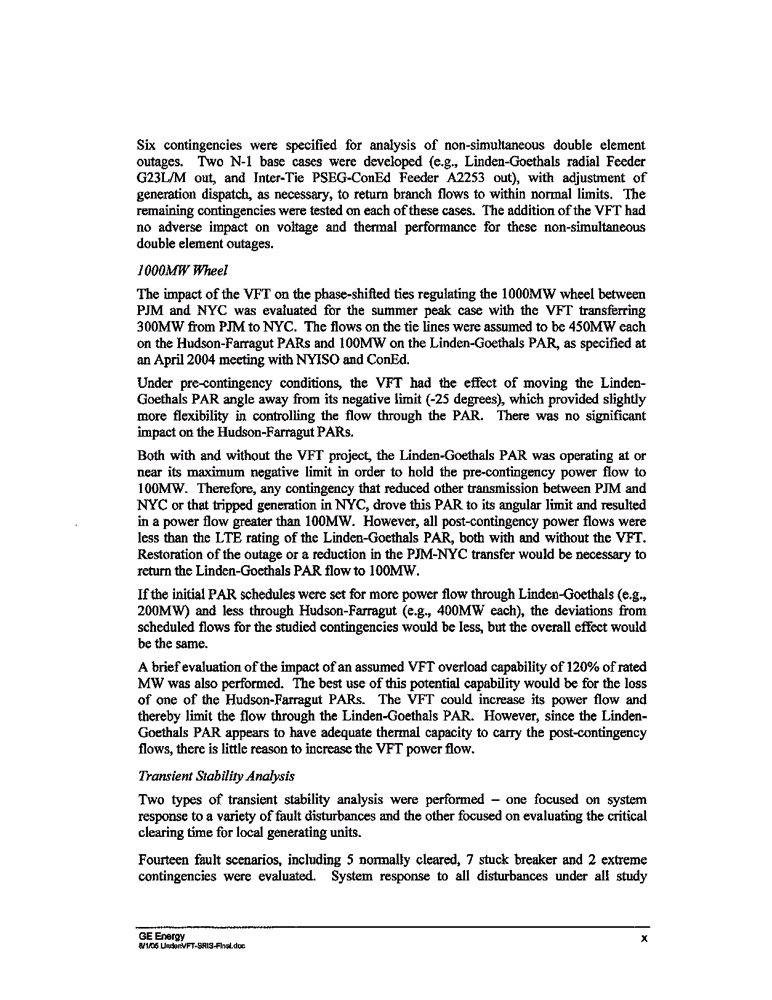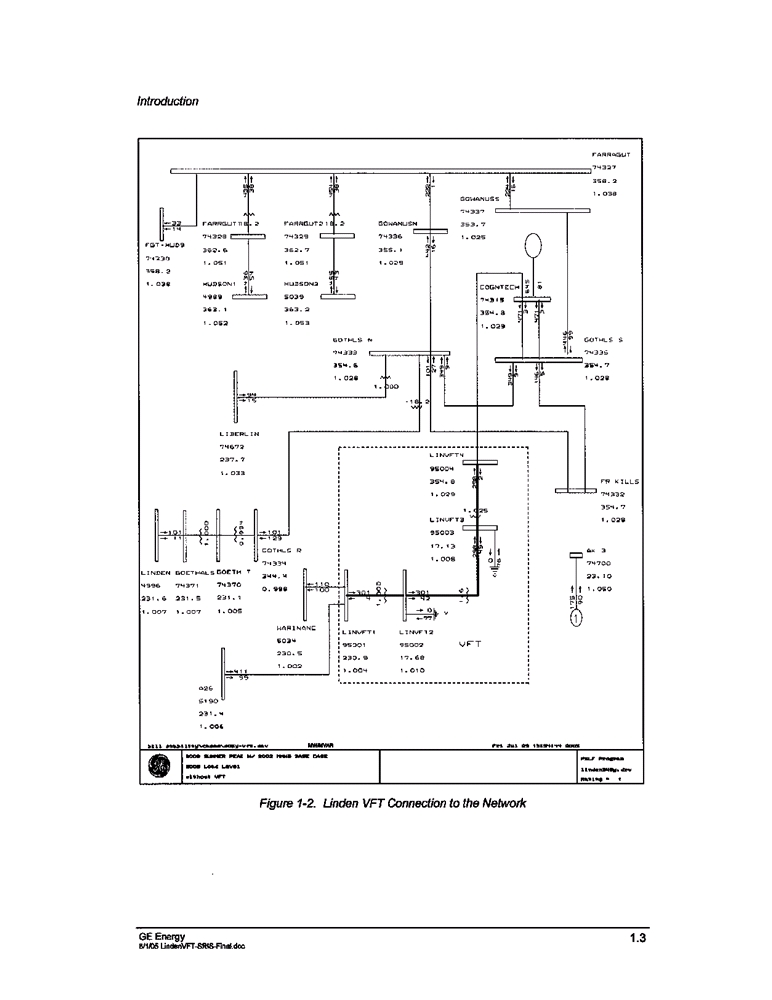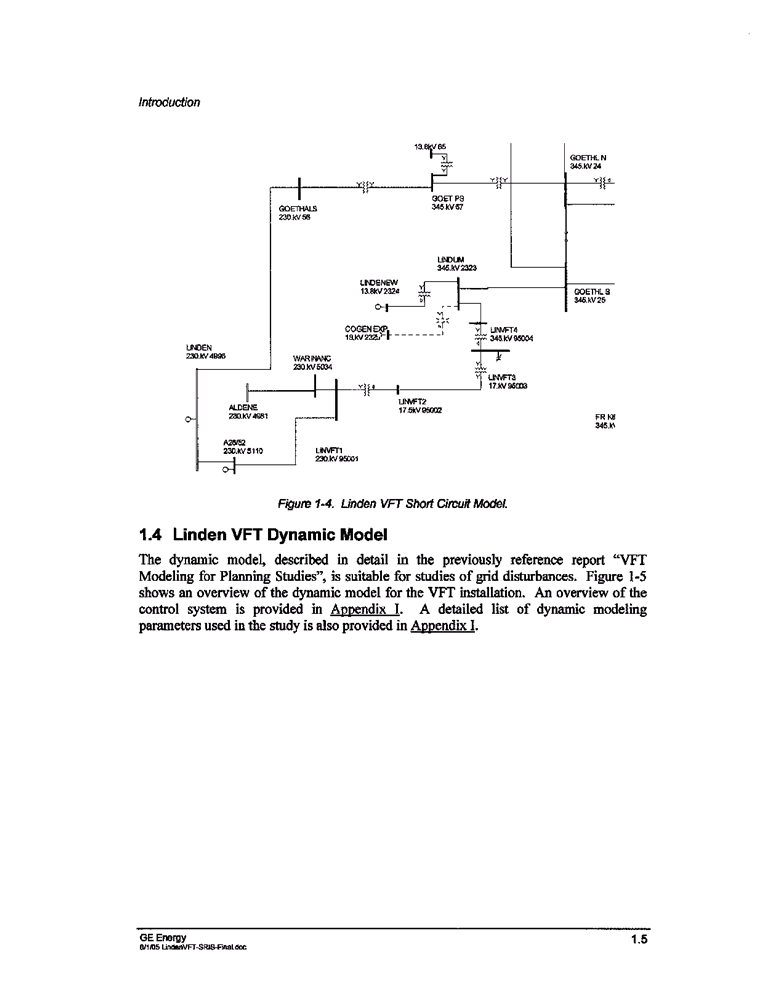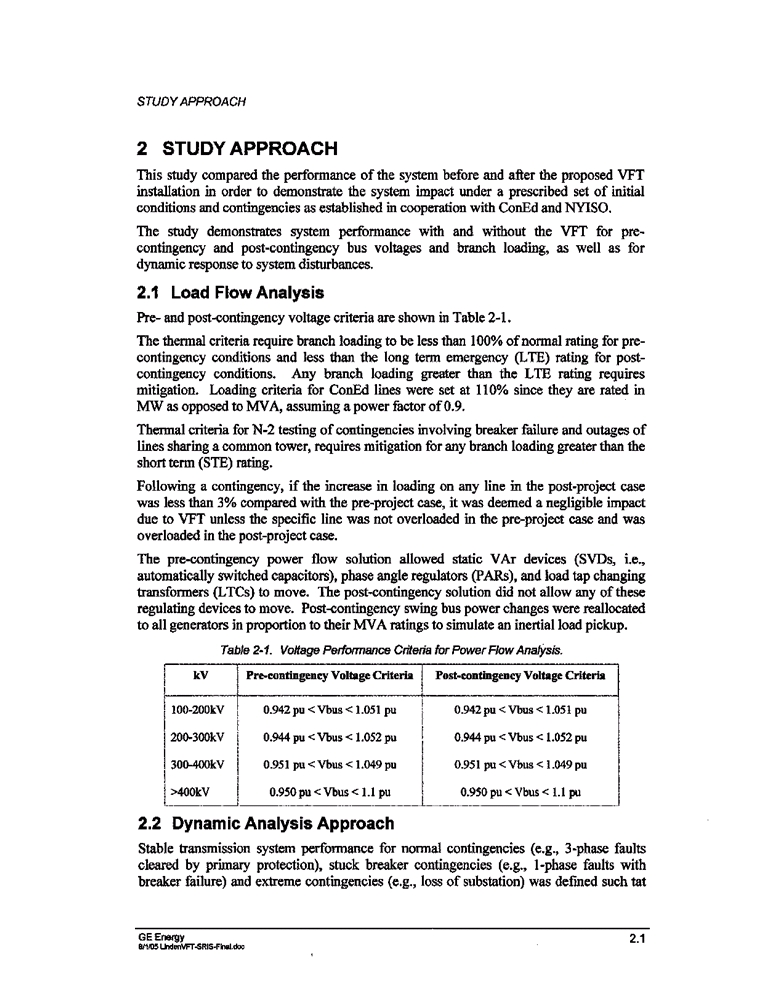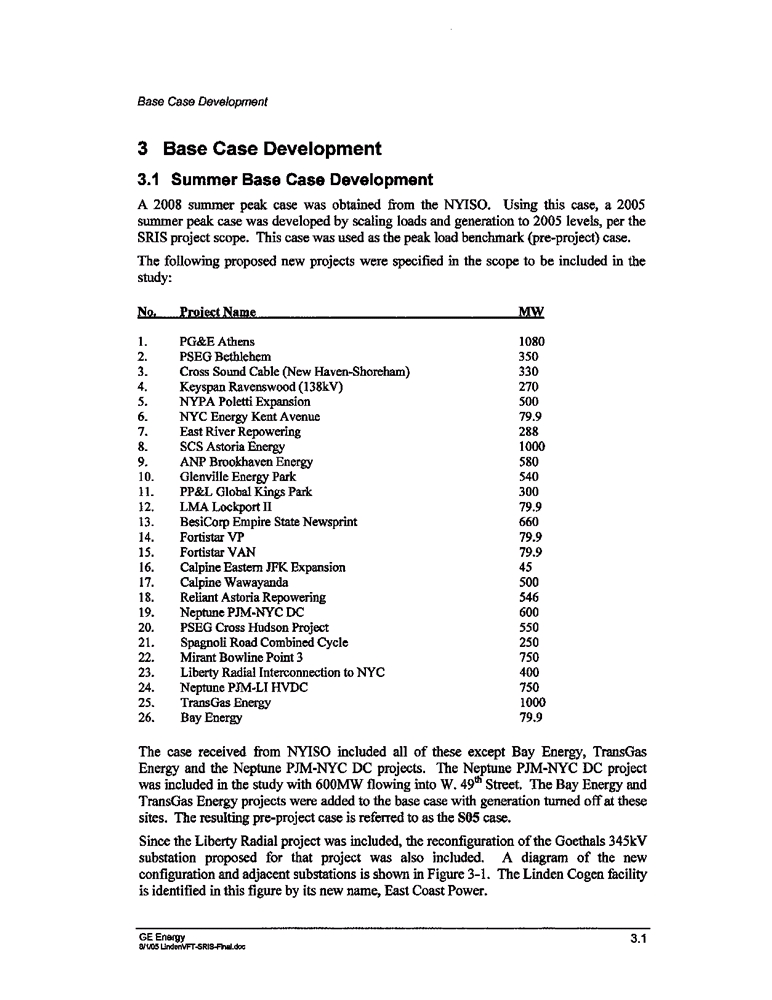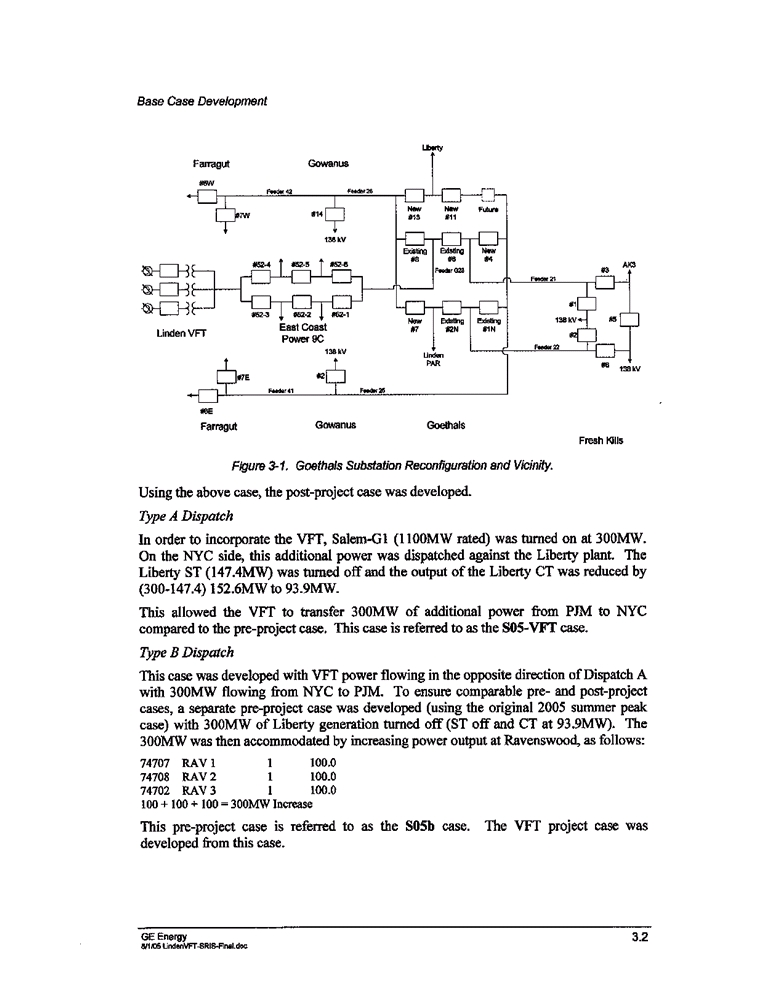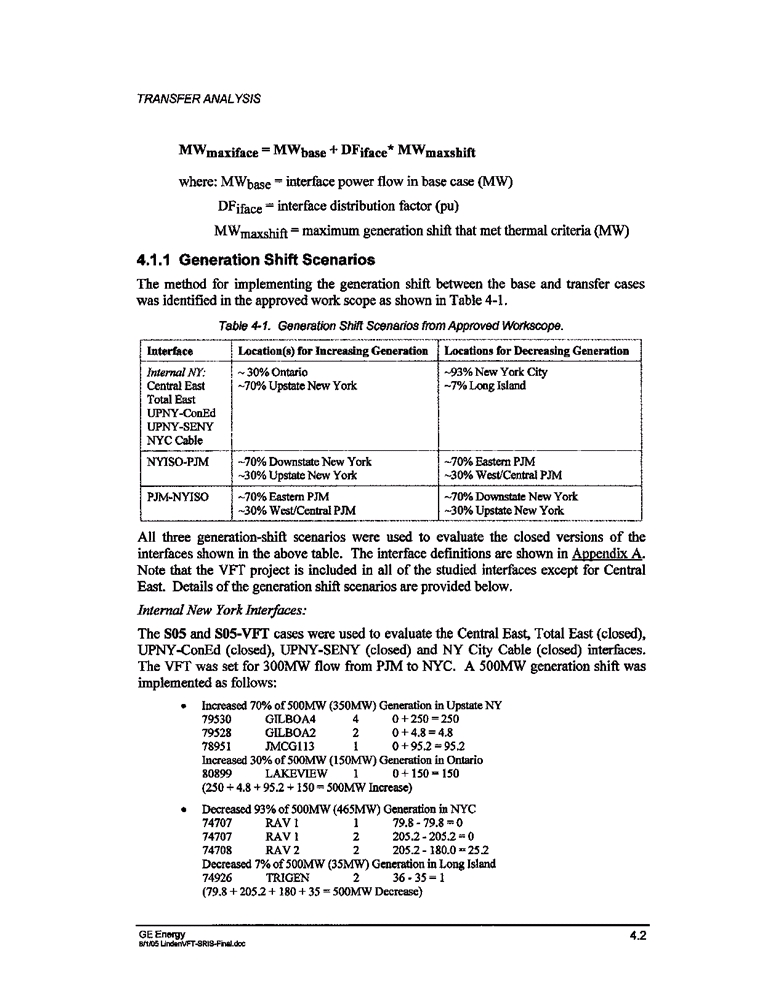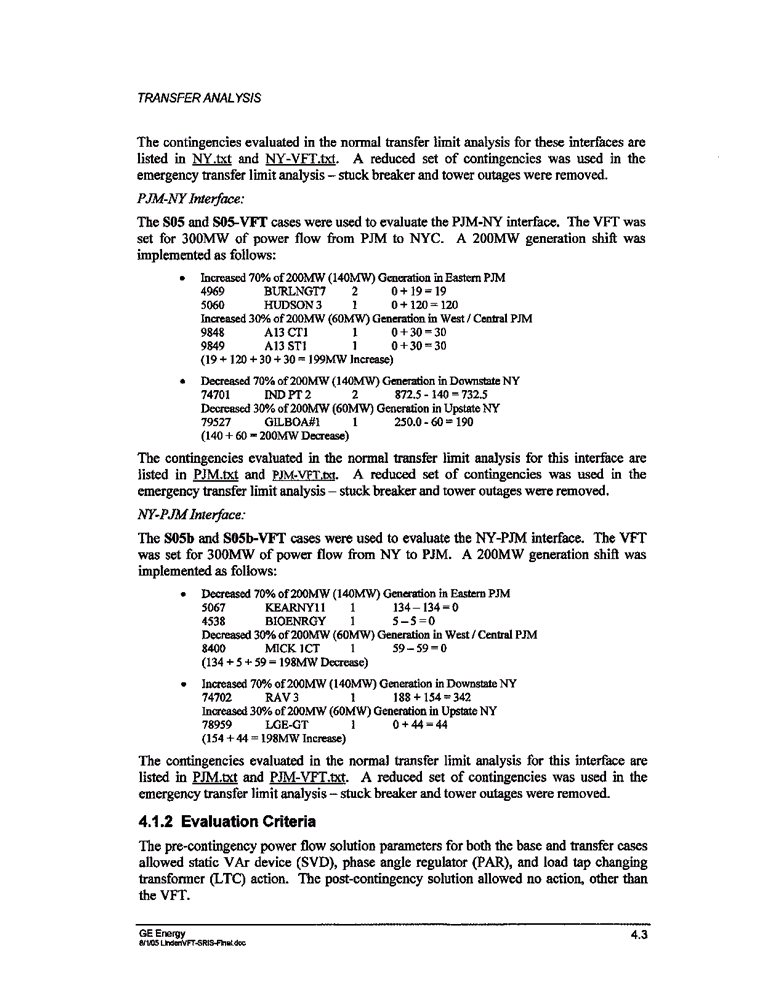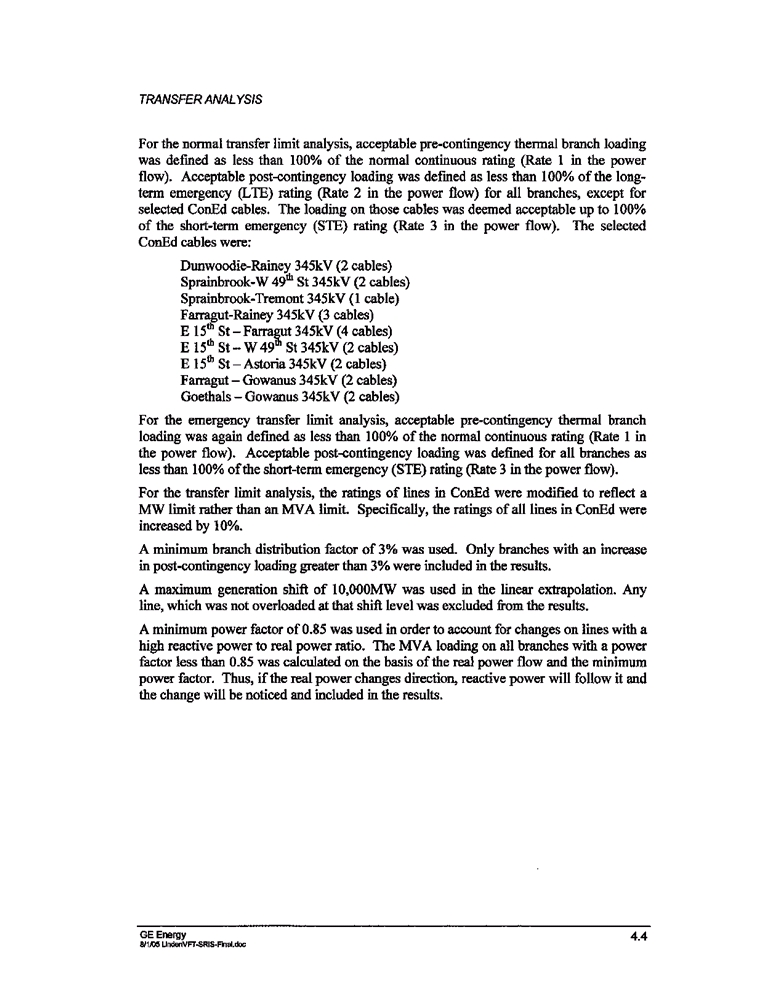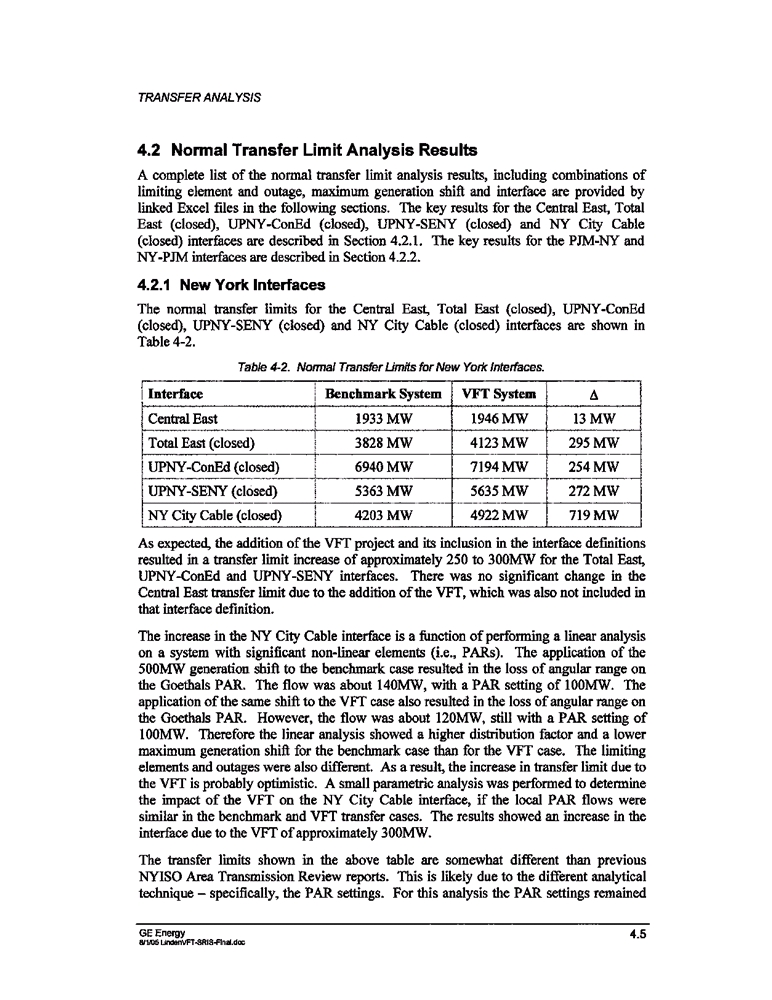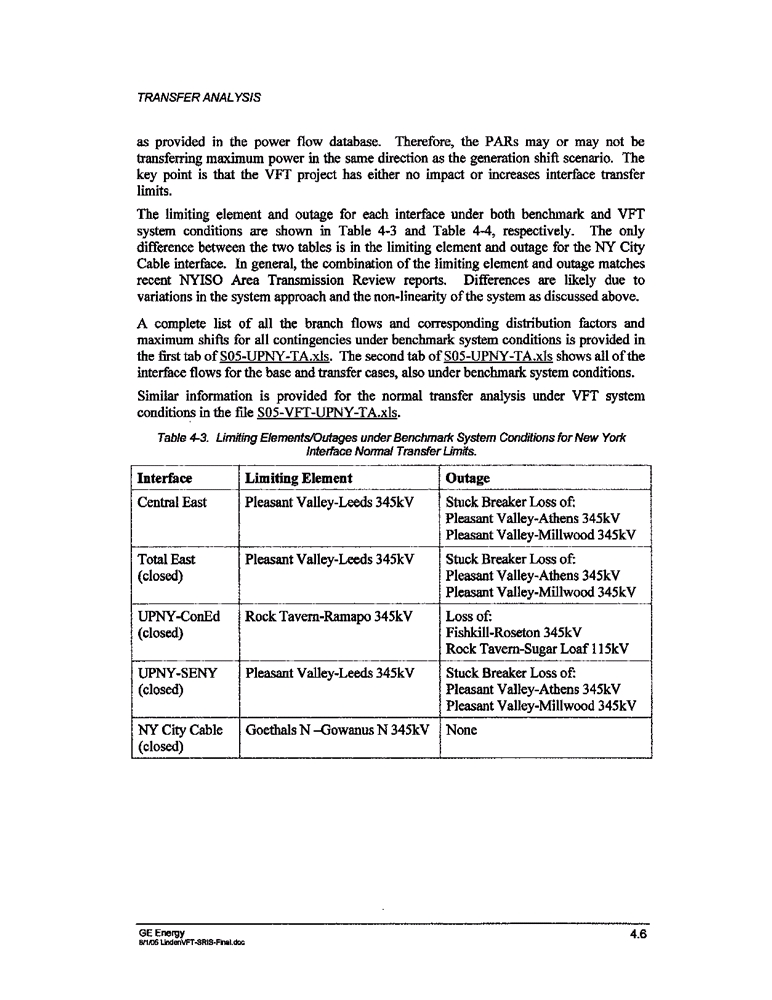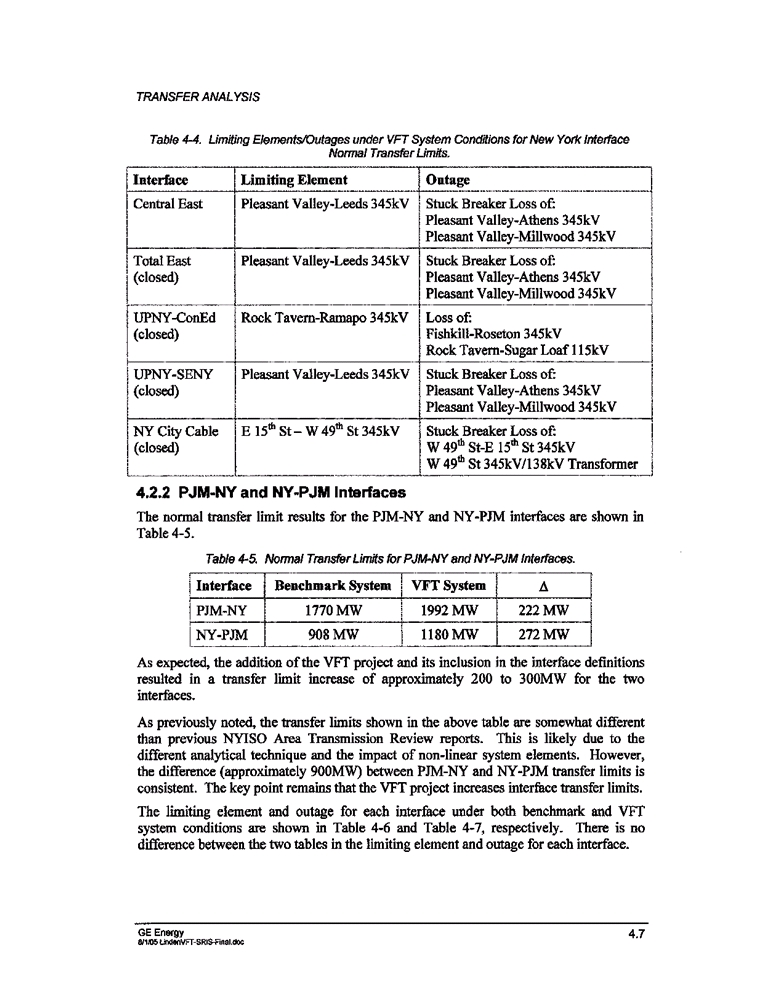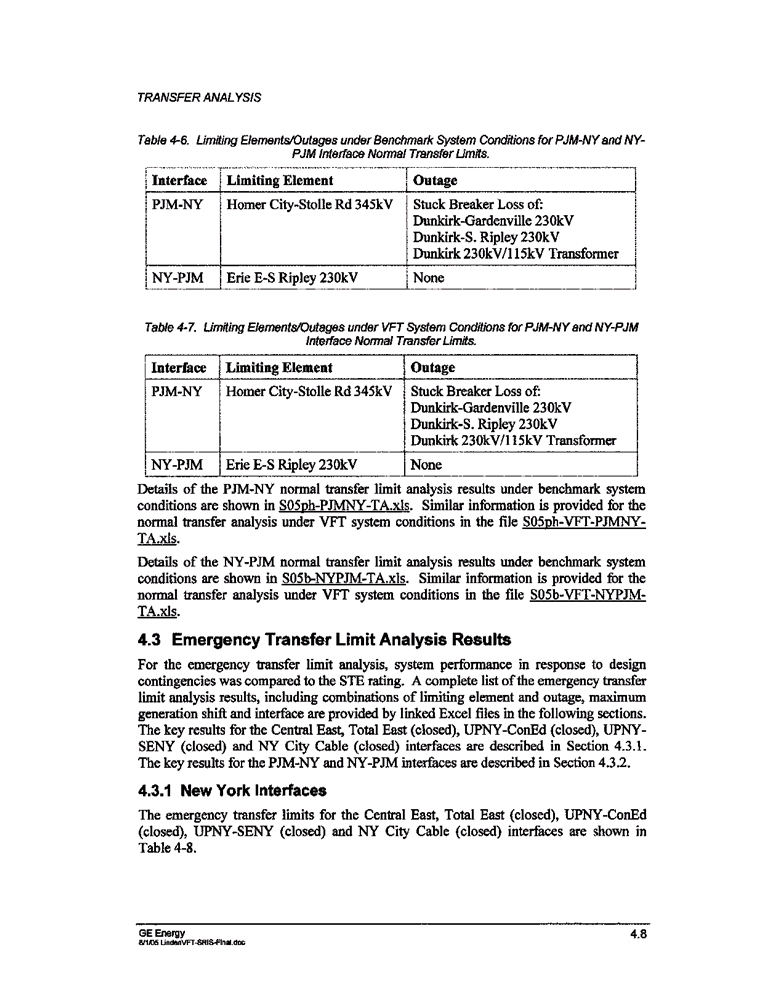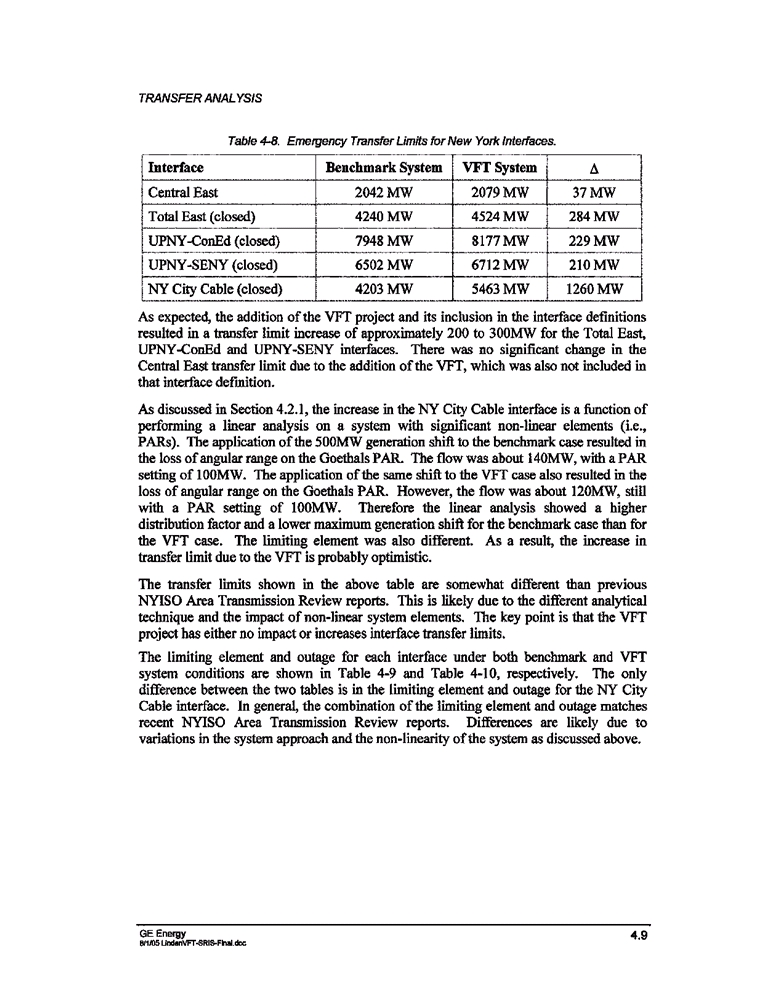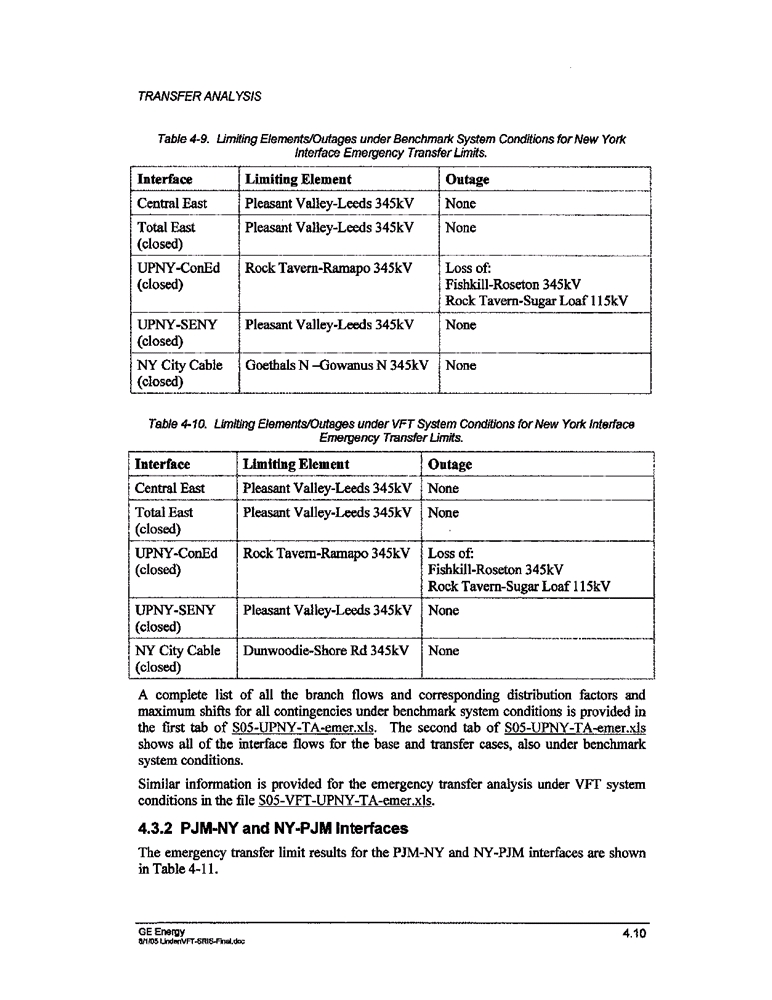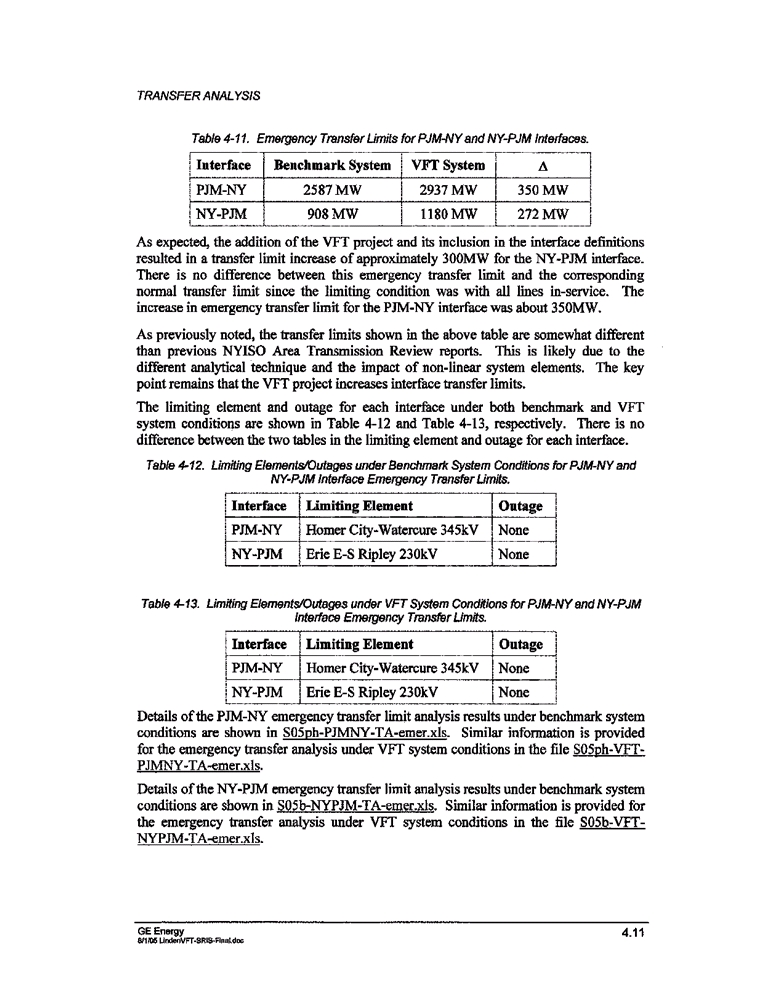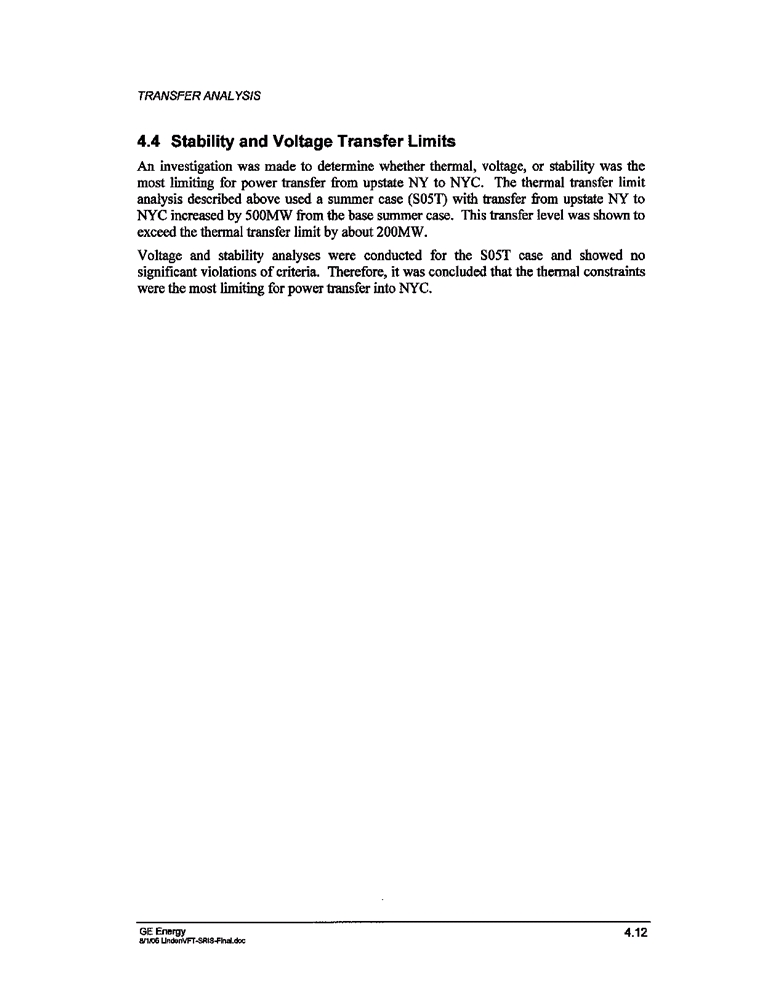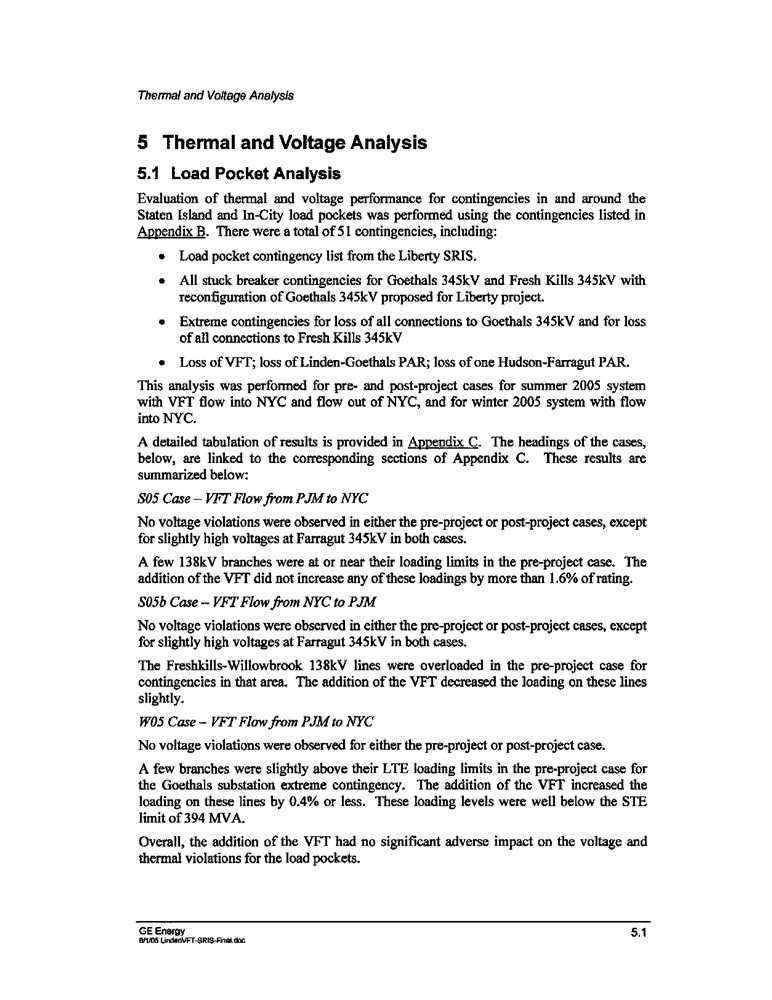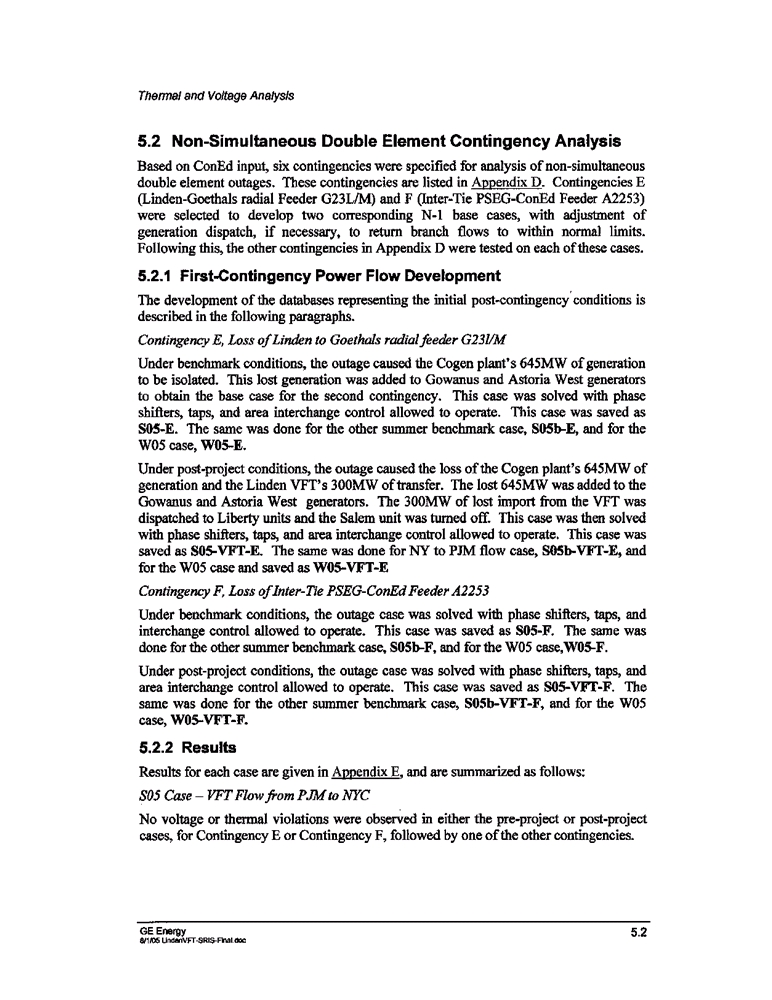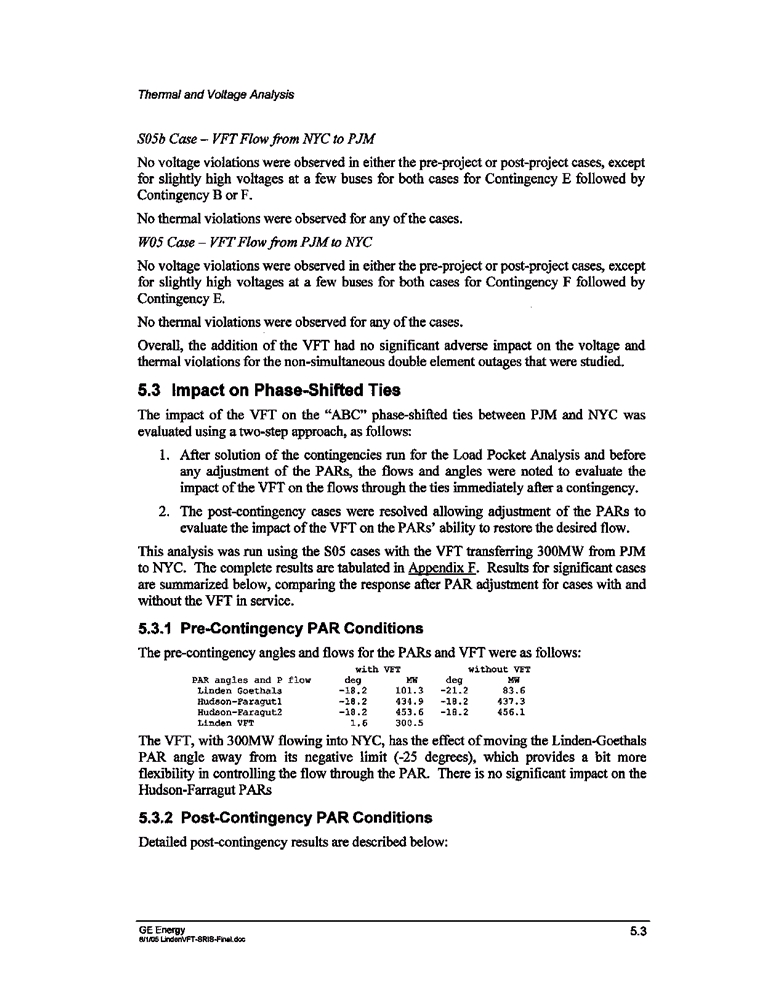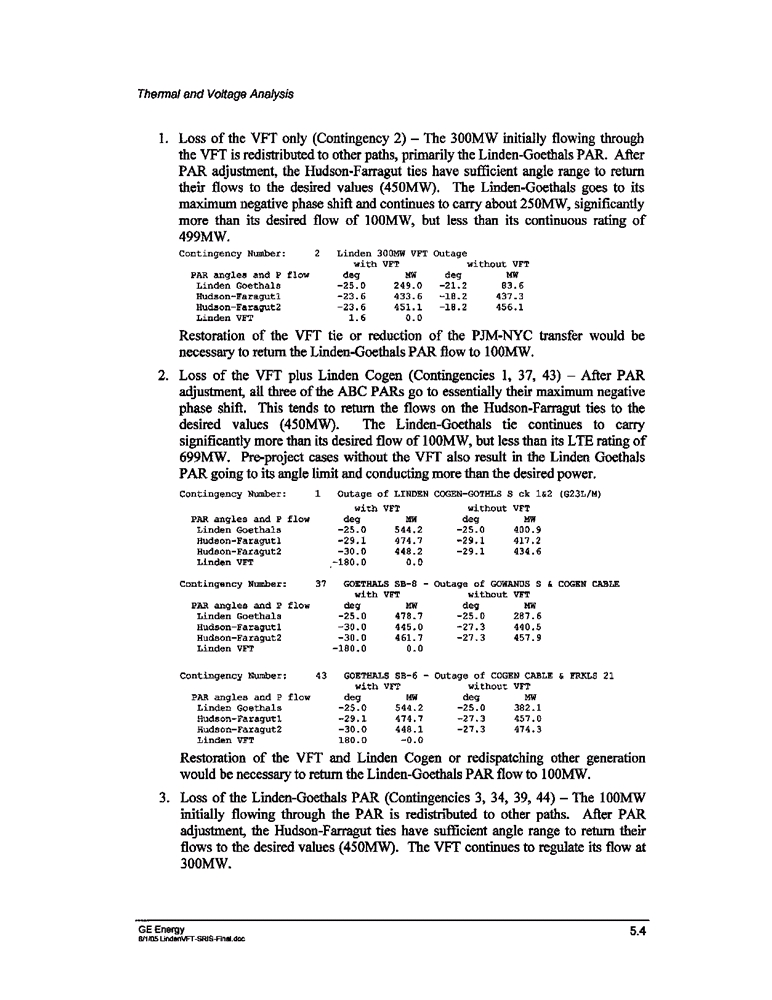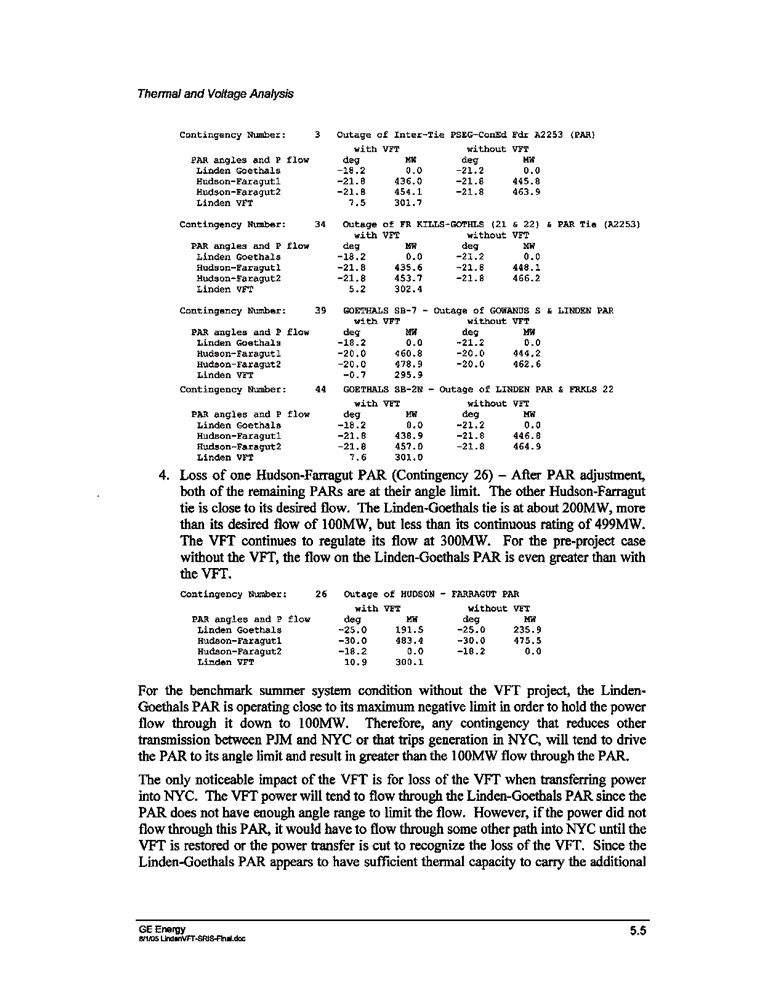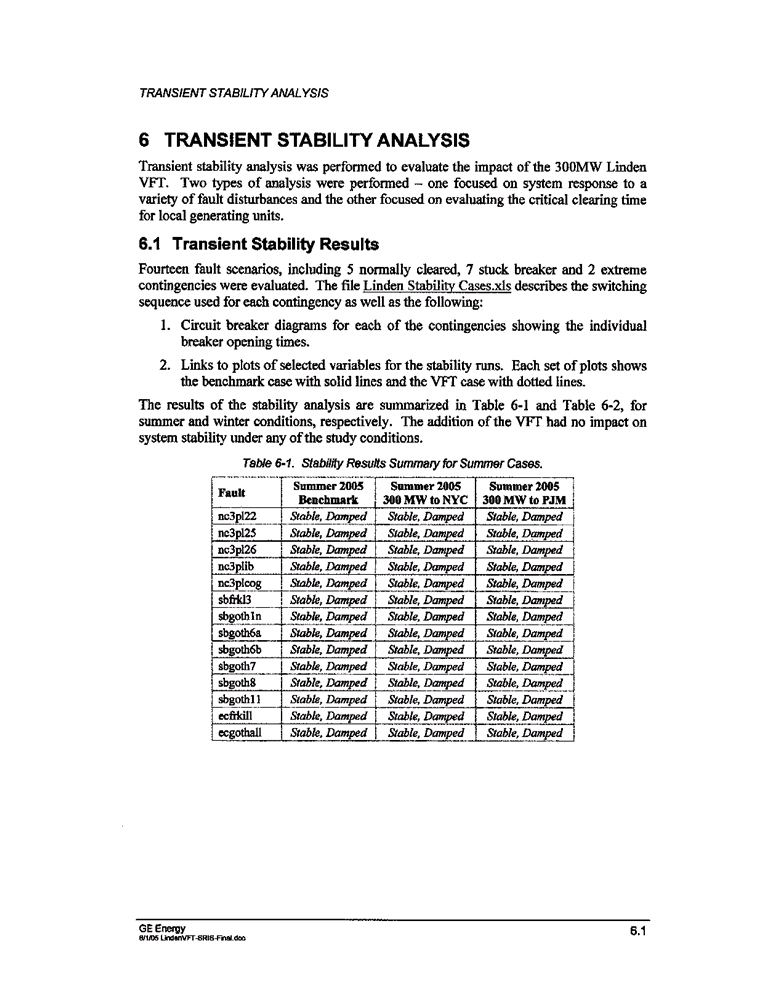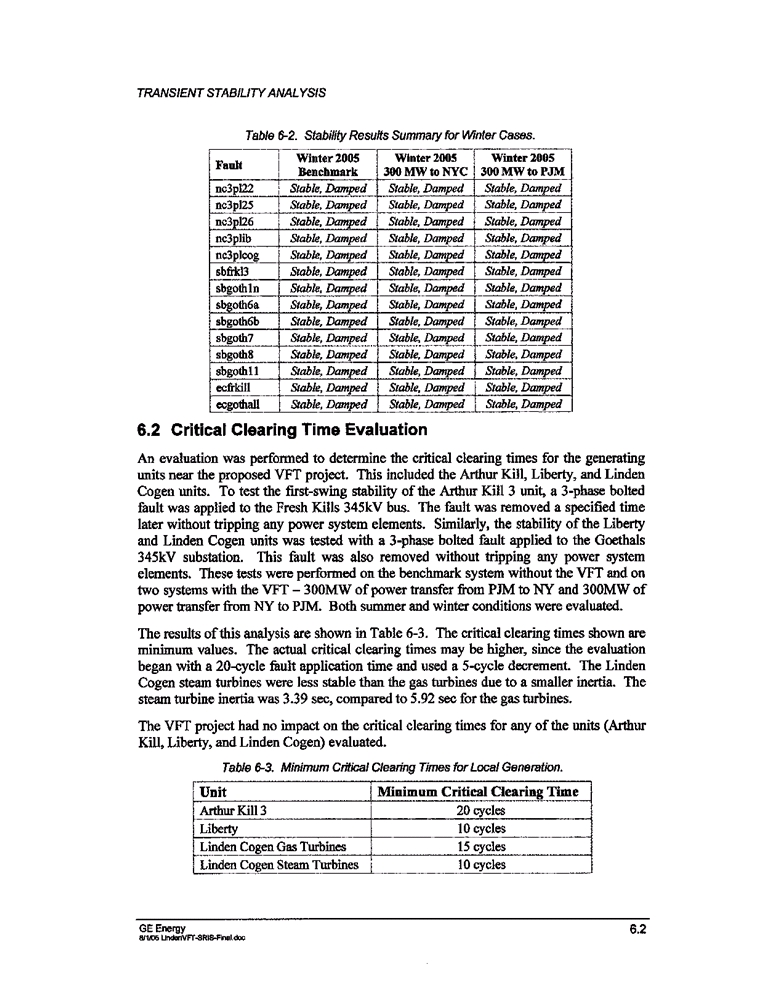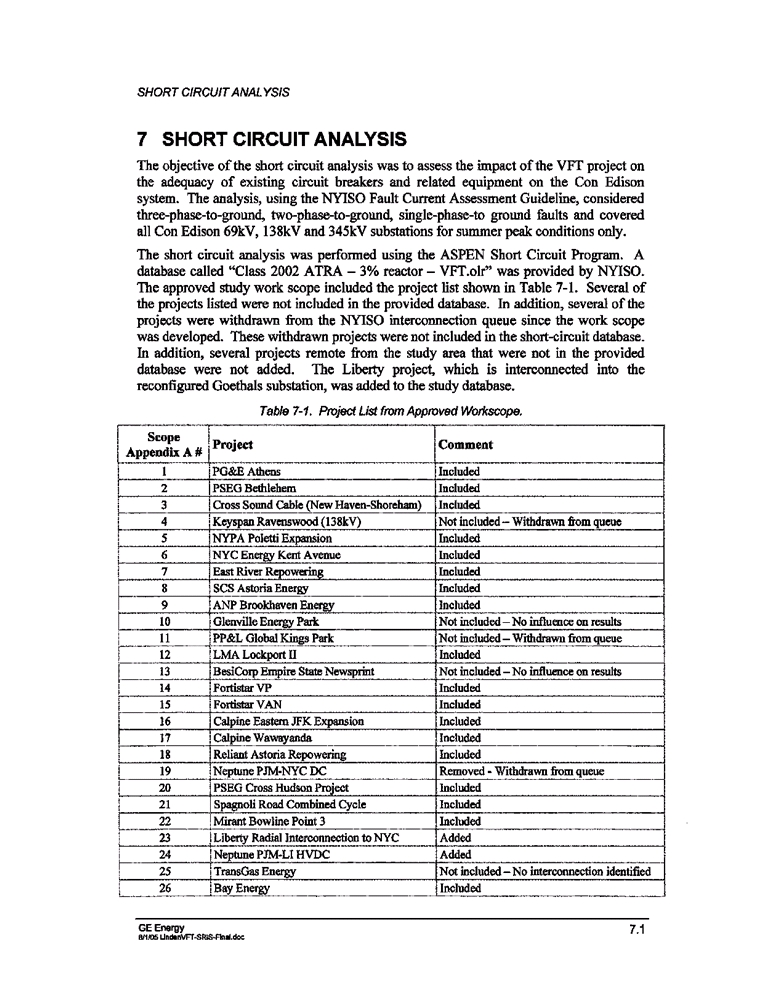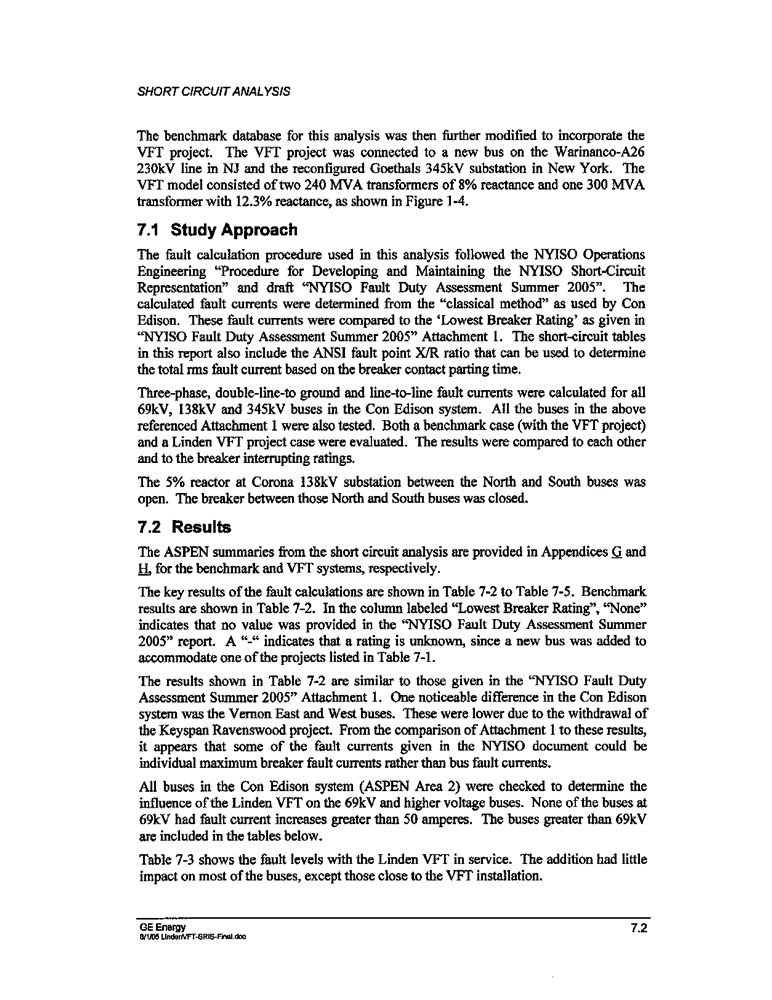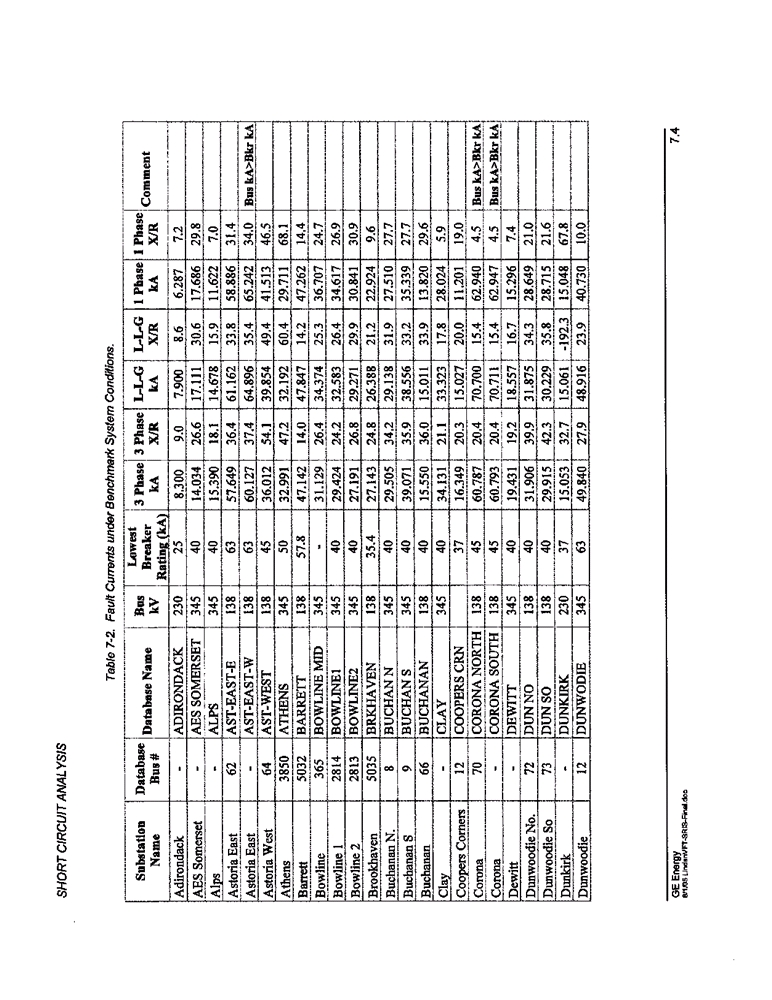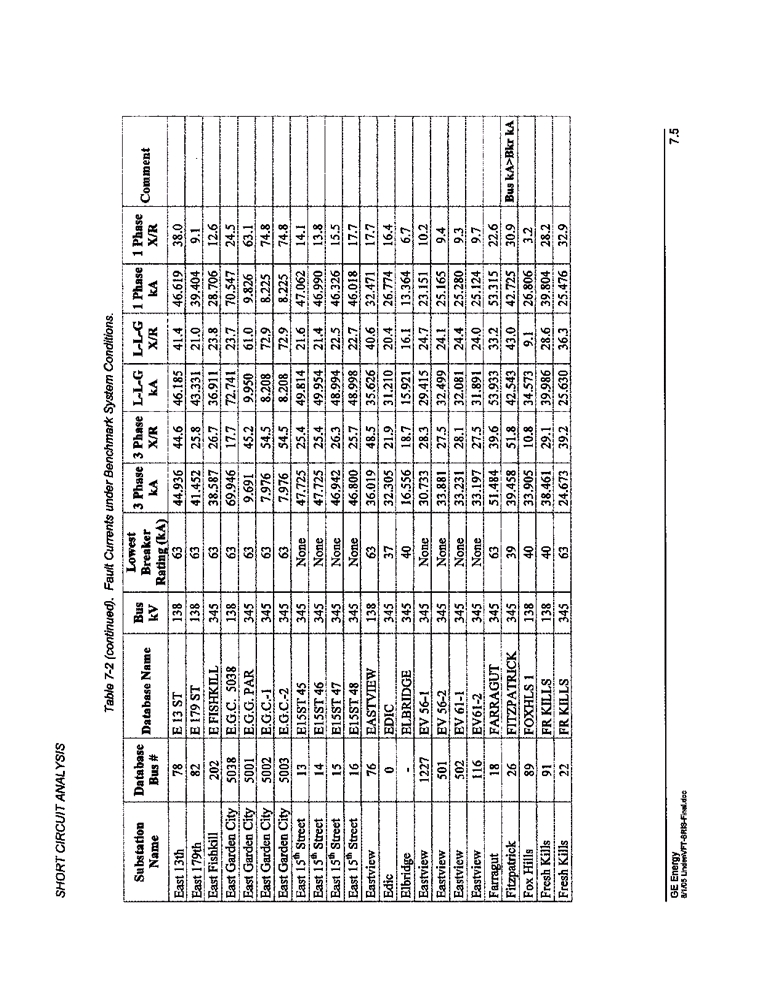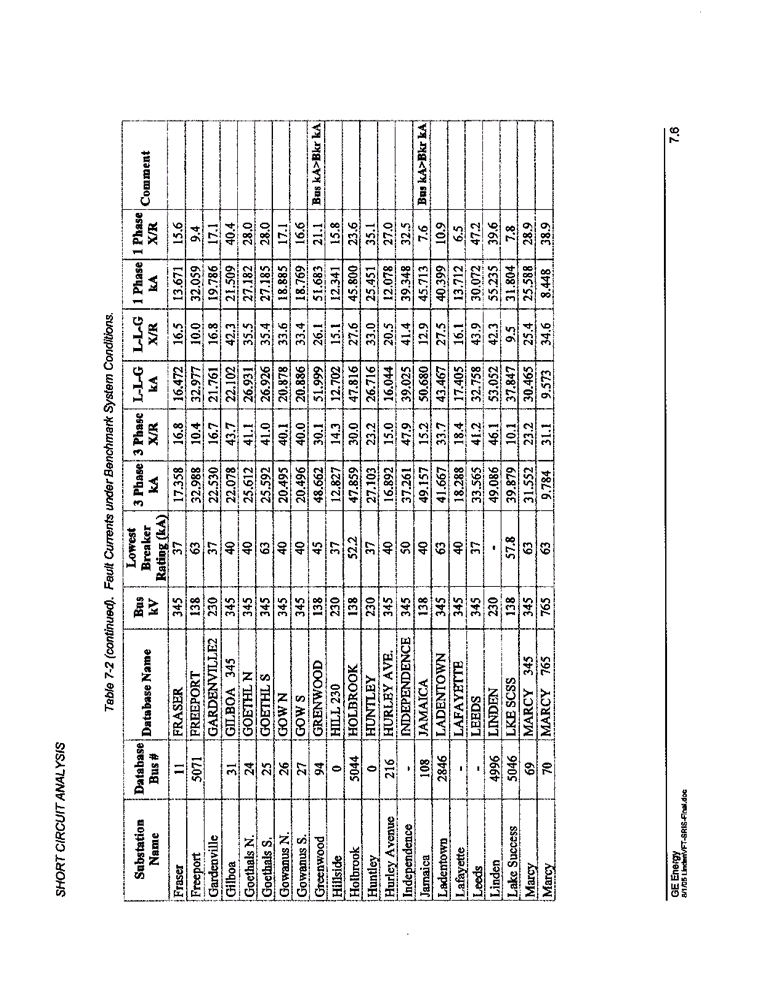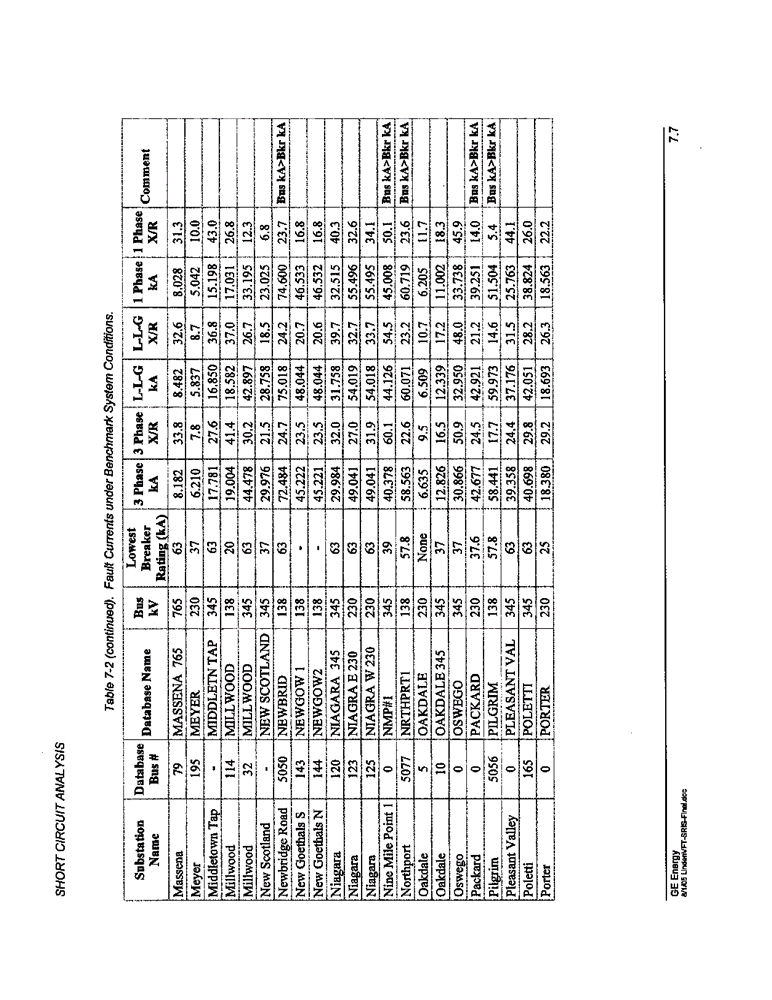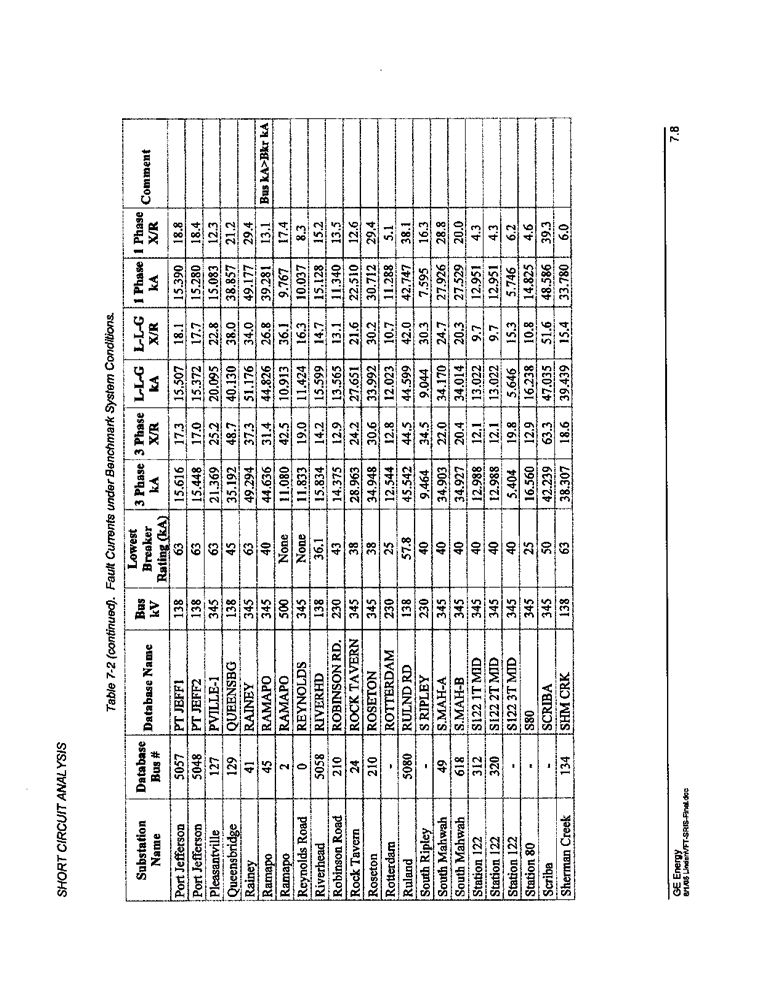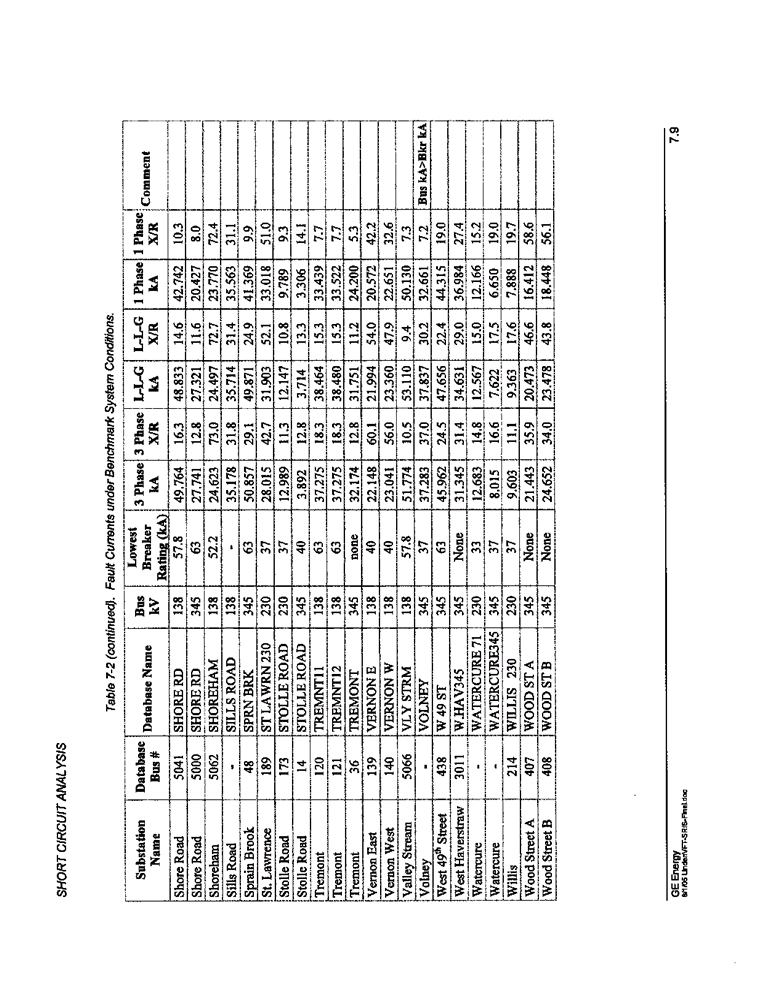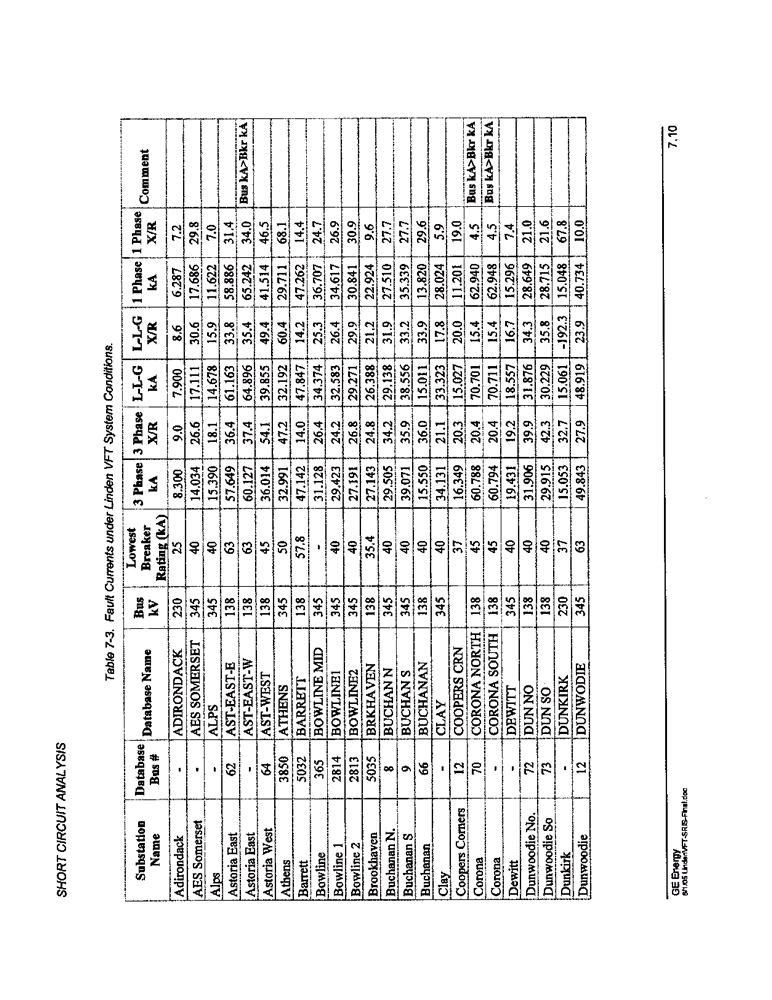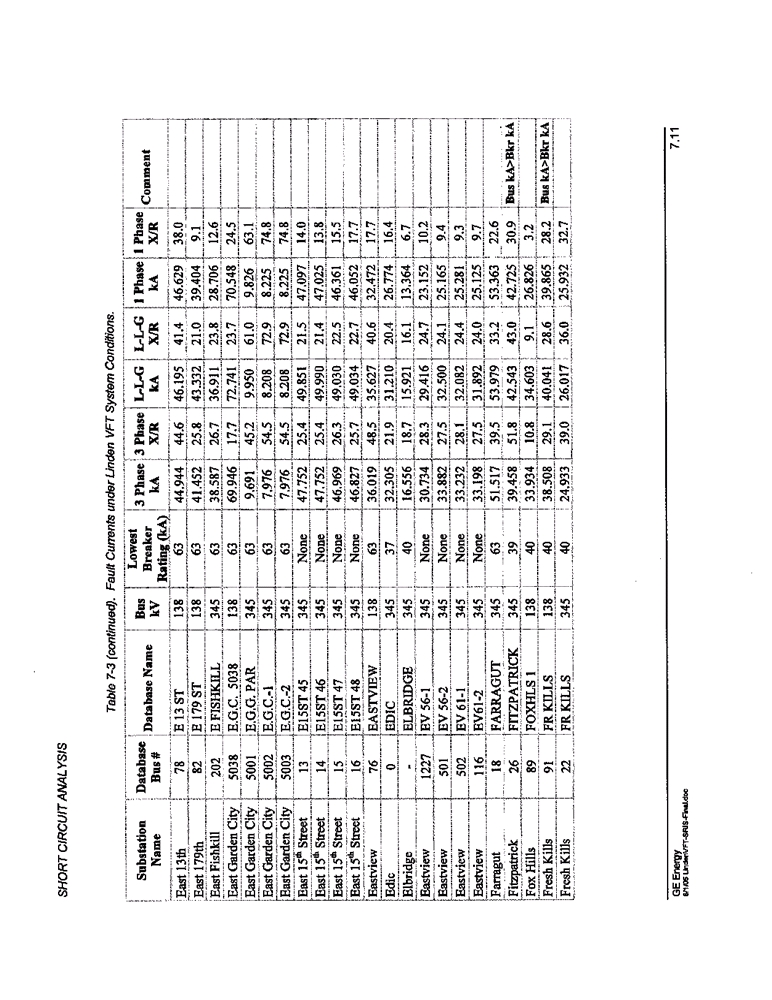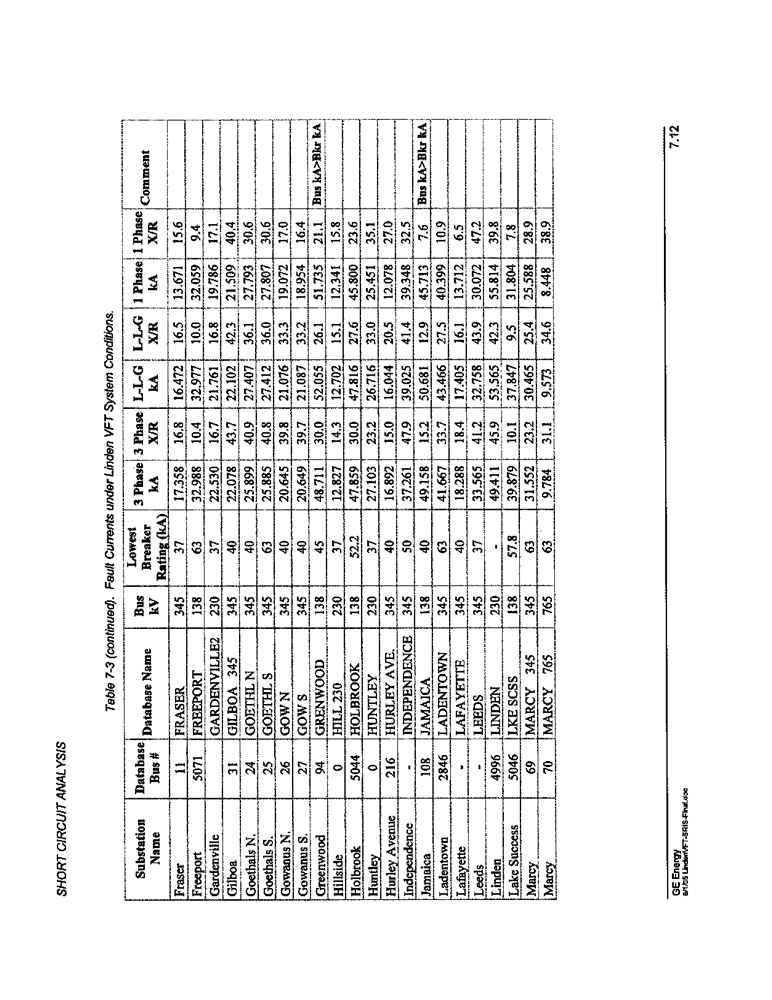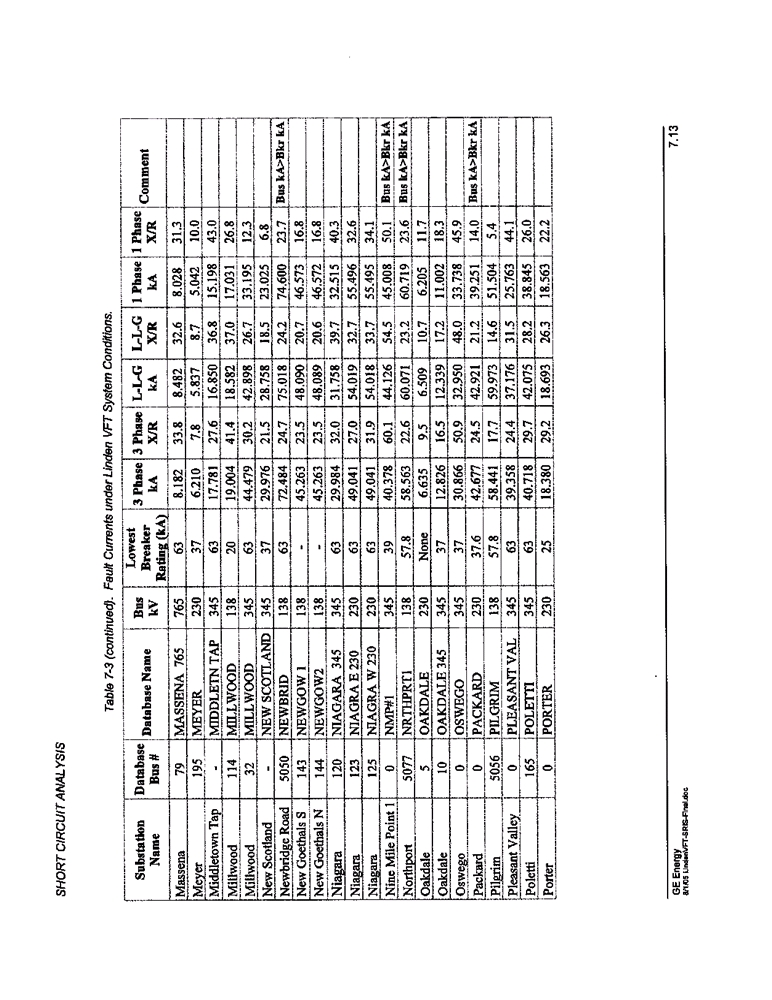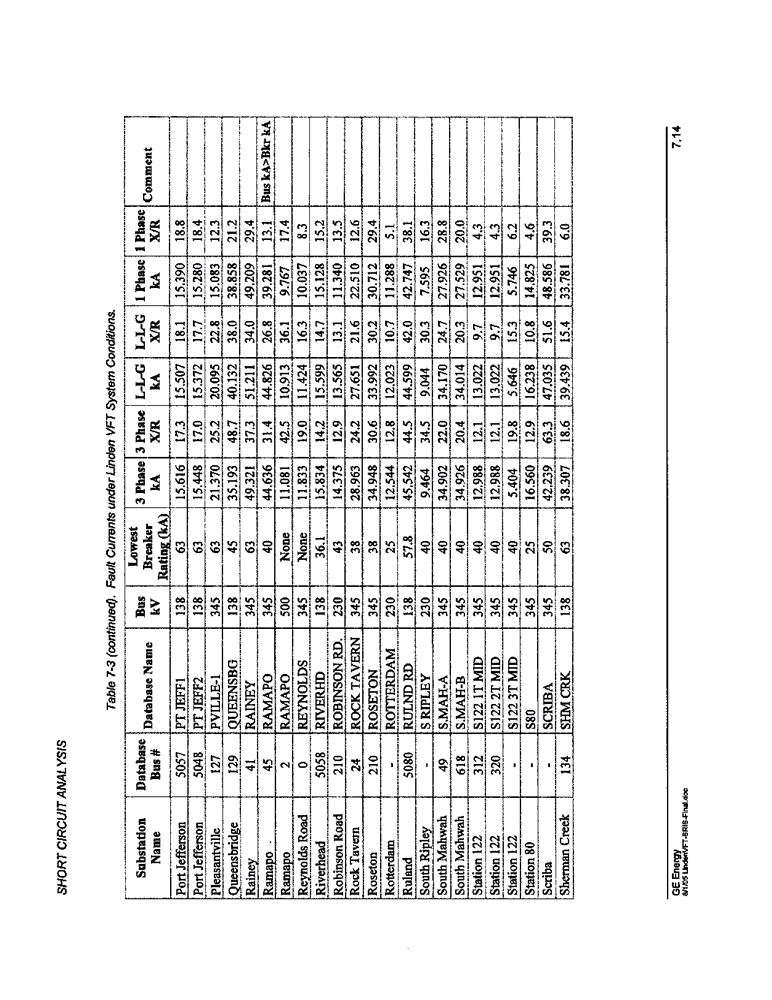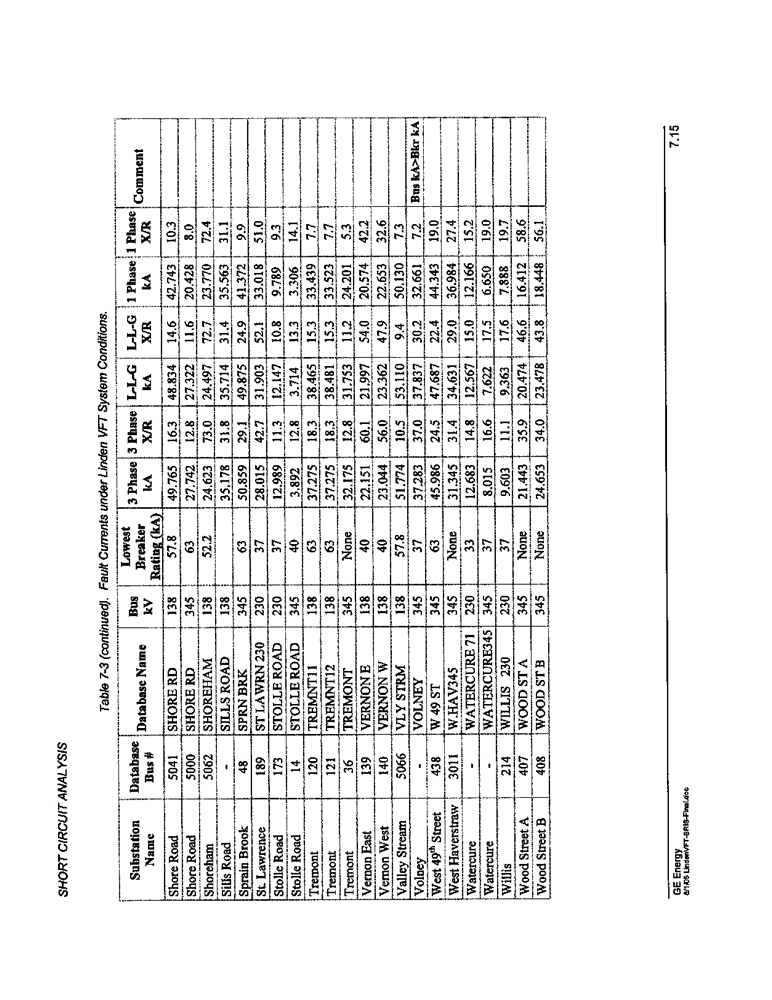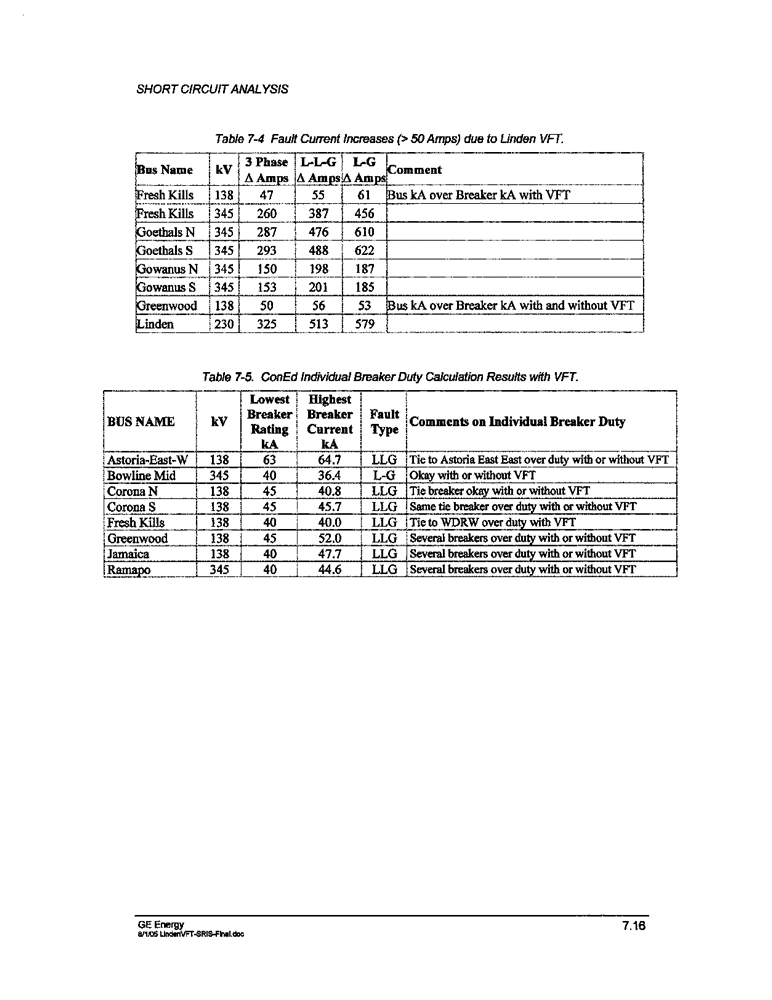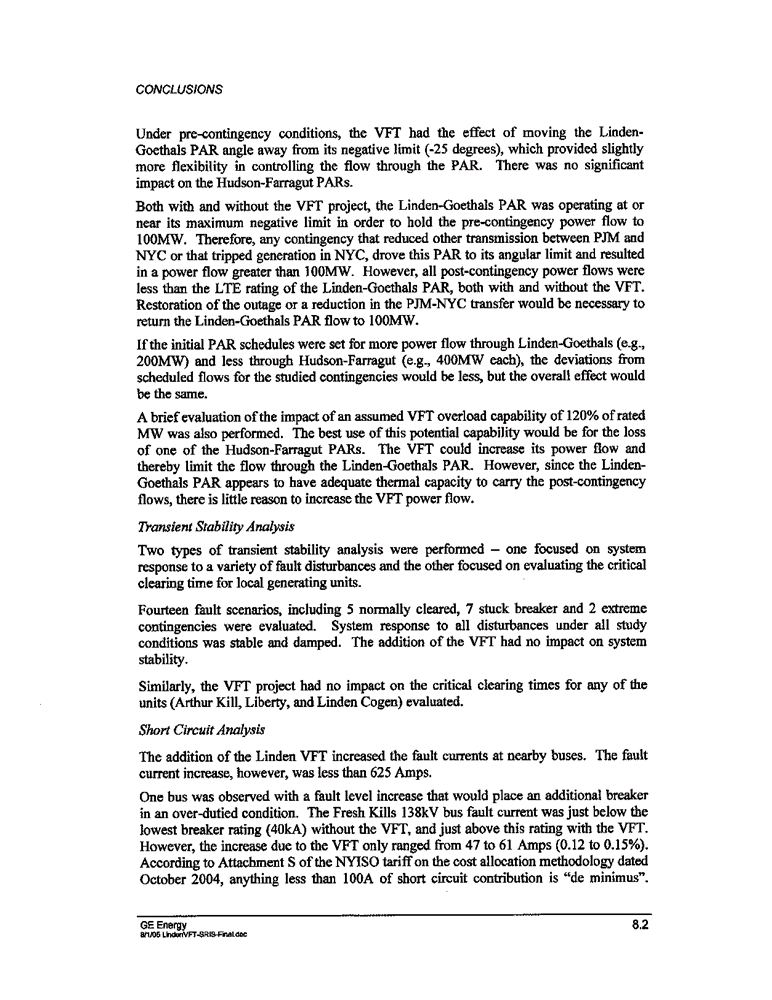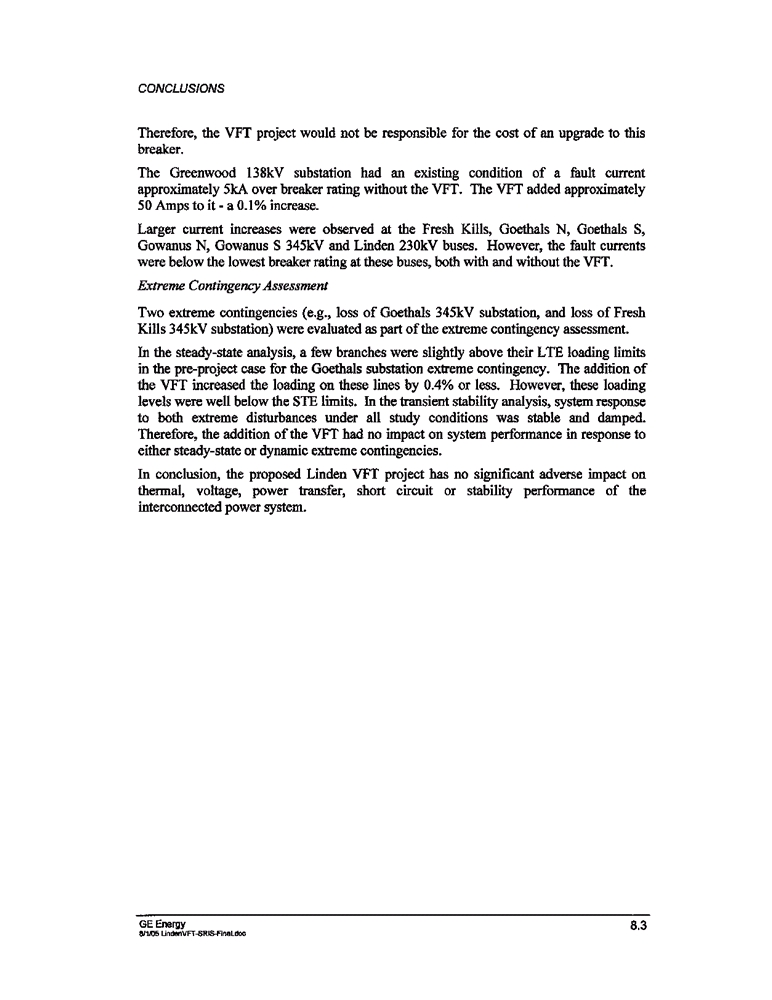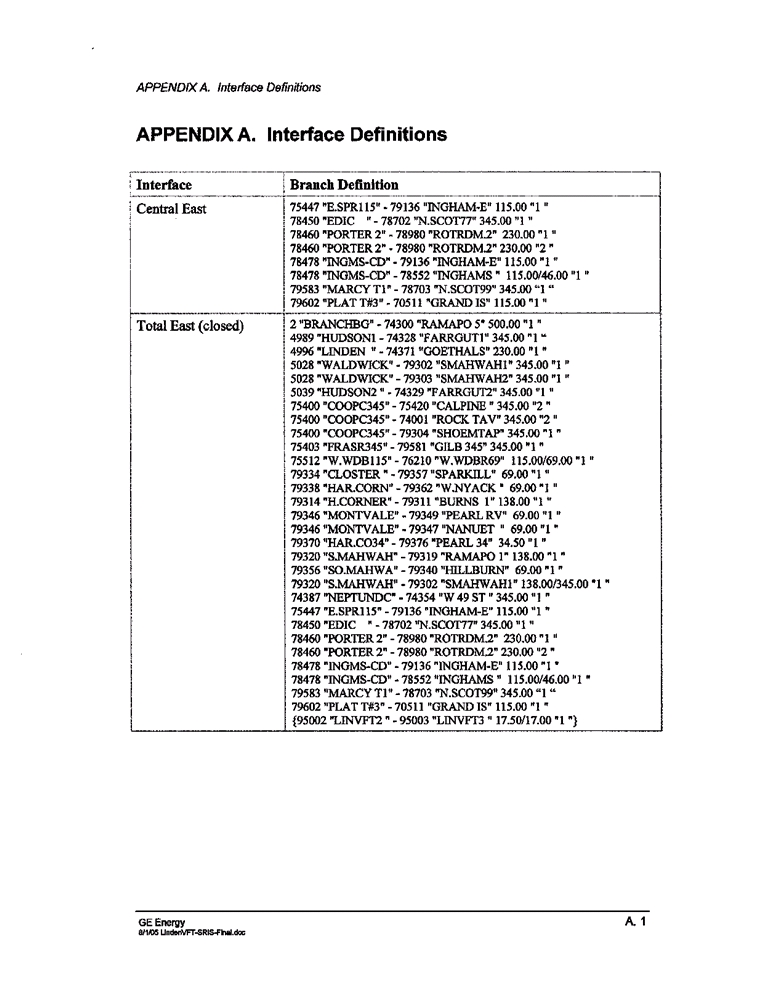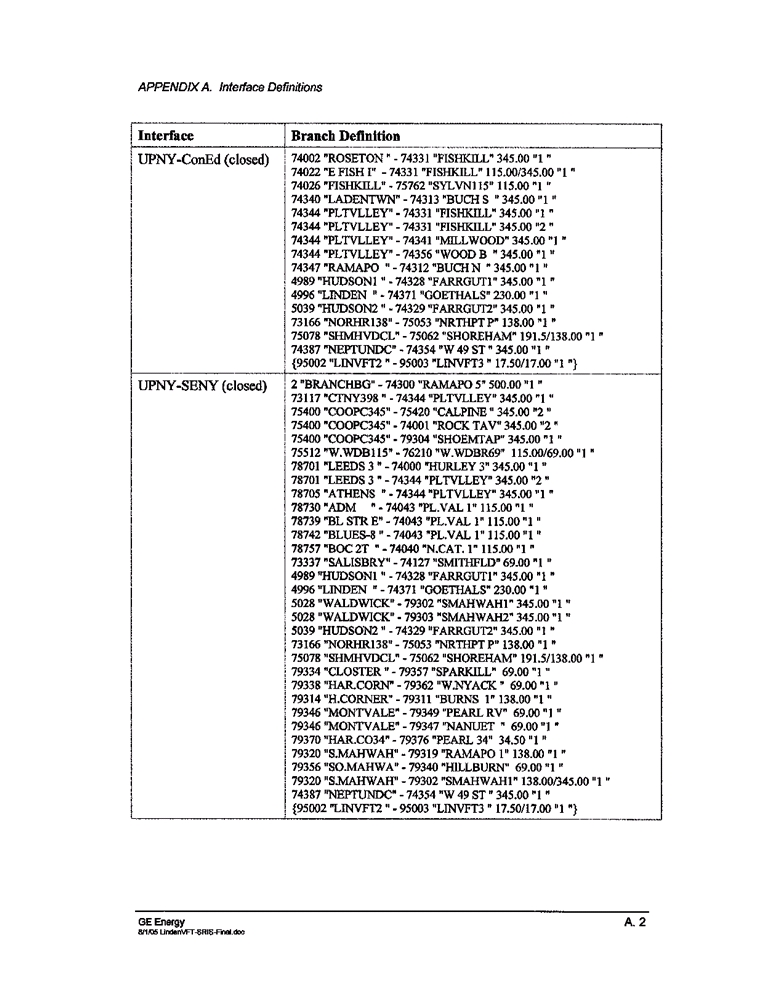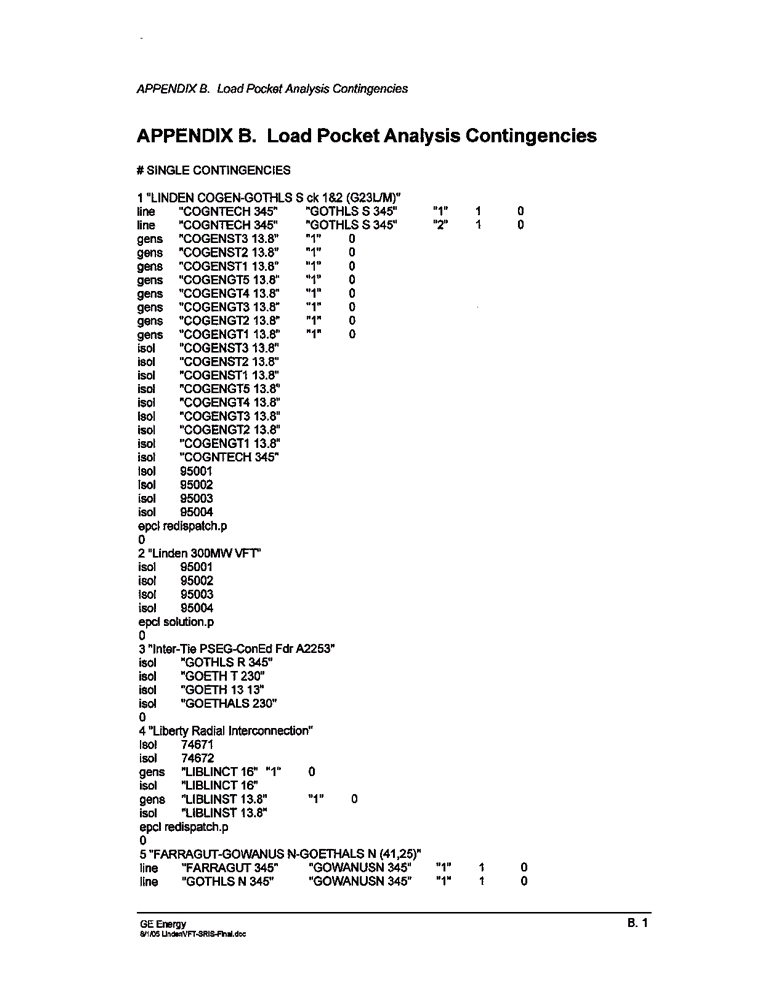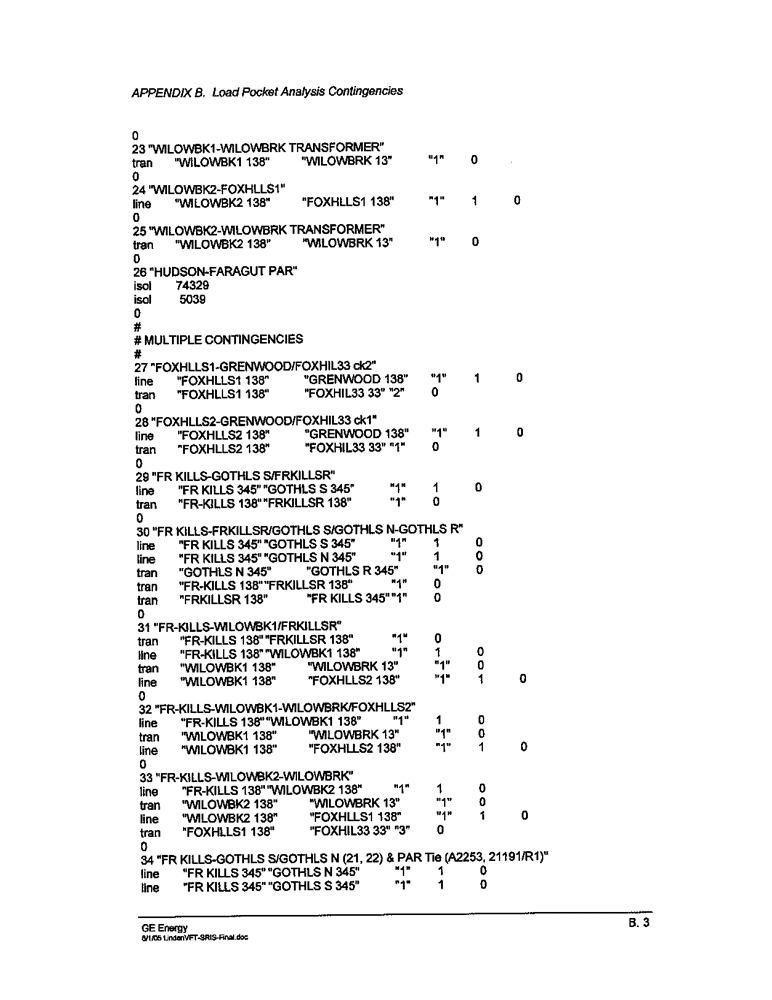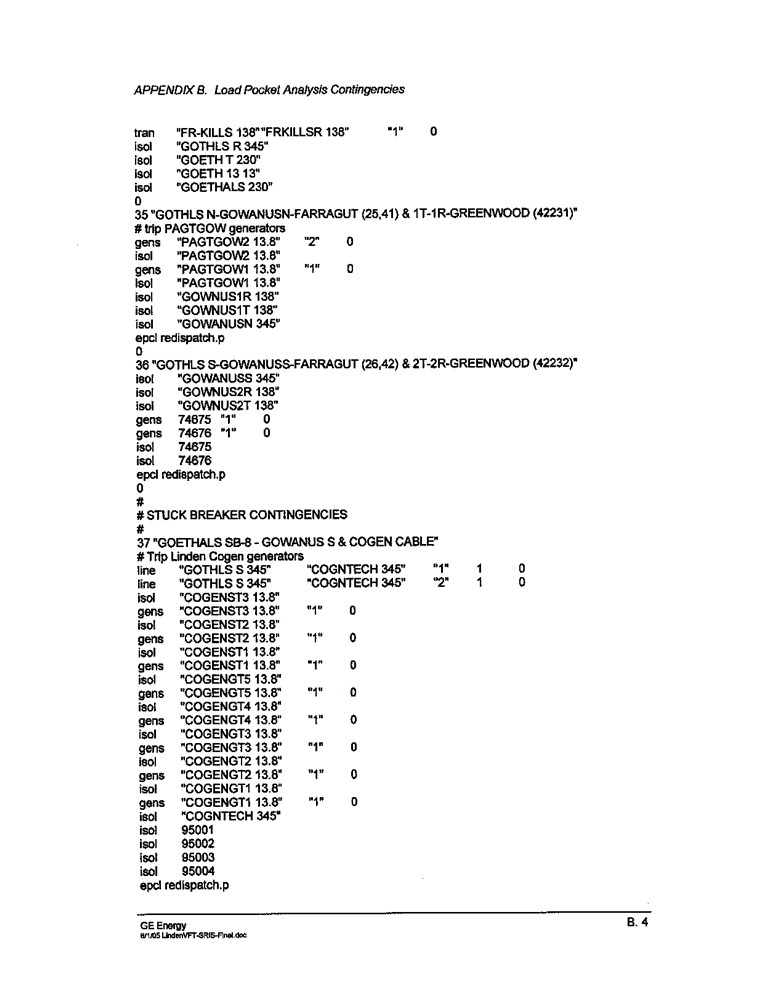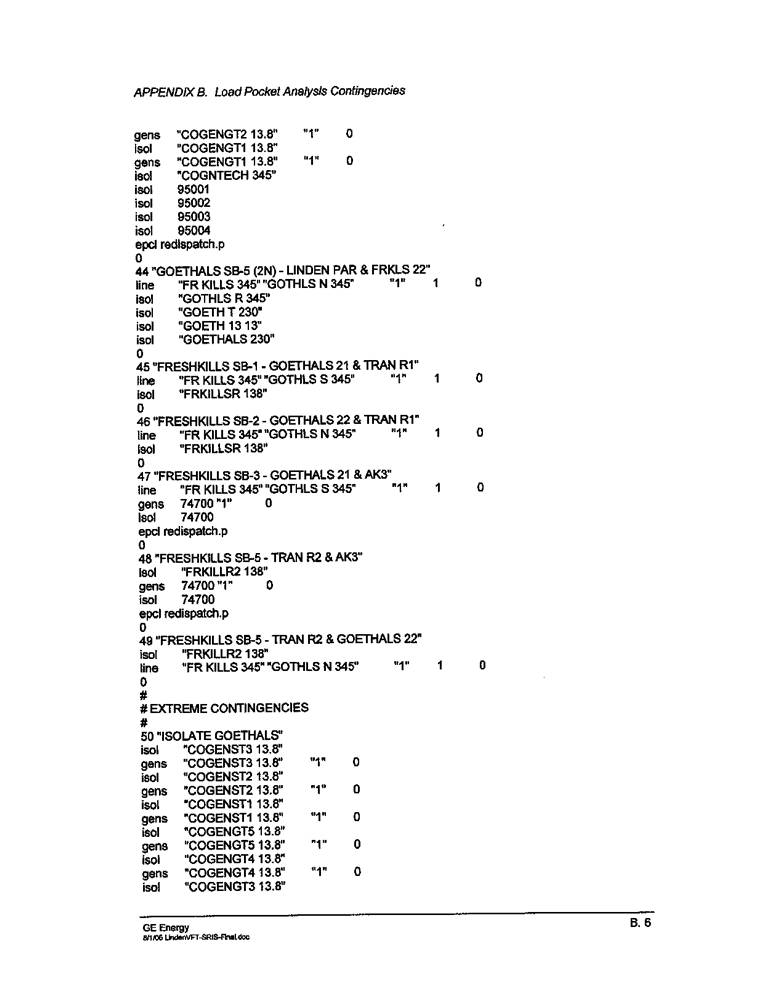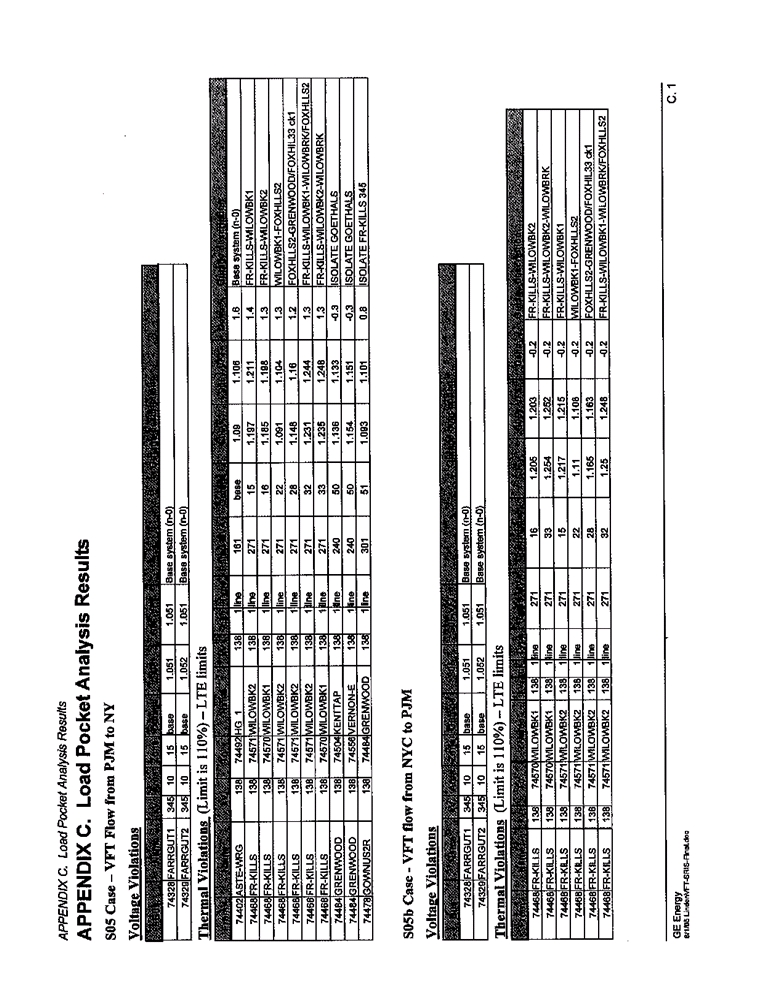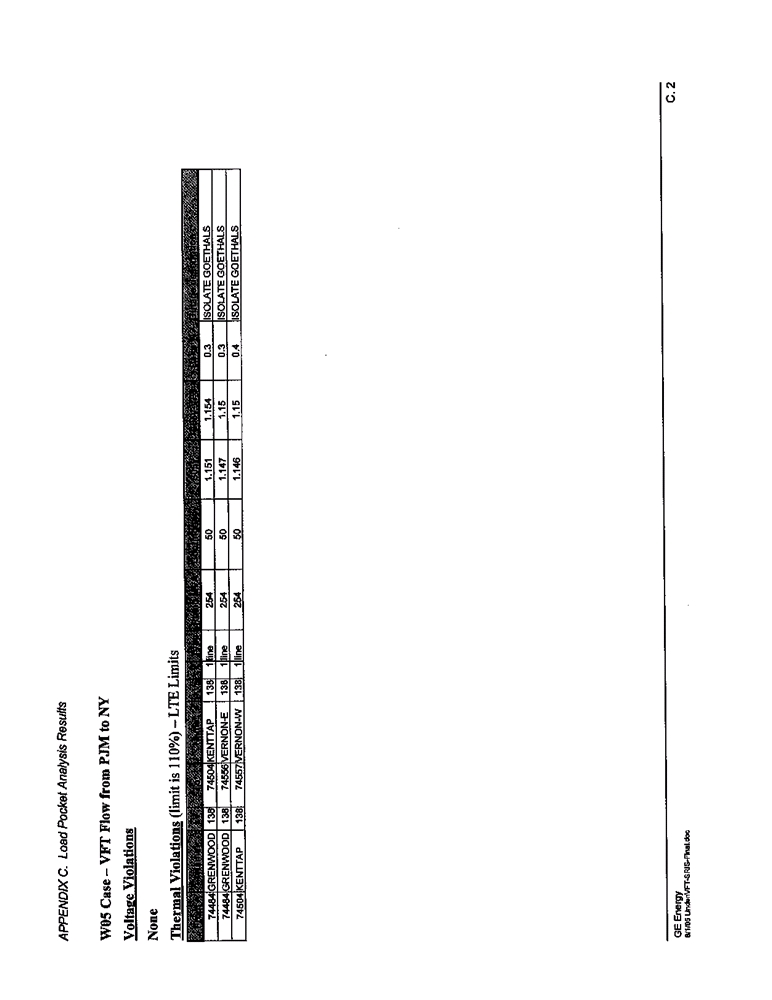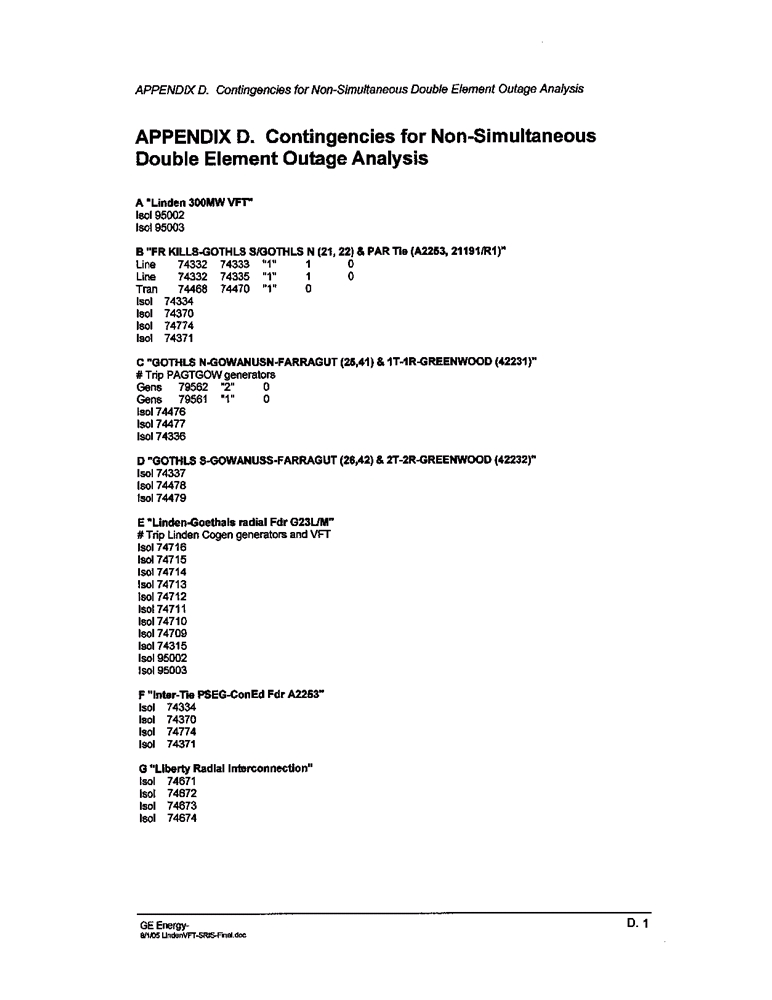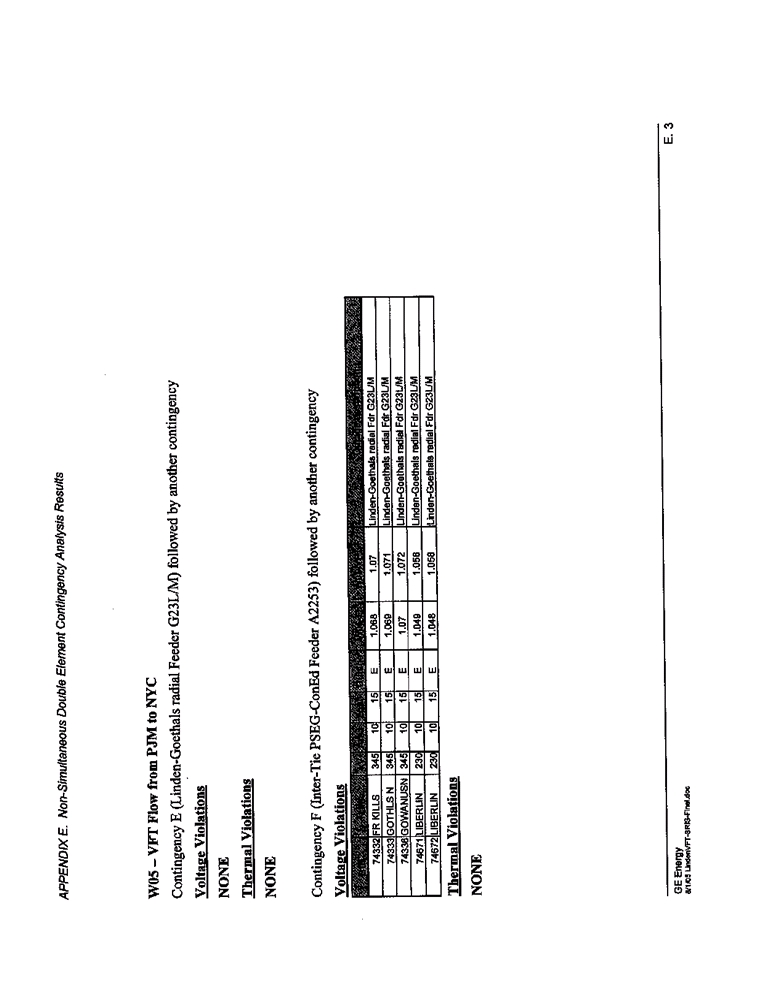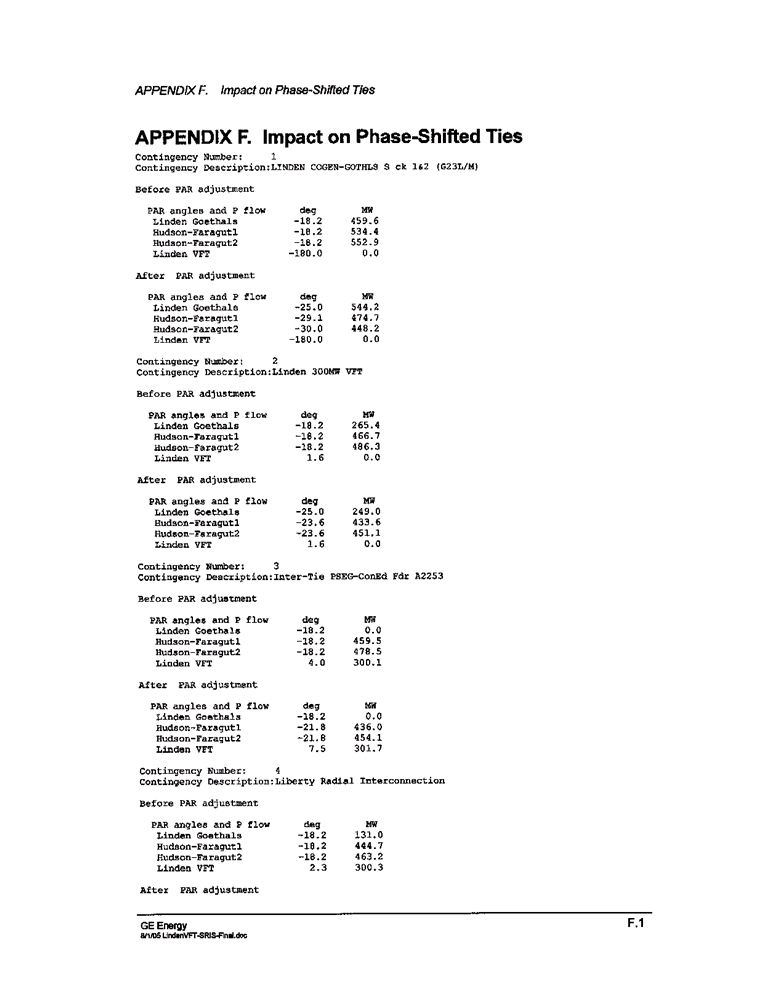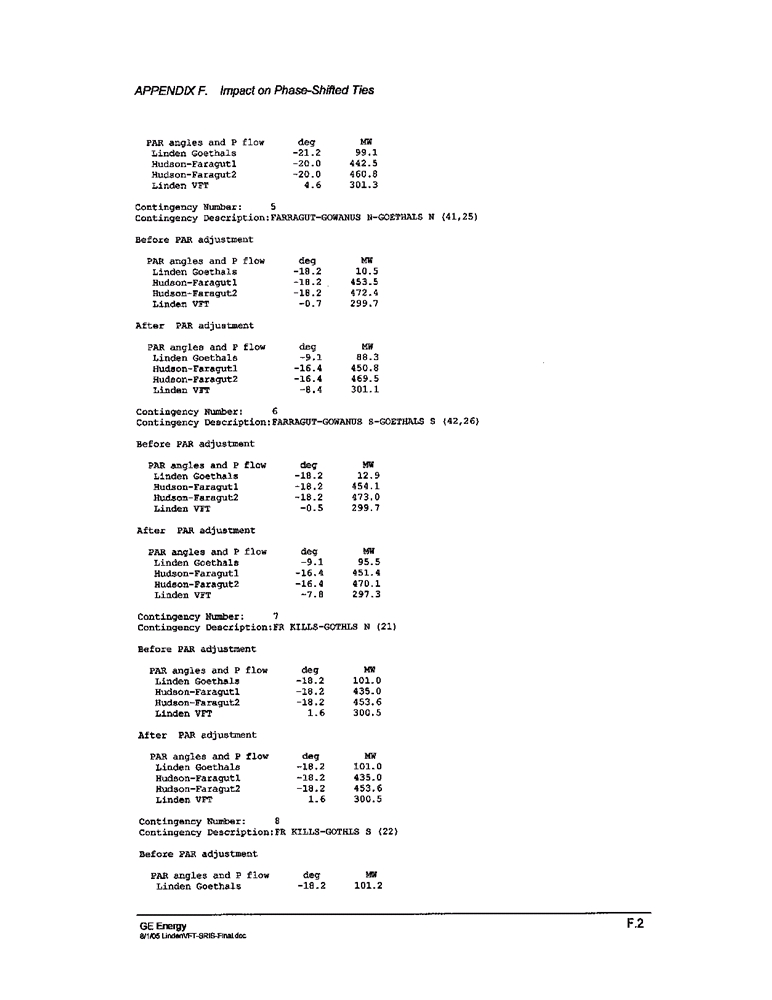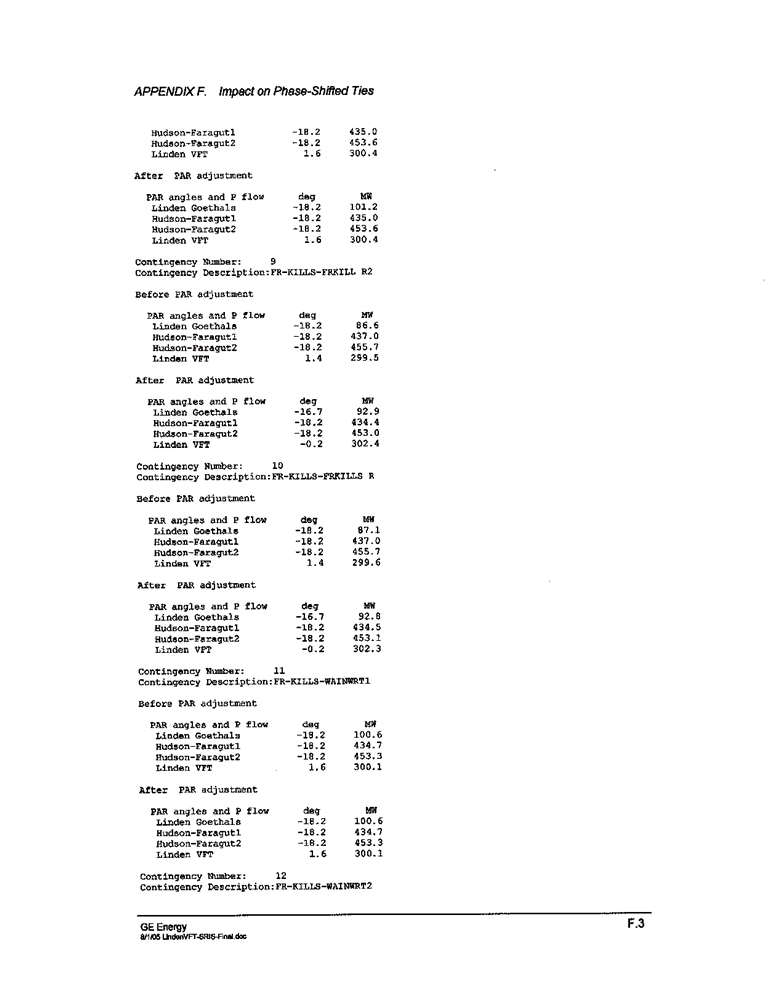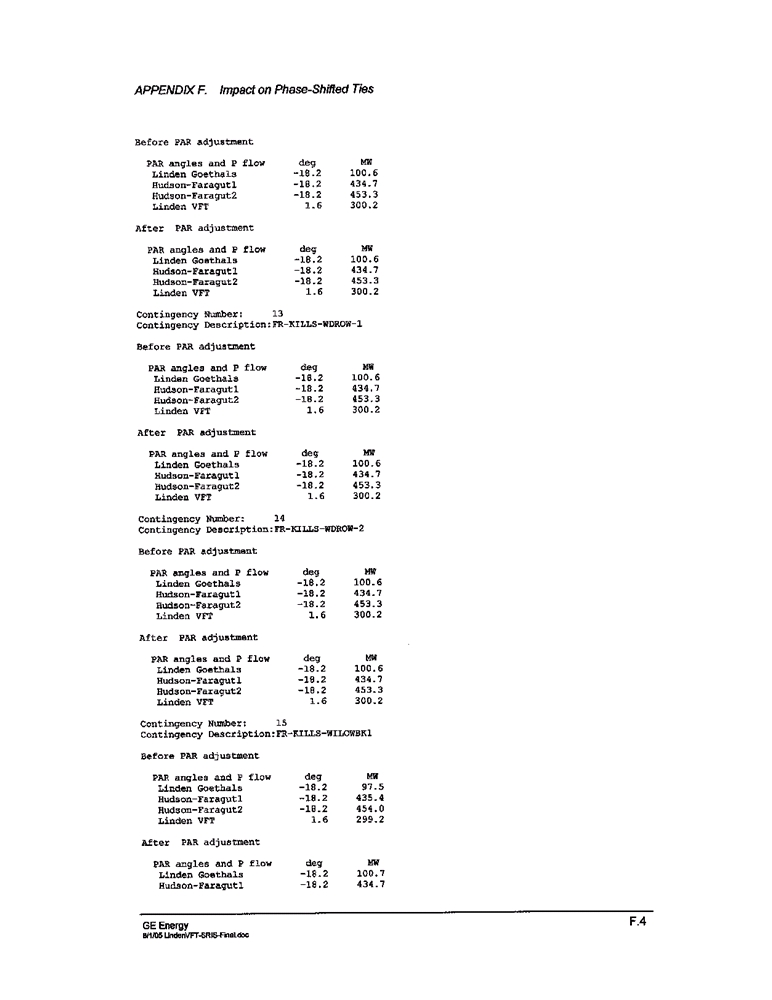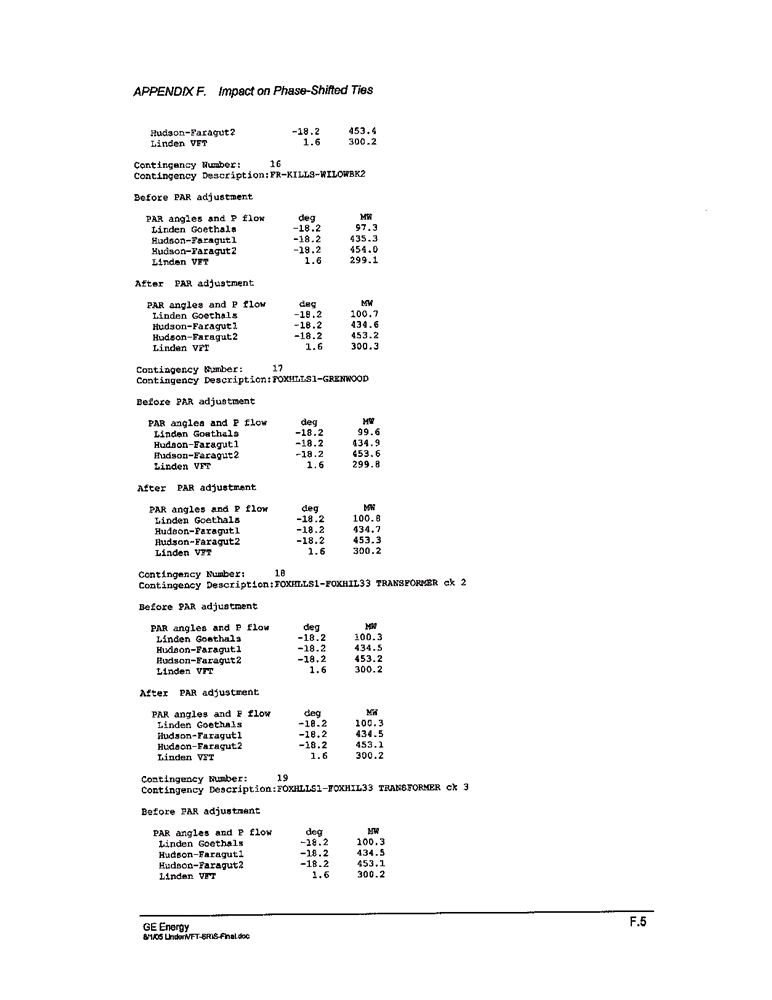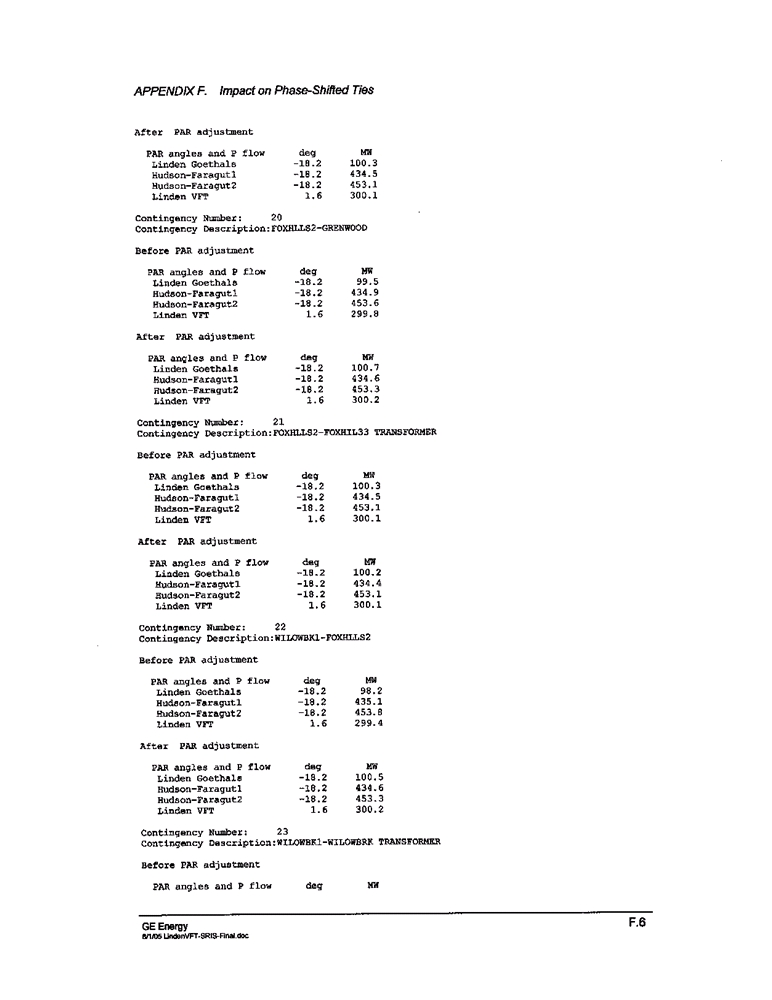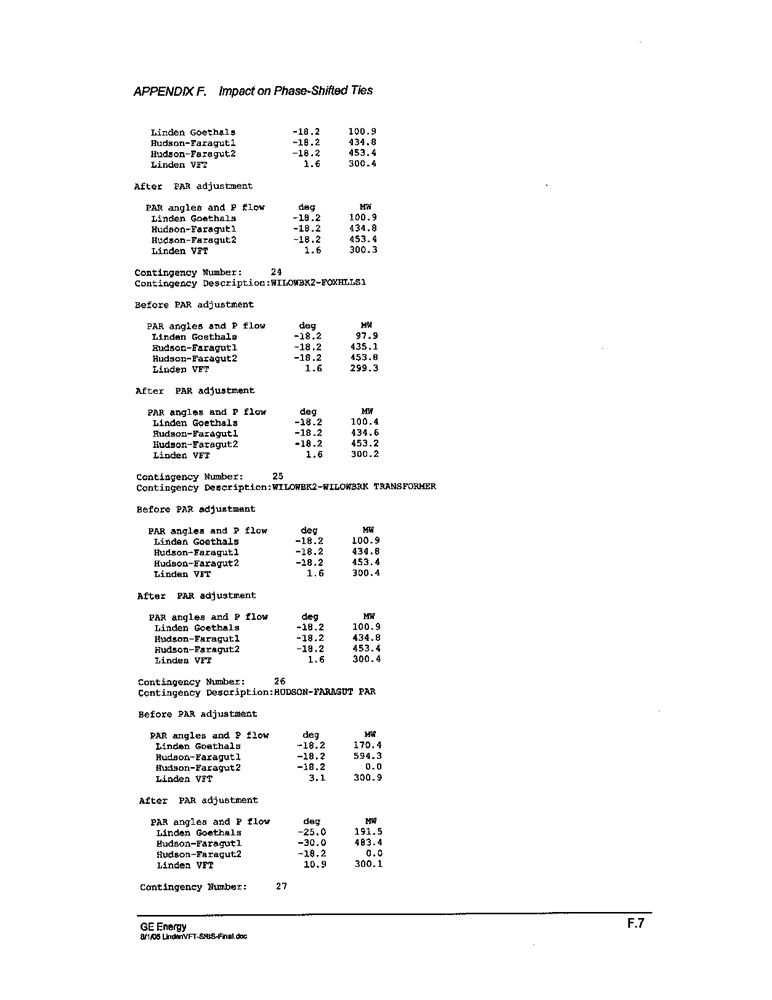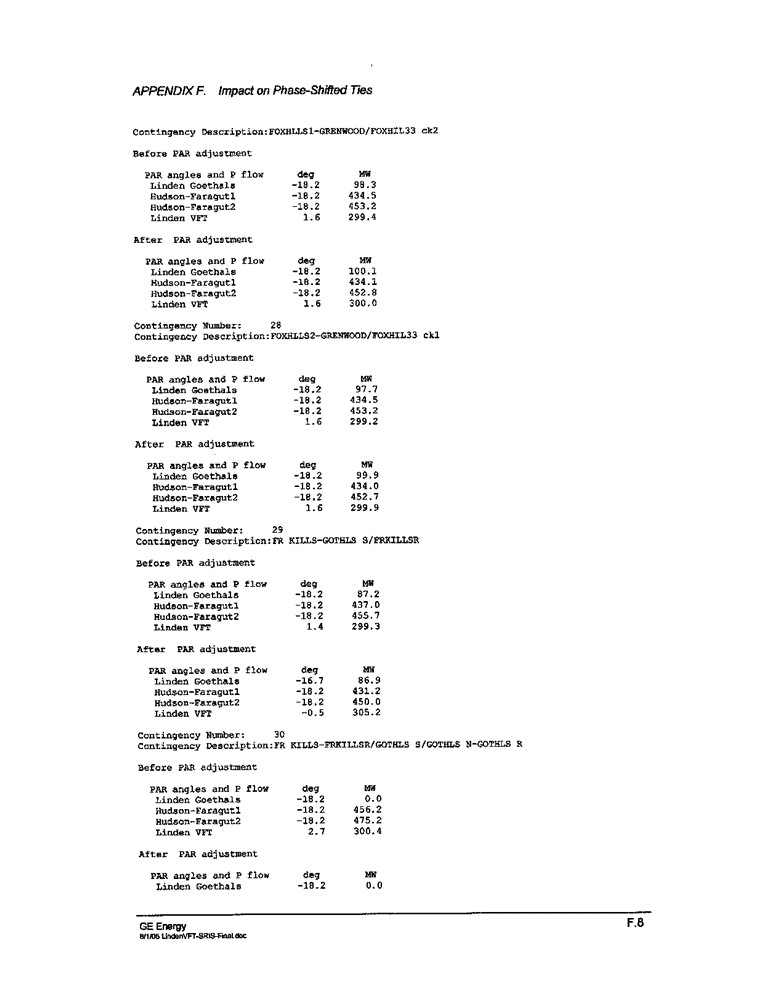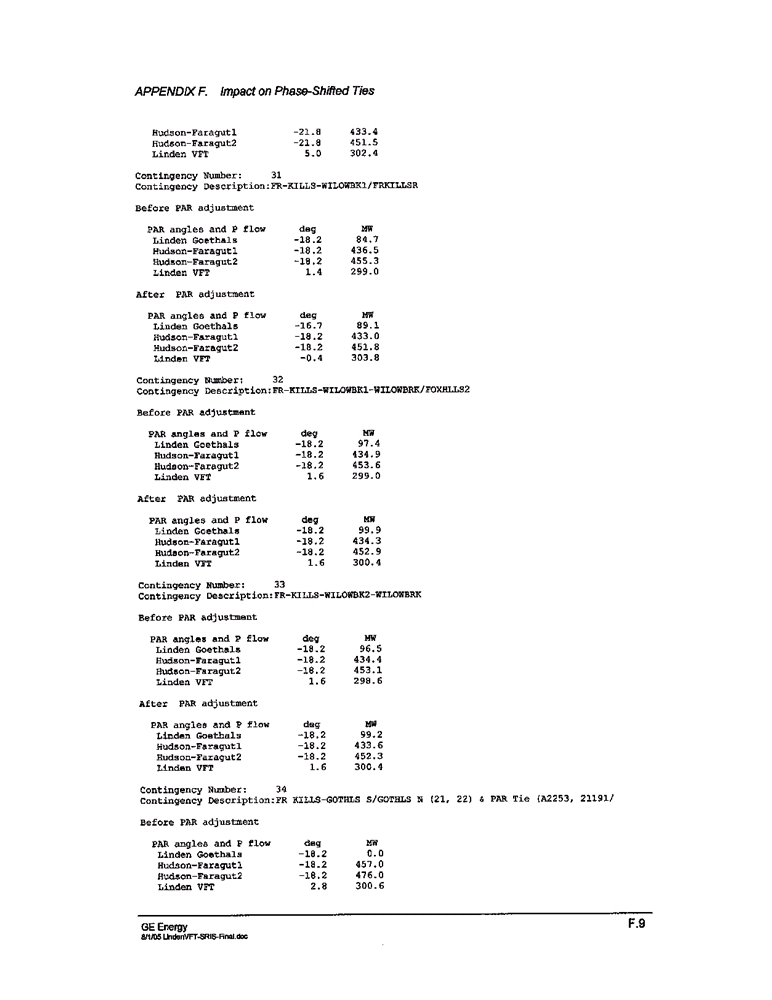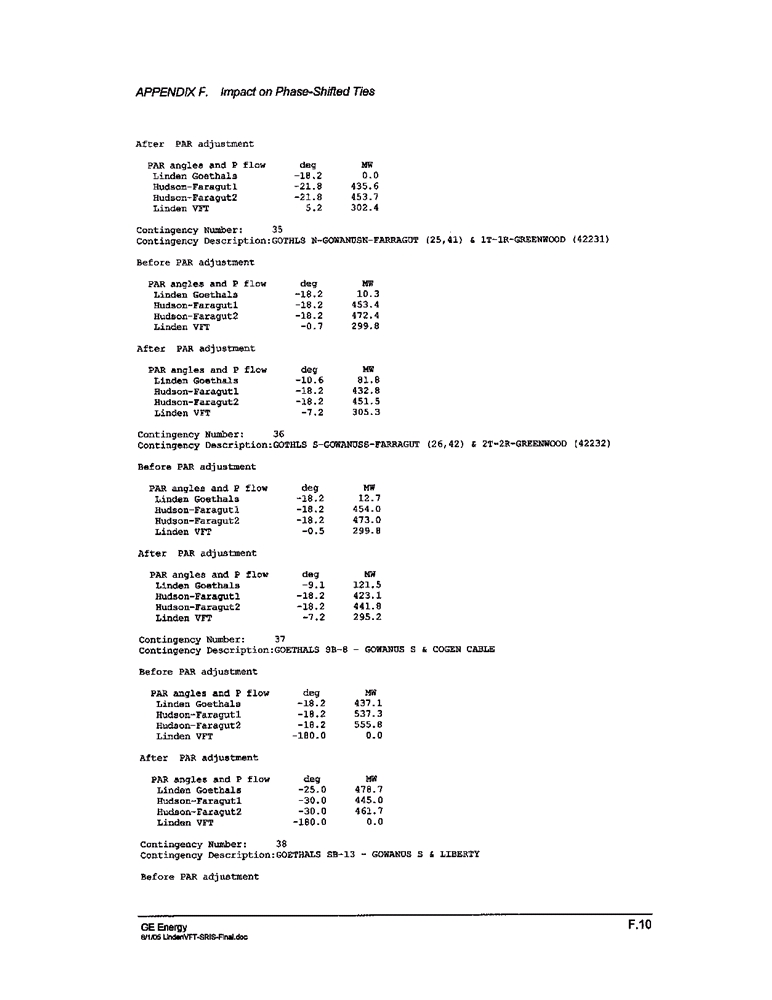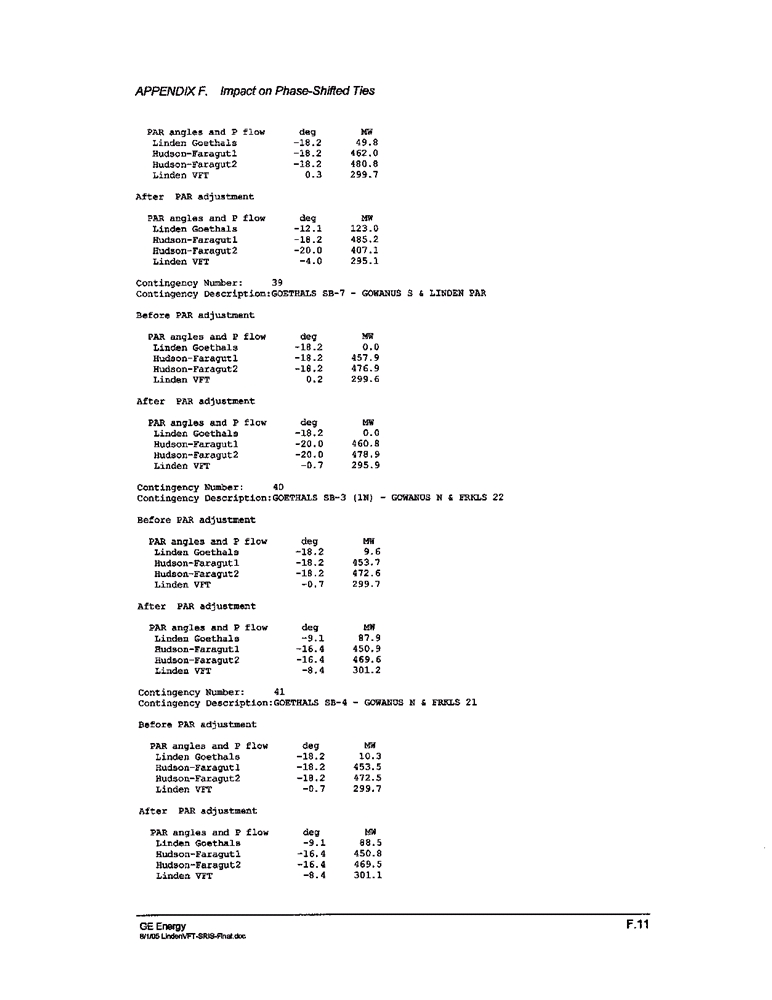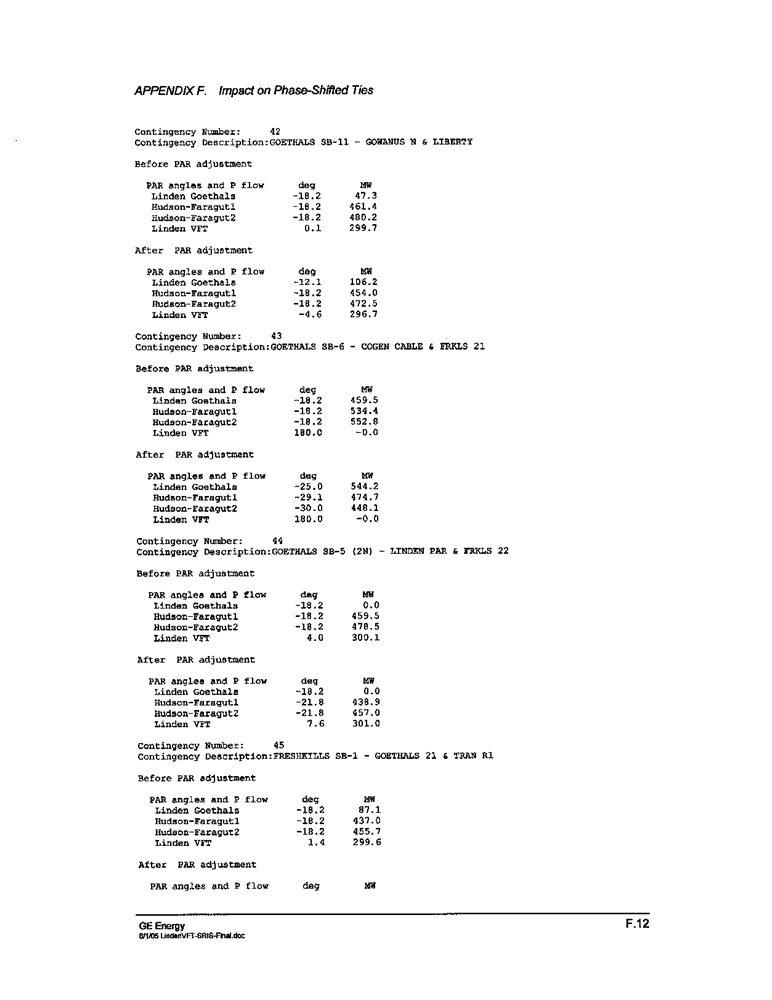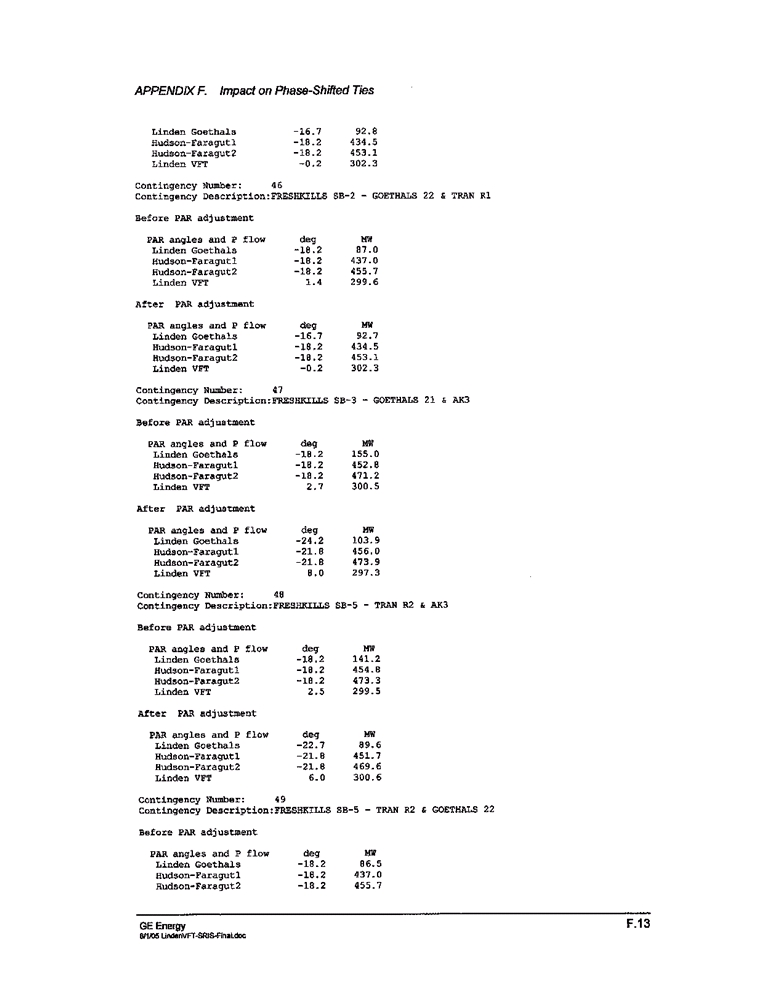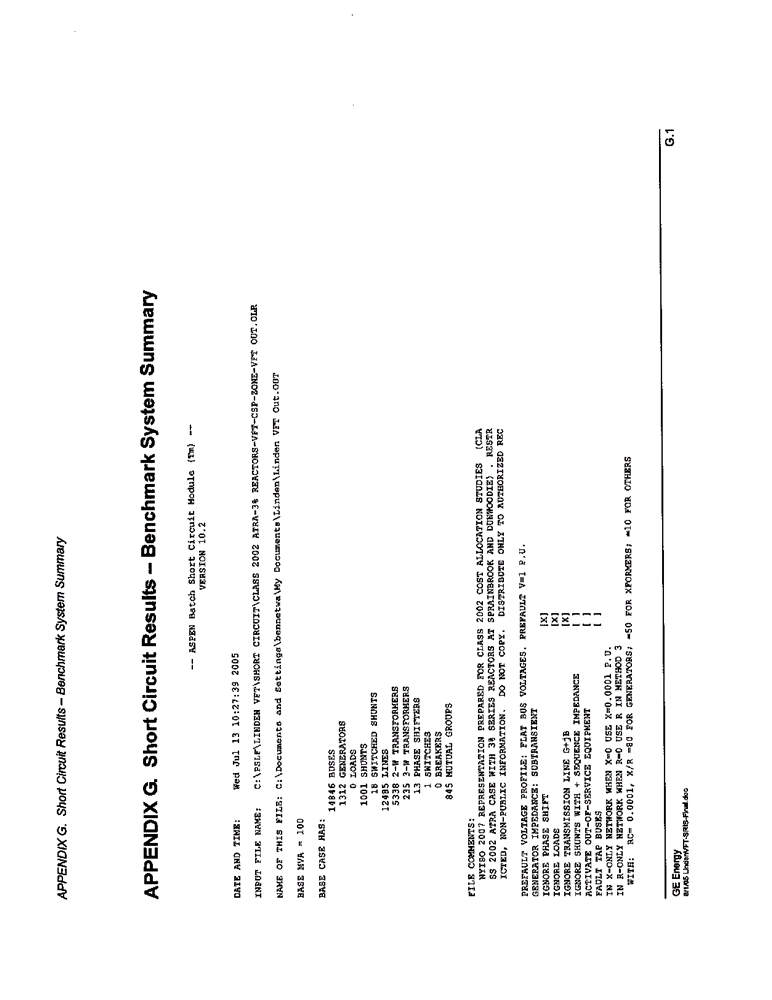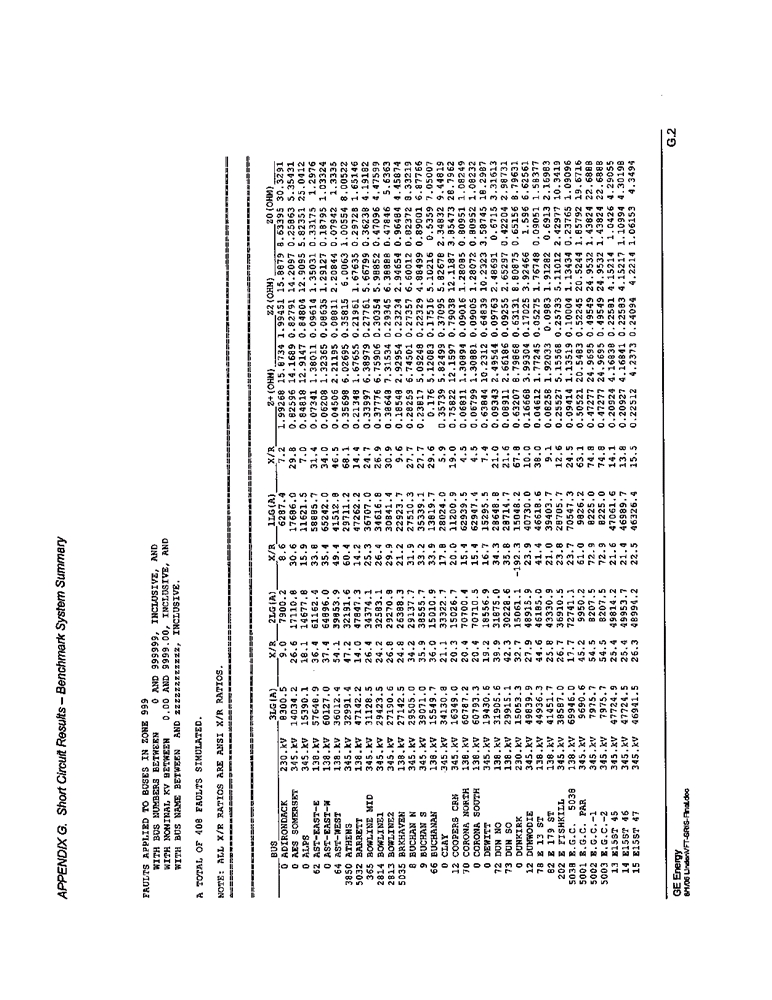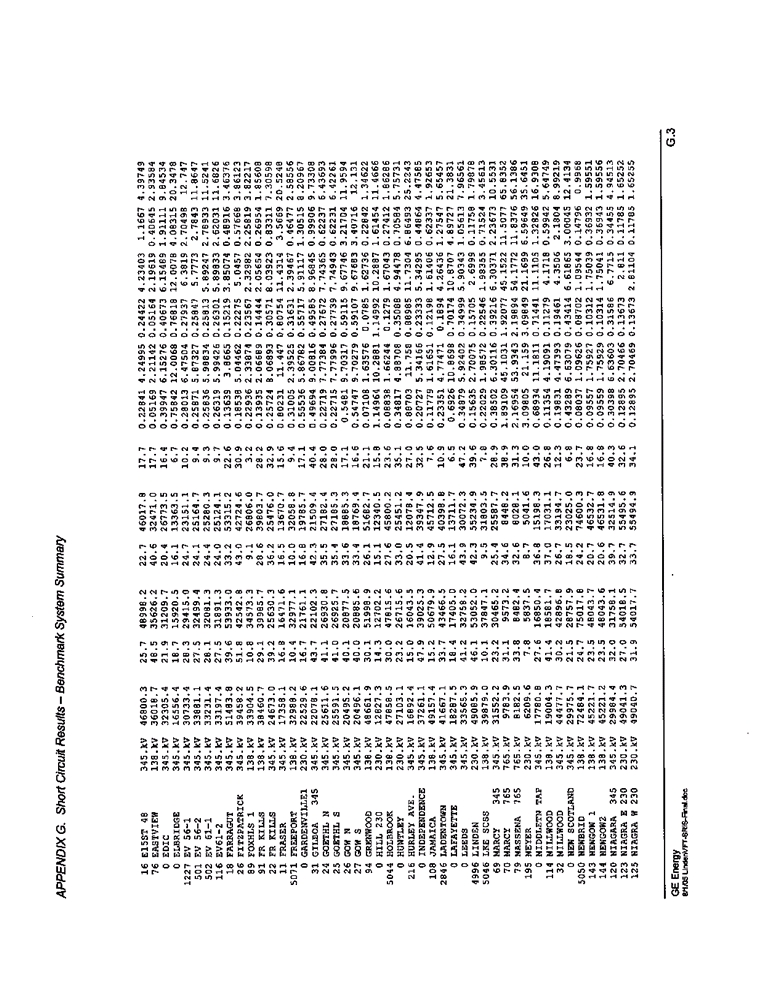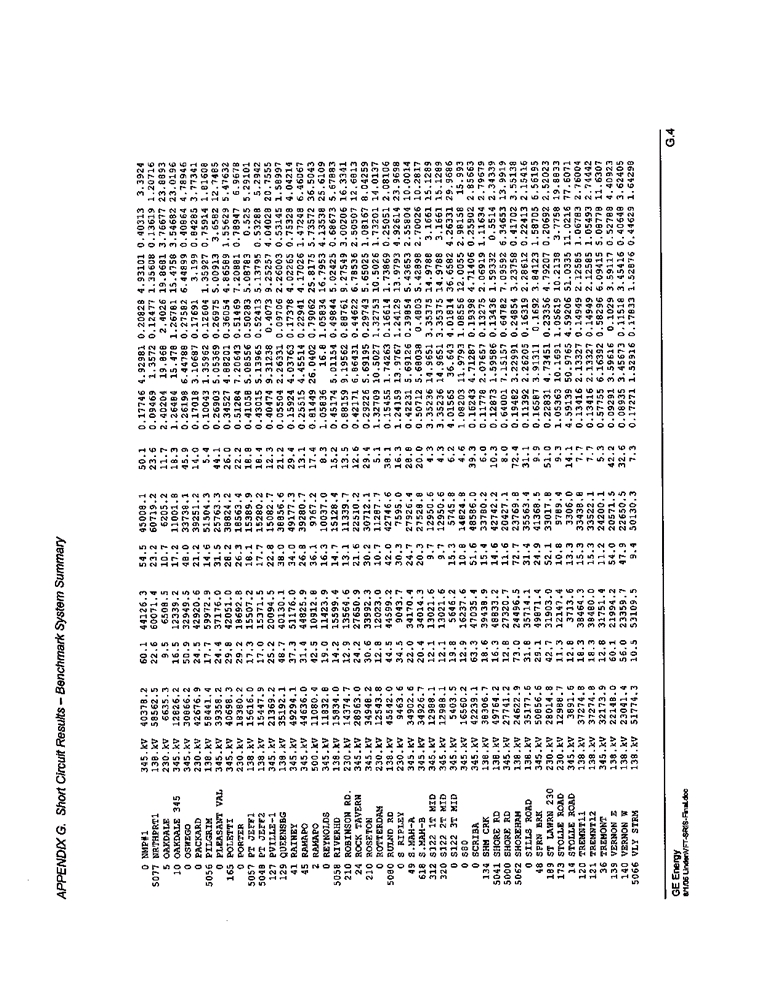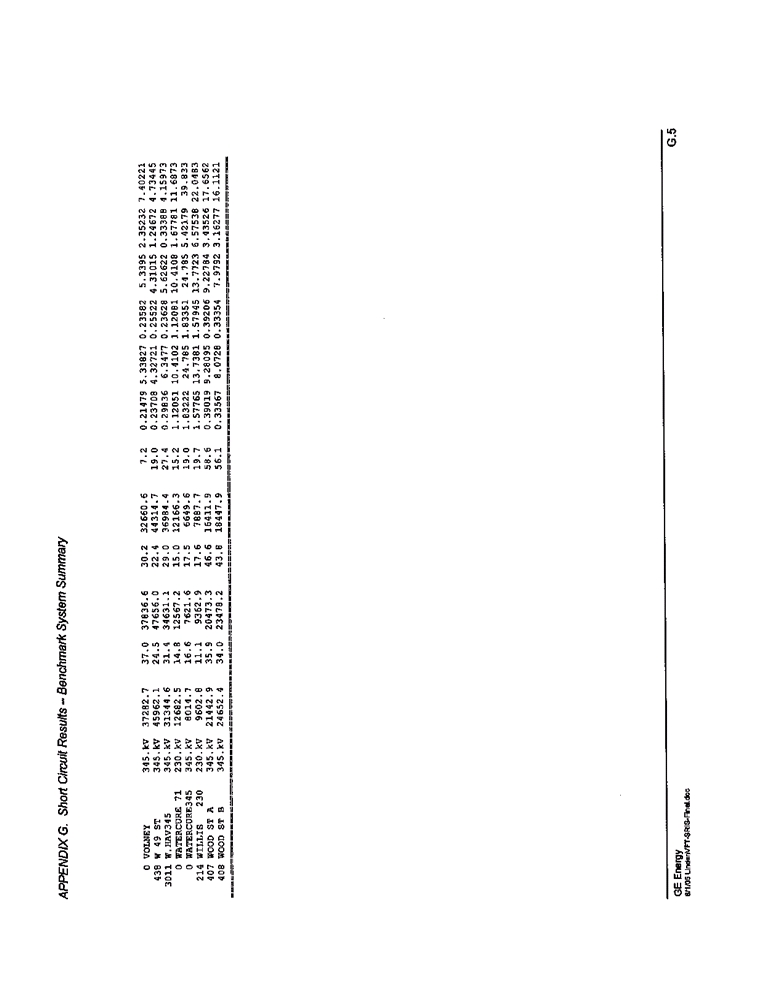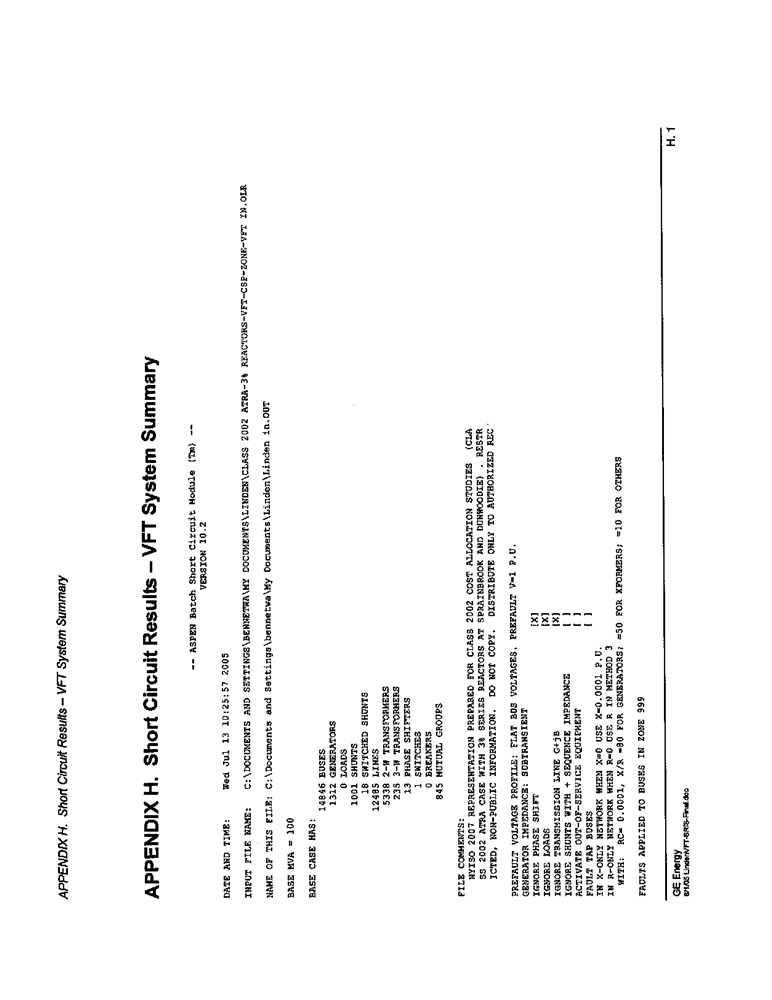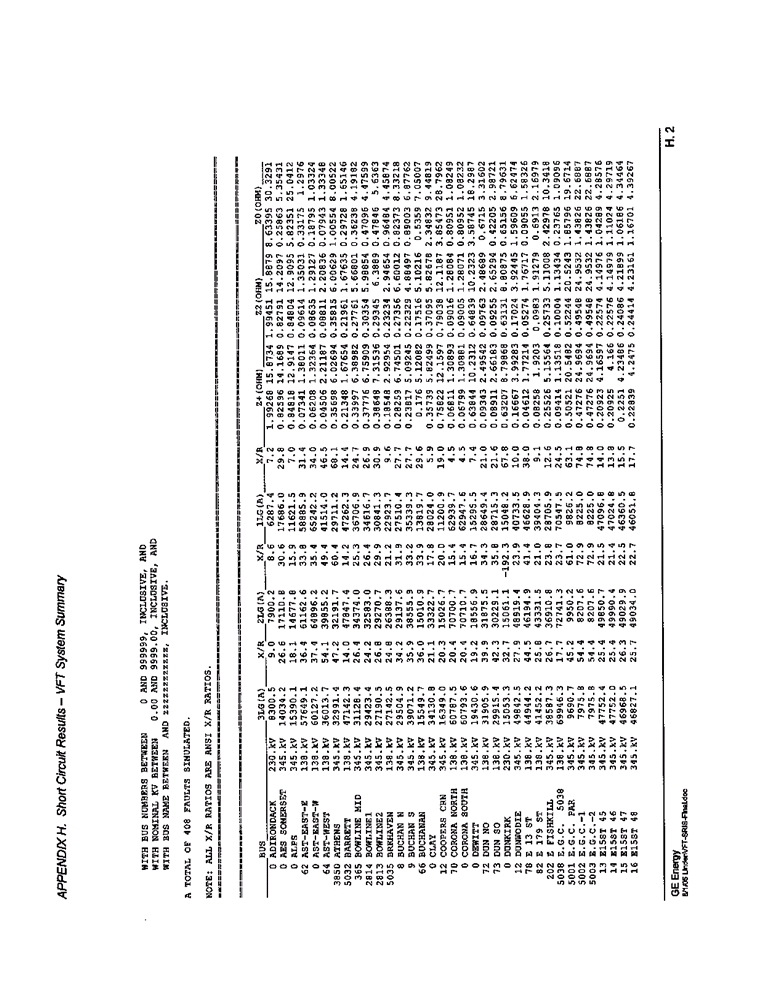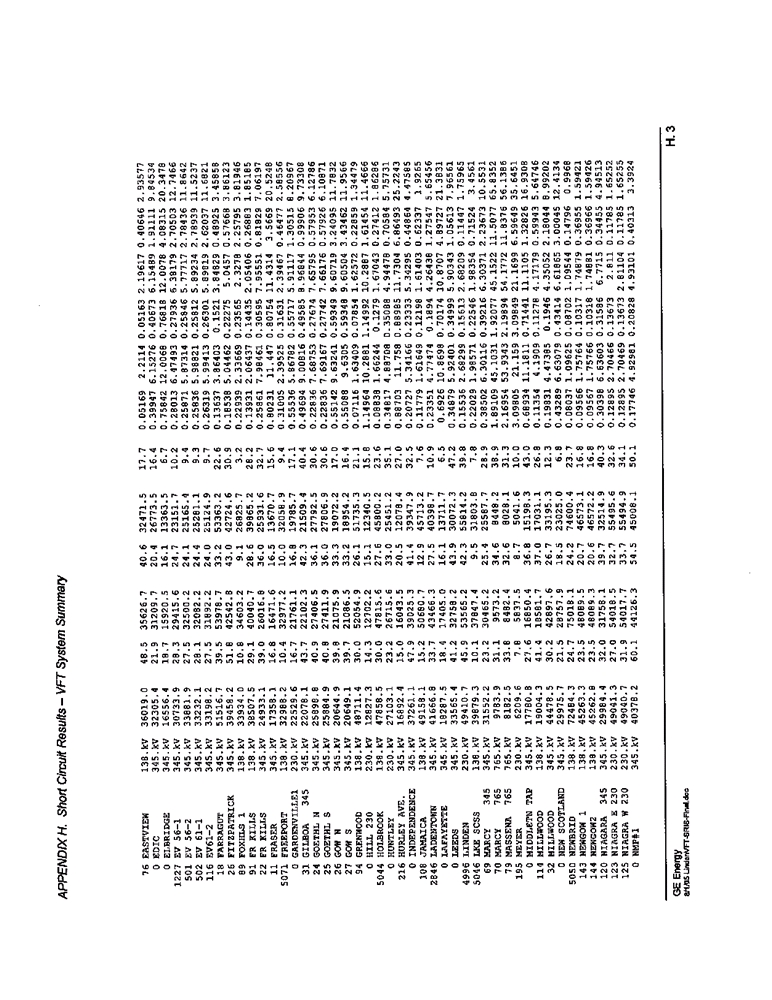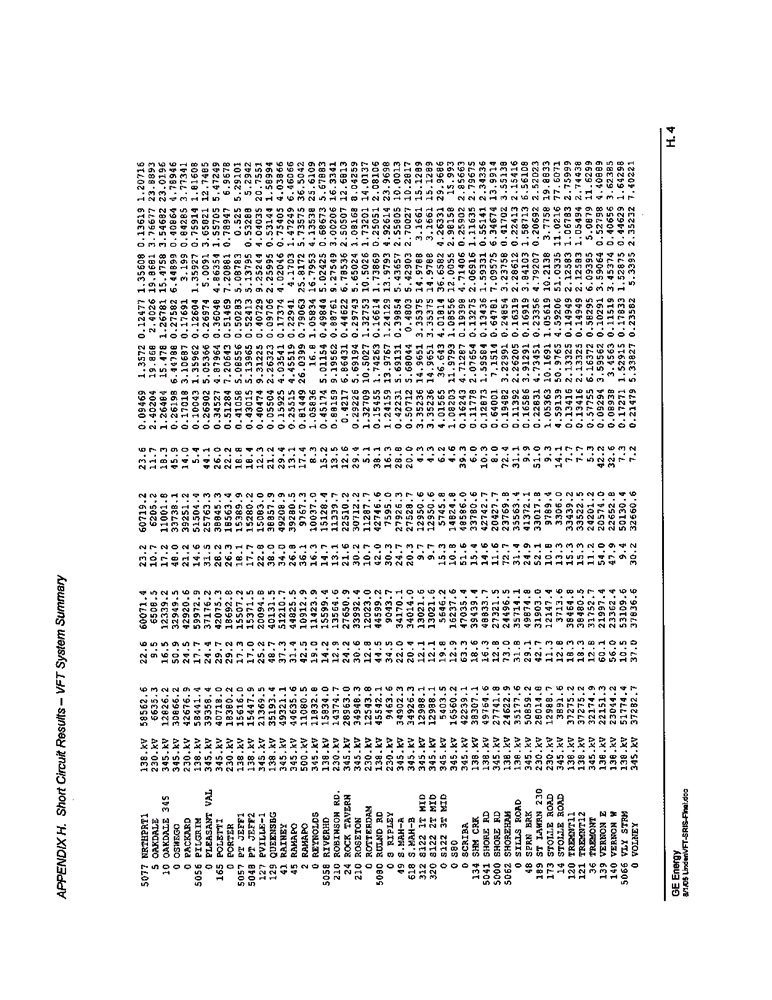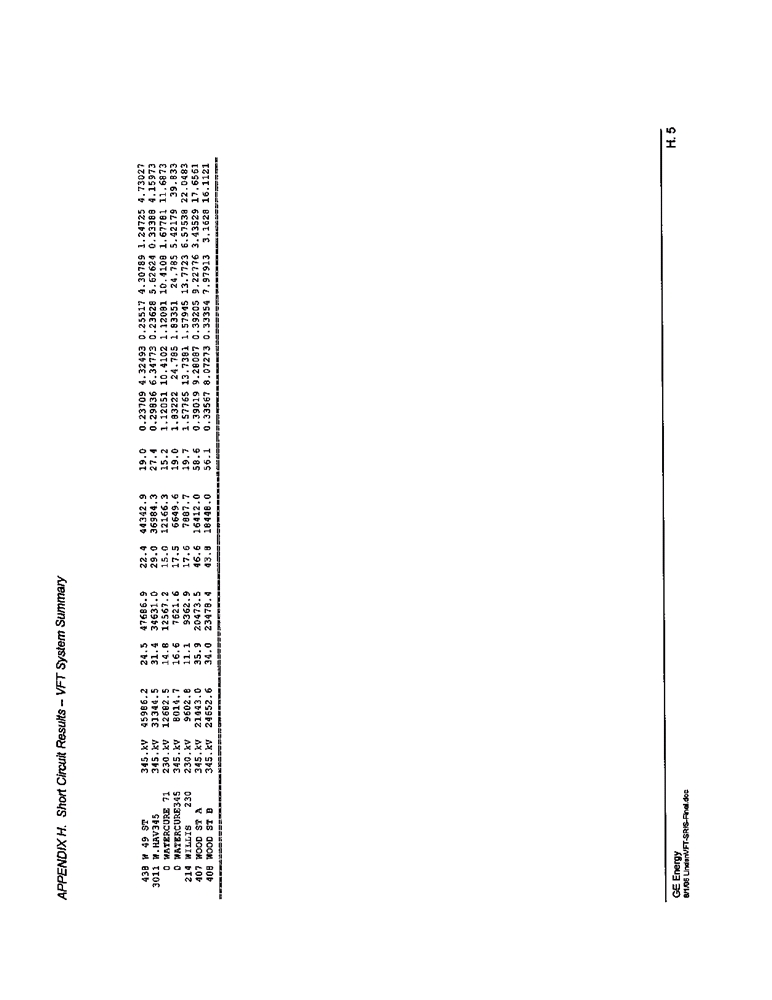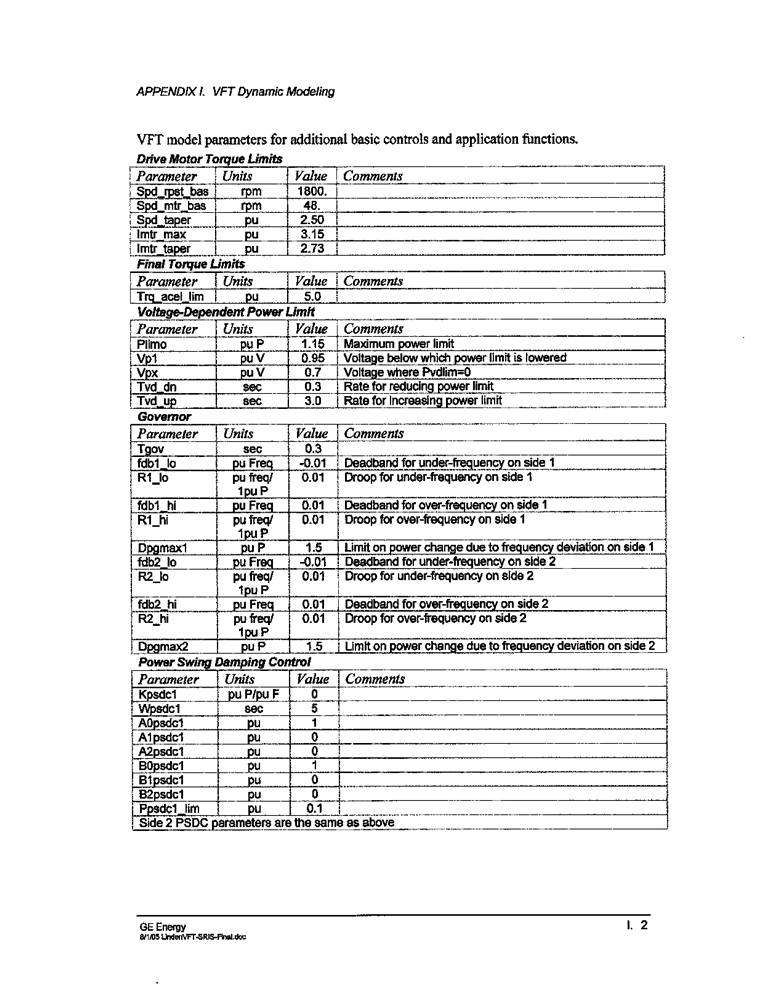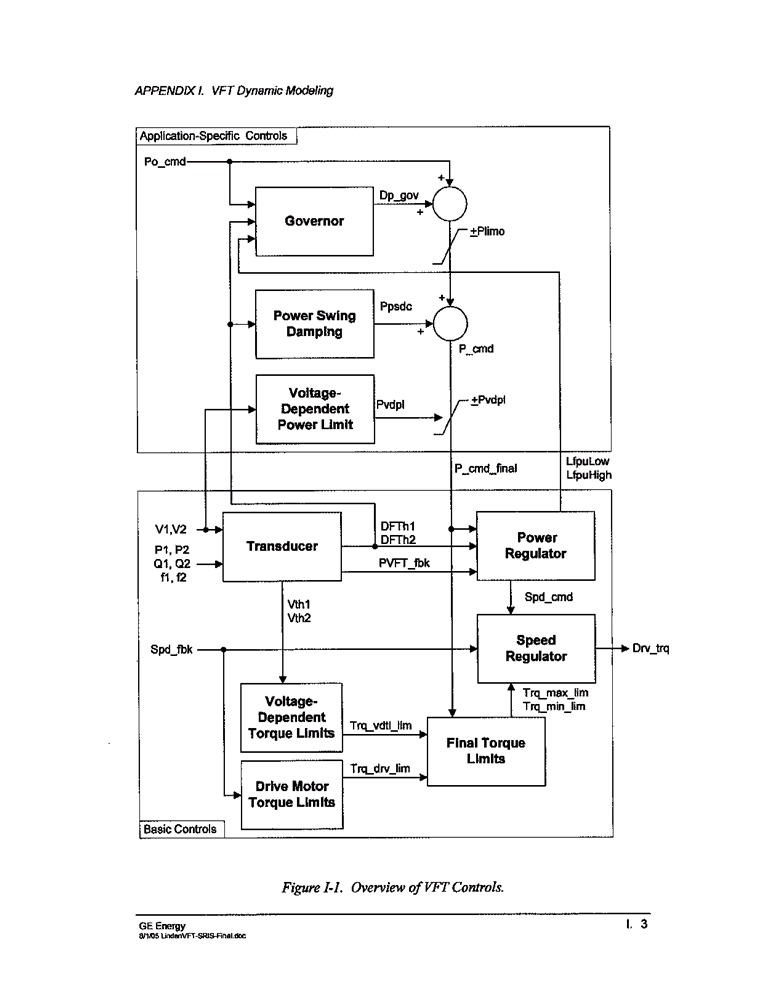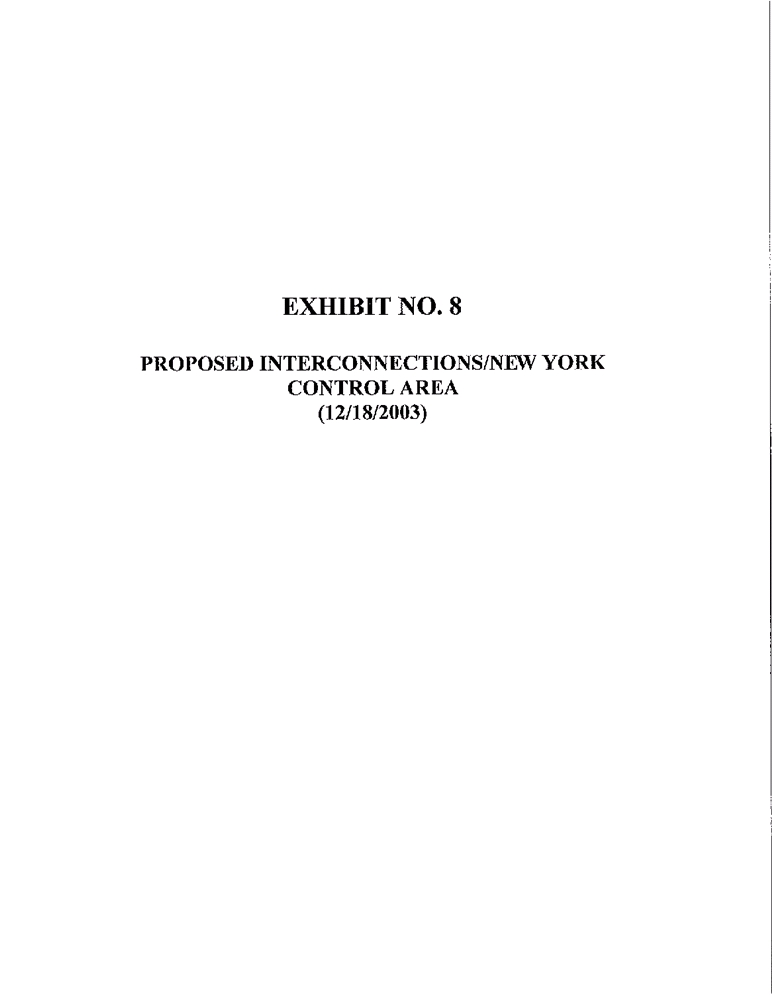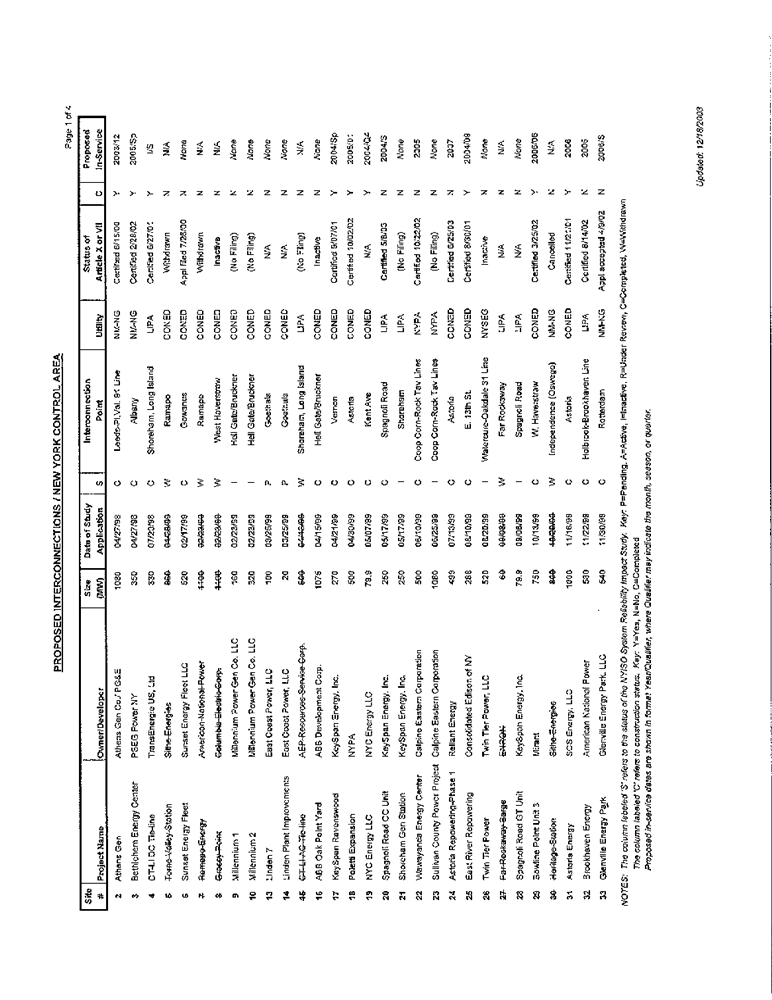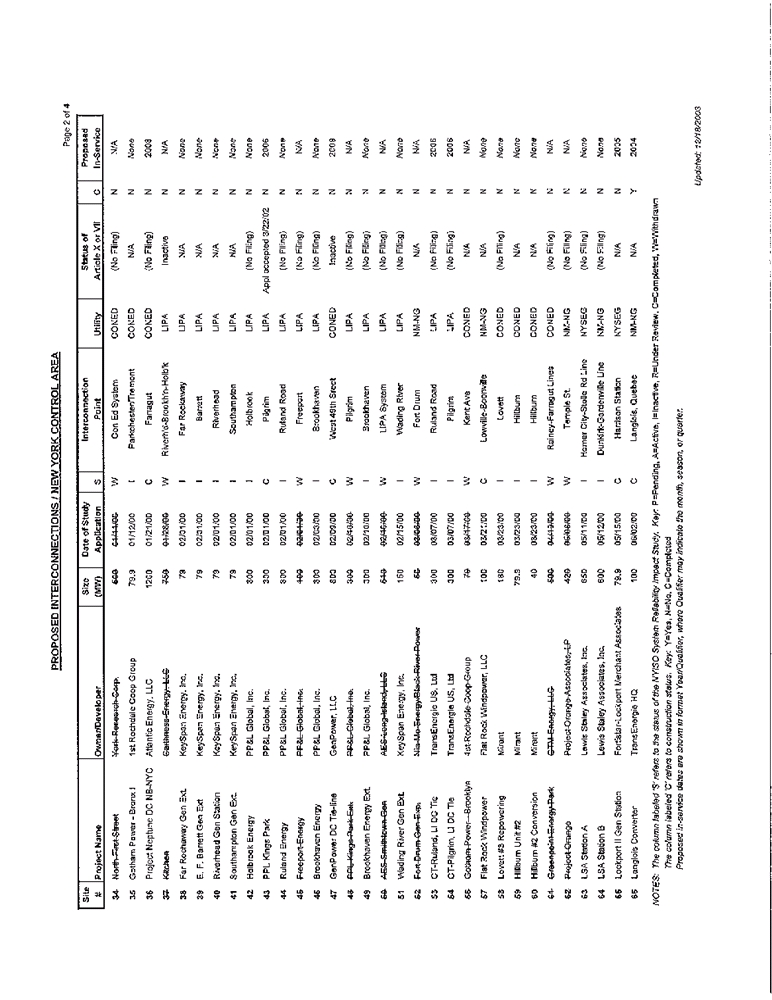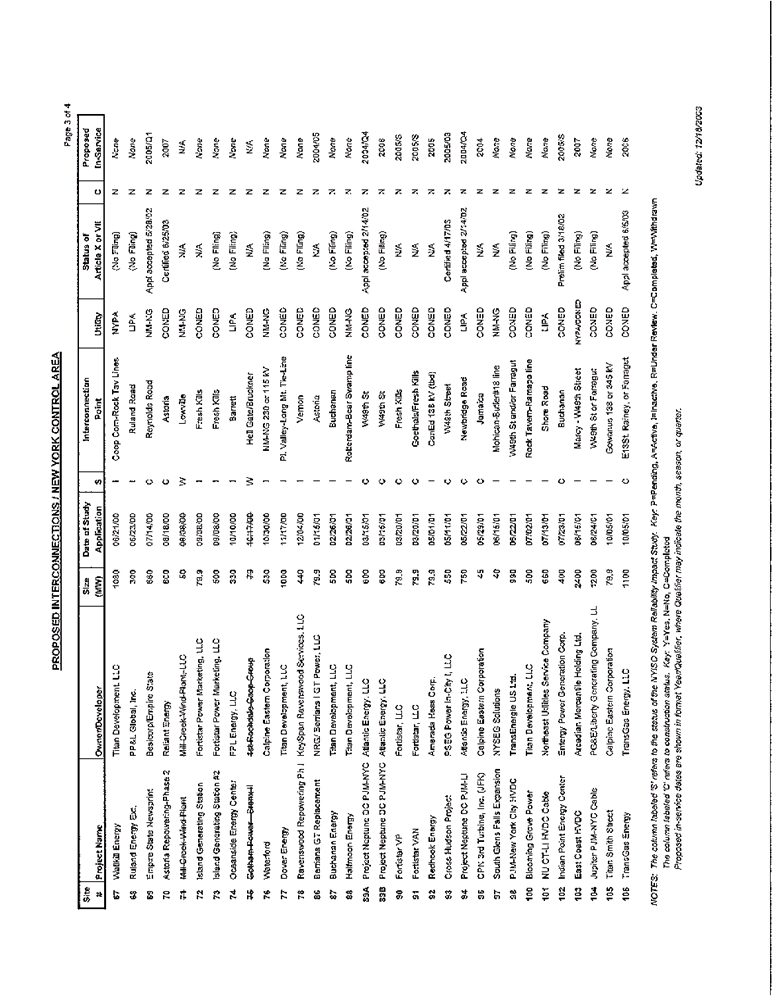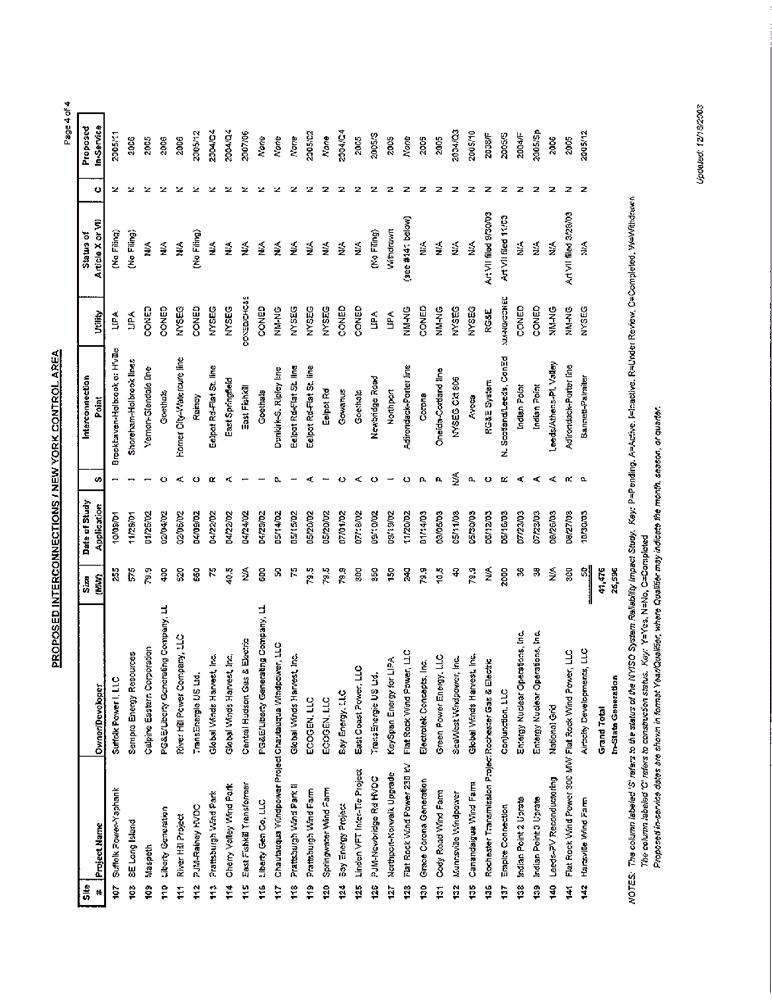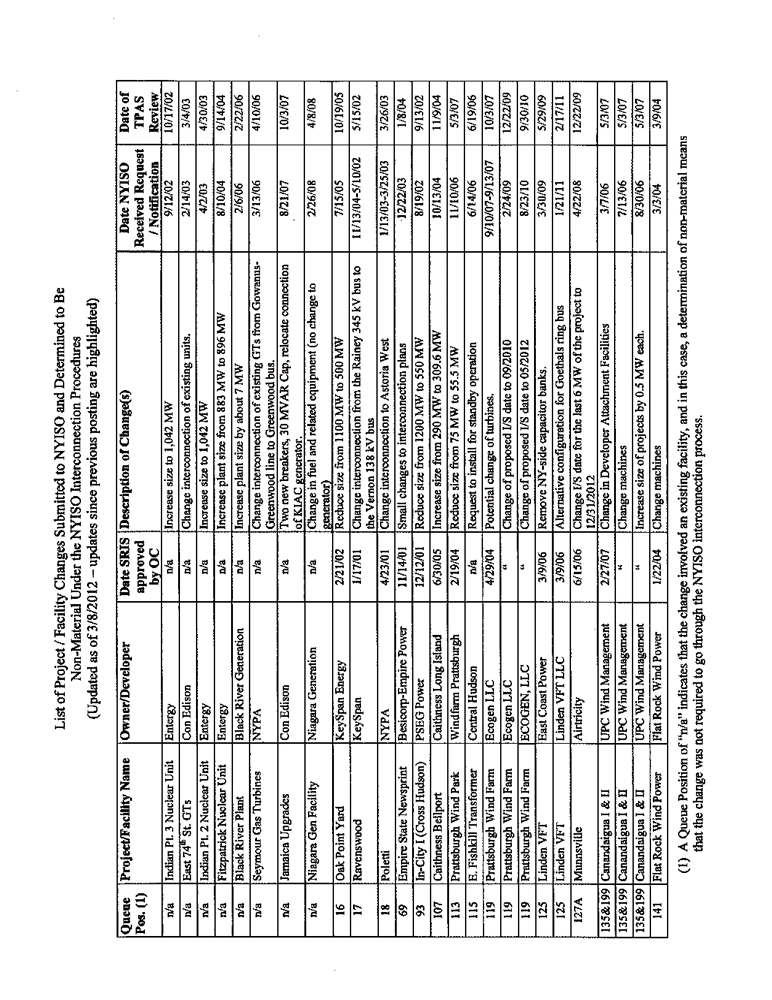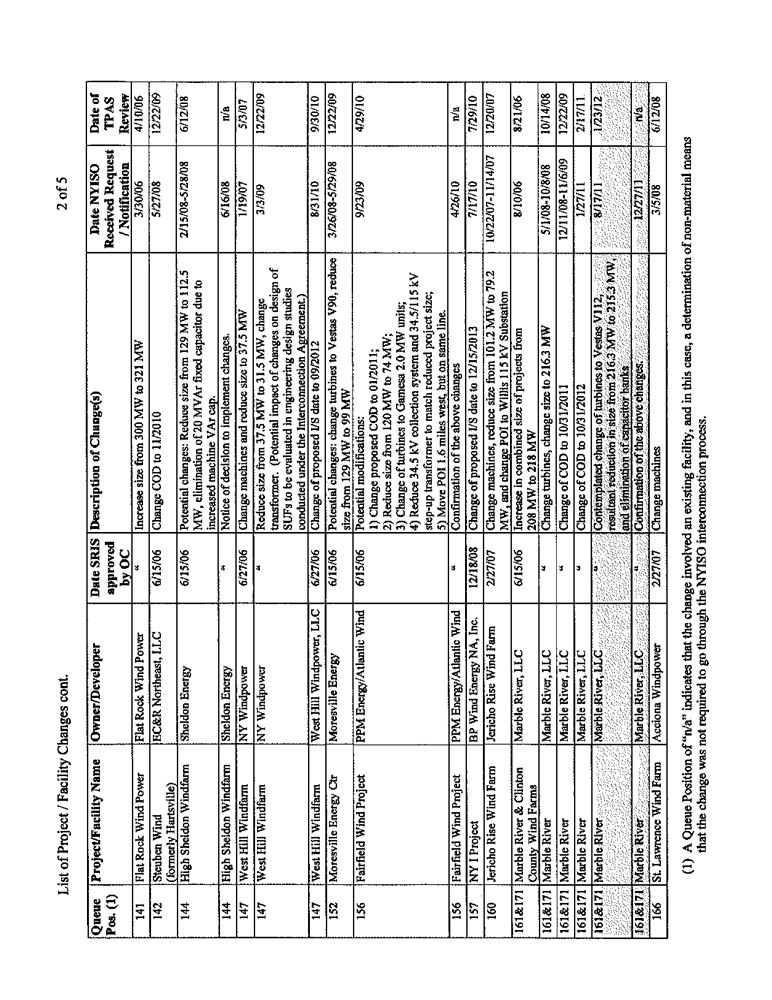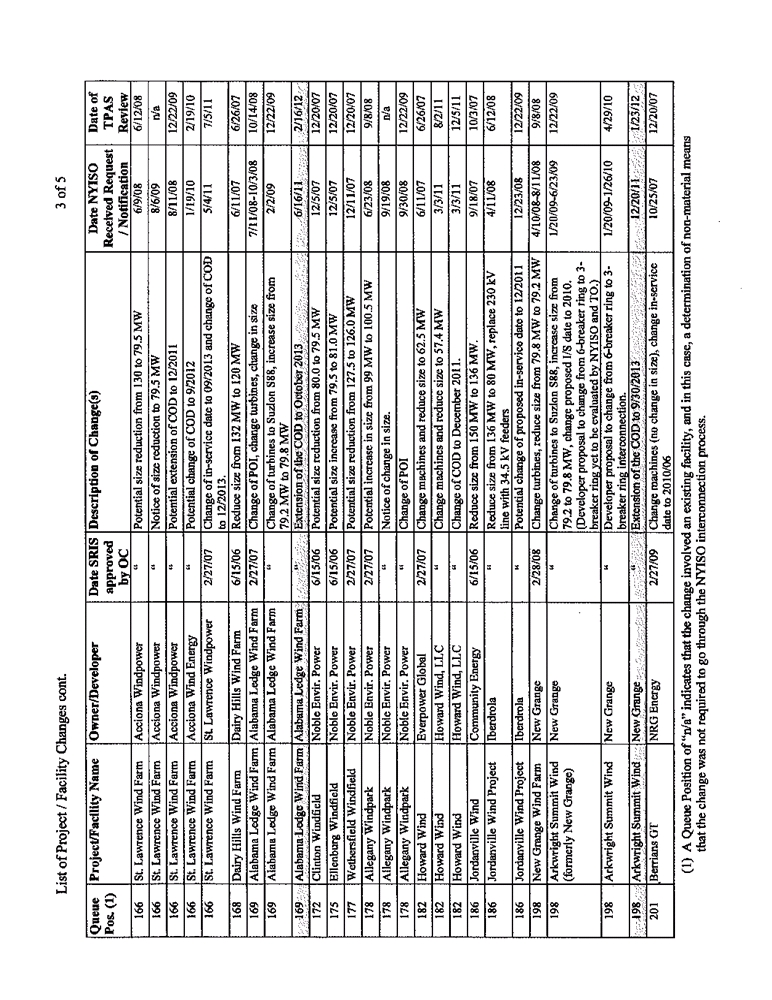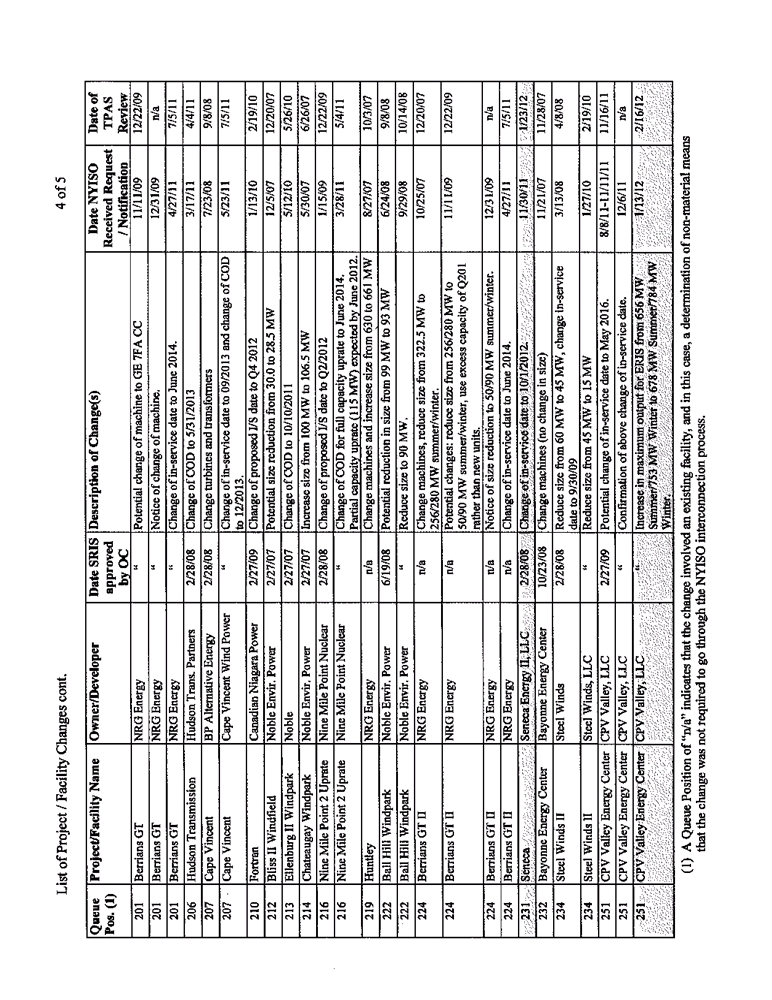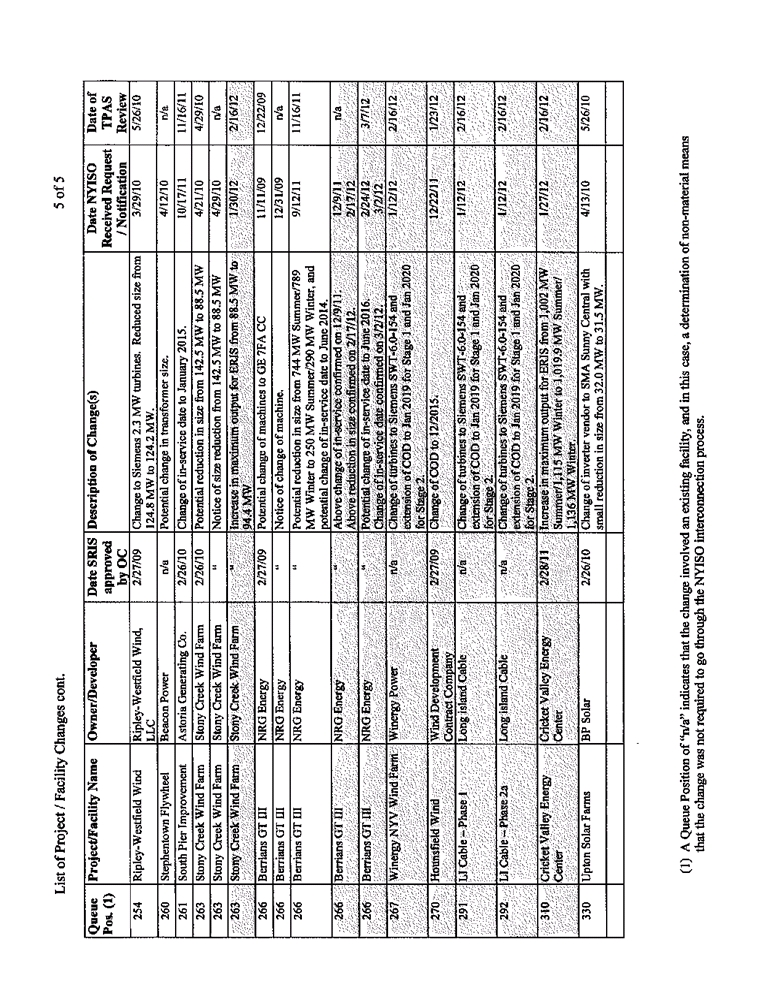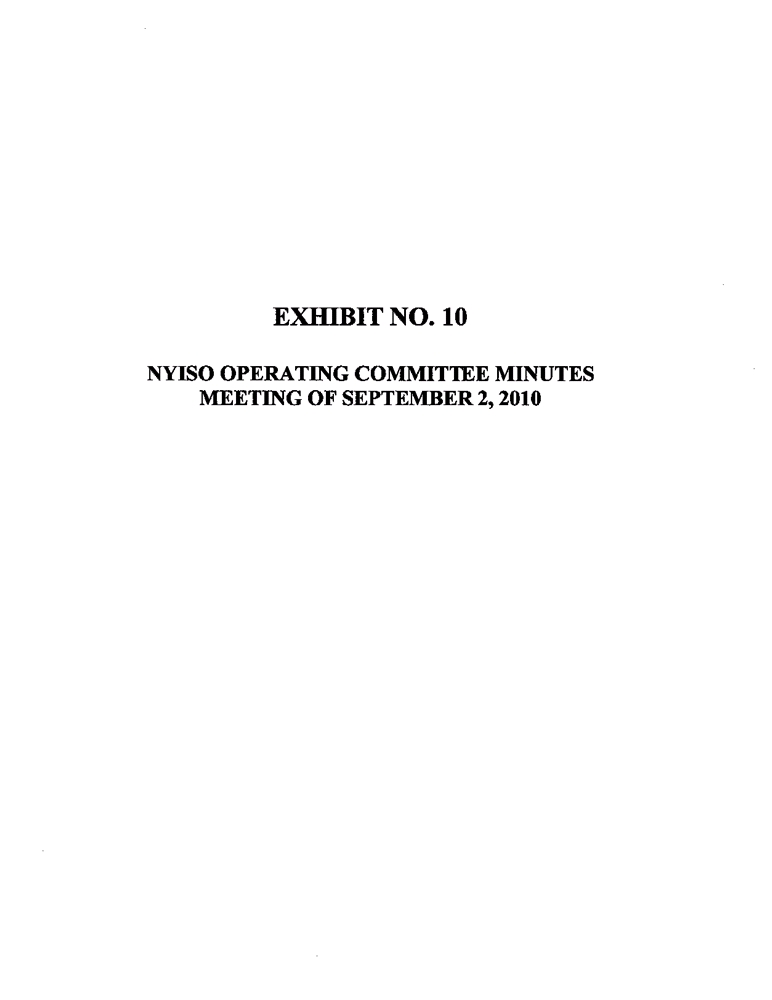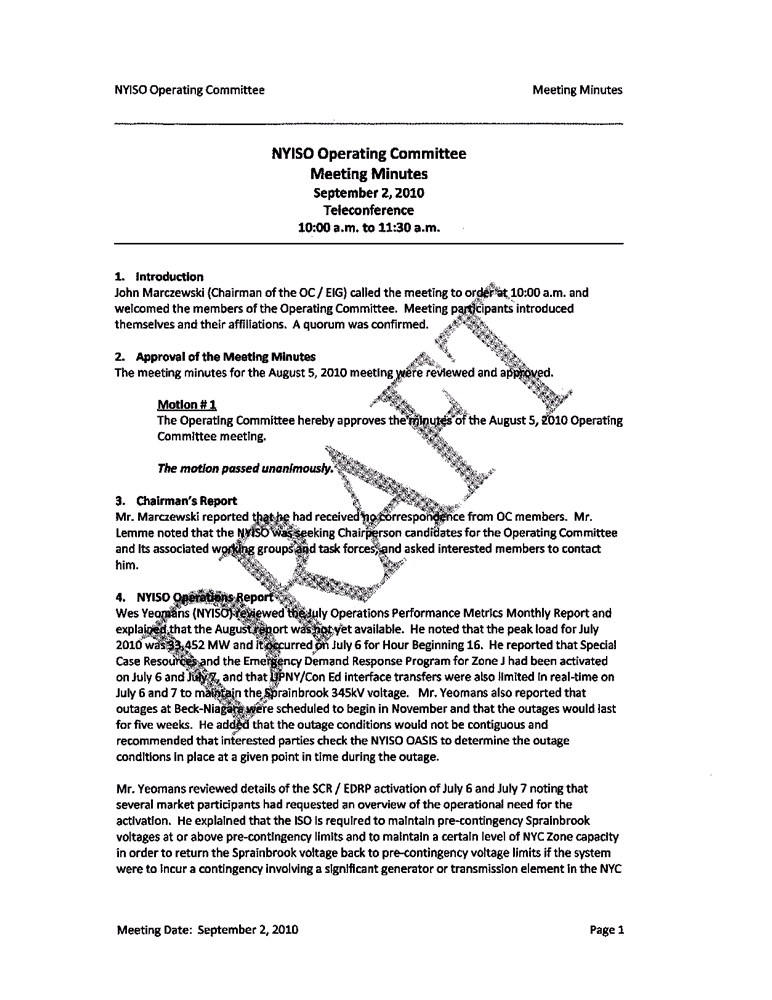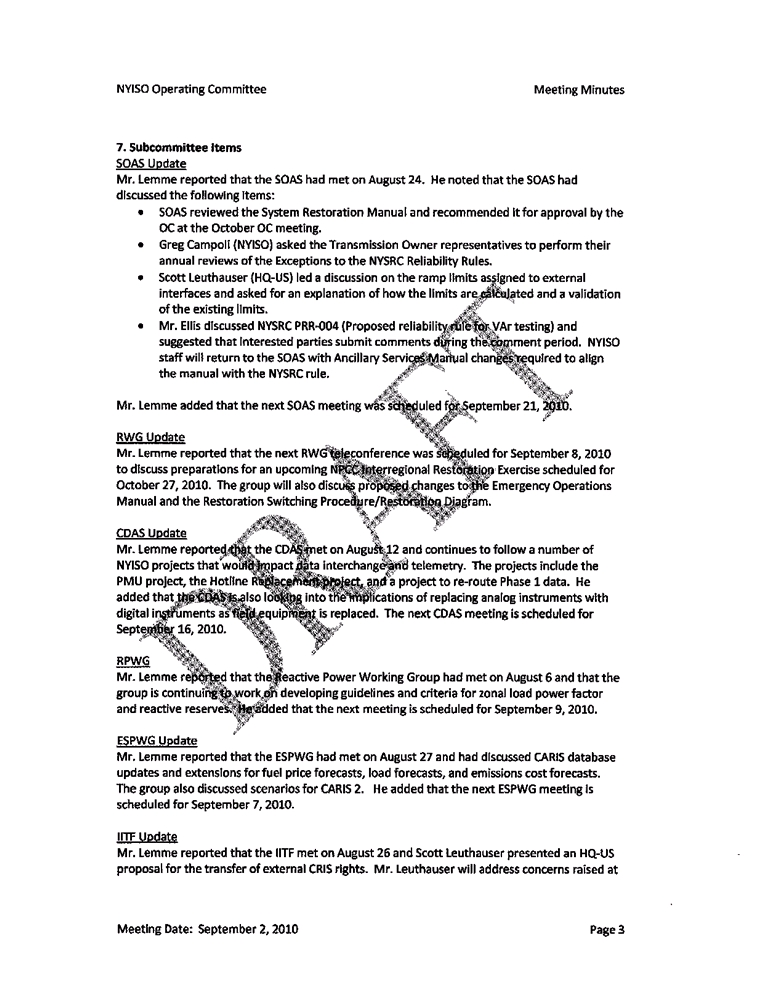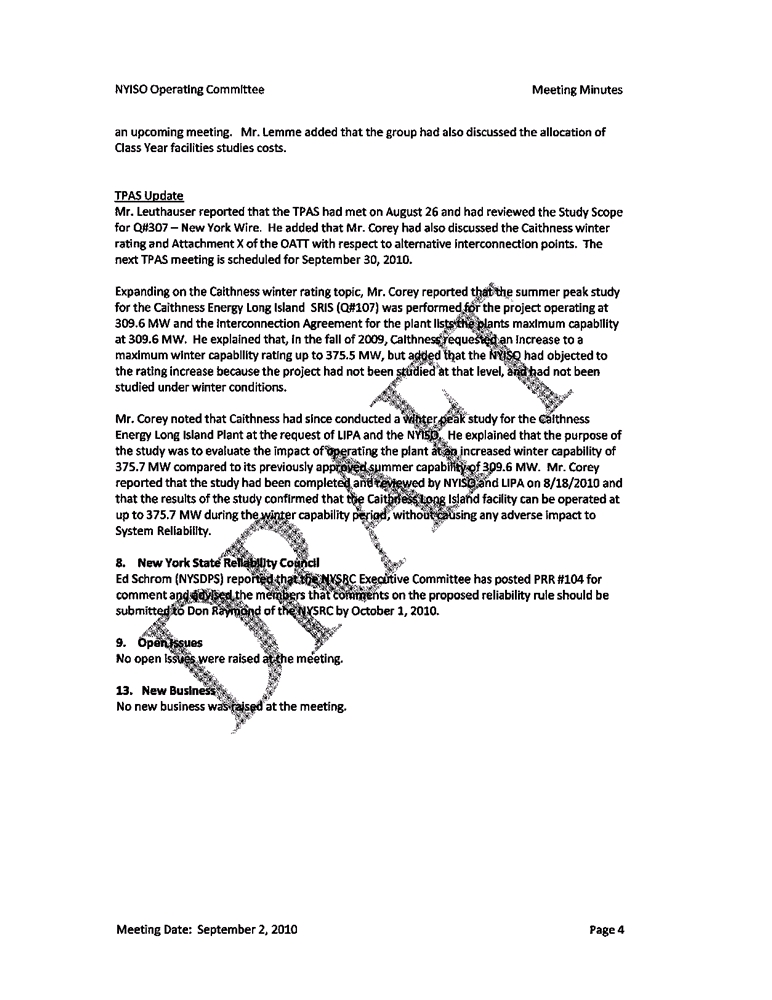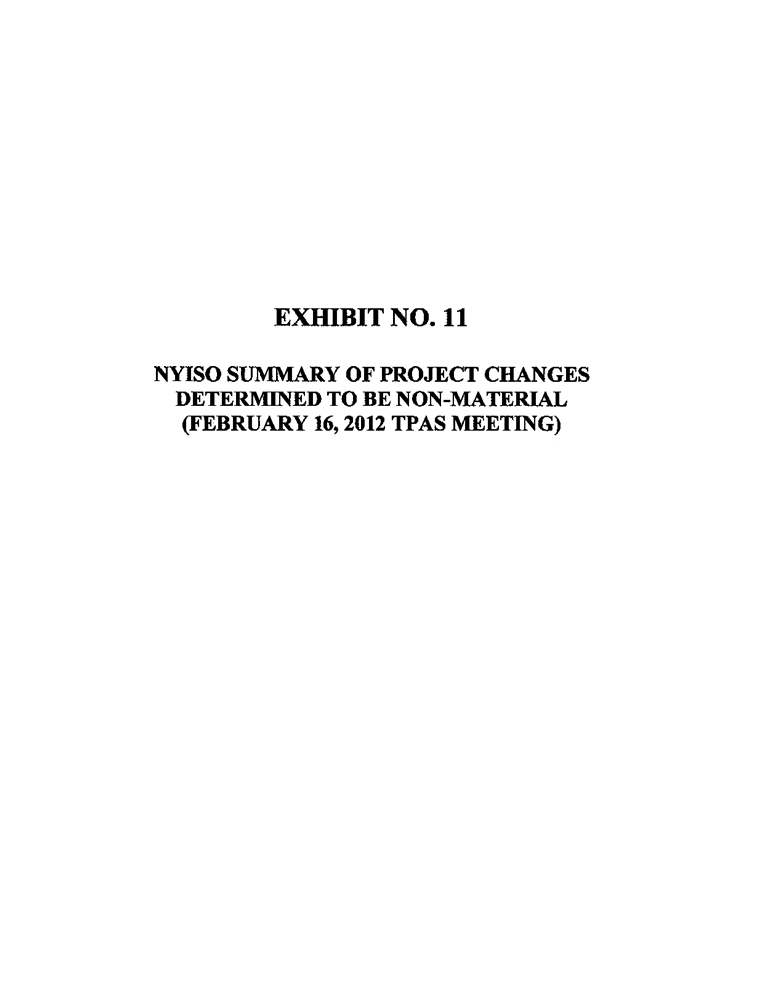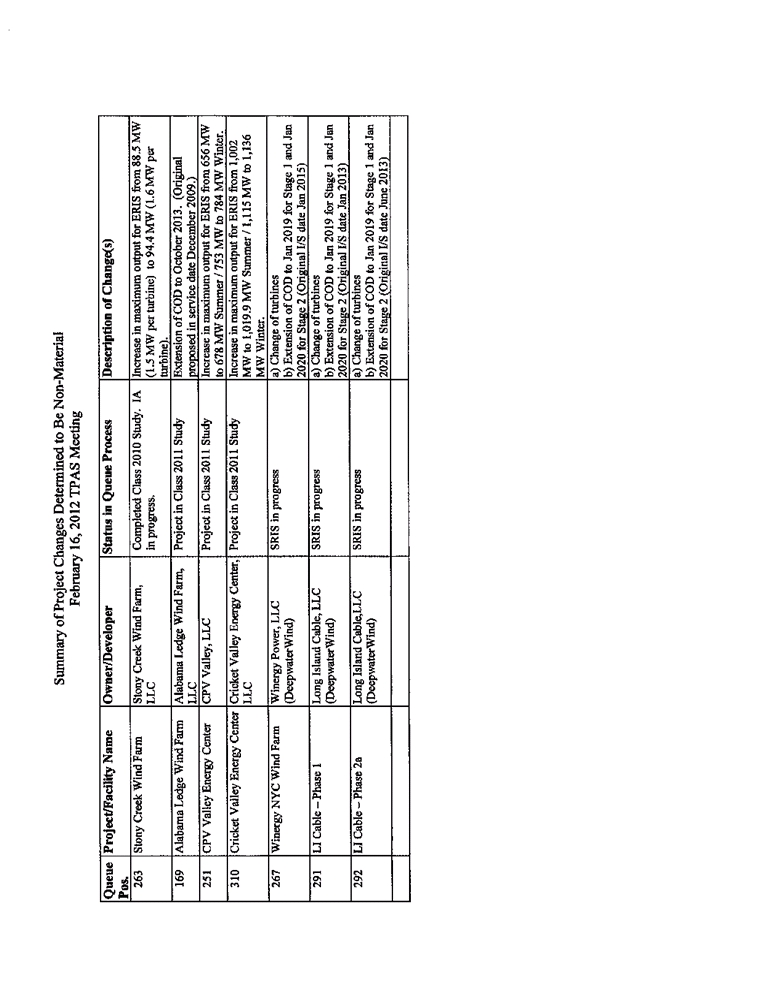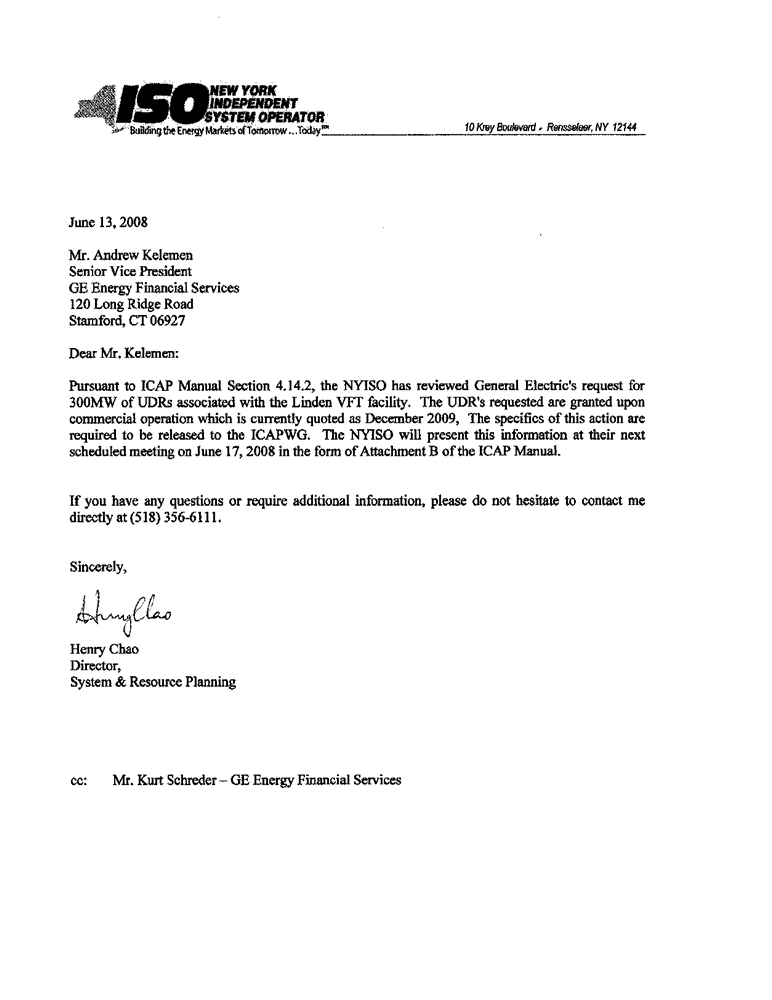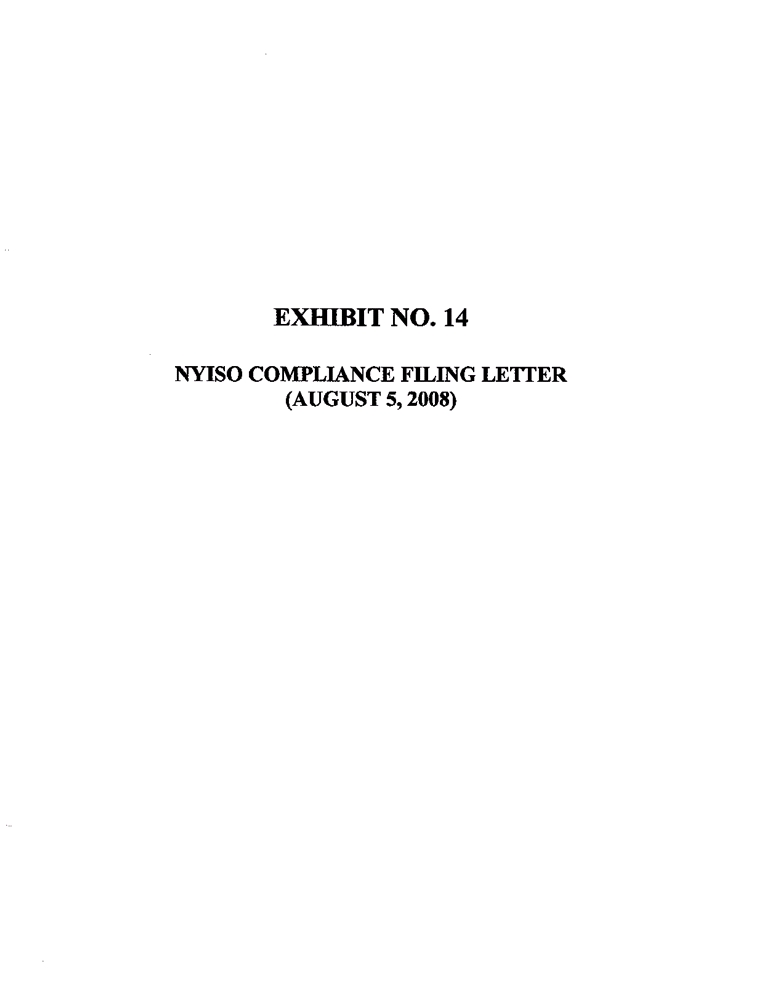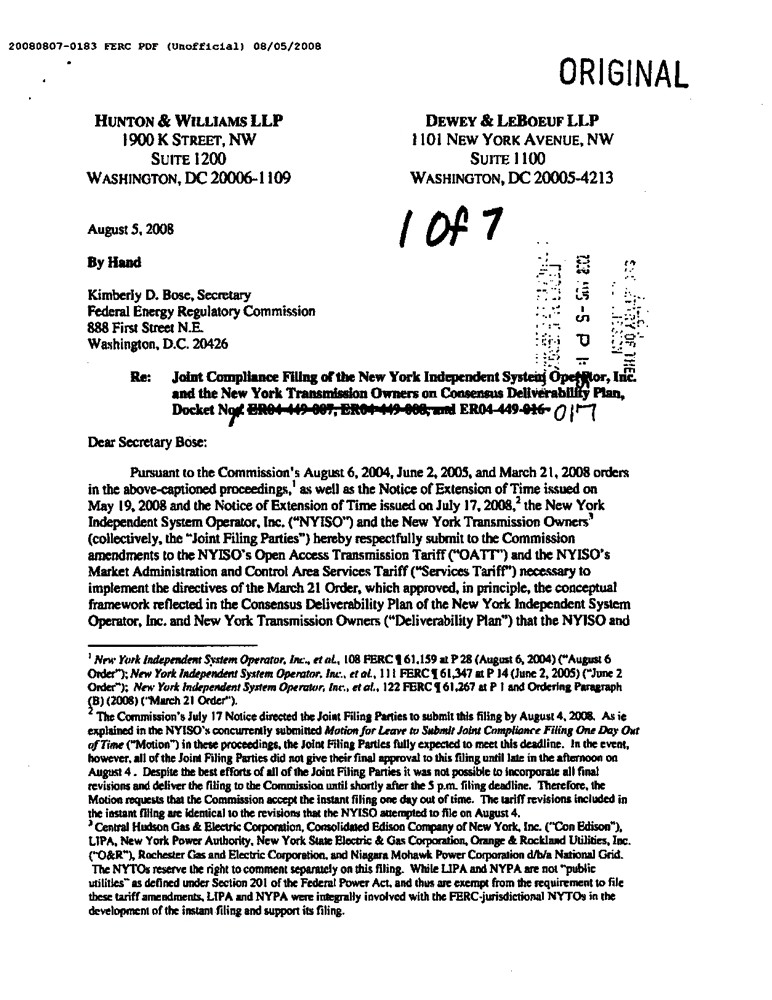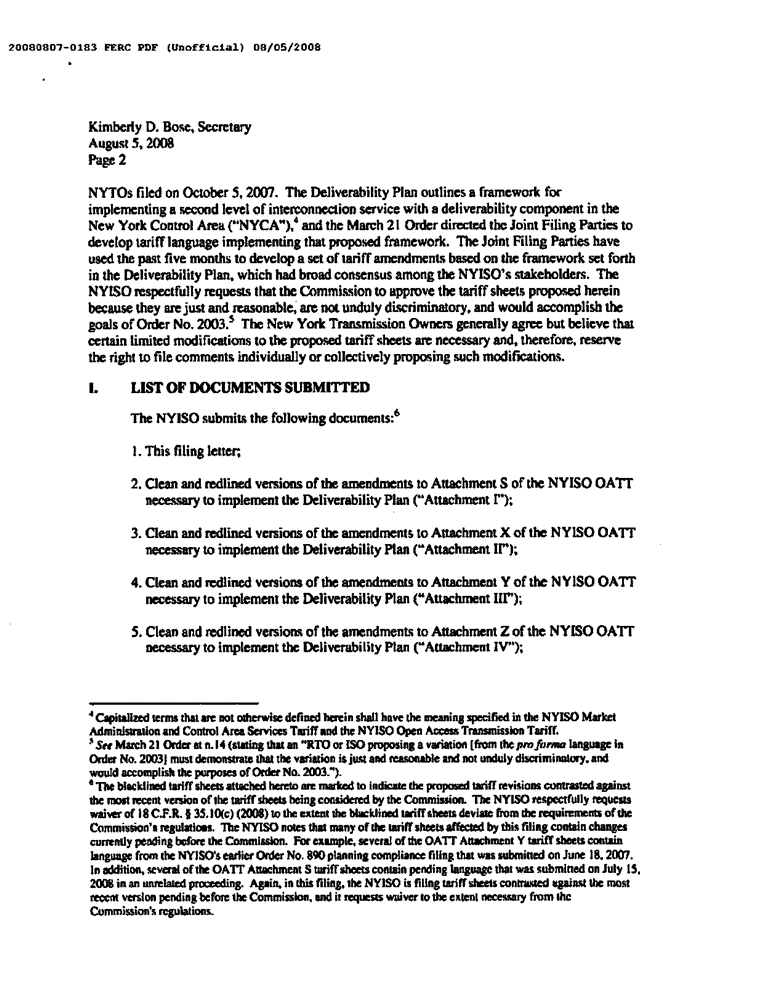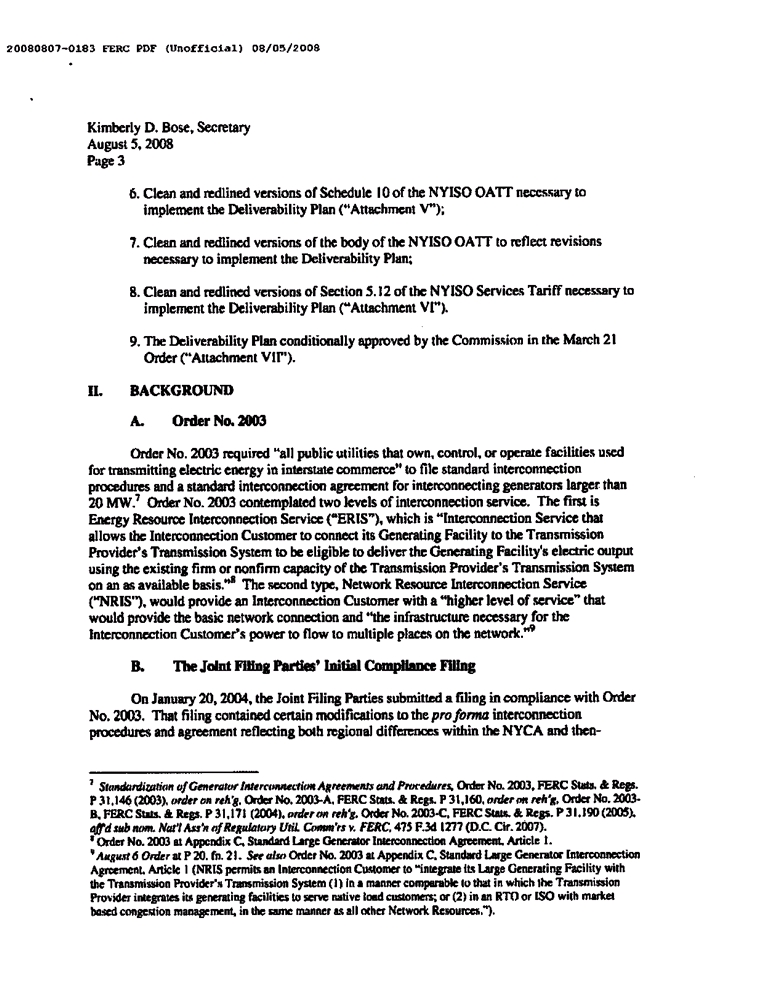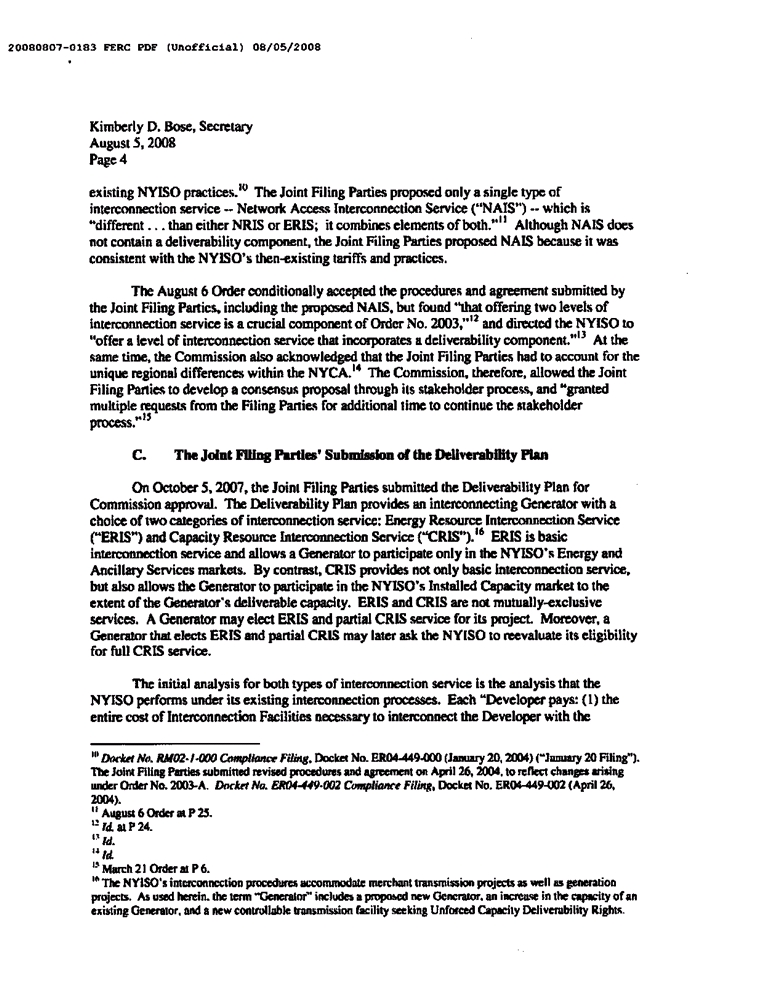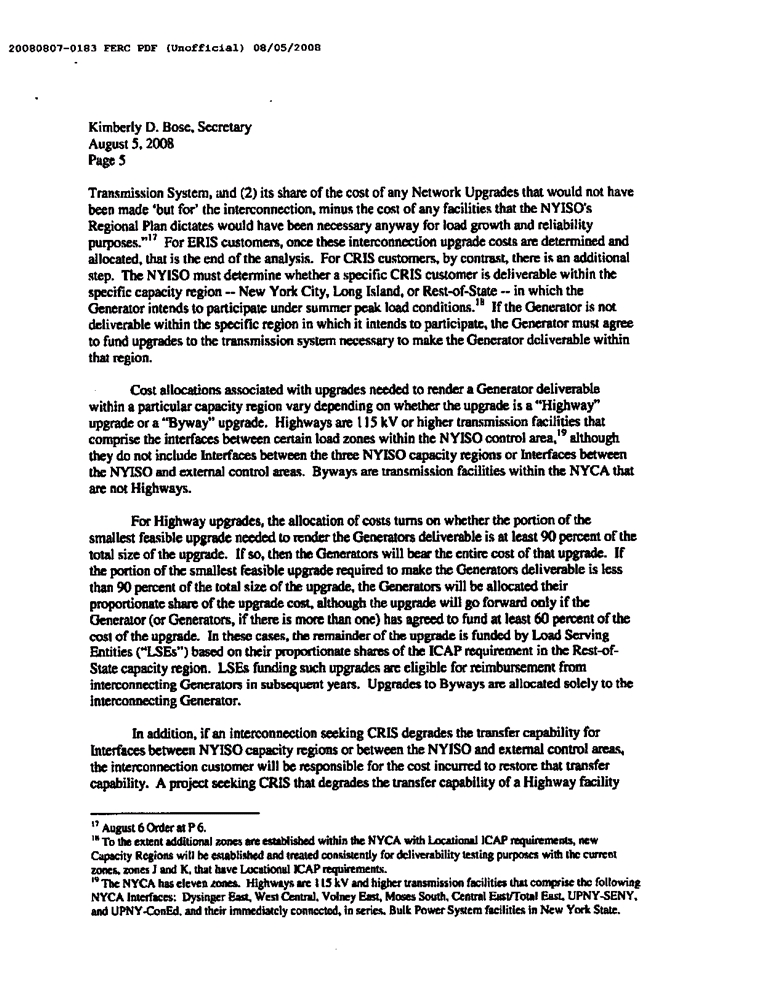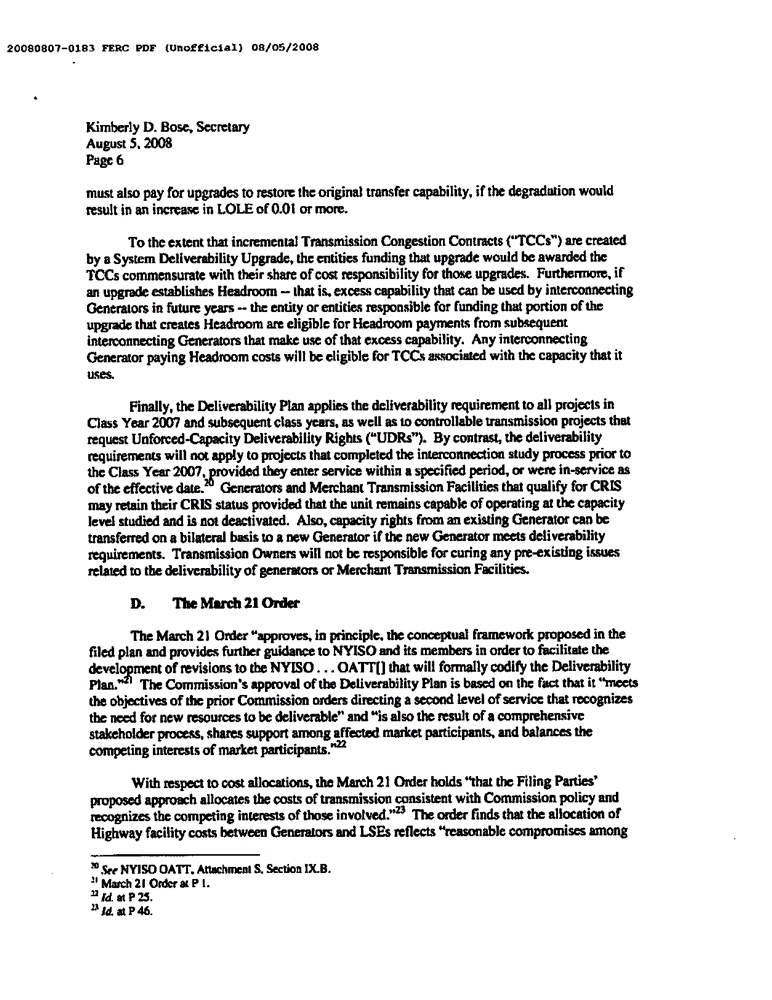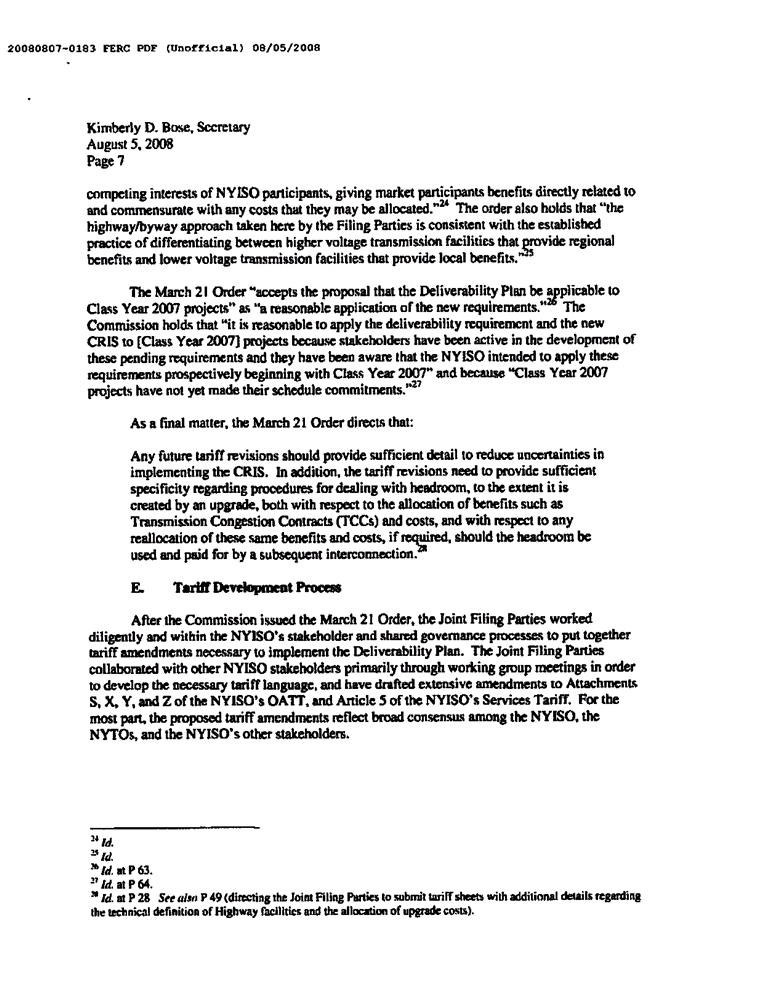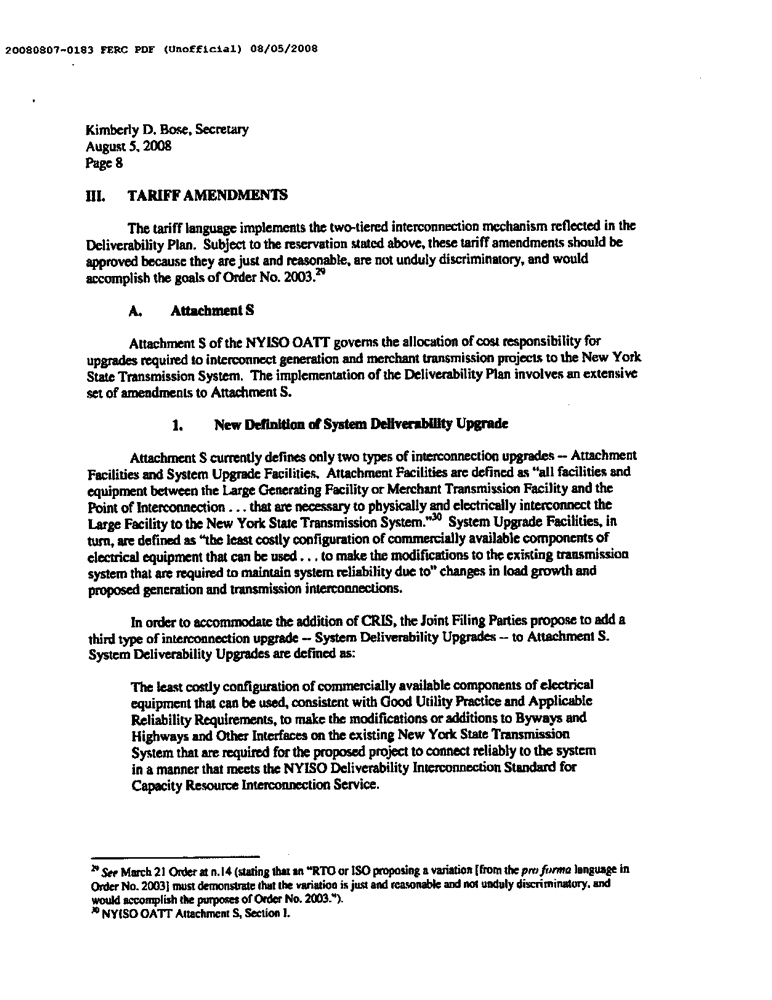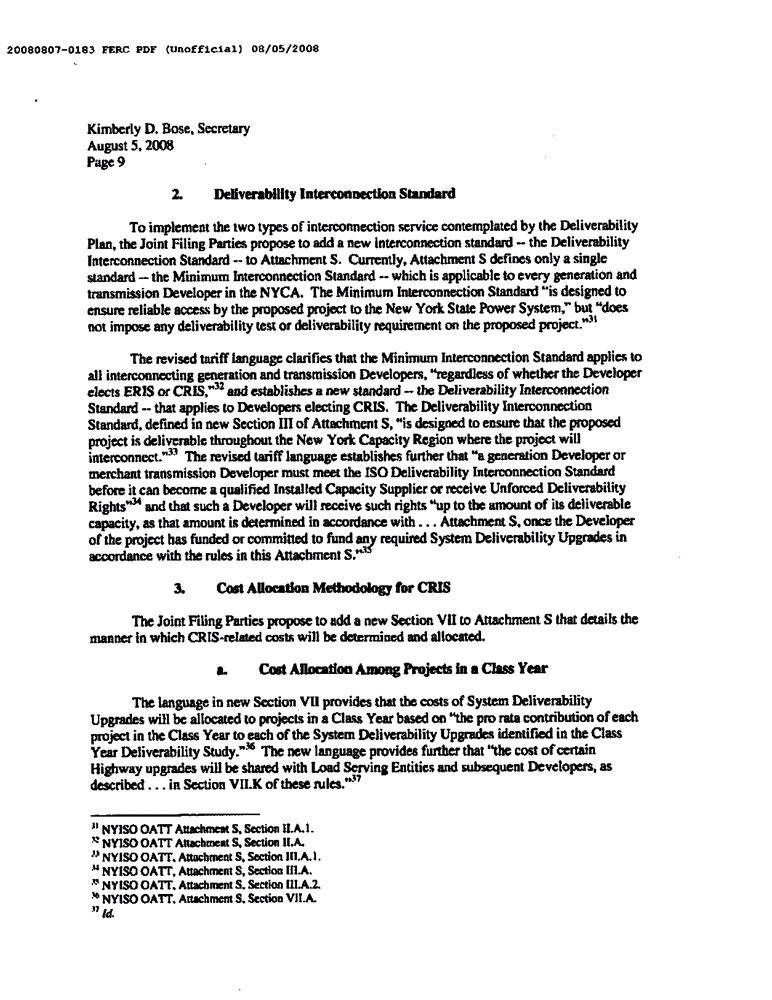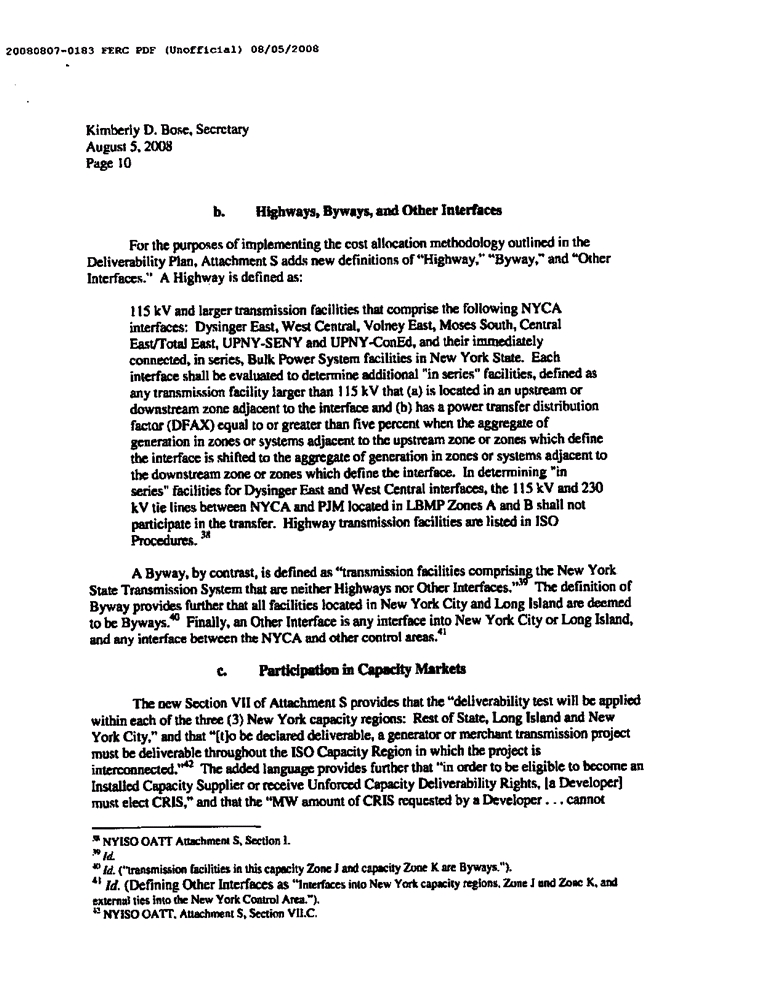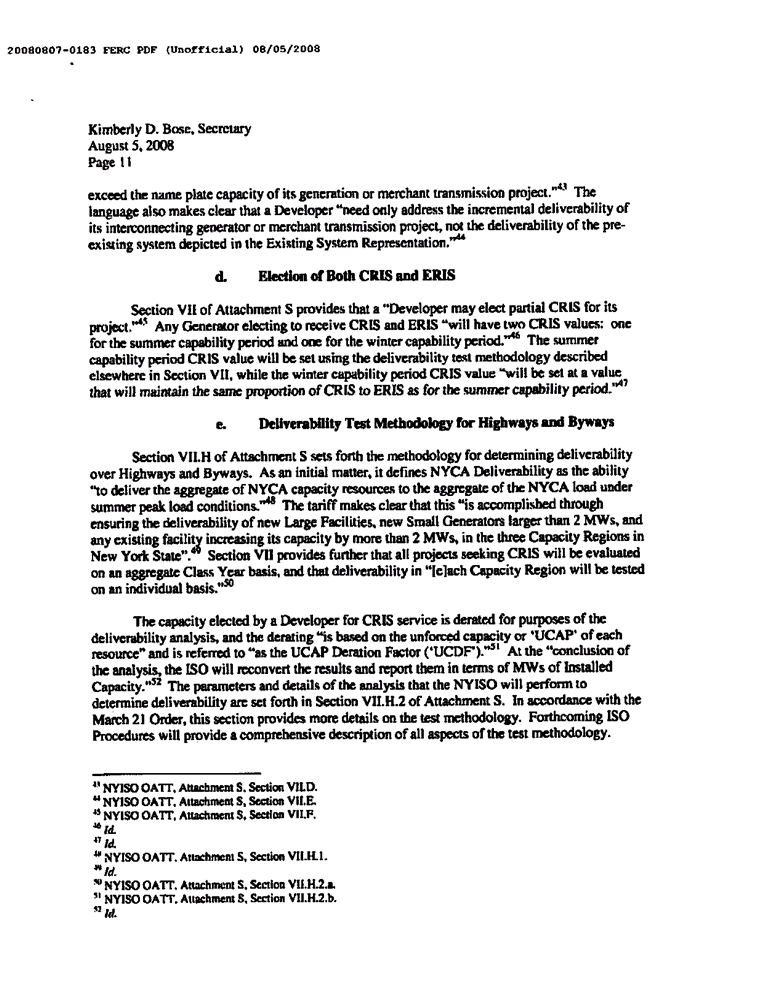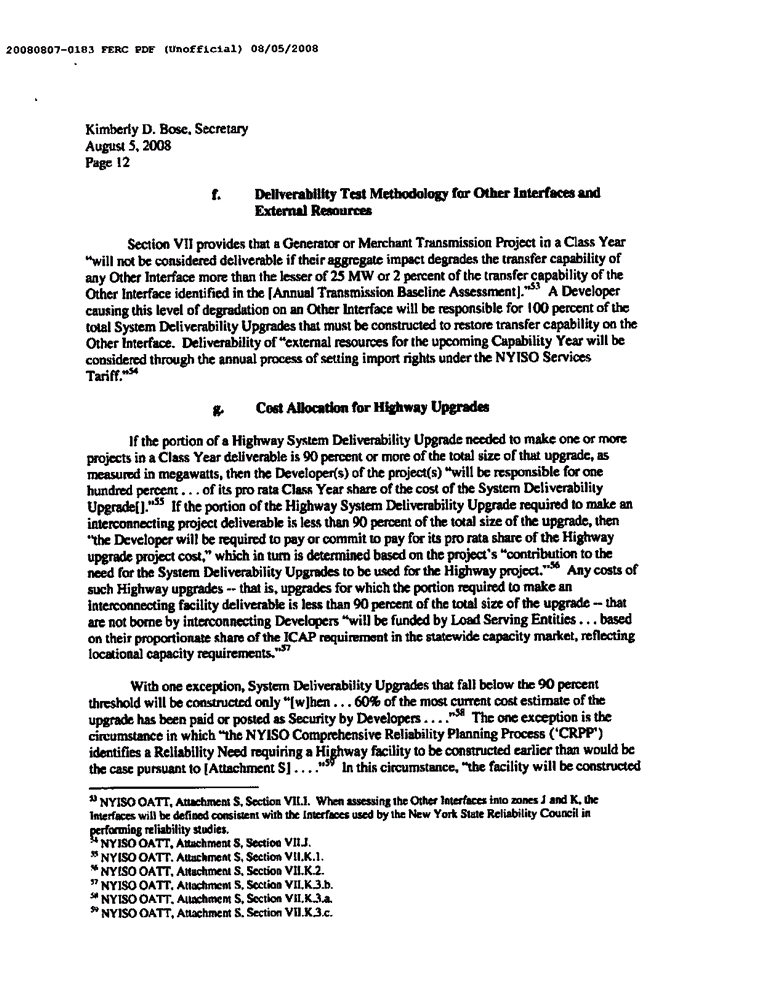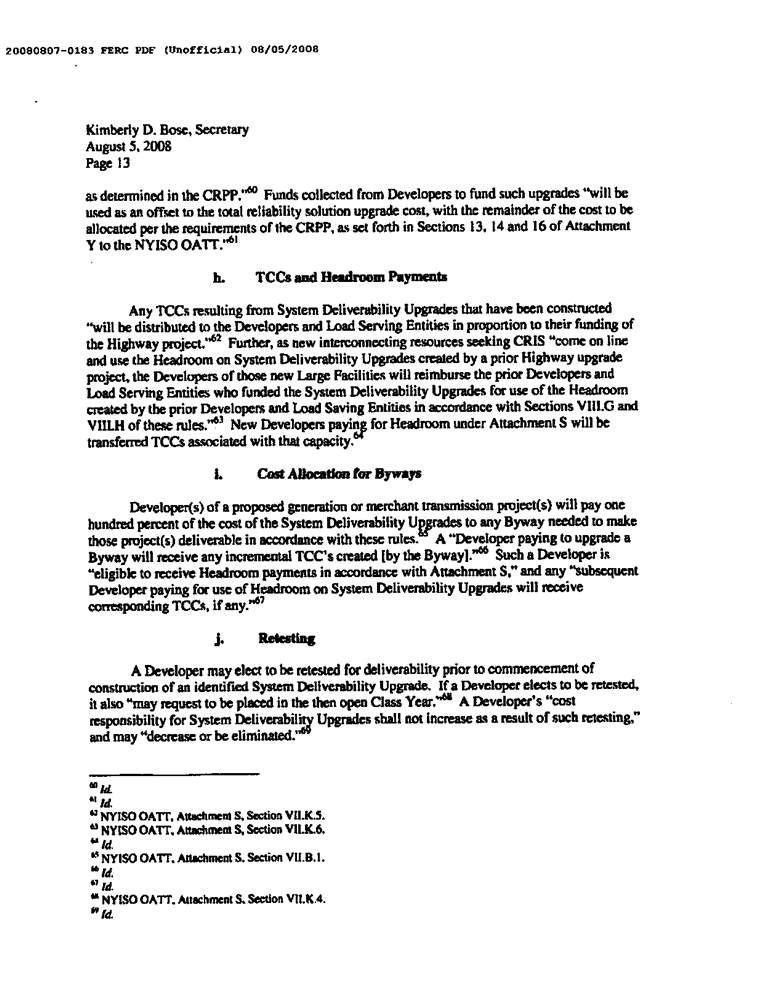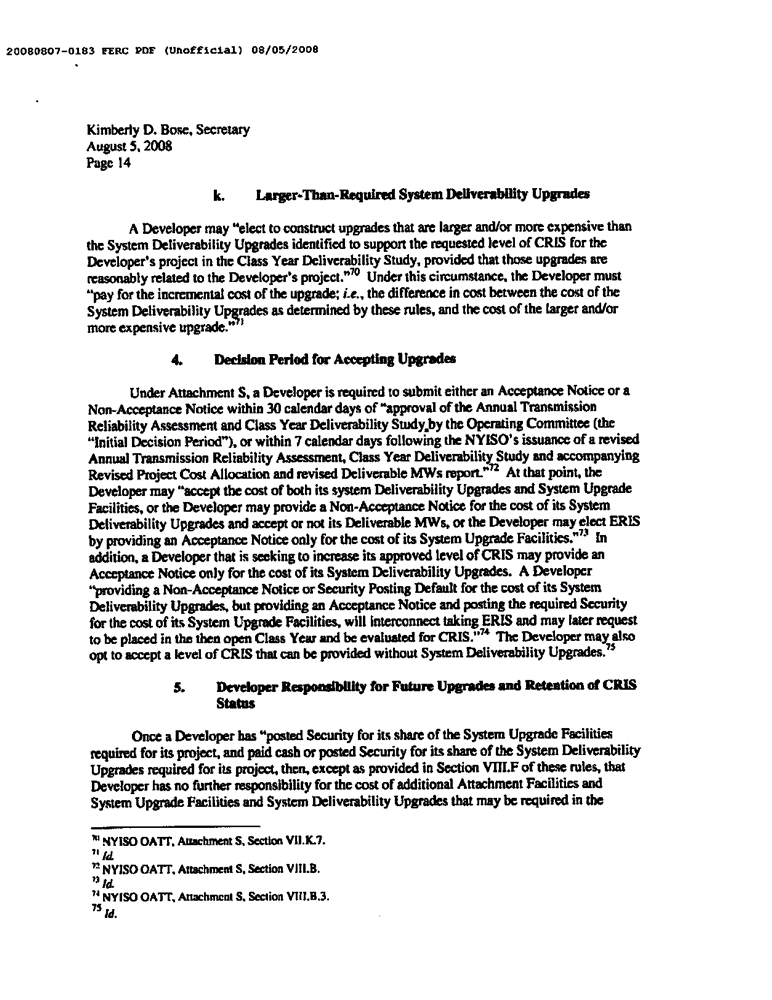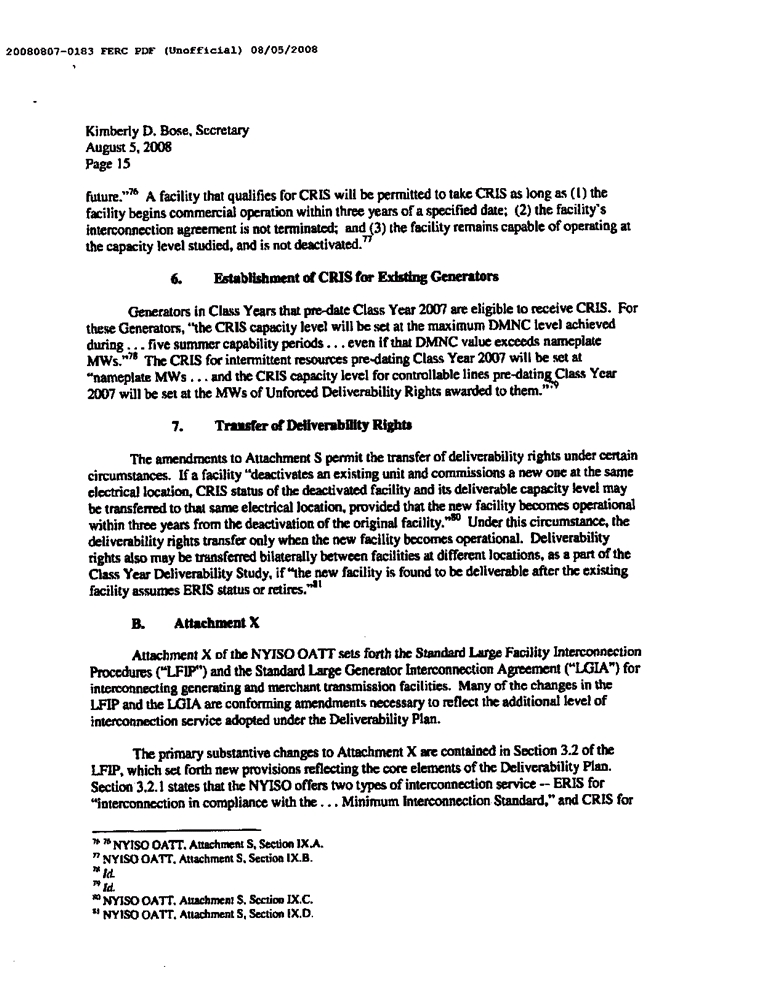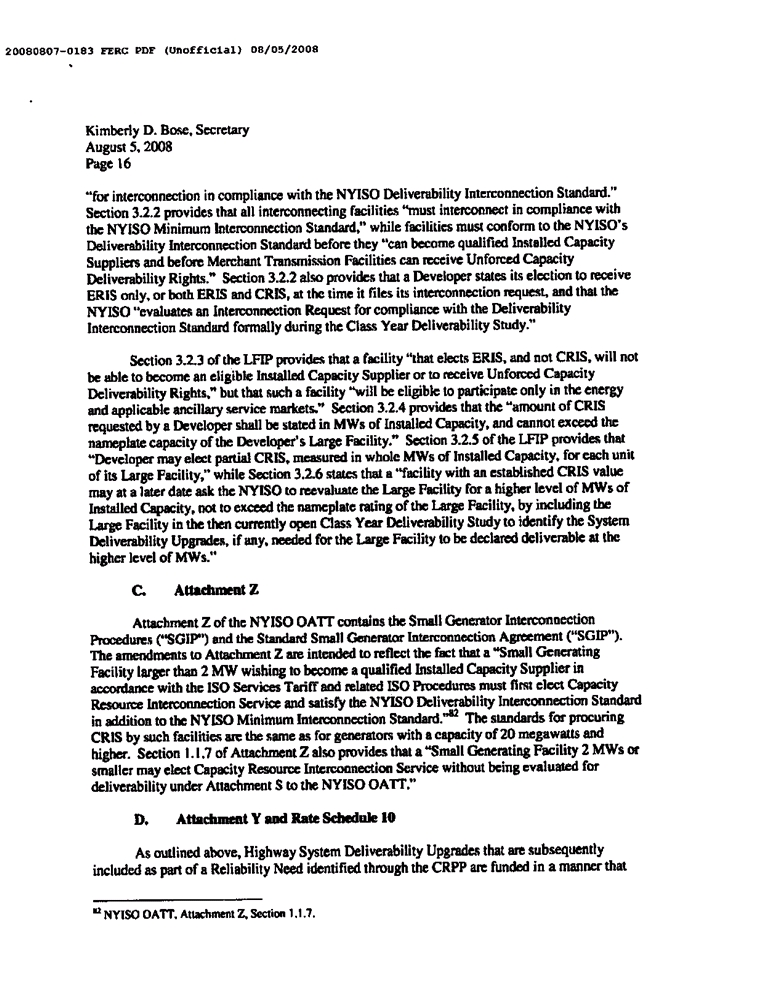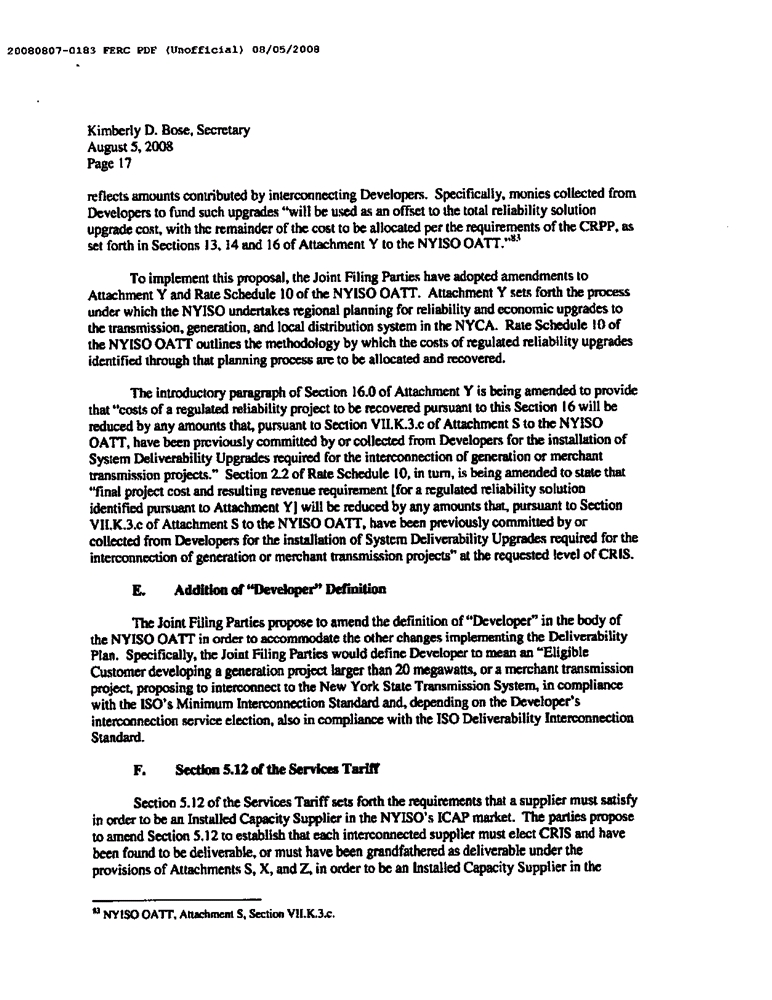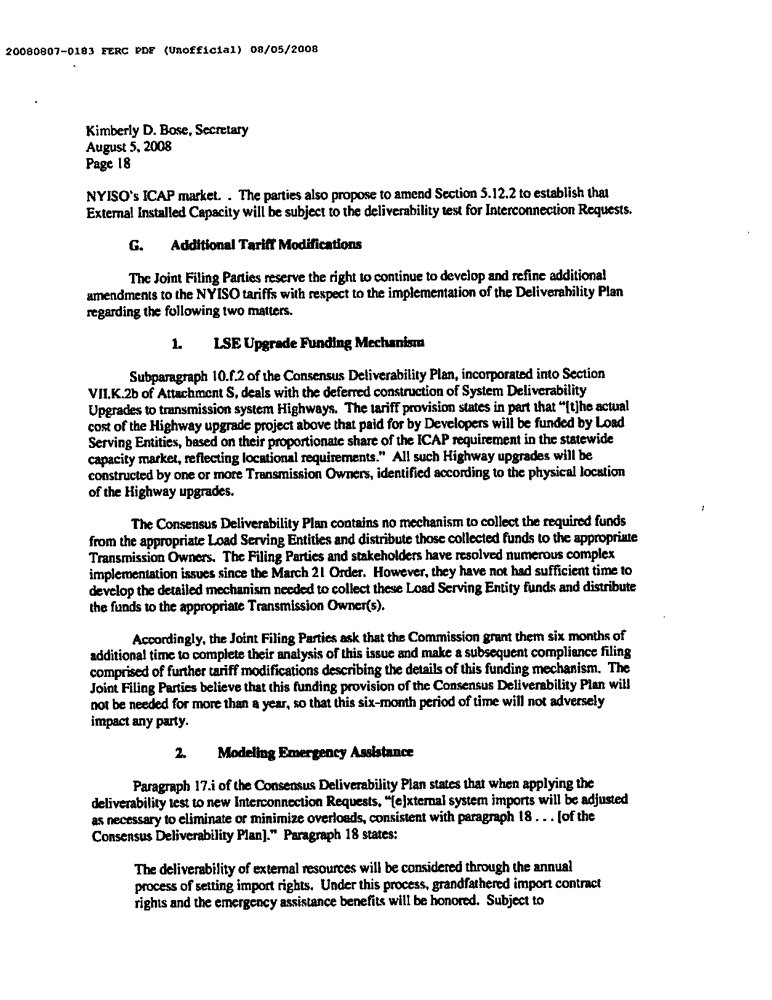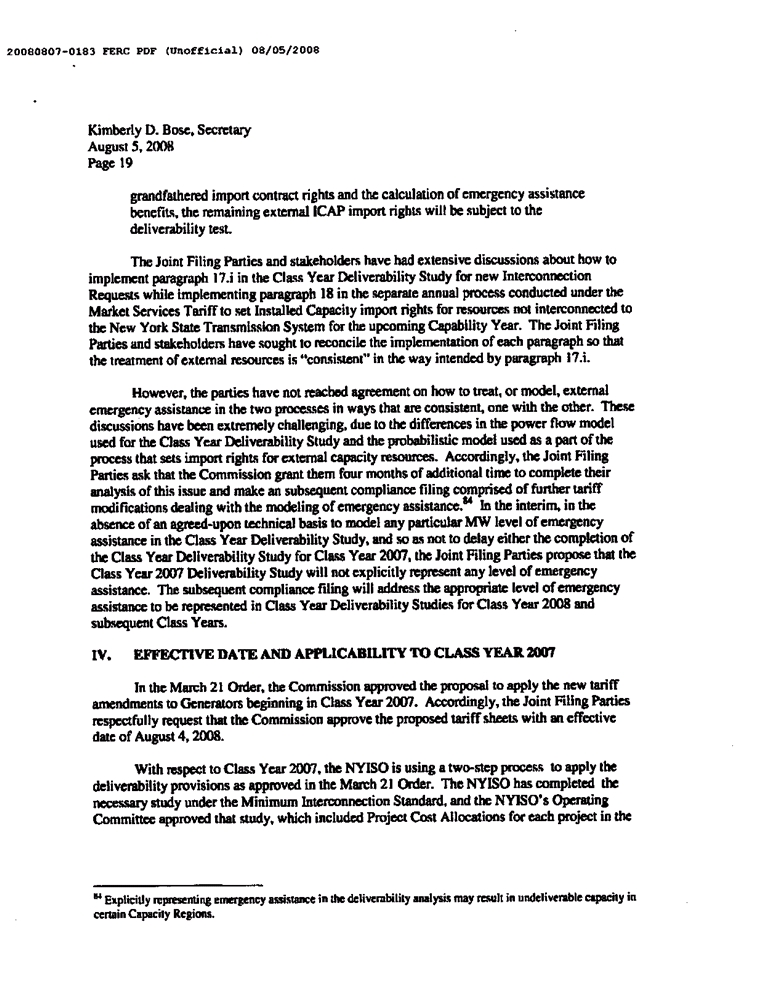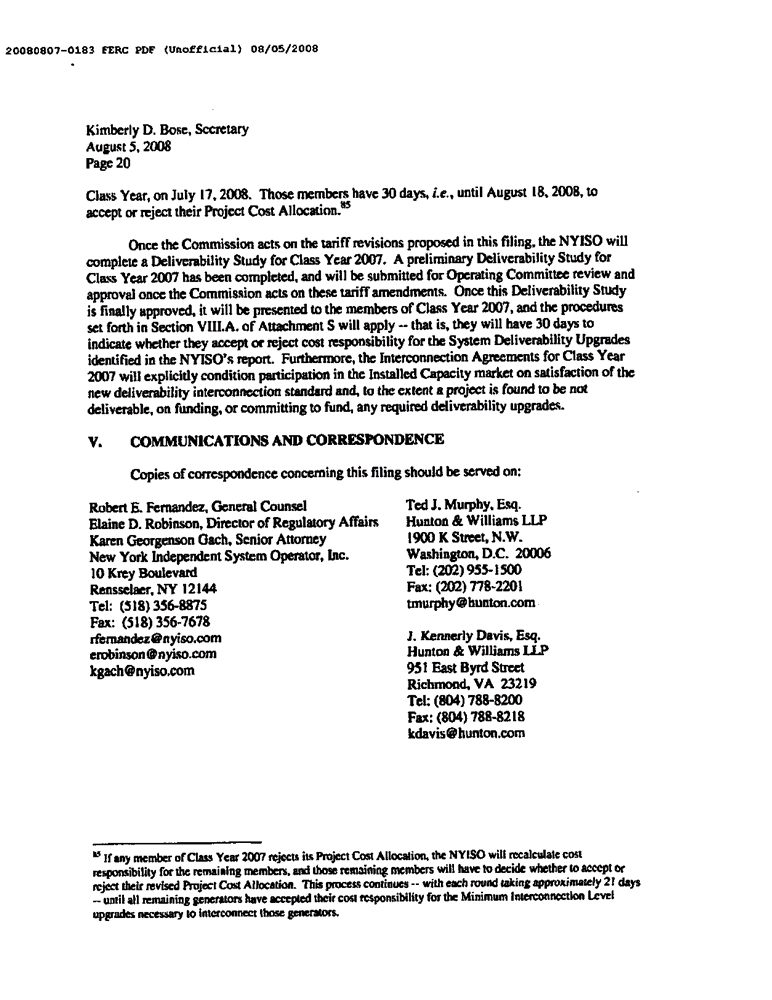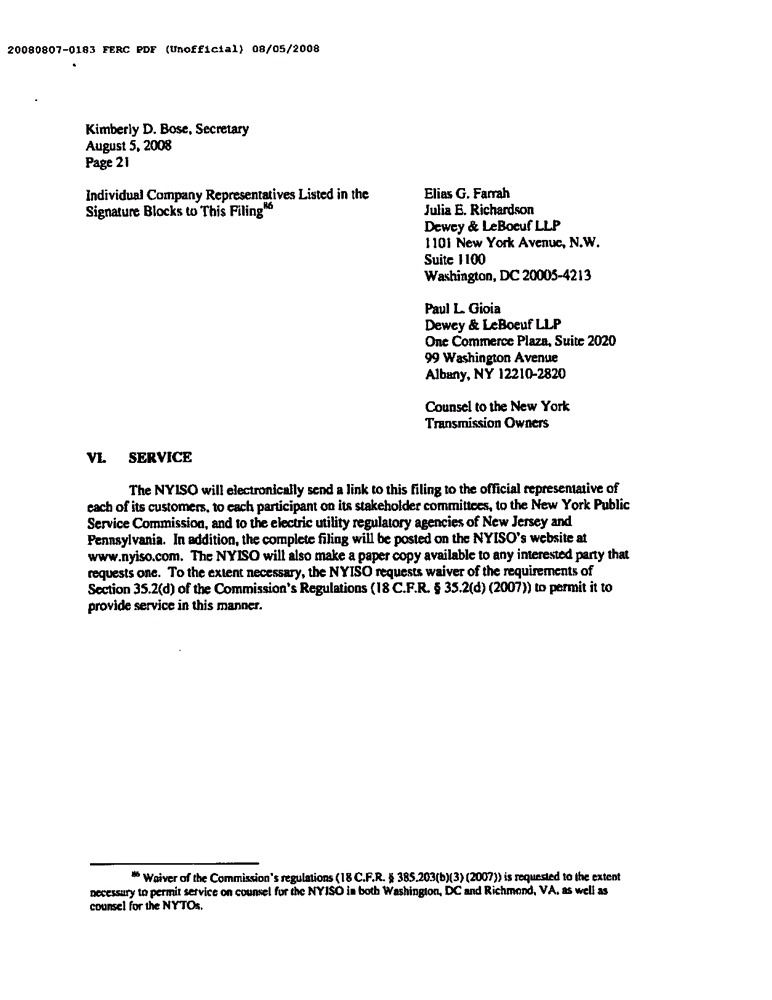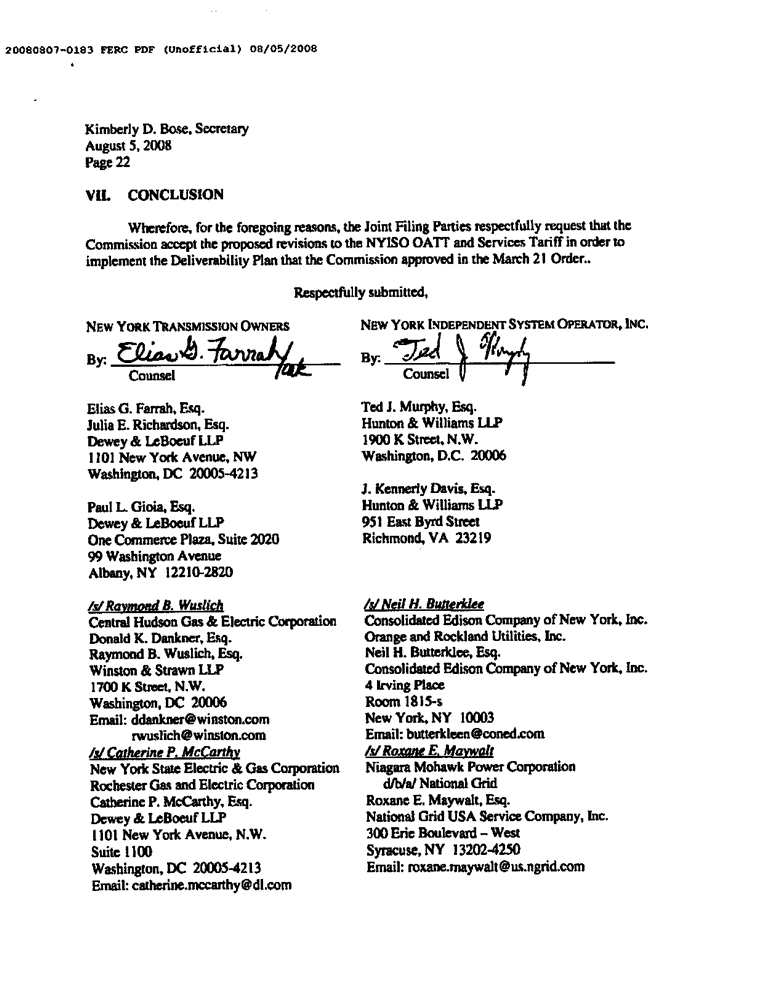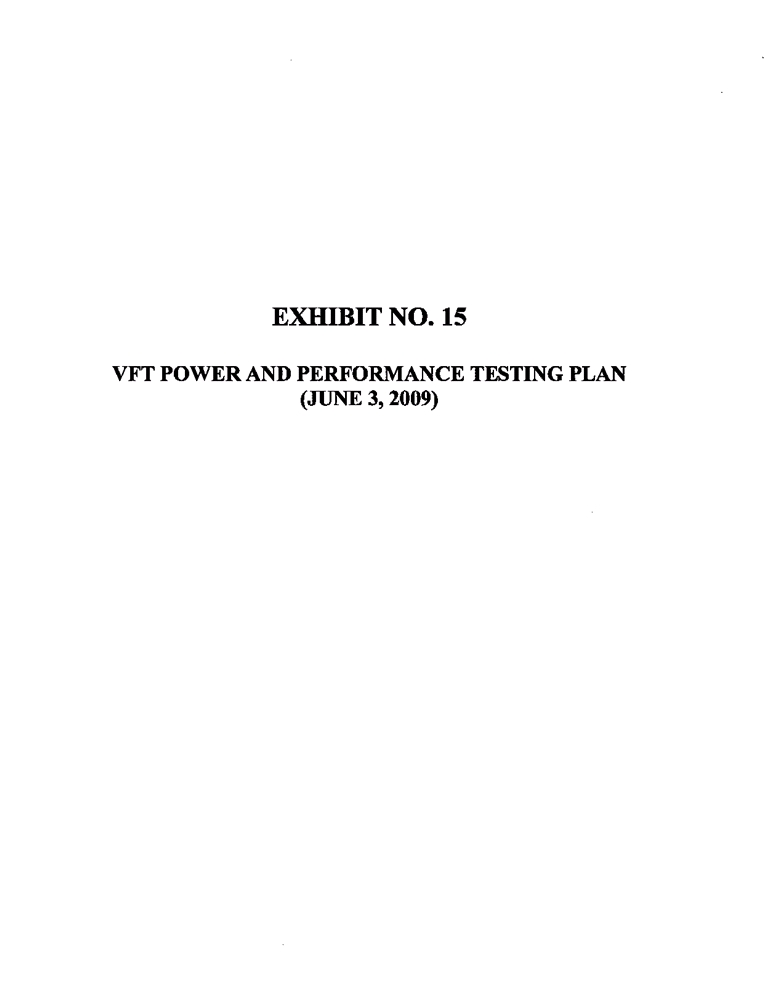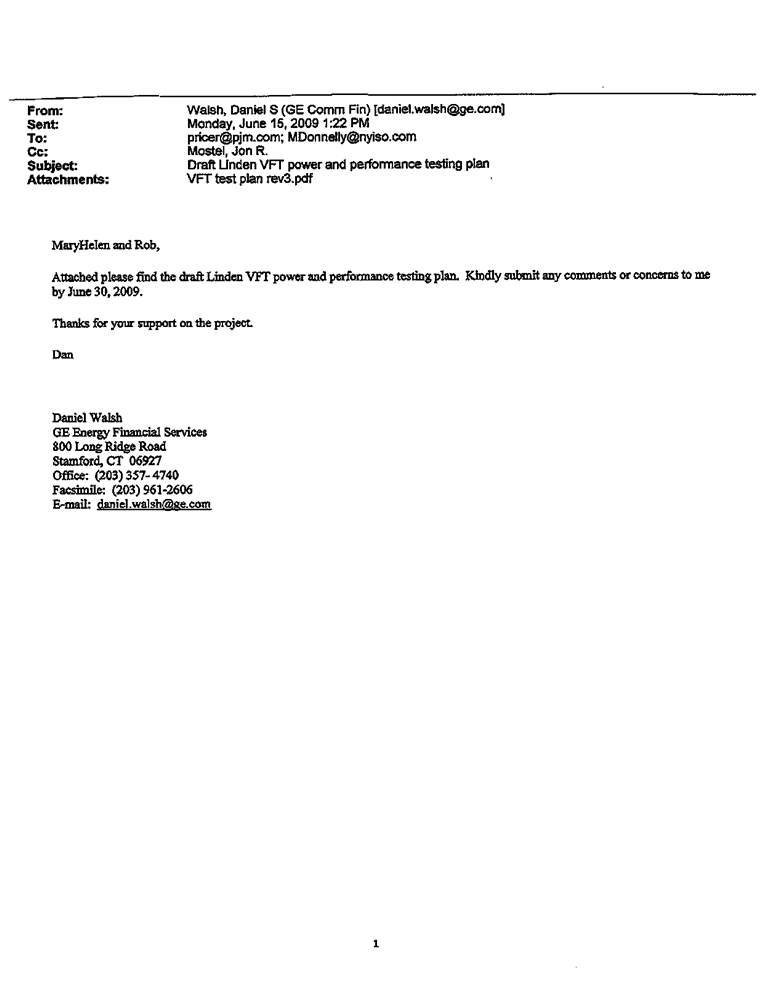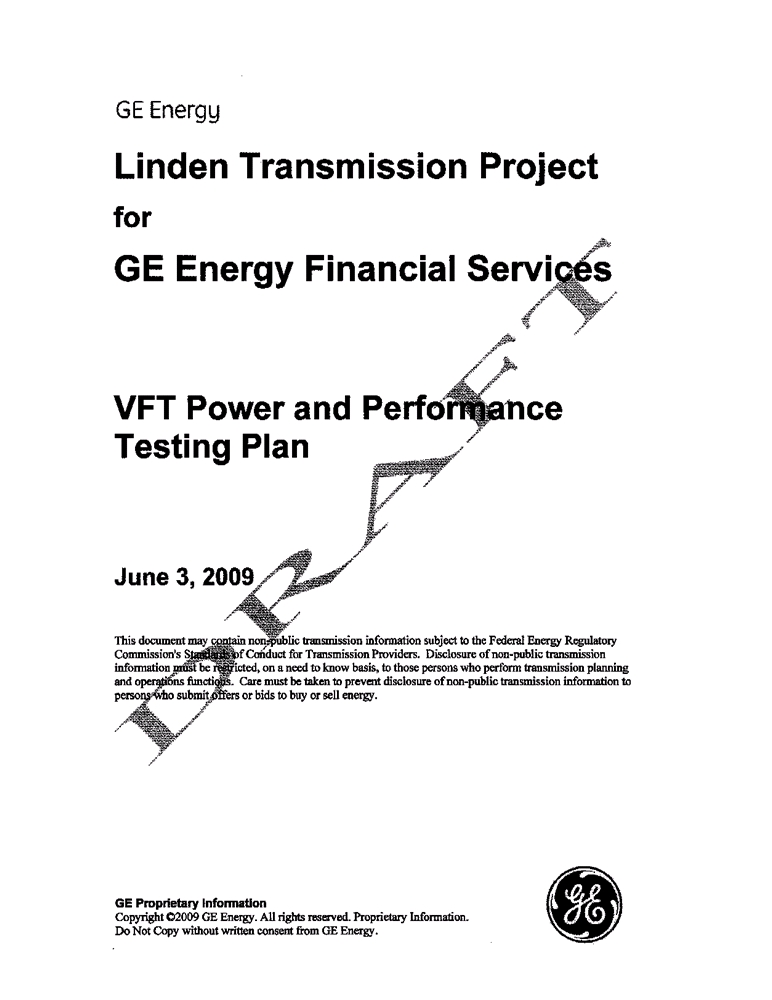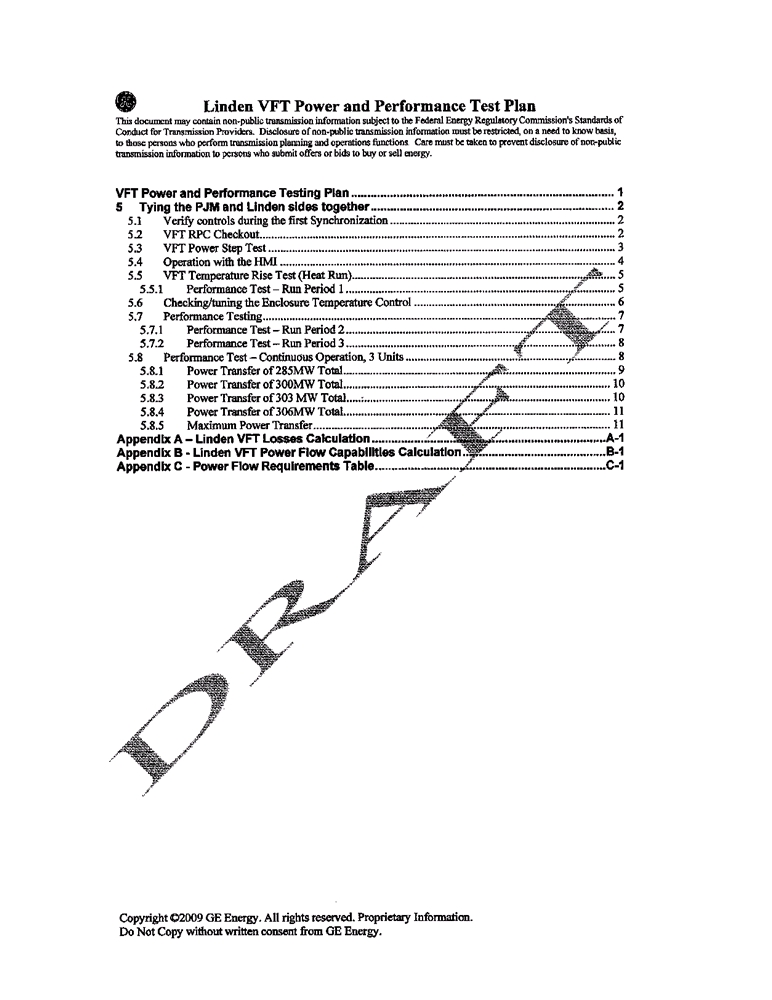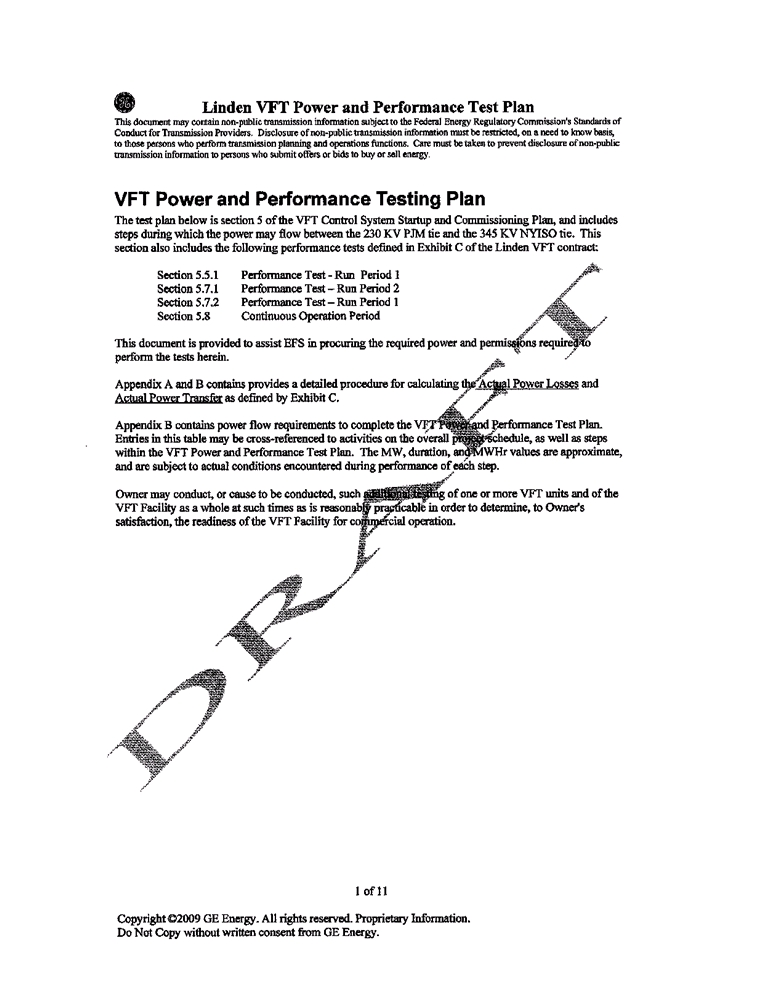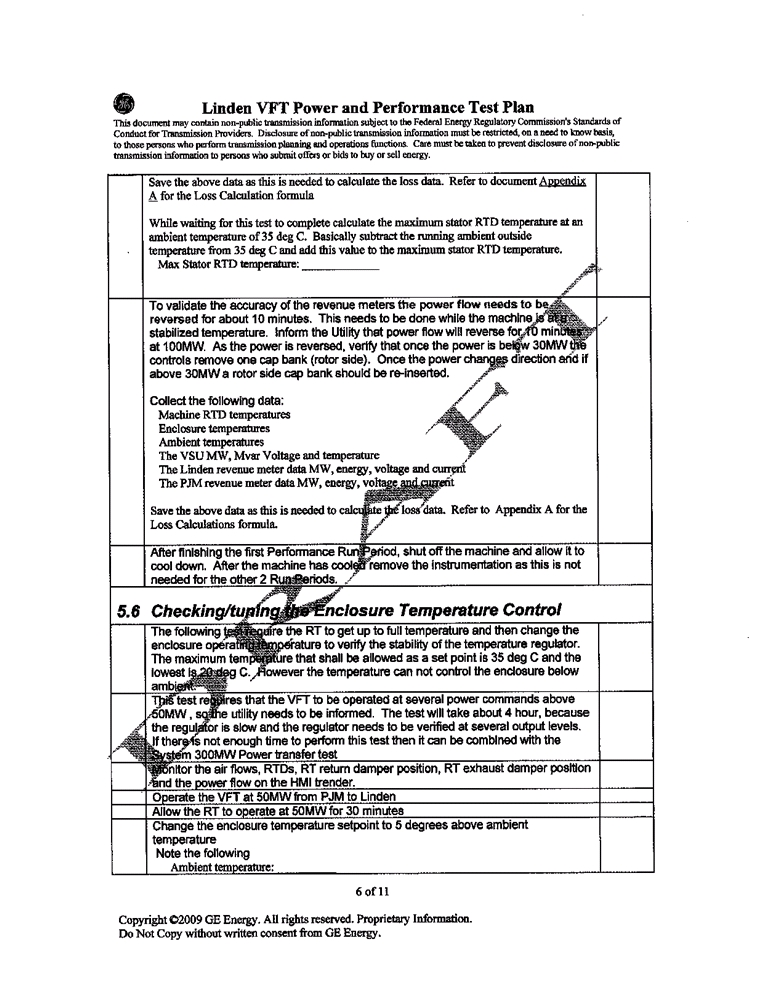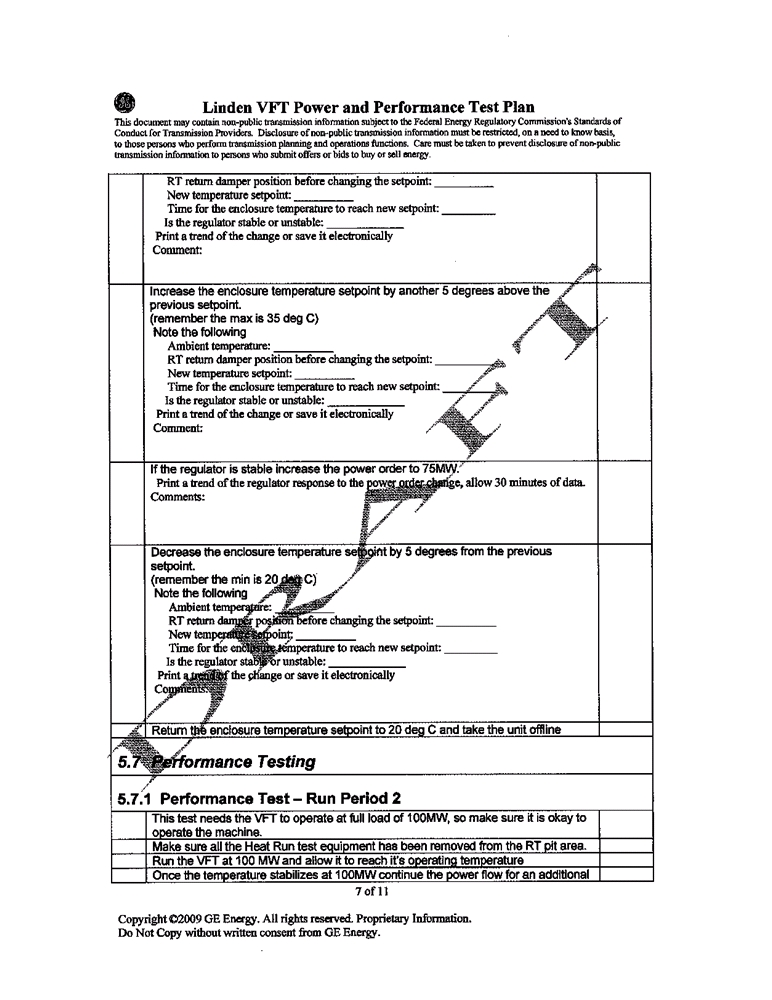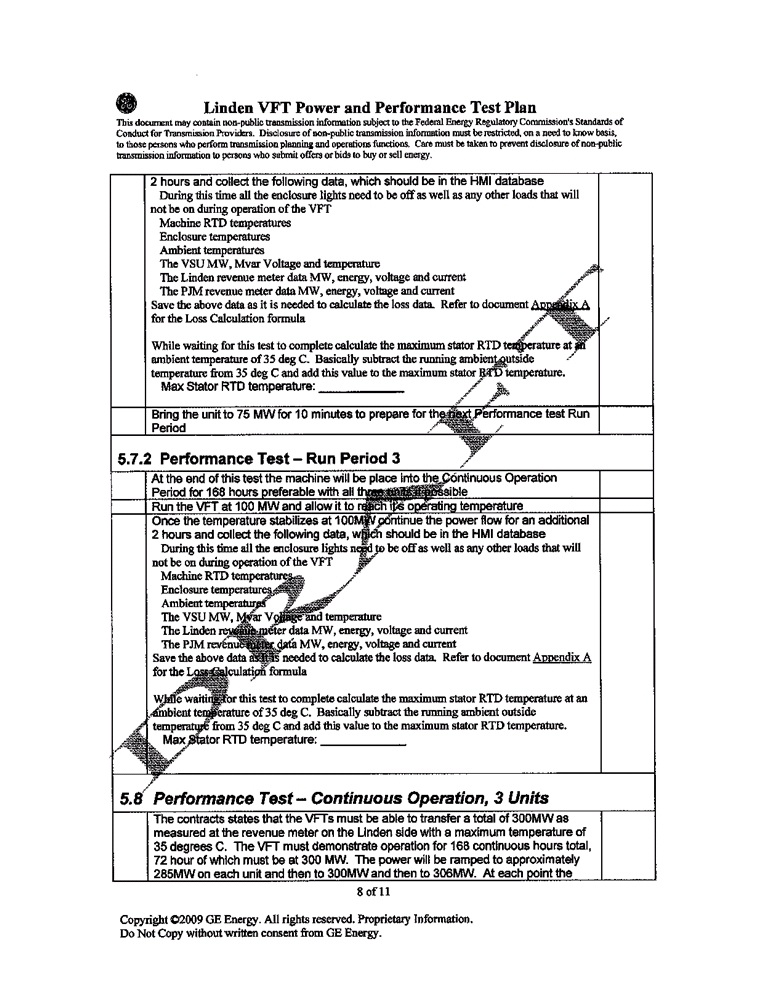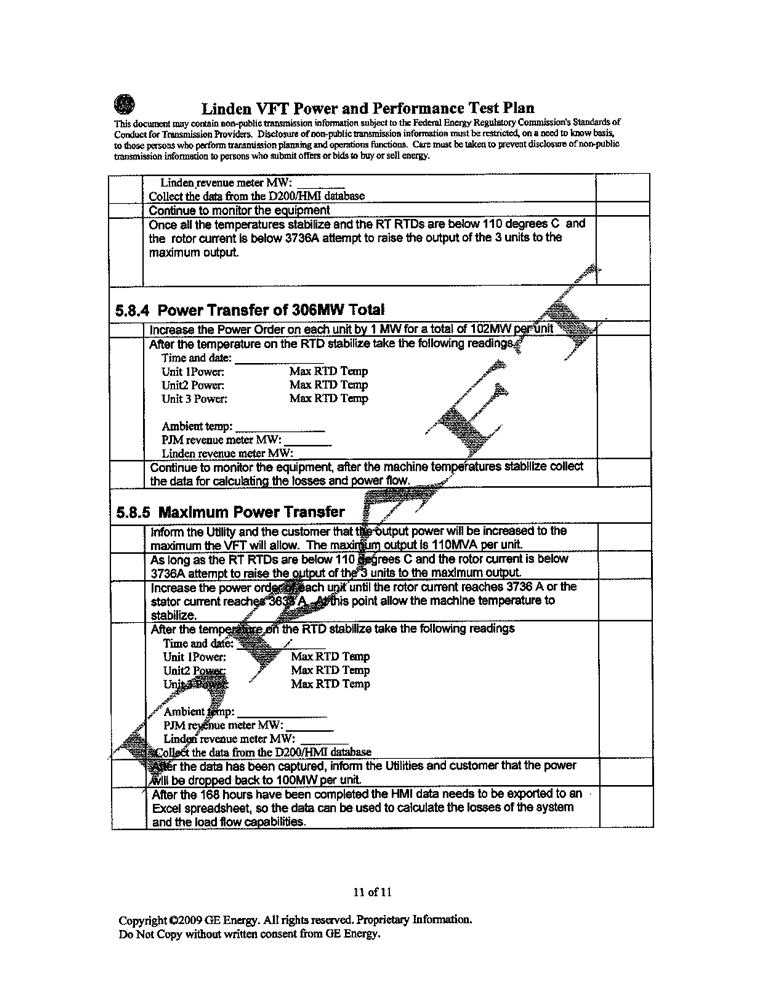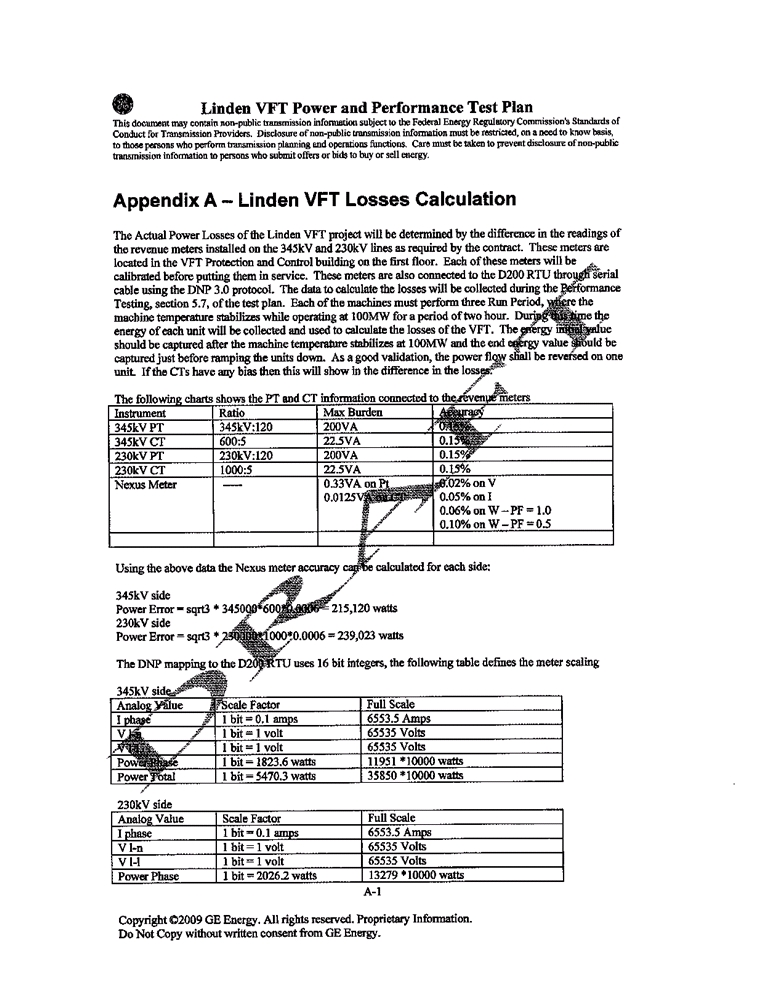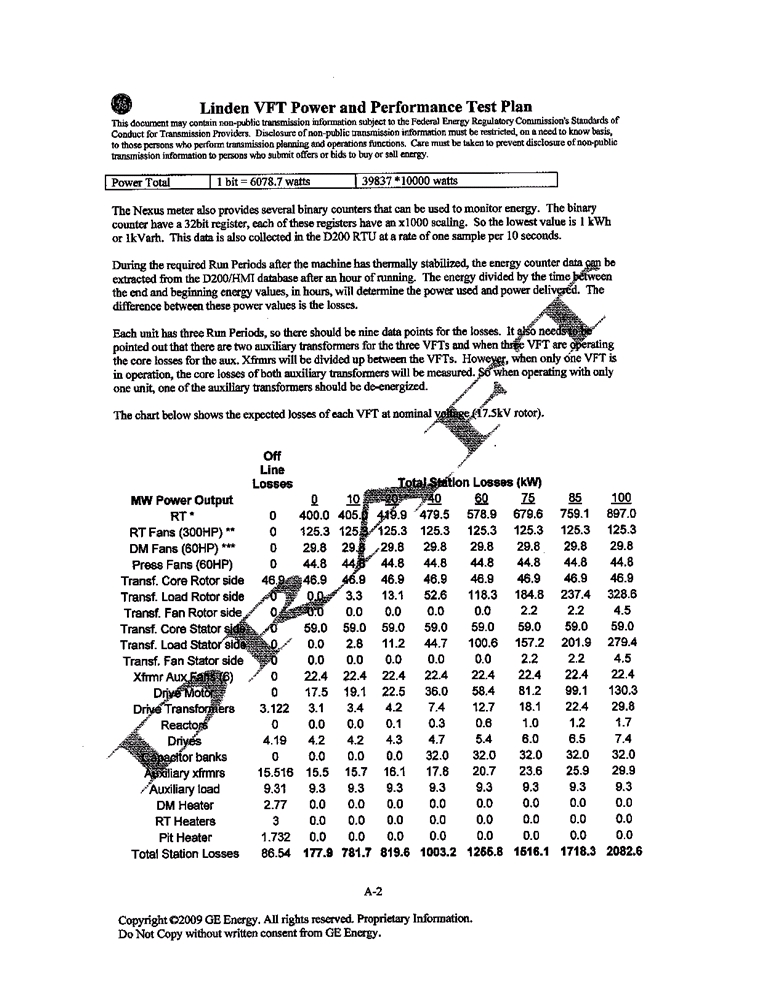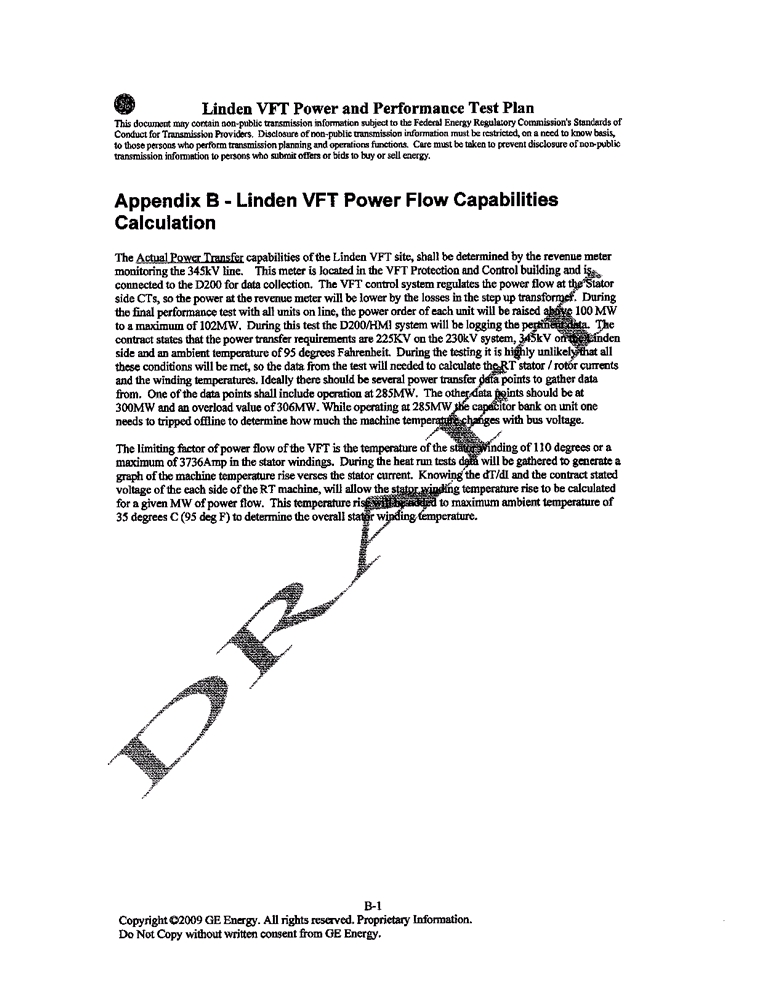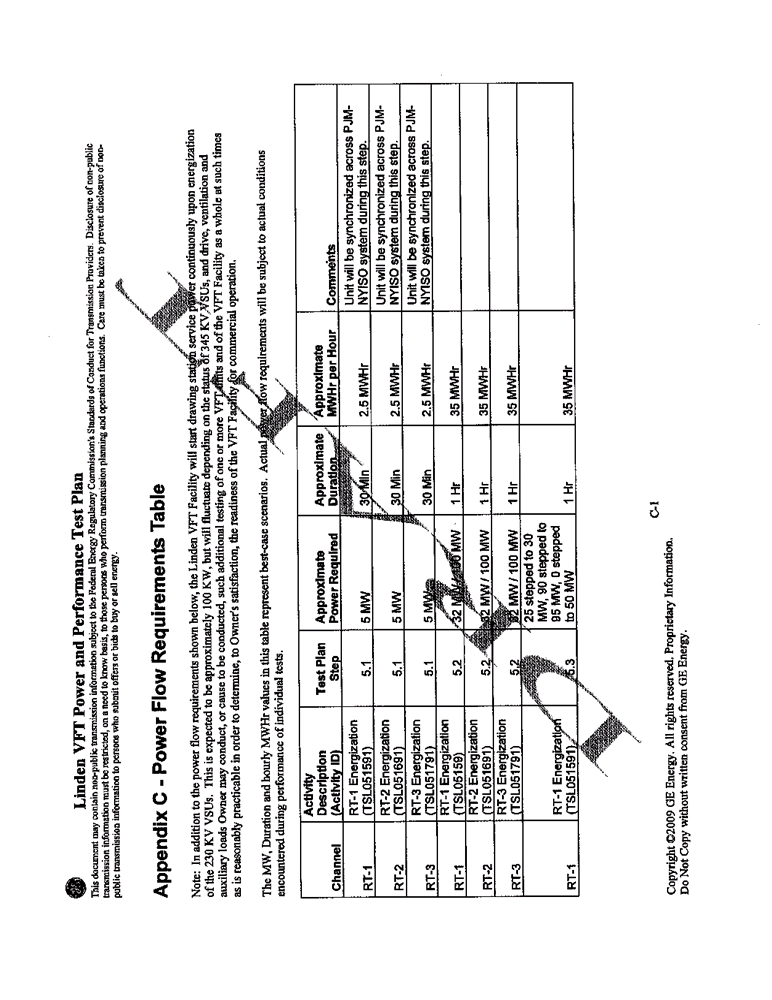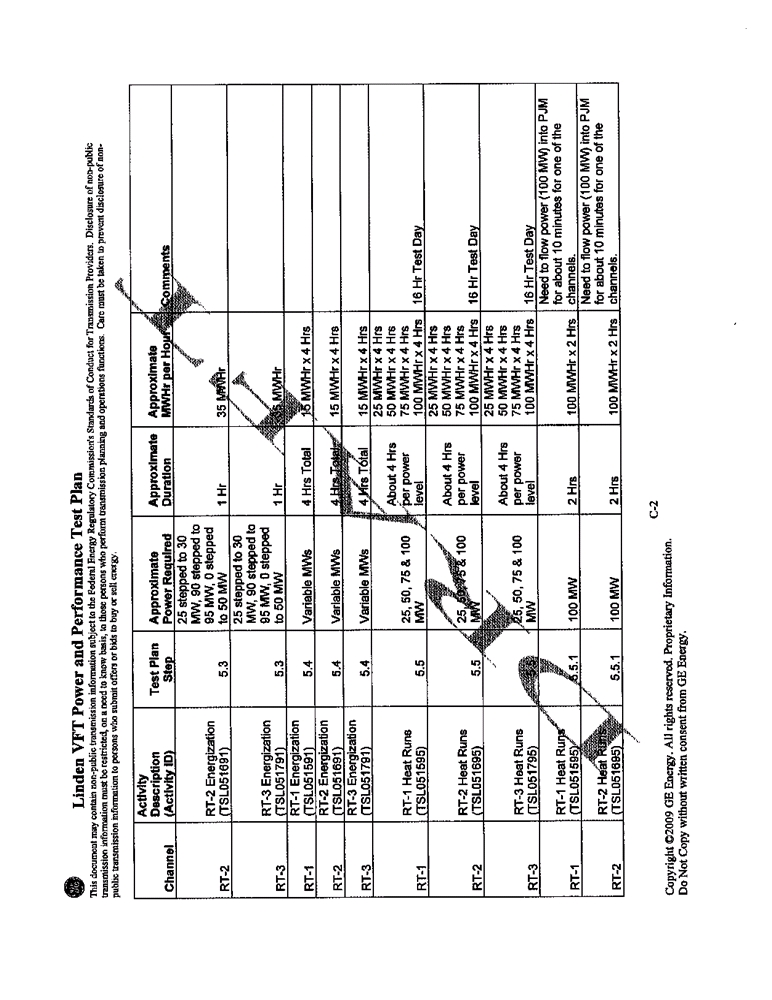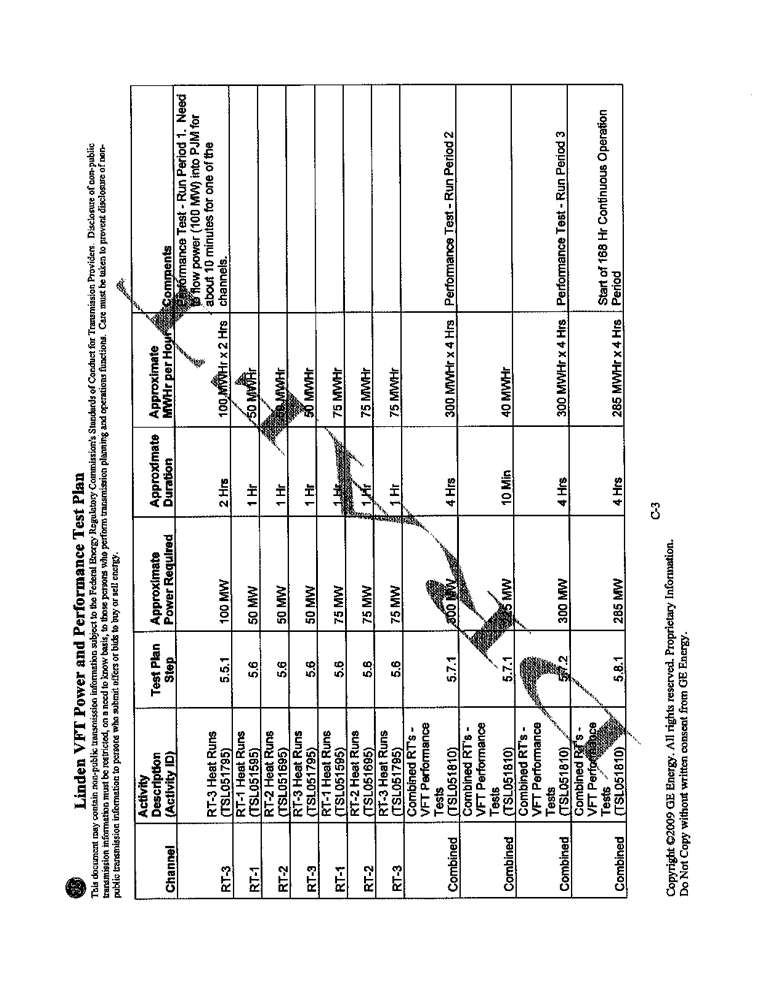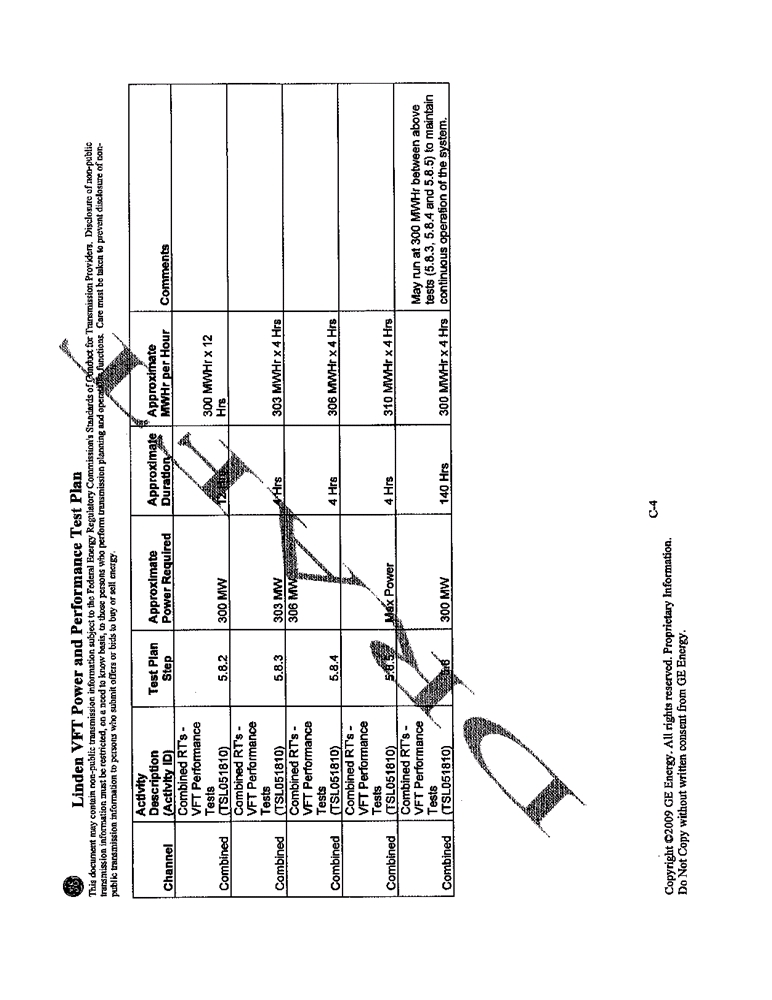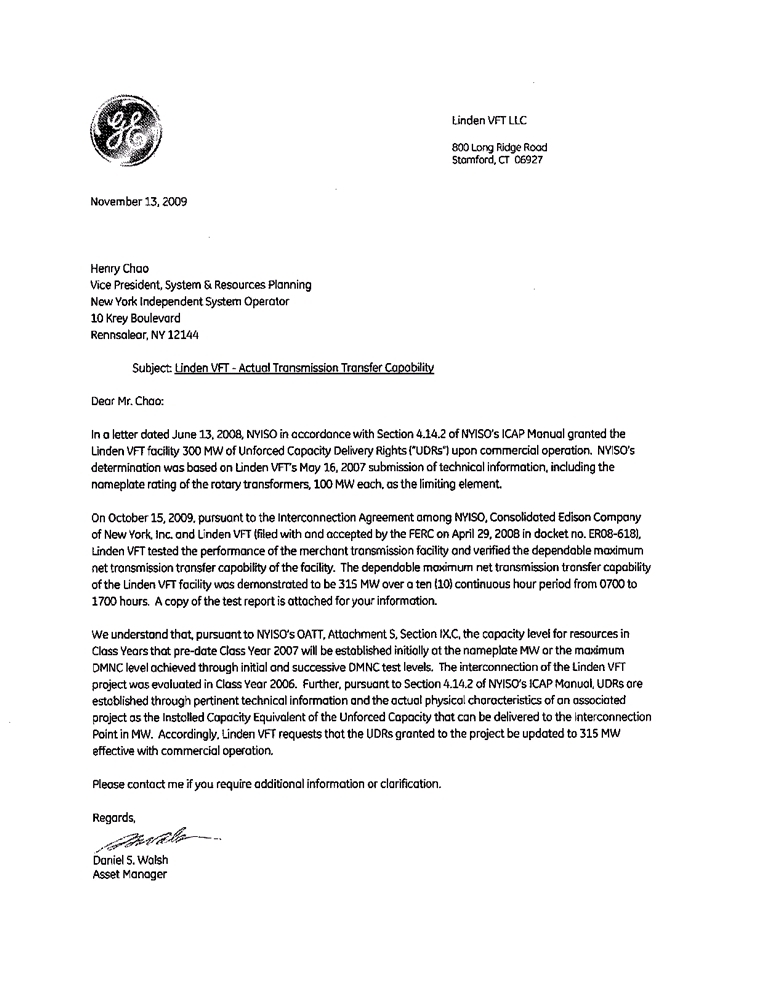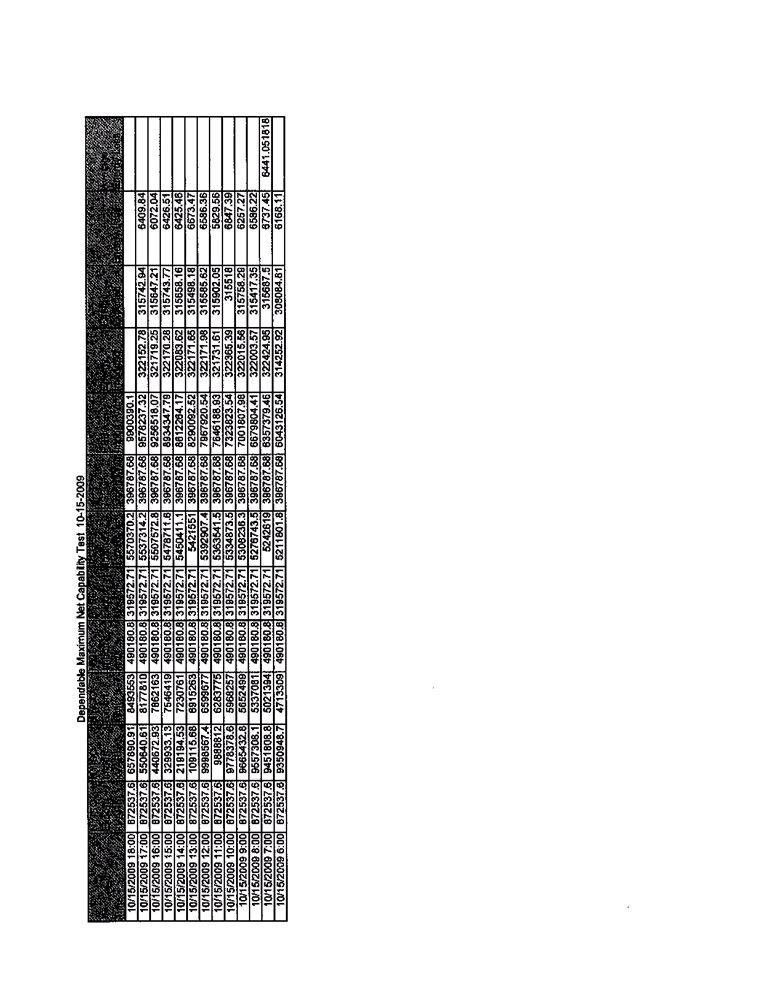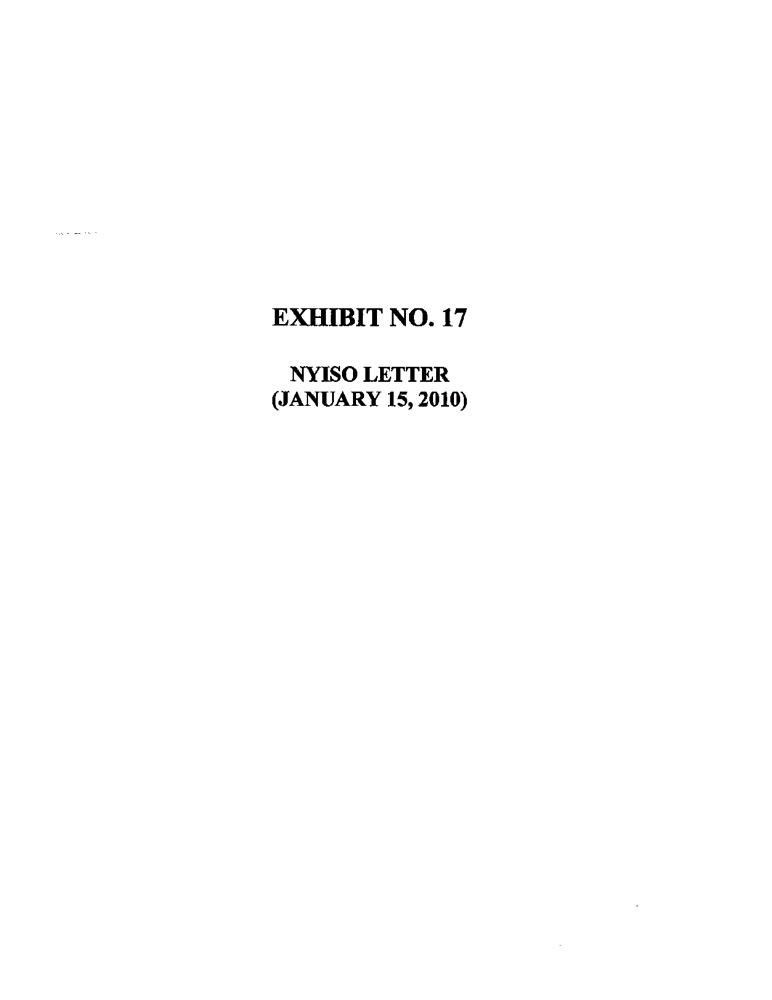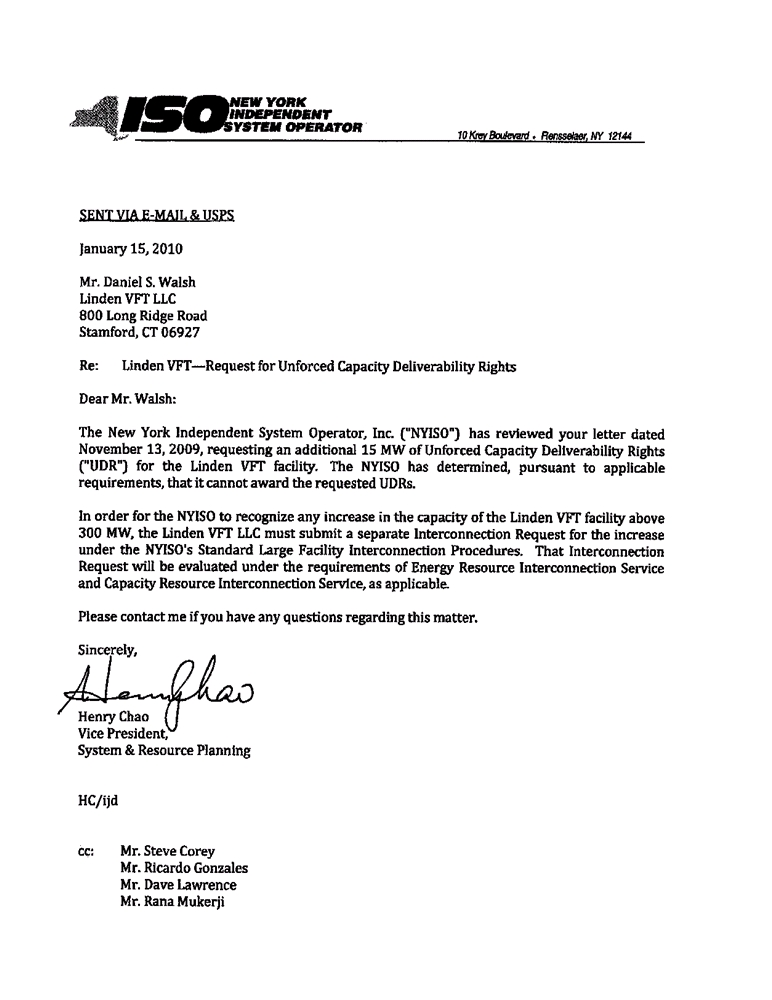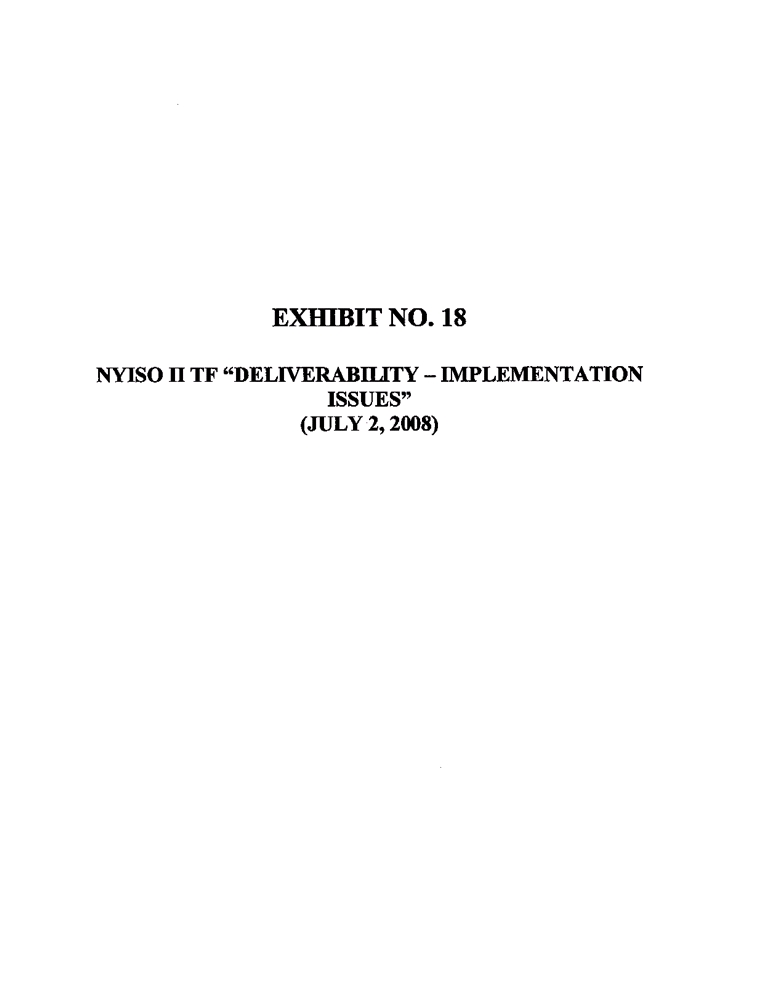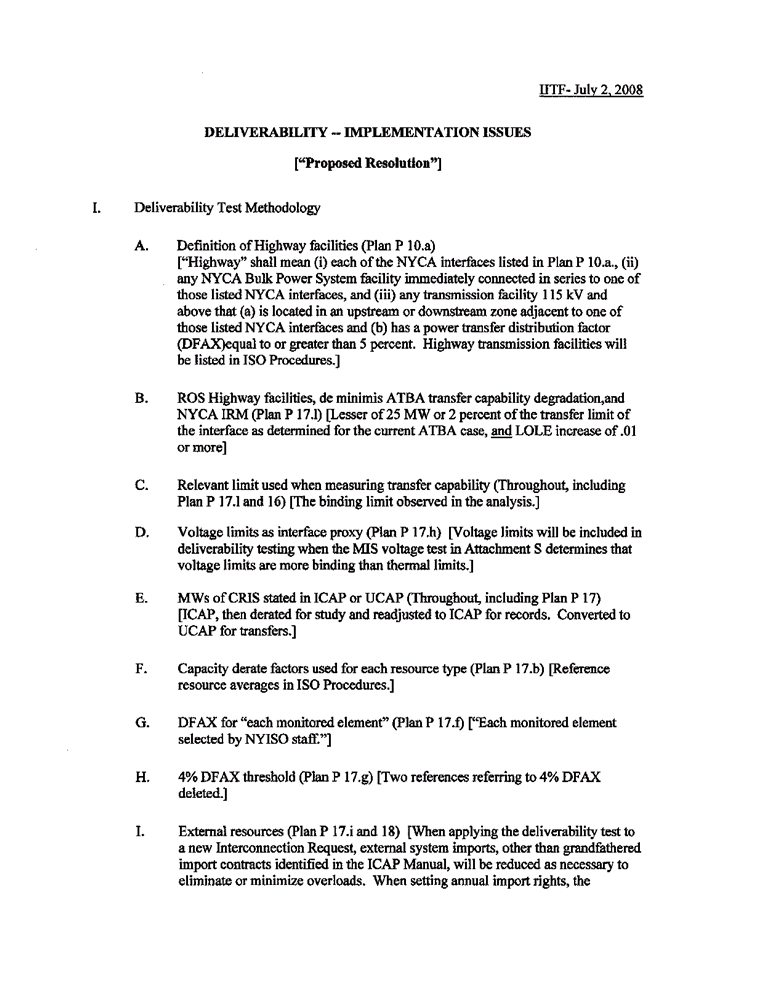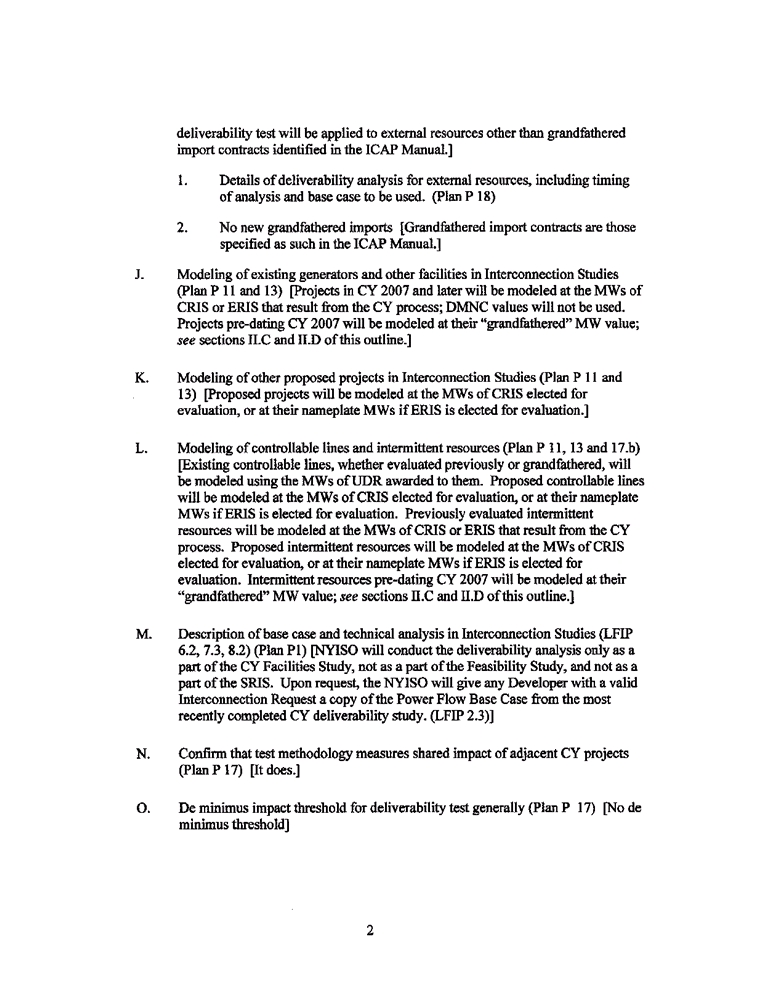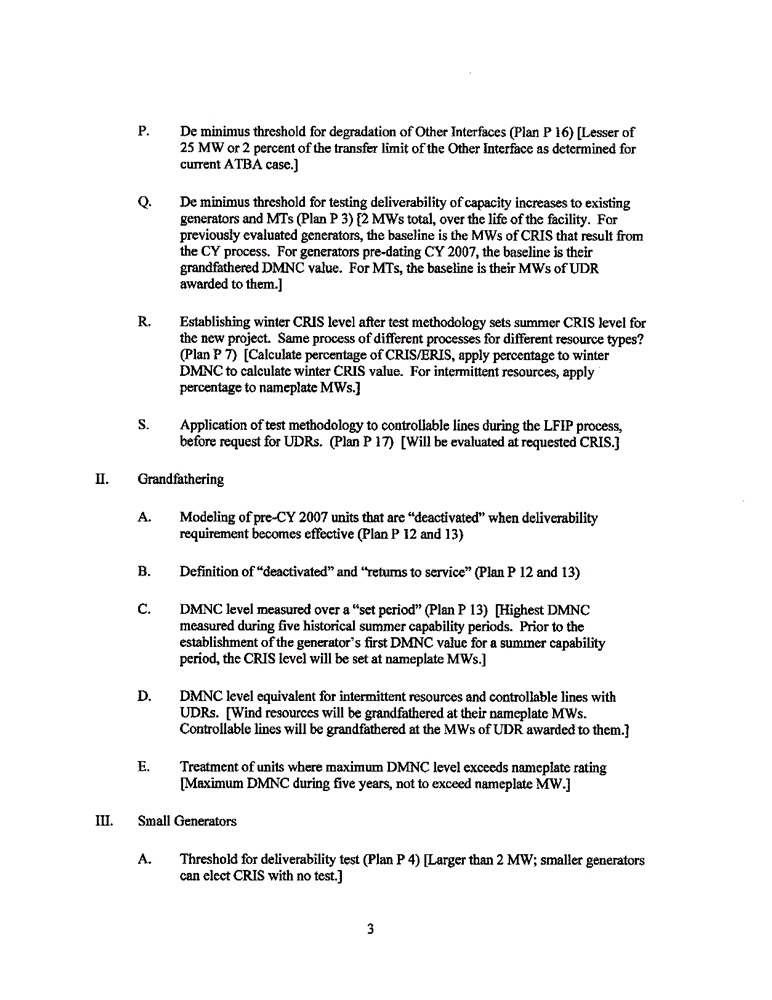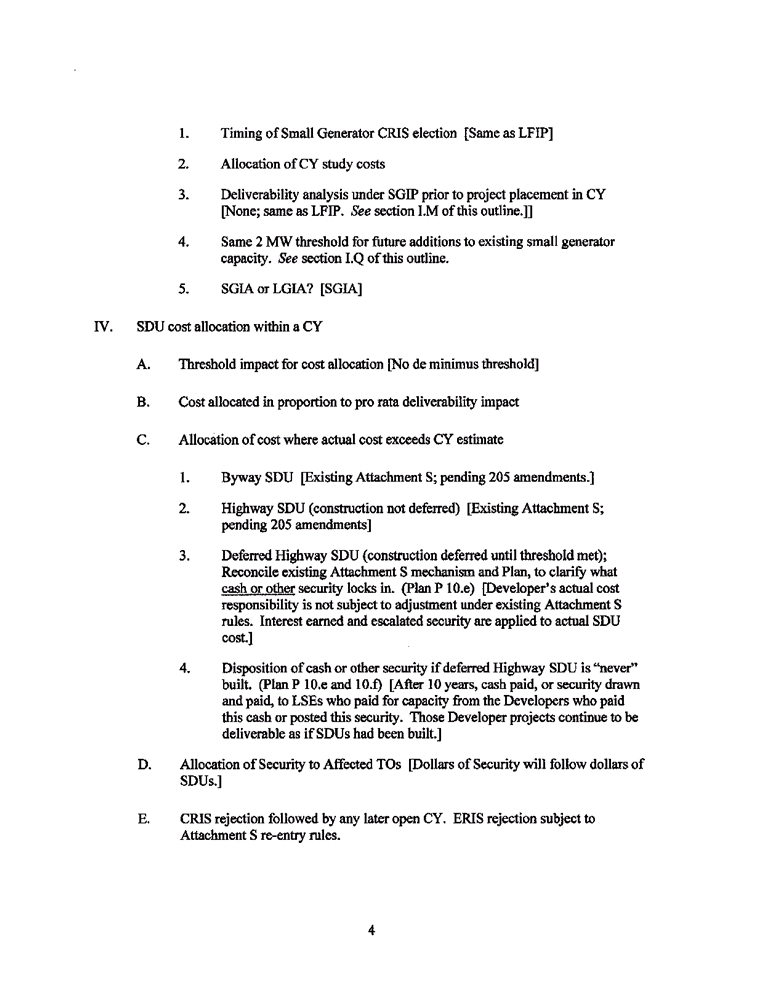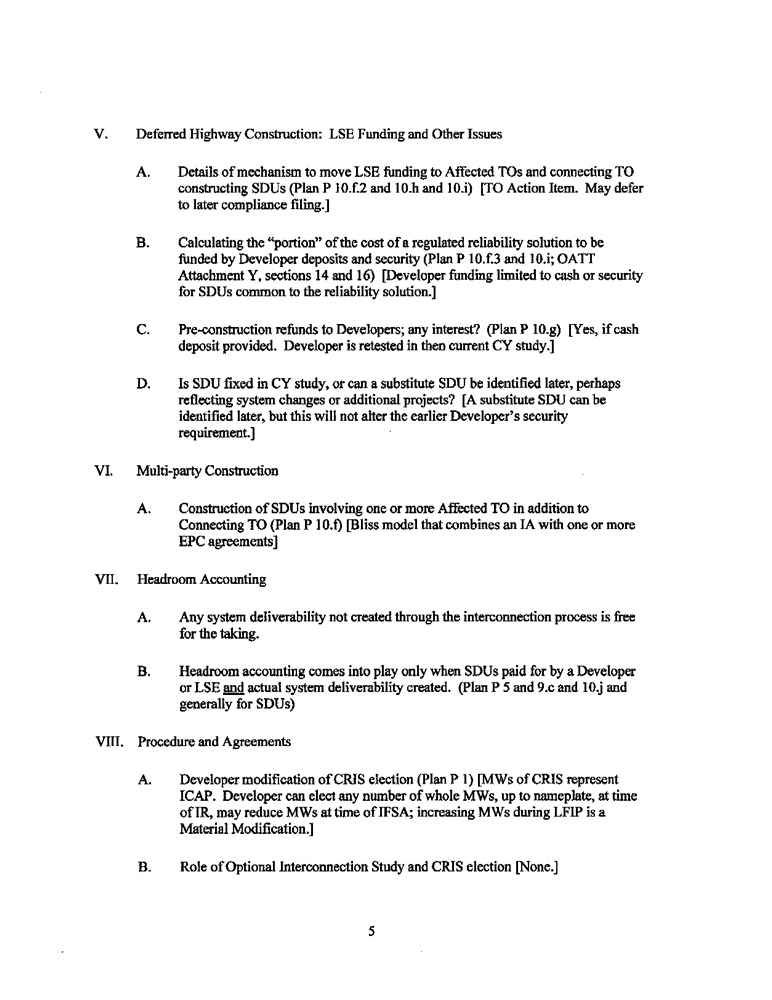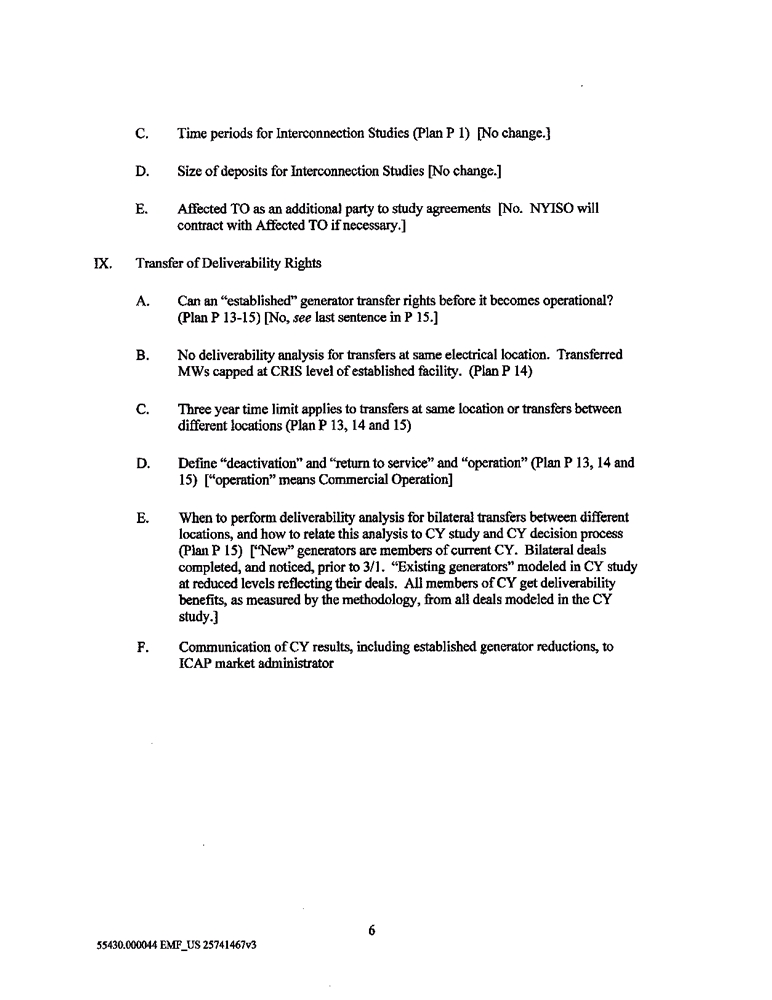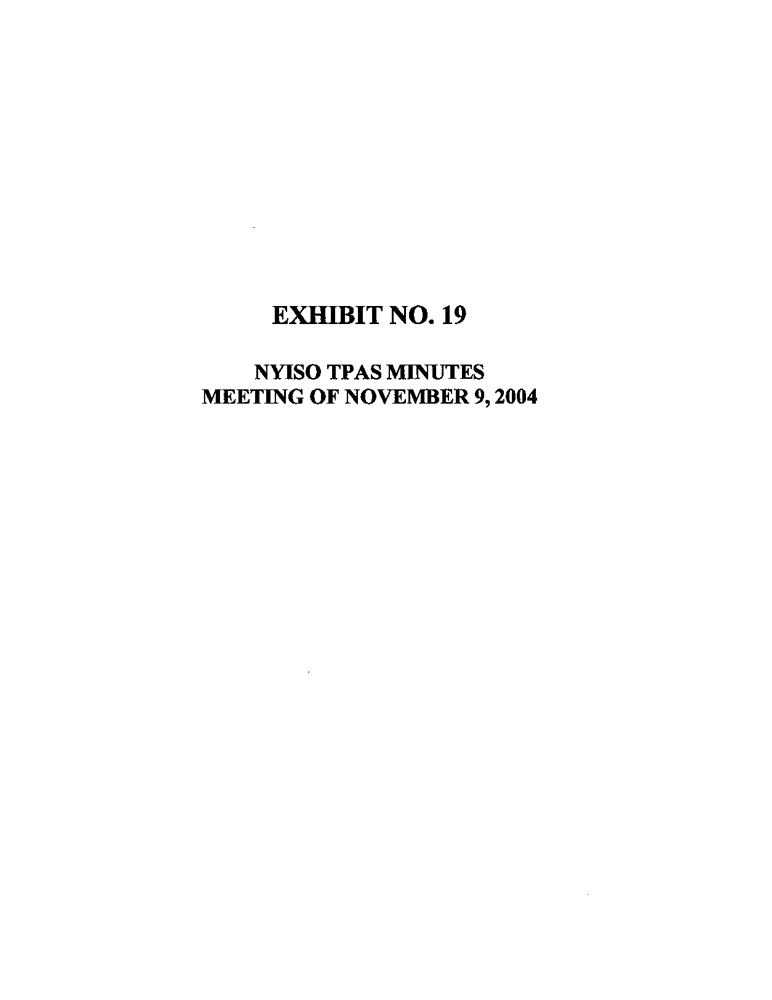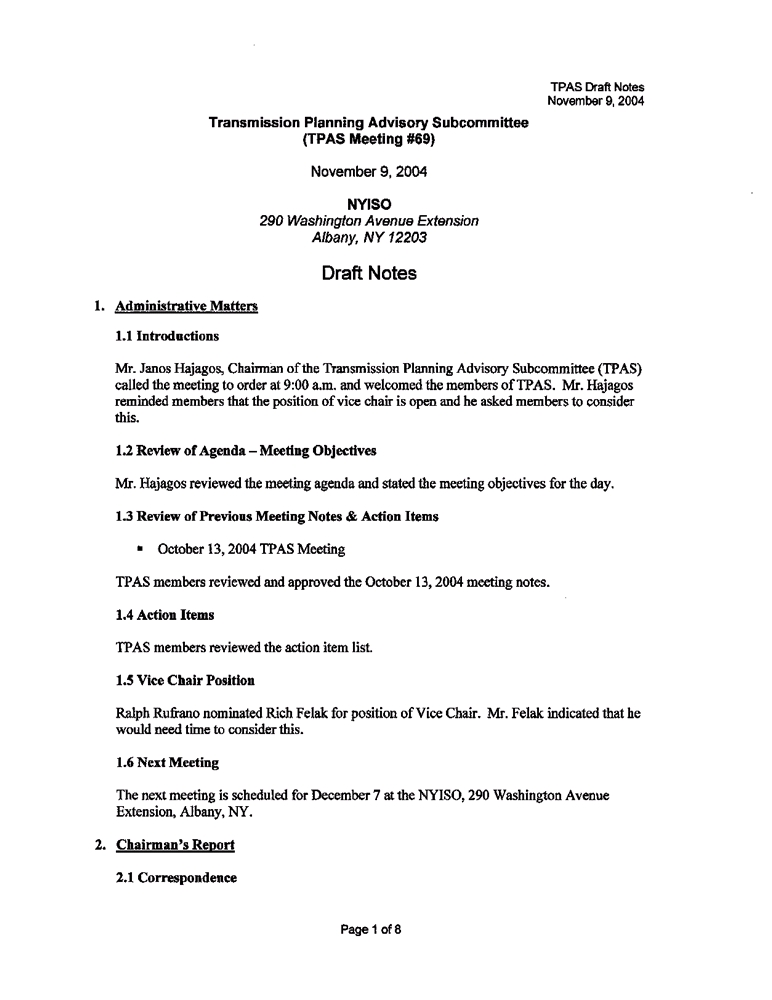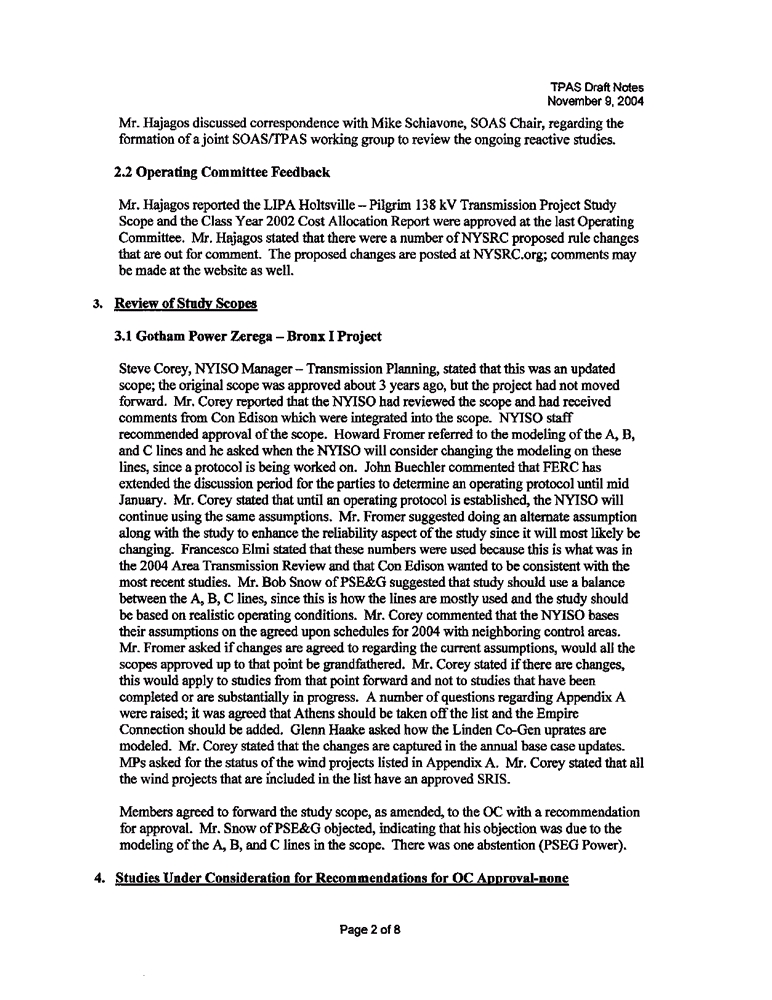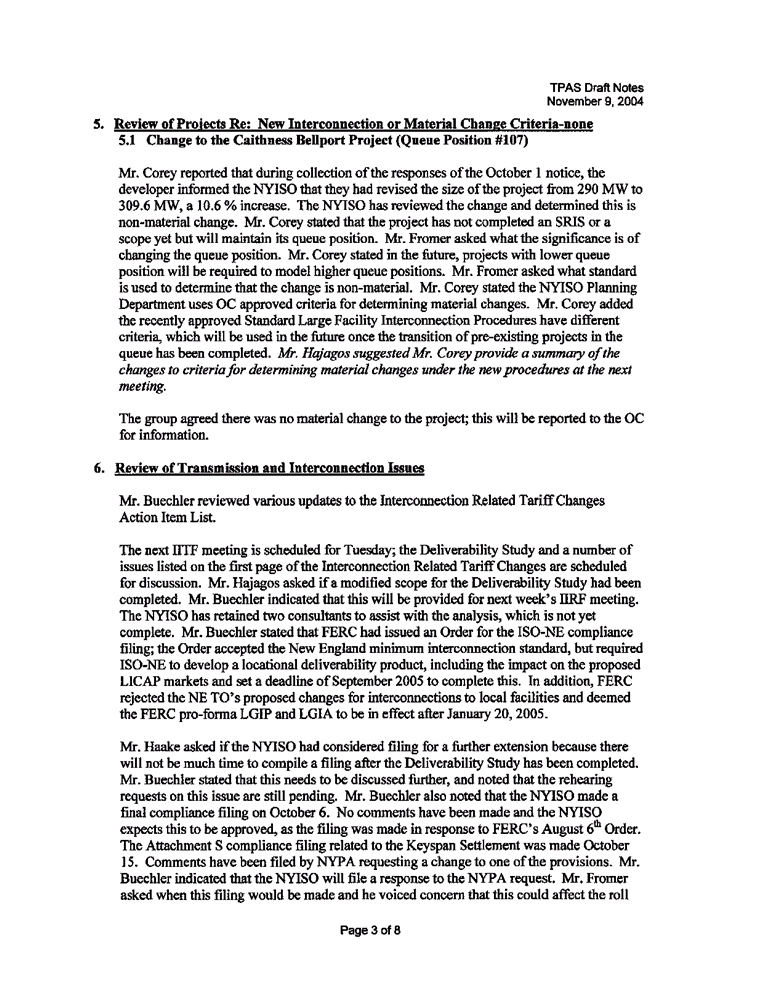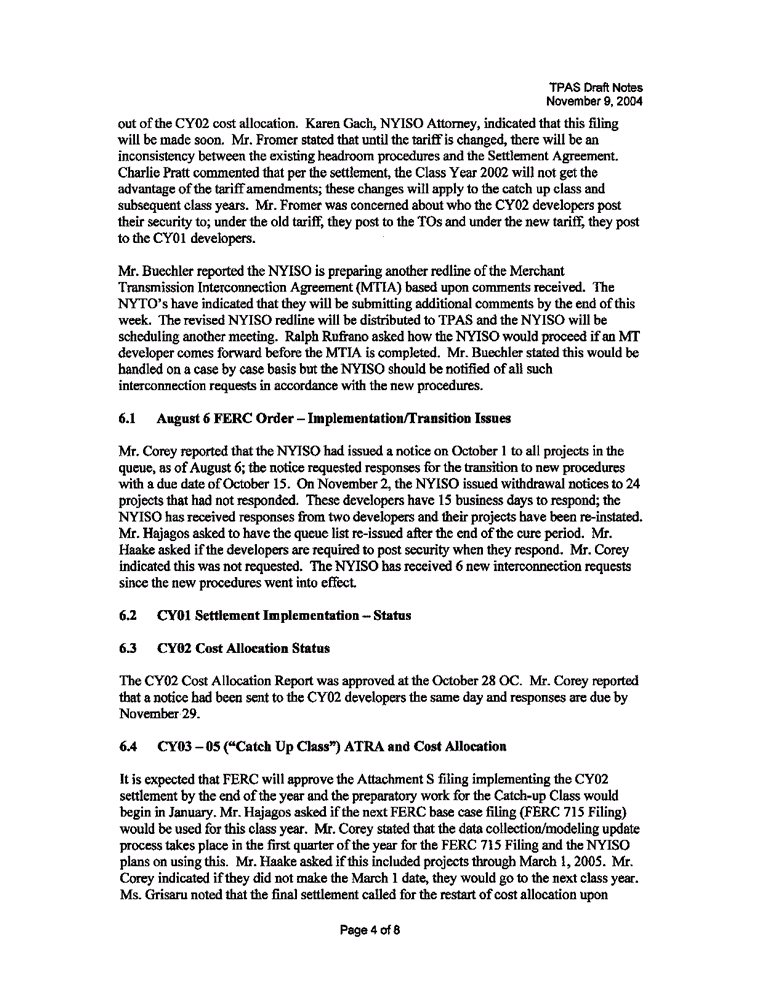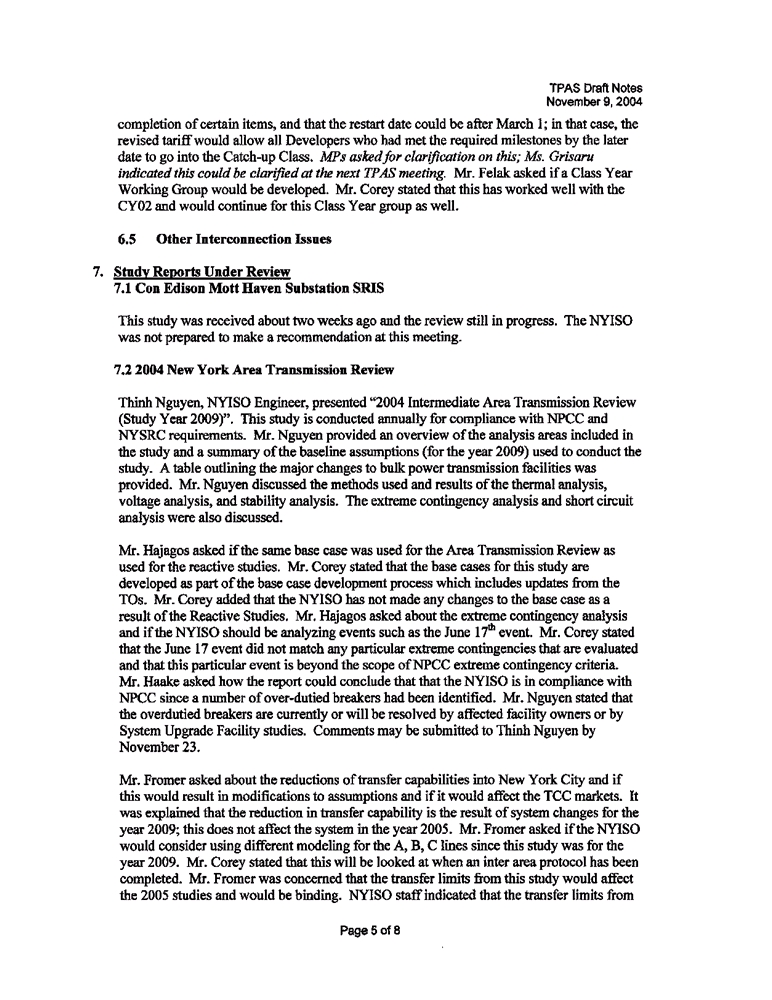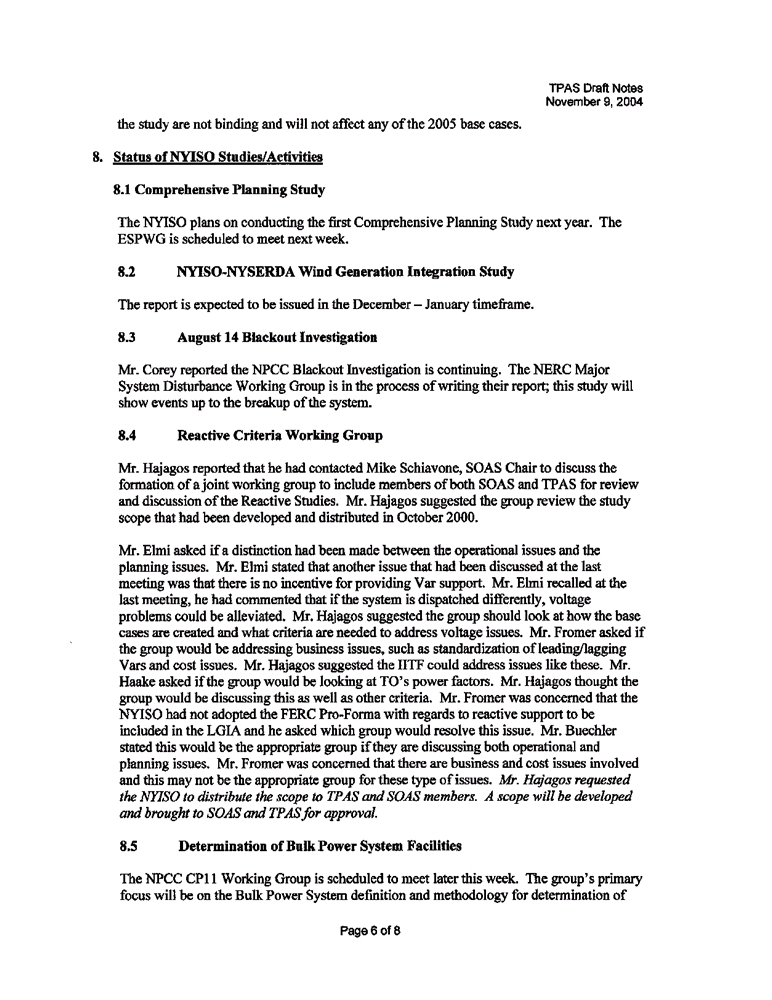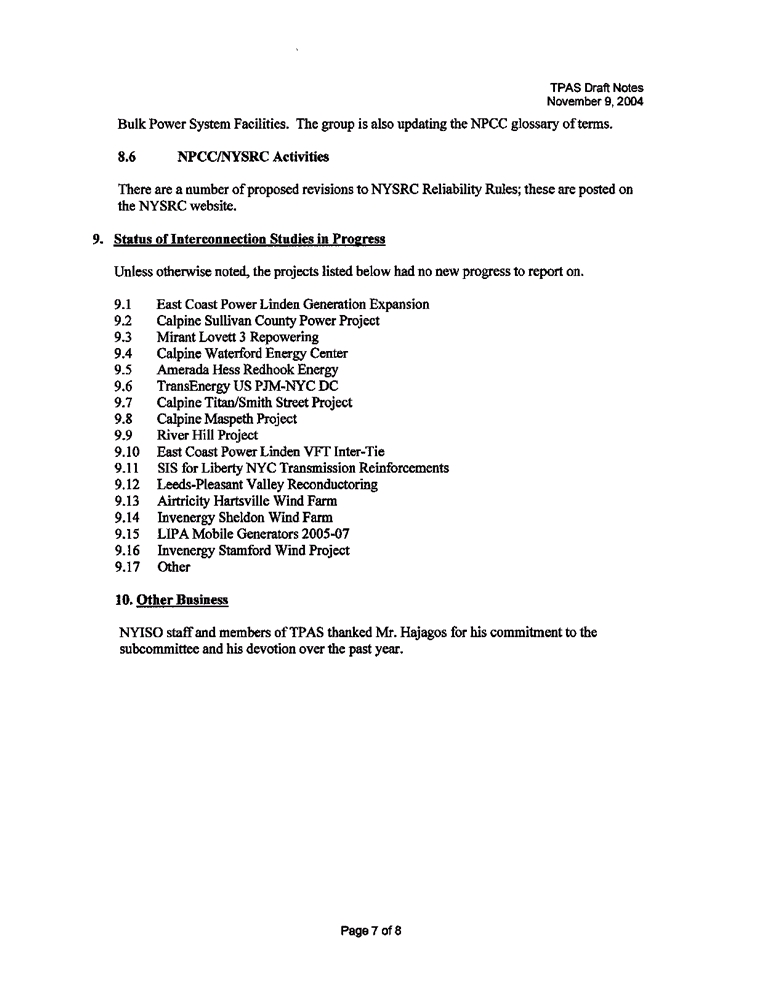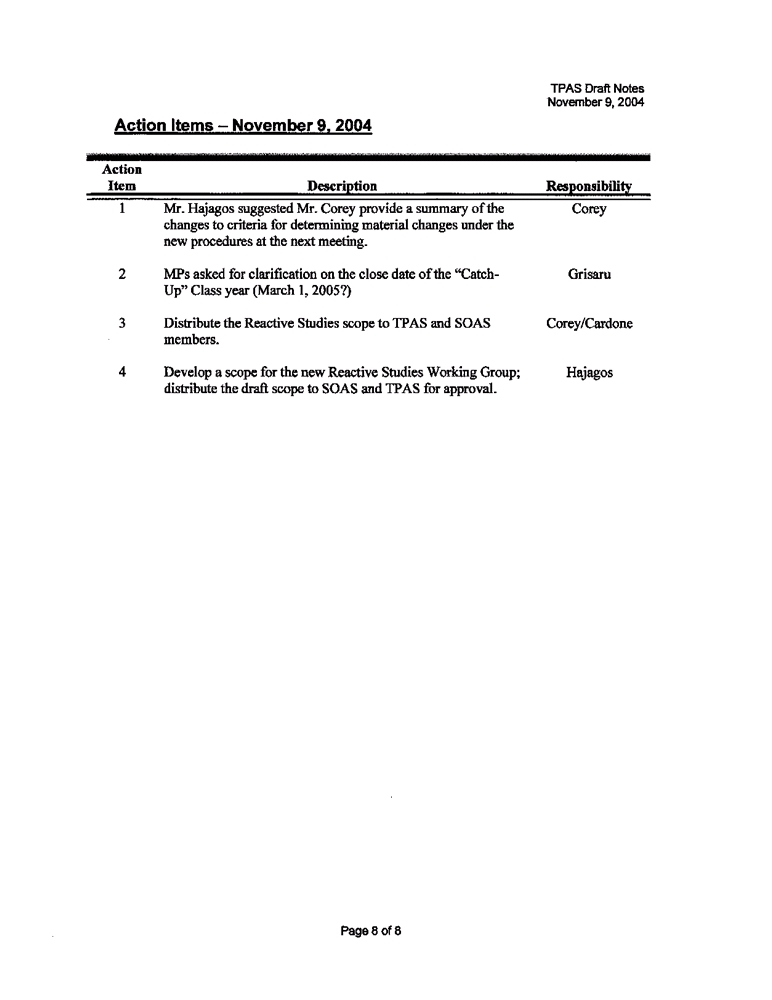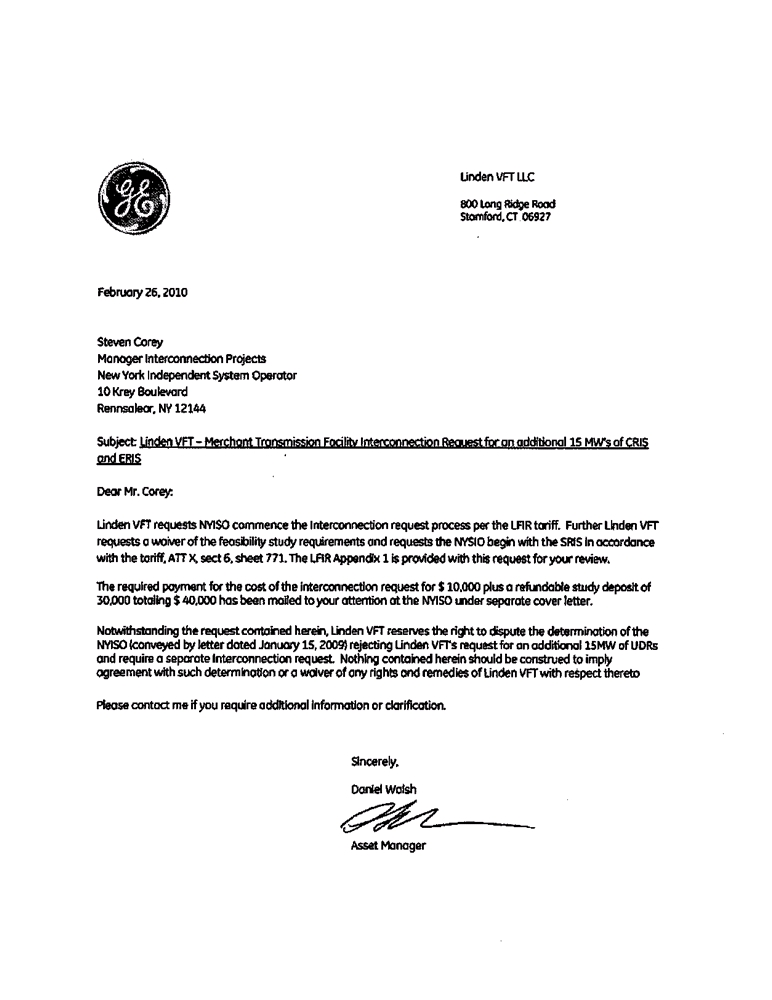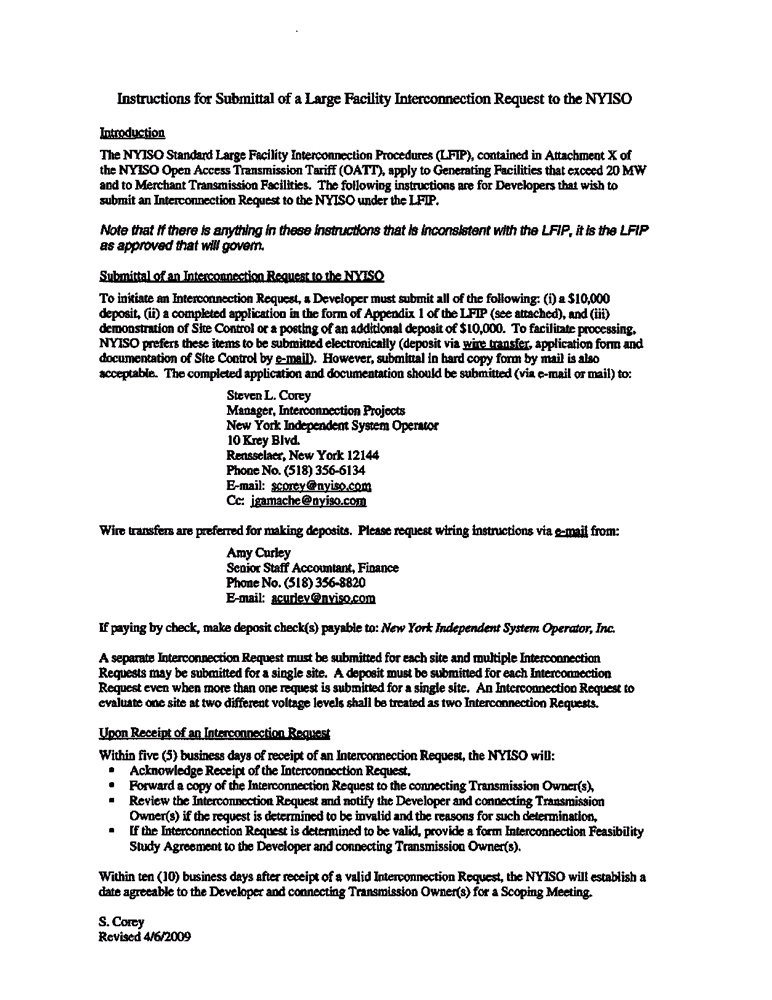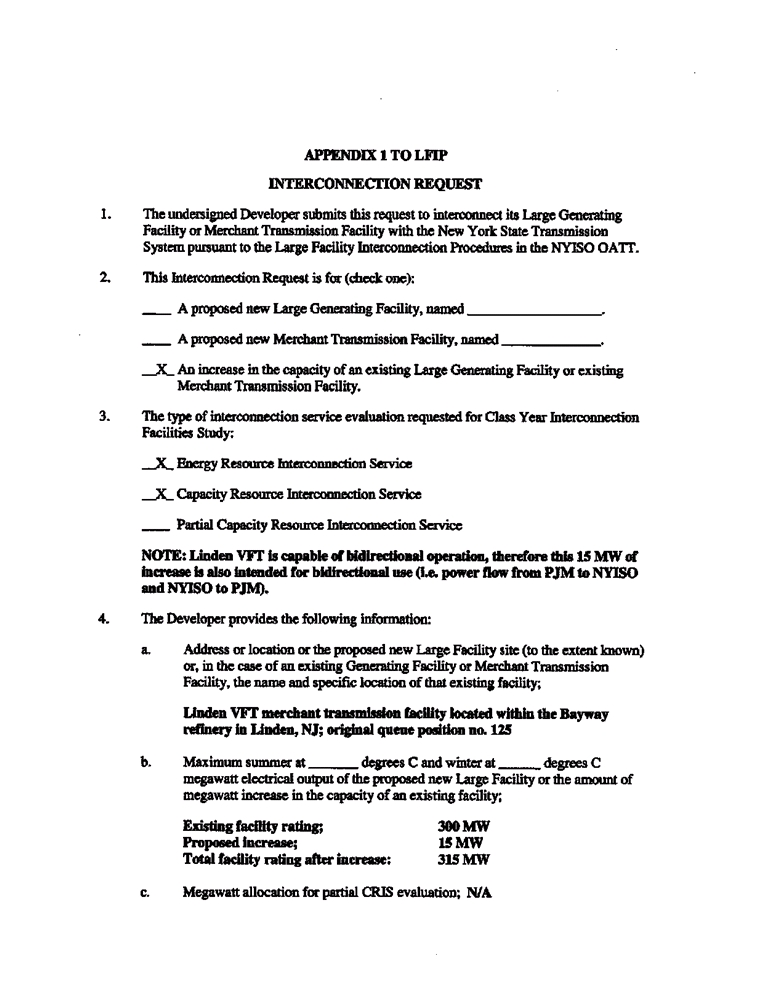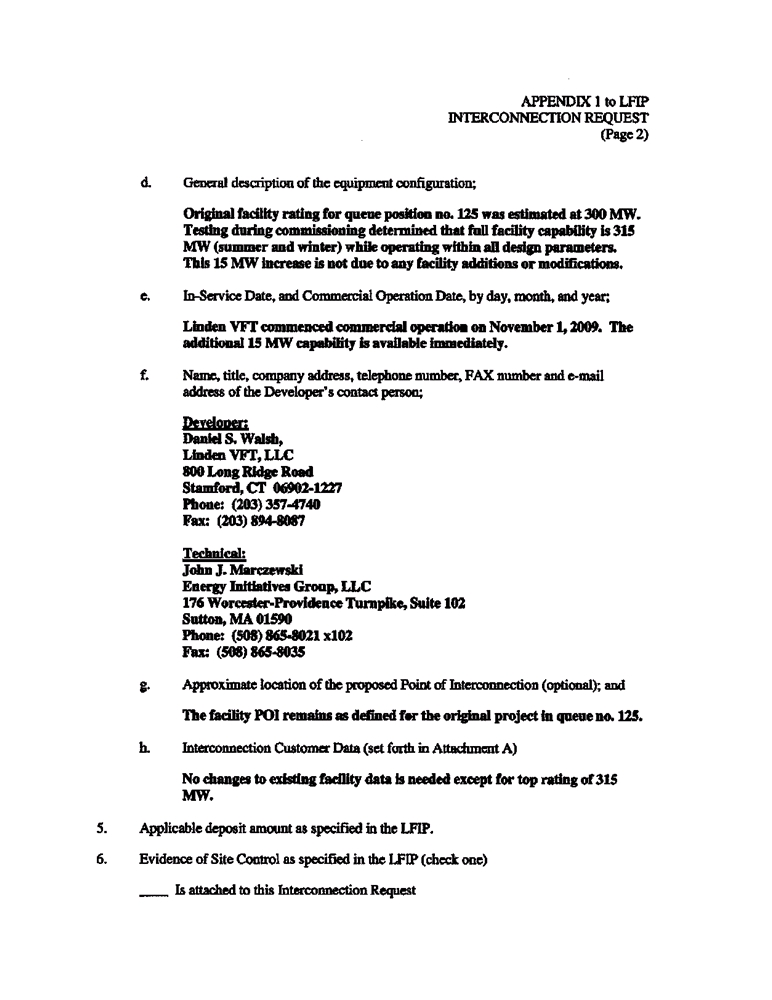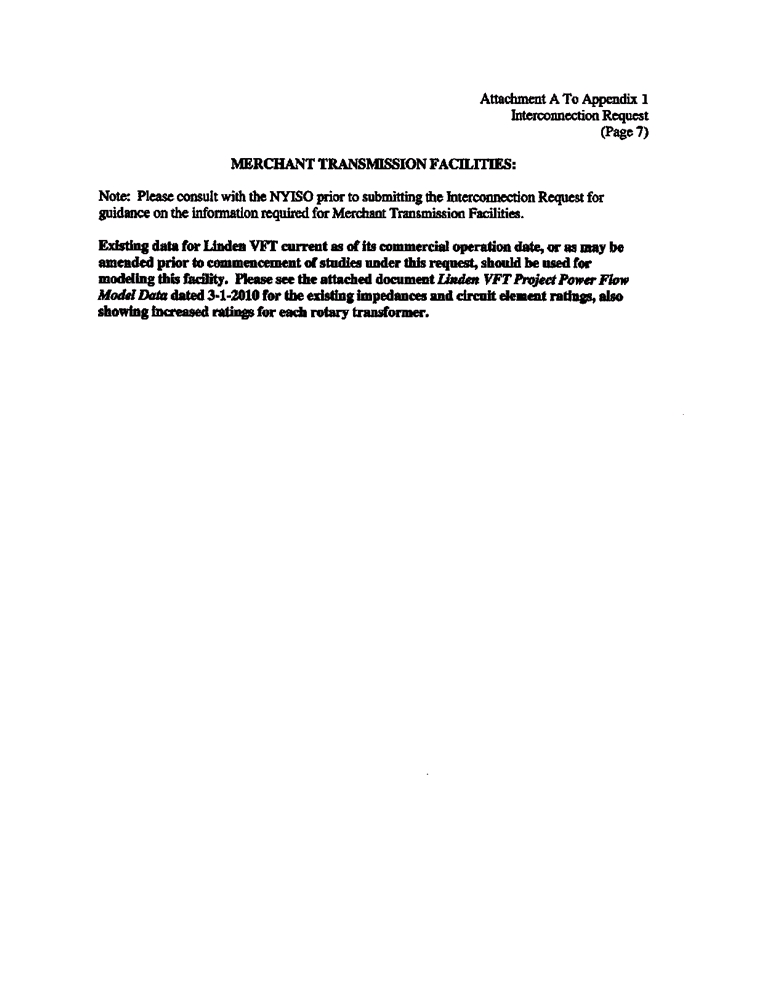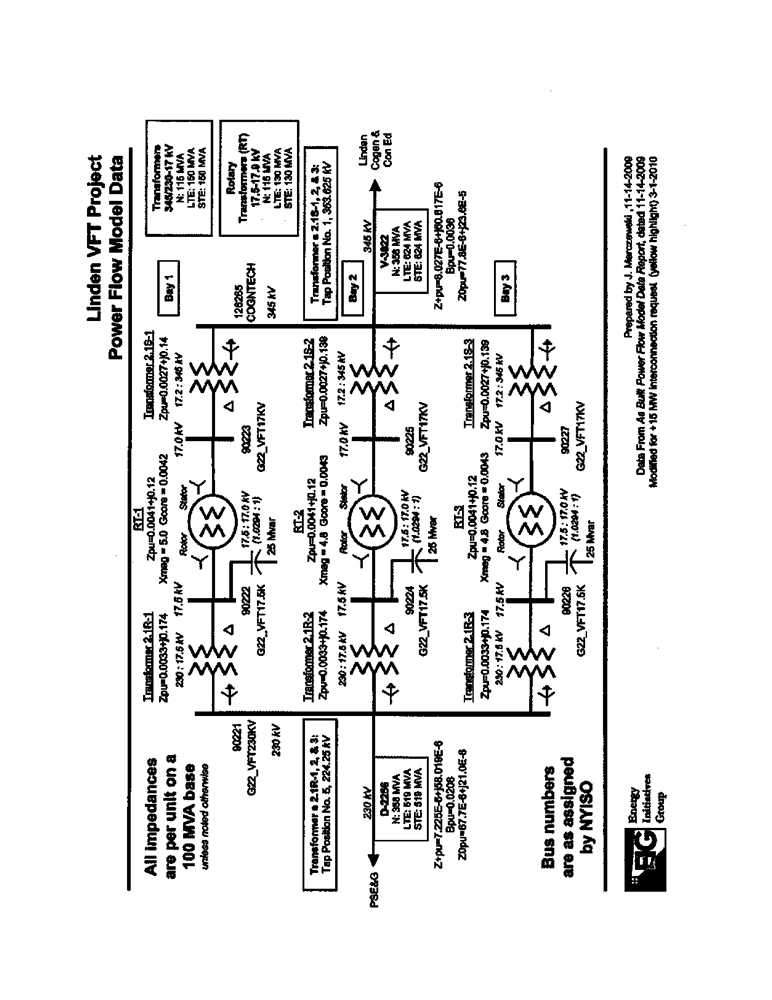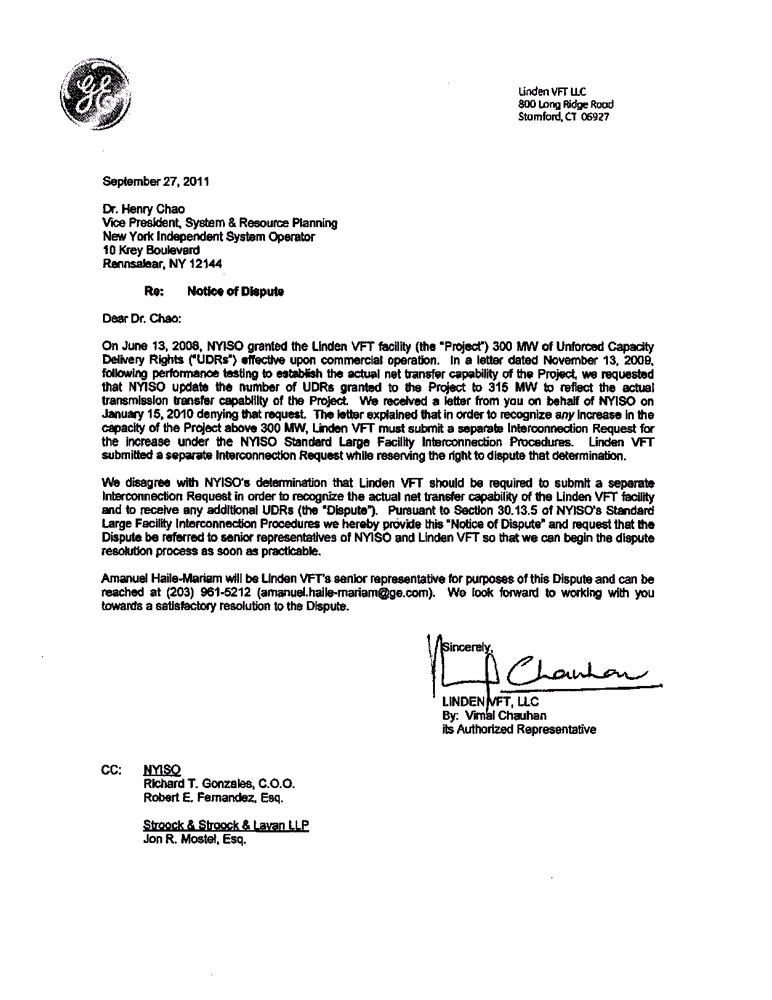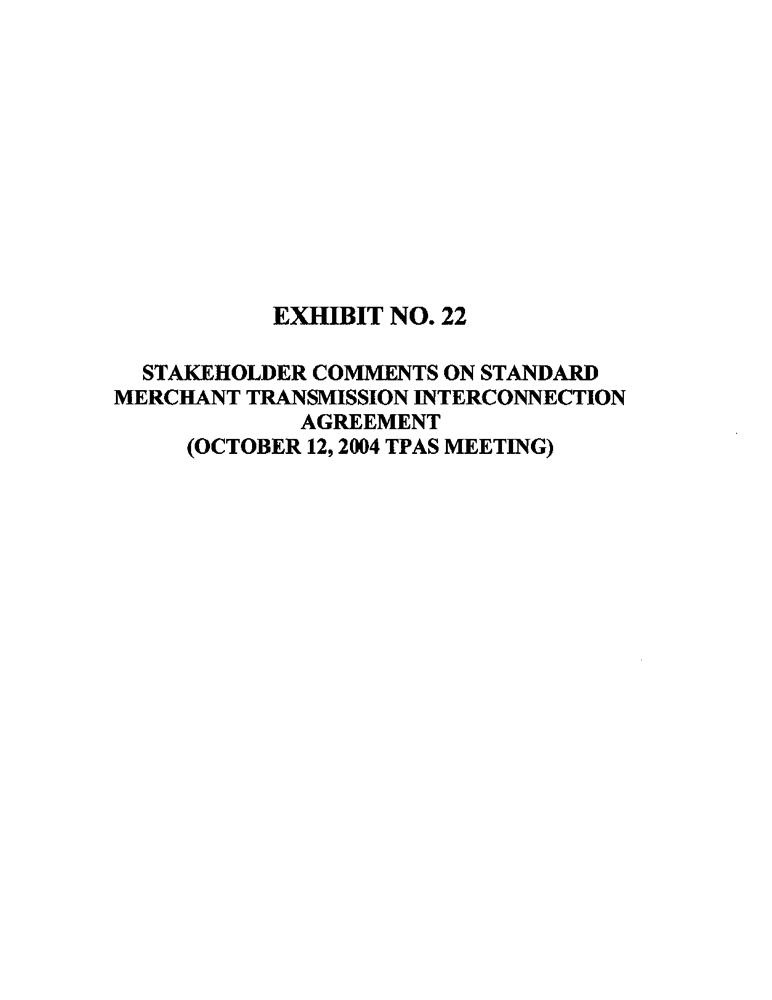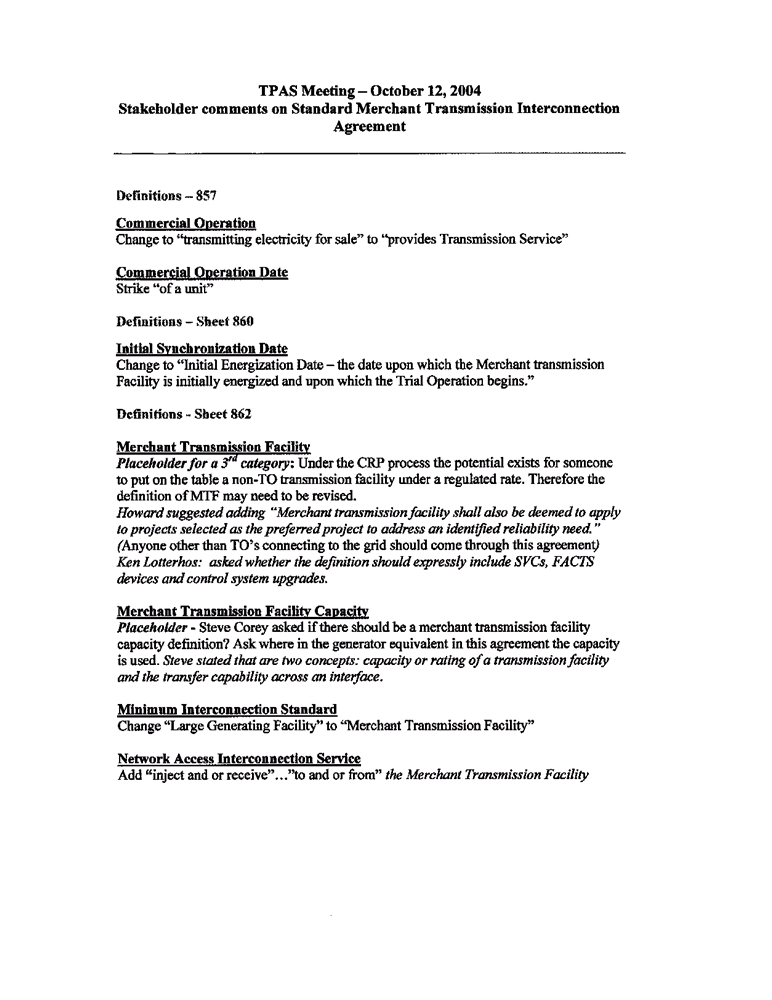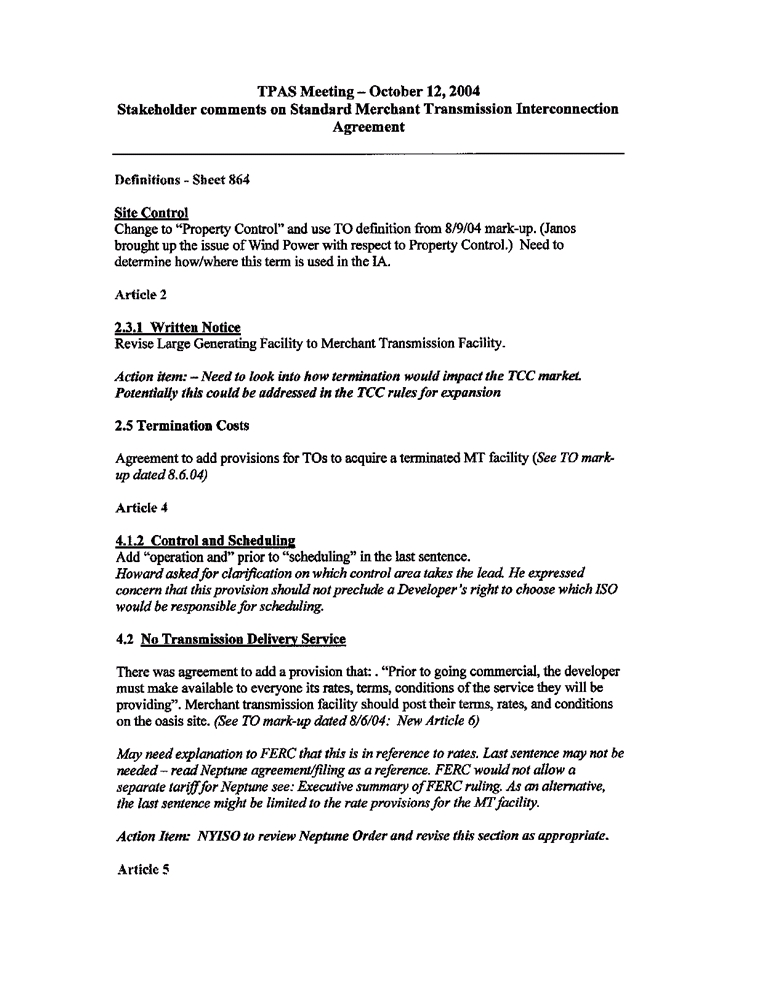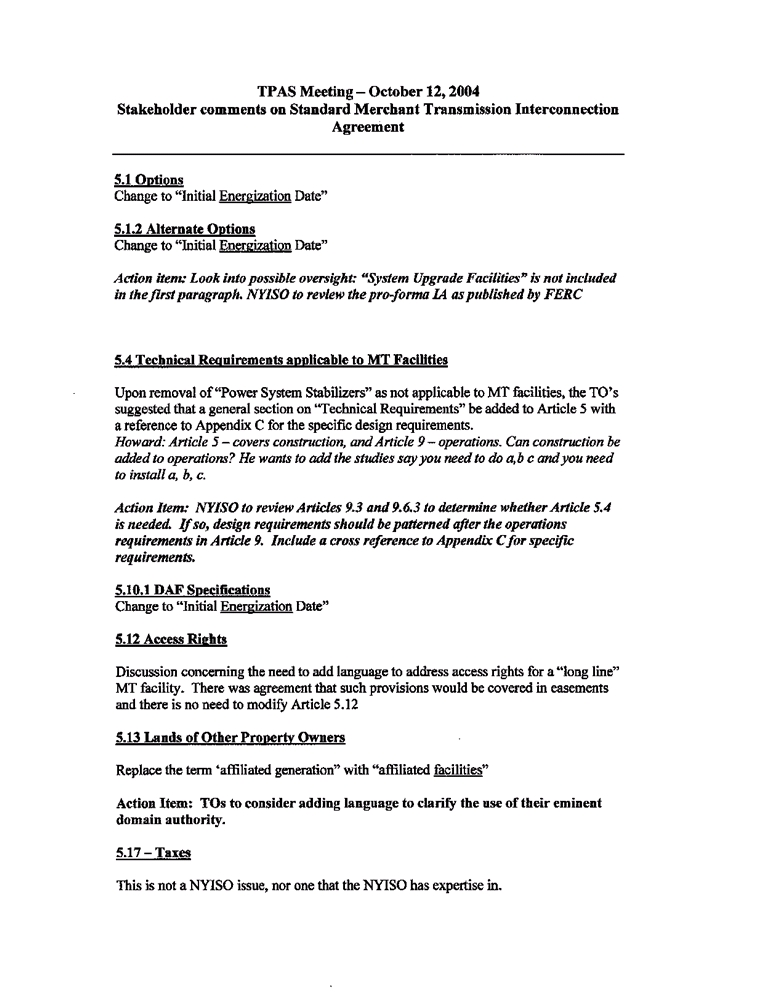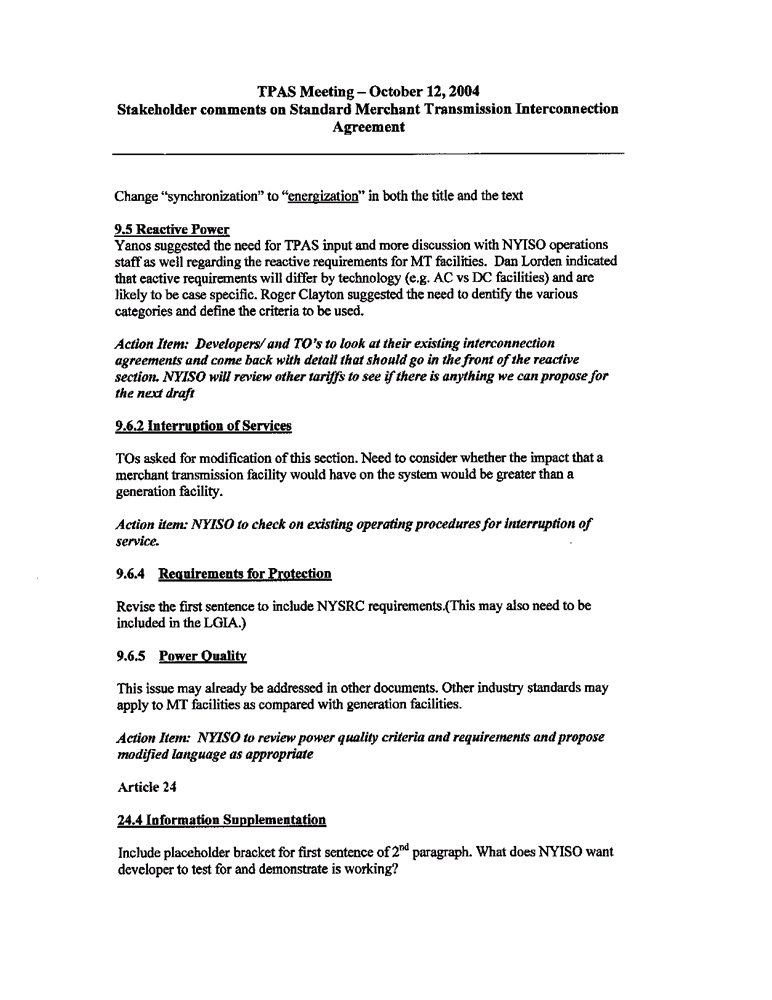UNITED STATES OF AMERICA
BEFORE THE FEDERAL ENERGY REGULATORY COMMISSION
Linden VFT, LLC
)
)
Complainant,
)
)
v.
)
Docket No. EL12-__
)
New York Independent System Operator, Inc.
)
)
Respondent.
)
COMPLAINT REQUESTING FAST TRACK PROCESSING OF LINDEN VFT, LLC
Pursuant to Section 206 of the Federal Power Act (“FPA”), 16 U.S.C. §824e, and
Rule 206 of the Rules of Practice and Procedure, 18 C.F.R. §385.206, of the Federal Energy
Regulatory Commission (the “Commission”), Linden VFT, LLC (“Linden VFT”) hereby files
this Complaint
(“Complaint”) against the New York Independent System Operator, Inc.
(“NYISO”).1 The Complaint seeks relief from NYISO’s discriminatory treatment of Linden
VFT under the NYISO OATT as it relates to NYISO’s determination of the Capacity Resource
Interconnection Service (“CRIS”) value for the Linden VFT project (the “Project”). The Project
is a Merchant Transmission Facility2 that connects the transmission system operated by PJM
Interconnection, LLC (“PJM”) in New Jersey and the transmission system operated by NYISO in
New York (the “New York State Transmission System”). The Project does not have a long-term
anchor customer; instead it periodically auctions its capacity to merchant shippers, so that an
1 Except as otherwise indicated, capitalized terms not specifically defined herein shall have the meaning set forth in
NYISO’s Open Access Transmission Tariff (“OATT”) and, if not defined therein, the same meaning as is provided
in the NYISO’s Market Administration and Control Area Services Tariff (“Services Tariff”). Procedures for the
interconnection of new projects to the New York State Transmission System are principally governed by the OATT,
with occasional reference to definitions and procedures in the Services Tariff. Therefore, unless otherwise specified,
references herein to the NYISO Tariff or Tariff procedures are to the OATT.
2 OATT, Section 30 Attachment X
(Large Facility Interconnection Procedures)
§ 30.1 defines a Merchant
Transmission Facility as “[a] Developer’s device for the transmission of electricity identified in the Interconnection
Request, proposing to interconnect to the New York State Transmission System.”
accurate calculation of CRIS which maximizes the Project’s capacity is critical to its economic
viability.
Linden VFT requests that the Commission require NYISO to recognize the Project’s
actual transmission capacity in the same manner that it has recognized capacity for all other
grandfathered projects, including those in the 2006 interconnection “Class Year,” in accordance
with its OATT, giving effect to actual tested values, rather than the nominal value of 300 MW in
the Project’s initial interconnection request, submitted in
2002. Specifically, Linden VFT
requests the Commission direct NYISO to accept the performance tests conducted by the Project
when it achieved commercial operation in 2009 to establish a “Dependable Maximum Net
Capability”-equivalent value for the Project, resulting in an award of 315 MW of Unforced
Capacity Delivery Rights
(“UDRs”), rather than requiring the Project to make a new
interconnection request for 15 MWs of the Project’s transmission capability, possibly making the
Project responsible for additional deliverability upgrade charges in addition to interconnection
charges initially allocated to the Project (now significantly in excess of the $10 million originally
specified in the Project’s large generator interconnection agreement).
I. Request for Fast Track Processing
Linden VFT requests fast-track processing of this complaint. Specifically, Linden VFT
requests that the Commission require NYISO to establish 315 MW as the Project’s applicable
rating, for all purposes, as soon as possible so that the Project’s full transmission capability may
be committed in the NYISO summer season monthly capability auctions for Summer 2012. An
expedited determination is necessary to mitigate the current harm to Linden VFT by permitting
the full transmission capability of the Project to participate in NYISO Capacity and Energy
markets in a manner that has been denied to it since November 13, 2009.
-2-
II. Copies of Correspondence
Please address all notices and communications regarding this filing3 to:
*Paul J. Halas, Esq., General Counsel
*Jon R. Mostel, Esq.
Vimal Chauhan, SVP
Adam H. Sheinkin, Esq.
GE Energy Financial Services, Inc.
Stroock & Stroock & Lavan LLP
800 Long Ridge Road
180 Maiden Lane
Stamford, CT 06927
New York, NY 10038
Tel: 203-357-4151
Tel: 212-806-5400
Fax: 513-204-3854
Fax: 212-806-6006
paul.halas@ge.com
jmostel@stroock.com
vimal.chauhan@ge.com
asheinkin@stroock.co-m
III. Description of the Complainant and Respondent
Complainant
Linden VFT is a Delaware limited liability company and is an indirect wholly-owned
subsidiary of General Electric Capital Corporation. Linden VFT owns the Project, a Merchant
Transmission Facility that is considered a Scheduled Line4 by NYISO pursuant to the OATT,
which interconnects in both PJM and NYISO transmission systems, assisting in inter-regional
integration of the bulk electric grid. The Project is one of a small number of successfully
developed merchant projects in the competitive New York electricity markets and the only one
without a long-term anchor customer with retail load obligations.
3 *Denotes persons designated to receive service in accordance with 18 CFR § 385.204(b)(3).
4 NYISO OATT, Section 1 defines a “Scheduled Line” as “[a] transmission facility or set of transmission facilities:
(a) that provide a distinct scheduling path interconnecting the ISO with an adjacent control area, (b) over which
Customers are permitted to schedule External Transactions, (c) for which the NYISO separately posts [Total
Transfer Capacity] and [Available Transfer Capacity], and (d) for which there is the capability to maintain the
Scheduled Line actual interchange at the [Desired Net Interchange], or within the tolerances dictated by Good
Utility Practice.”, where Total Transfer Capability is “[t]he amount of electric power that can be transferred over”
the interconnected transmission network in a reliable manner; Available Transfer Capability is “[a] measure of the
Transfer Capability remaining in the physical transmission network for further commercial activity, over and above
already committed uses . . .” and Desired Net Interchange is “[a] mechanism used to set and maintain the desired
Energy interchange (or transfer) between two Control Areas.”
-3-
Respondent
NYISO is a not-for-profit corporation formed under New York law. NYISO is an entity
subject to the Commission’s jurisdiction, and possesses operational control over the New York
State Transmission System.5 NYISO is an independent body that provides open access
transmission service, maintains reliability, and administers competitive wholesale Energy and
Capacity6 markets in New York State pursuant to tariffs filed with the Commission.7
IV. Background
This case involves the interconnection of a Merchant Transmission Facility between the
transmission systems operated by two independent system operators, PJM and NYISO.8 The
Project, which uses GE Energy’s VFT technology (which was a new technology at the time of
the Project’s interconnection request),9 is under the operational control of PJM.10 The Project
made separate interconnection requests to each of PJM and NYISO and is designed to operate
within the power factor and voltage ranges of the adjacent control areas.
The Project entered the NYISO interconnection process with an interconnection request
in July 2002 (the
“2002 Interconnection Request”) that it be studied as though it were a
generator. The Project achieved commercial operation on November 1, 2009 and its 315 MW
transmission capability was demonstrated on October 15,
2009 through performance tests
5 See, e.g., Central Hudson Gas & Electric, et. al., 83 FERC ¶ 61,352, order on rehearing, 87 FERC ¶ 61,135
(1999).
6 Section 1 of the NYISO OATT defines “Capacity” as “[t]he capability to generate or transmit electrical power, . . .
measured in megawatts (“MW”)” and
“Energy” as “a quantity of electricity that is [b]id, produced, purchased,
consumed, sold, or transmitted over a period of time, and measured or calculated in megawatt hours.”
7 Id.
8 The Complaint is accompanied by the affidavit of John J. Marczewski, a professional engineer for over 25 years
with over 10 years of experience with NYISO’s interconnection procedures. In addition to serving as a stakeholder
representative, Mr. Marczewski is a former Chair of NYISO’s Operating Committee and its Transmission Planning
Advisory Subcommittee. Mr. Marczewski’s affidavit explains the Linden VFT project, its interconnection request
to NYISO and other relevant documents relating to the NYISO interconnection process. Exhibit No. 1, Affidavit of
John Marczewski (the “Marczewski Affidavit”). Mr. Marczewski’s curriculum vitae is attached as Exhibit No. 2.
9 See Marczewski Affidavit at p. 8. VFT was a development technology in 2002. No VFT units had been
constructed and placed in service.
10 Linden VFT, LLC, 119 FERC ¶ 61,066 (2007), at pp 4-7, 20.
-4-
conducted in an equivalent manner by which the Dependable Maximum Net Capability
(“DMNC”) of generators interconnected to the NYISO system is established.11 This is 15 MW
(the “Incremental Capacity”), or 5%, greater than the nominal transmission capability stated in
megawatts and estimated based on manufacturer specifications, in the Project’s
2002
Interconnection Request.12 Notwithstanding explicit requirements in its OATT that resources
like the Project be awarded a CRIS value equal to their maximum capability established through
testing, NYISO required that the Project initiate a new interconnection study process for the
Incremental Capacity, resulting in costs and delays and subjecting the Project to unwarranted
deliverability assessments.
It should come as no surprise that the actual transmission capability of the VFT
technology used in the Project might exceed the “nameplate” rating assigned to it by its
manufacturer in 1998. Actual performance often deviates in a non-material amount from design
capability for large electrical equipment, including generators and transformers. At the time of
the 2002 Interconnection Request, VFT was a new technology without a significant history of
field operation. As NYISO has previously explained, nameplate data has not been an acceptable
substitute for an actual demonstration of performance.13
11 See Marczewski Affidavit at p 17. (“The transmission capability of Linden VFT was tested in a manner identical
to which the DMNC of generators is established.”)
12 The Project made identical interconnection requests to PJM (in June 2001) and NYISO (in July 2002) stating the
same nominal 300 MW capacity. See Marczewski Affidavit at p. 8.
(Exhibits 3-B and 3-A, respectively). PJM
awarded the Project 330 MW of Firm Transmission Withdrawal Rights pursuant to its tariff, recognizing that there
are some losses and auxiliary power usage between the amount withdrawn from PJM and the amount of power
delivered to NYISO. Subsequently, when bidirectional service commenced on a commercial basis in June 2011,
PJM acknowledged the 315 MW transmission capacity of the Project. PJM Interconnection, LLC, docket no. ER11-
3250, PJM filing of Schedule 16-A Transmission Injection Rights (March 31, 2011), at 1.
13 Accord New York Independent System Operator, Inc., Docket No. EL07-18, Complaint of New York Independent
System Operator. Inc. (Dec. 1, 2006), at p. 3 (“[n]ameplate data is . . . equivalent to neither a demonstration test nor
production data. Consequently, if nameplate capacity were an acceptable form of data to supply when qualifying a
resource as an ICAP Supplier, the relevant sections of both the Services Tariff and the ICAP Manual would have
used that term . Further, “[w]ith the exception of the special case of Intermittent Resources (as a practical matter,
wind resources), the NYISO’s Service Tariff does not permit the nameplate capacity of a unit to be used to qualify
as an ICAP Supplier.” Id.
-5-
The transmission capability of
315 MW, established through testing upon
commencement of commercial operation, is consistent with the manufacturer’s design
expectations.14 The equipment’s nominal 110 megavolt amperes (MVA) transmission capability
(330 MVA in the aggregate), is also consistent with the more detailed technical data that
accompanied the 2002 Interconnection Request, that was used in the power flow modeling
studies for the Project, approved by NYISO in 2006, in which NYISO determined that the
Project could be reliably connected to the New York State Transmission System. In 2002, when
Linden VFT made the Interconnection Request, there was no pressure to be more precise (or
even to modestly overstate the manufacturer’s rating), it was reasonable for Linden VFT to
believe that it would ultimately be awarded capacity rights based on testing upon commencement
of commercial operations, as was the established NYISO practice at the time.
NYISO’s Operating Committee had adopted criteria in 2001 for determining when a new
interconnection request was required, including a provision that no “[m]aterial adverse difference
is suggested by a size increase of 10MW… or 5%..., whichever is greater…”, therefore not
requiring a new interconnection request in these situations.15 Linden VFT attached a copy of
these materiality criteria to the 2002 Interconnection Request.16 As discussed in more detail
below, NYISO has applied those criteria to determine that even greater changes in a project’s
capability are sometimes non-material and do not warrant a new interconnection request.
14 See Marczewski Affidavit at p. 17. (“The results of the performance tests demonstrated that the Project operated
within accepted engineering design limits, the Project’s design specifications, and as contemplated in the
interconnection request and the power factor design and voltage specified in the Interconnection Agreement.”).
15 See “Criteria for Defining a ‘New Interconnection’” (attached as Exhibit 3-A), and “Criteria for Defining a
Material Change in a Previously Proposed New Interconnection Project” (attached as Exhibit 5). As NYISO
explained to the Commission, the latter procedure “was to be used for determining whether a proposed project has
made a material change that would require reapplication for interconnection and a new queue position.” See 330
Fund I, L.P. v. New York Independent System Operator, Inc. docket No. EL07-78, Answer to Complaint of NYISO
(filed July 19, 2007) at pp18-19 and Exhibit B at pp. 6-9 (Affidavit of Steven L. Corey).
16 See Exhibit 3-A (July 10, 2002 Interconnection Request) at p.6.
-6-
After completion of construction and performance testing, on November 13, 2009, the
Project requested that NYISO recognize the Incremental Capacity demonstrated through
performance tests.17 Since January 2010, NYISO has insisted, despite numerous discussions on
this issue and NYISO’s practice with respect to numerous other relevant projects, and despite no
change or modification of Project equipment, any actual Capacity in excess of the amount stated
in the 2002 Interconnection Request (e.g., anything above 300 MW) can only be recognized
through the submission of a new interconnection request,18 the study of the project in NYISO’s
multi-year interconnection study process subject to changes in the incumbent transmission
owner’s transmission planning criteria, and the potential for the incumbent transmission owner to
require additional transmission upgrades, including applying deliverability criteria to the
Incremental Capacity.
NYISO’s action withholds 15 MW of immediately available Capacity and Energy from
the competitive New York electricity market in a discriminatory manner.
The Project was
developed, studied, interconnected and tested as though it were a generation resource and it
should be treated like a generator for the purpose of determining its capability to deliver power to
the New York State Transmission System. As each grandfathered generation facility reaches
completion, the OATT provides that it is tested over a five-year period, with the highest
operational capability becoming its Demonstrated Maximum Net Capacity (“DMNC”). It is only
fair to allow the Project’s performance test in 2009 to demonstrate its transmission capability or
“DMNC equivalent”. NYISO’s formulaic excuse for its refusal to do so, that it must re-study the
Project for the Incremental Capacity, is a red herring, as NYISO is well aware that a number of
engineering studies clearly establish that the Project’s Incremental Capacity can be
17 See Exhibit 16.
18 See Exhibit 17.
-7-
interconnected with no adverse impact on system reliability. Having exhausted the NYISO’s
dispute resolution process, Linden VFT had no choice but to request relief from the Commission.
A.
Relevant Tariff Provisions
The interconnection procedures in the OATT have changed materially since Linden
VFT’s 2002 Interconnection Request. A substantive change was made to the OATT after the
Project had filed the 2002 Interconnection Request as a result of the Commission’s Order
No. 200319 addressing requirements for two levels of transmission service. This Complaint
arises under NYISO’s October 5, 2007 filing of the framework for providing a second level of
interconnection service that incorporates a deliverability requirement and the grandfathering (or
exemption) from that requirement of all existing projects and certain new projects that were, like
the Project, progressing through NYISO’s interconnection queue at the time of the 2007 filing.20
NYISO’s OATT provides that it studies interconnection of projects as a “class” and considers all
projects that satisfy certain milestones as belonging to a “Class Year.” As described below, the
Project is a member of the 2006 Class Year.
In Order No. 2003, the Commission required all public utilities that own, control, or
operate facilities for transmitting electric energy in interstate commerce to require transmission
providers to offer interconnection customers two levels of interconnection service. To comply
with Order 2003, NYISO revised its OATT adding a second level of interconnection service
called Capacity Resource Interconnection Service (“CRIS”) that incorporates a deliverability21
19 Standardization of Generator Interconnection Agreements and Procedures, Order No. 2003, FERC Stats. & Regs.
¶ 31,146 (2003)(“Order No. 2003”), order on reh’g, Order No. 2003-A, FERC Stats. & Regs. ¶ 31,160 (2004), order
on reh’g, Order No. 2003-B, FERC Stats. & Regs. ¶ 31,171 (2004), order on reh’g, Order No. 2003-C, FERC Stats.
& Regs.¶ 31,190 (2005), affirmed sub nom. Nat’l Ass’n of Regulatory Util. Comm’rs v. FERC, 475 F.3d 1277 (D.C.
Cir. 2007).
20 New York Independent System Operator, Inc., 122 FERC ¶ 61,267 (Guidance Order on Conceptual Proposal
issued Mar. 21, 2008)(the “Guidance Order”), at P 3.
21 Id. at P 16 (“The NYISO Deliverability Plan defines deliverability as the ability to deliver the aggregate of New
York control area capacity resources to the aggregate control area load under summer peak conditions.”).
-8-
requirement and renamed its basic level of interconnection service as Energy Resource
Interconnection Service (“ERIS”). Where ERIS permits a customer to participate only in the
NYISO Energy and Ancillary Services markets, CRIS provides the interconnection customer
with the additional ability to participate in the NYISO installed capacity (“ICAP”) market to the
extent of its deliverable Capacity.22
In an order issued on March 21,
2008, the Commission accepted NYISO’s
“Deliverability Plan”23 while explicitly determining that the new deliverability requirement
would not apply to any pre-Class Year 2007 projects. Linden VFT was specifically identified as
one of the grandfathered projects.24
Linden VFT proceeded to construct and interconnect the Project which achieved
commercial operation on November 1, 2009.25 Immediately before commercial operation on
October 15, 2009, the Project conducted a physical performance test of its actual transmission
capability.26 Linden VFT conducted its performance test in a manner equivalent to that by
which grandfathered generation projects establish their DMNC,27 showing the capability to
deliver power to the NYISO transmission system.28 Proposed procedures for this performance
22 Id., at P. 15. After implementation of the deliverability test the CRIS value for a project may be found to be less
than the physical capability of the project because a portion of project Capacity may be bottlenecked and not
deliverable unless certain System Deliverability Upgrade facilities are funded. Id., at P 17, 30.
23 Id., at P 1.
24 Id., at P 65.
25 See Marczewski Affidavit at p. 7.
26 Id., at p. 15-16.
27 The development of a comparable test was necessary. While NYISO’s ICAP Manual establishes Unforced
Capacity Deliverability Rights (“UDRs”), where the number of UDRs is based on transmission capability, as the
mechanism to treat generation capacity located in an external control area as if it were located within NYISO, it
does not set forth a procedure for demonstrating the transmission capability of new incremental controllable
transmission projects. See NYISO ICAP Manual Section 4.14 and 4.14.1. See Marczewski Affidavit at 16-17
(citing ICAP Manual at Section 4.2.2). In each case the test must establish “the [amount of] power delivered to the
transmission system.” Id. In each case the operating characteristics used for the test must be those expected during
the summer or winter peak load conditions and the test conformed to usual and customary industry practices. See
NYISO ICAP Manual Sections 4.2 and 4.2.2.
28 See also, NYISO ICAP Manual Section 4.2 (“All . . . Resources must test using usual and customary industry
practices. For example, the operating configuration and fuel mix used to test must be the same configuration and
fuel mix expected to be used during the summer or winter peak Load conditions, as applicable.”)
-9-
test were provided to NYISO on June 15, 2009, a full 4 months before anticipated testing. If
NYISO had any concerns with respect to the testing methodology Linden VFT proposed, it had
ample time and opportunity to provide comments or objections.
The performance test showed that the Project’s transmission capability was 315 MW in
accordance with customary industry practices and the operating characteristics expected during
peak load conditions. Based on these results, Linden VFT requested that NYISO adjust the
CRIS rating of the Project and the associated number of Unforced Capacity Deliverability Rights
(“UDRs”) awarded to the Project by the Incremental Capacity.29 NYISO denied Linden VFT’s
request.30
B.
Project Interconnection Request and Studies
On July 10, 2002, when Linden VFT submitted the 2002 Interconnection Request,31
NYISO’s interconnection procedures did not contemplate a separate methodology for
interconnection of Merchant Transmission Facilities32 or assessing the reliability effects of such
projects on the existing transmission system. Rather, the
2002 Interconnection Request
explained that the “[t]he new interconnection would effectively appear as a new generator or
load to the New York bulk power system.”33 NYISO accepted this equivalence to generation
and assigned queue position no. 125 to the request.34 The scope of work Linden VFT submitted
for the System Reliability Impact Study (“SRIS”) of the Project evidences that the Project would
be studied as a generator:
29 See Exhibit 16, the Services Tariff Section 2.21 (Definitions) and NYISO ICAP Manual Section 4.14. “UDRs are
rights, as measured in megawatts, associated with new incremental controllable transmission projects that provide a
transmission interface to a NYCA Locality [(i.e., an area of the NYCA in which a minimum amount of Installed
Capacity must be maintained)]. When combined with Unforced Capacity which is located in an External Control
Area . . . UDRs allow such Unforced Capacity to be treated as if it were located in the NYCA locality.”
30 See Exhibit 17.
31 See Exhibit 3-A.
32 See Marczewski Affidavit at p. 14.
33 See Exhibit 3-A at p. 2.
34 See Marczewski Affidavit at p. 8. (“NYISO assigned the VFT interconnection request queue position no. 125.”)
-10-
the Project is expected to displace generation by offsetting amounts from
units located inside the Con Edison system to obtain the requisite power
transfer for scenarios delivering maximum power from PJM into NYISO.
For scenarios delivering power from NYISO to PJM, the Project is
expected to require additional generation on the Con Edison System to be
dispatched to support delivery to PJM.35
The SRIS scope of work was reviewed by NYISO’s Transmission Planning Advisory
Subcommittee (“TPAS”) and approved by NYISO’s Operating Committee on January 22,
2004.36
In the Class Year 2006 interconnection study process NYISO sought to determine what,
if any, System Upgrade Facilities were necessary for a reliable interconnection of Class Year
2006 projects, including Linden VFT.37 The SRIS indicated that the Project could reliably
interconnect to the NYISO system as proposed. A 93.9 MW project that had proposed to
interconnect at the same location was abandoned after the SRIS was completed. Thus, there was
ample available headroom, confirmed in several subsequent studies,38 that the Project’s
Incremental Capacity (15MW) would have no adverse impact on system reliability.
The SRIS for the Project was completed in August 2005, reviewed by NYISO, presented
to TPAS and approved by the Operating Committee on March 16, 2006, permitting the Project to
be evaluated together with other Class Year 2006 projects. The Project accepted its cost
allocation for System Upgrade Facilities (initially specified at $10 million in the Project’s large
generator interconnection agreement and significantly exceeding that estimate to date) with other
35 See Marczewski Affidavit at p. 8. and Exhibit 12.
36 Id.
37 See Marczewski Affidavit at p. 18 n.2.
38 On February 26, 2010, Linden VFT submitted a new interconnection request to recognize the Incremental
Capacity while fully reserving its right to dispute NYISO’s January 15, 2010 determination as it has in this
Complaint. Marczewski Affidavit at p. 19. The new request was assigned queue position No. 351. The SRIS
conducted for queue position No. 351 was approved by the Operating Committee on February 28, 2011, which
allowed the Incremental Capacity to be evaluated in Class Year 2011 (the study of which is still in progress). This
new SRIS confirms what is obvious from a review of the original SRIS, that the Incremental Capacity will have no
adverse impact on system reliability.
-11-
Class Year 2006 projects in July 2007. An unexecuted interconnection agreement reflecting
these results was filed on February 28, 2008 (and accepted by the Commission in an order issued
on April 29, 2008).39
After Linden VFT’s interconnection process was complete the Commission accepted the
Deliverability Plan in an order issued on March 21,
2008, and determined that the new
deliverability requirement would not apply to any pre-Class Year 2007 projects, specifically
including Linden VFT.40 Pursuant to the Commission’s order, the full capability of each
grandfathered project to generate or transmit Energy would be deemed deliverable and qualified
for CRIS41 without being required to perform any additional studies or construct any additional
system upgrades based on deliverability.42 OATT provisions implementing the Deliverability
Plan state that the amount of grandfathered Capacity for all existing facilities and pre-Class Year
2007 projects would be determined by the highest value achieved in a test of each project’s
actual physical capability.43
On August 5, 2008, NYISO made a compliance filing to implement the Deliverability
Plan. Because the Project was the only Merchant Transmission Facility in the 2006 Class Year,
the filing often describes the new process in terms of generation only. However, NYISO
explicitly clarified that for these purposes, the Project was included as a “generator”, stating in
the compliance filing,
39 See Marczewski Affidavit at p. 18 n.2.
40 See Guidance Order at P. 65.
41 The CRIS value, which is a limit on how much of a project's Capacity may be allowed to participate in the ICAP
market, is now based on a deliverability test. Until the Deliverability Plan was effective, beginning with Class Year
2007, the "CRIS value" was 100% of project actual maximum net capability as determined through testing because
no project had to demonstrate that its Capacity was deliverable.
42 See New York Independent System Operator, Inc., 127 FERC ¶61, 318 (Order on Rehearing, Clarification and
Compliance) (June 30, 2009) at PP 18-19 (“the grandfathering provisions . . strike a reasonable balance between
existing capacity, pre-existing agreements and the needs of the market . . the proposed tariff revisions preserved
commitments entered into in accordance with existing tariff provisions . . .”).
43 See OATT Attachment S § 25.9.3.1.
-12-
[t]he NYISO’s interconnection procedures accommodate merchant
transmission projects as well as generation projects. As used herein, the
term “Generator” includes a proposed new Generator, an increase in the
capacity of an existing Generator, and a new controllable transmission
facility seeking Unforced Capacity Deliverability Rights. 44
Linden VFT does not seek special treatment. It has sought to be treated comparably, as
NYISO explained to the Commission that it would be. Generation resources and
merchant transmission facilities are similarly situated when they take service pursuant to
the same tariff interconnection provisions and are entitled to similar treatment.45
Following NYISO’s compliance filing, it was Linden VFT’s reasonable understanding
that the Project was grandfathered in like manner with 2006 Class Year generator projects.
Linden VFT expressed this understanding in its comments on the NYISO’s compliance filing,
explaining that:
Linden supports the Joint Compliance Filing, to the extent it accurately
and appropriately implements the Commission’s directive that the new
deliverability requirements shall not apply to pre-Class Year
2007
projects, including Linden. Linden appreciates the Commission’s clear
resolution of these issues and the NYISO’s attempt to comply with the
Commission’s directives in the March 21 Order . . . Linden is satisfied that
the NYISO complied with the Commission’s order with respect to
grandfathering Linden and UDRs . . .46
These new tariff provisions established a procedure for setting CRIS values for those
projects that had been grandfathered. A single standard was adopted, deeming the Capacity of
these projects deliverable at their demonstrated maximum net capability:
Generators in Class Years that pre-date Class Year 2007 are eligible to
receive CRIS. For these Generators, ‘the CRIS capacity level will be set
44 Exhibit 14, (docket no. ER04-449, NYISO Compliance Filing for the Deliverability Plan dated August 5, 2008),
n. 16.
45 See, e.g., Iberdrola Renewables, Inc., et al. v. Bonneville Power Administration, 137 FERC ¶ 61,185, P. 62
(2011).
46 New York Independent System Operator, Inc., Docket No. ER04-449-017, Comments on and Conditional Protest
of Linden VFT, LLC on the Joint Compliance Filing of the New York Independent System Operator, Inc. and the
New York Transmission Owners (filed Aug. 26, 2008) at pp. 1-2.
-13-
at the maximum [Demonstrable Maximum Net Capability (“DMNC”)
level achieved during . . . five summer capability periods . . . even if that
DMNC value exceeds nameplate MWs . . . and the CRIS capacity level for
controllable lines pre-dating Class Year 2007 will be set at the MWs of
Unforced Deliverability Rights [sic] awarded to them.47
Neither the OATT nor the Services Tariff contains a provision that further explicates the manner
in which UDRs are to be “awarded to” a “controllable line” (like the Project) other than its actual
transmission capability, and the Project has reasonably assumed that no distinction between the
capability of generators and controllable lines to deliver power to the New York State
Transmission System was intended by NYISO in this provision. The OATT does not state that
generators may establish a capacity greater than a nameplate rating by a performance test while
controllable lines may not. If such a distinction was intended, it should have been explicit in
order that interested parties would have been aware that NYISO had determined it appropriate to
differentiate the treatment among grandfathered projects and the basis for disparate treatment.
The new tariff language contained no other limitation on, nor procedure to be followed to permit,
full allocation of CRIS values based on actual demonstrated net capability or its equivalent for
these grandfathered projects.
Aware of these tariff provisions and the provisions of its Interconnection Agreement as it
completed construction of the Project, on October 15,
2009, Linden VFT conducted a
performance test of the Project48 and determined, over a continuous ten (10) hour test period, that
the transfer capability of the Project was
315 MW.49 On November 13, 2009, following
achievement of commercial operation by the Project, Linden VFT submitted a letter to NYISO
47 See Exhibit 14 at p. 15. This single standard applied to all grandfathered projects the vast majority of which
(29,057 MW (77%)) were interconnected to the New York State transmission system prior to the NYISO regime of
interconnection requests and studies. Marczewski Affidavit at p. 4
(citing NYISO Key Facts
(available at
48 See Exhibit 15. The draft “VFT Power and Performance Testing Plan,” which includes a procedure consistent
with prudent electric industry practice for testing and establishing maximum power transfer, was provided to
NYISO approximately four months prior to the October 15, 2009 test date. Id. at p. 11.
49 See Marczewski Affidavit at p. 16.
-14-
requesting an increase in the UDRs granted to the Project from 300 MW to 315 MW to reflect
the net transmission capability of the Project.50 The letter referenced the procedure for awarding
CRIS rights to grandfathered Generators, including the Project, based on the results of
performance tests.51
In a letter dated January 15, 2010, NYISO denied Linden VFT’s request offering only
that:
[i]n order for the NYISO to recognize any increase in the capacity of the
Linden VFT facility above 300MW, the Linden VFT LLC must submit a
separate Interconnection Request for the increase under the NYISO’s
Standard Large Facility Interconnection Procedures.52
There followed a series of unfruitful informal discussions between Linden VFT and
NYISO in late 2009, 2010 and 2011, culminating on September 27, 2011 when Linden VFT
delivered a “Notice of Dispute” to NYISO as required by Section 30.13.5 of NYISO’s Standard
Large Facility Interconnection Procedures, in order to begin a formal dispute resolution
process.53 During the course of the dispute resolution process, Linden VFT tried unsuccessfully
to reach an equitable solution in keeping with the Commission's intent in adopting Order
No. 2003 and NYISO’s assurance of comparable treatment accompanying the filing of tariff
language for determining the CRIS value for the grandfathered projects. However, NYISO
asserted that, notwithstanding the Project’s acknowledged grandfathered status, an OATT
provision effective on October 5, 2004 required that Linden VFT submit a new interconnection
request for any increase in the capacity of its Project.54 The retroactive application of this tariff
50 See Exhibit 16.
51 Id.
52 See Exhibit 17. Evaluating a portion of the Project’s capacity in a separate interconnection request would require
that portion of the Project’s capacity to be evaluated in a subsequent Class Year, subjecting that portion of the
Project’s capacity to subsequently adopted transmission planning criteria and deliverability testing requirements and
causing delays, incurrence of costs and lost revenue opportunities. Marczewski Affidavit at p. 5-6.
53 See Marczewski Affidavit and Exhibit 21.
54 See Exhibit 17.
-15-
provisions to Linden VFT, requiring a new interconnection request for NYISO to recognize a
non-material increase in demonstrated Capacity, would be contrary to the Commission’s orders,
inequitable, discriminatory and demonstrably unnecessary. Nonetheless, on December 20, 2011,
NYISO did just that, informing Linden VFT at the conclusion of the dispute resolution process
that it would make no adjustment of CRIS rights or UDR awards for the Incremental Capacity.55
Linden VFT is not surprised by the failure to reach resolution as NYISO has been under
continued stakeholder pressure to treat this Project differently in many respects. Since
March 2007, stakeholders, including the incumbent transmission owner, have singled out the
Project for disparate treatment. They have urged NYISO and the Commission to subject Linden
VFT alone to the proposed and subsequently adopted deliverability requirements despite the
grandfathering of all other Class Year 2006 projects from those requirements.56
V. Basis for Relief
Linden VFT developed the Project for almost a decade before construction was
completed and commercial operation achieved in 2009. It remains an unusual and valuable
transmission asset as it permits generation in PJM to access the NYISO Zone J market,
permitting the trading of Capacity and Energy at a constrained location. The Project is also
unique in that it provides this service without cost of service rate recovery or a long-term
contract with an entity that has captive ratepayers who pay cost of service rates. The Project is
truly merchant. Linden VFT has therefore taken pains to maintain certain of its rights under the
OATT and Services Tariff, including the right as a grandfathered 2006 Class Year project
pursuant to which it should have no obligation to show the deliverability of its actual
55 In accordance with Section 30.13.5
(Dispute Resolution) of the OATT meetings of senior representatives of each
party were held on October 13, 2011 and November 28, 2011 and by telephone conference on December 20, 2011.
56 See, e.g., Linden VFT, LLC, 119 FERC 61,066 (2007), at PP 39-40; New York Independent System Operator, Inc.
122 FERC ¶ 61,267 (2008), at P. 65-66; New York Independent System Operator, Inc, 123 FERC ¶ 61,093 (2008), at
PP 13-16 (the Commission held that the deliverability requirement does not apply to the Linden VFT project and
dismissed these arguments as moot).
-16-
transmission capability. NYISO’s position to the contrary regarding a portion of the Project (i) is
an unreasonable application of language in its OATT; and (ii) discriminates against the Project
relative to numerous pre-2007 Class Year projects and several post-2007 projects. Further, the
NYISO can advance no legitimate reliability concern in support of its position, as it has restudied
the Project, assuming the inclusion of the Incremental Capacity, and confirmed that delivery of
the Incremental Capacity would have no adverse impact on the transmission system. We
elaborate on these matters below.
A.
NYISO Has Incorrectly Applied the CRIS Grandfathering Procedure: No Rational
Basis Exists to Deny Recognition of the Project’s Actual Transmission Capability.
NYISO should recognize the full
315 MW transmission capability of the Project
315 MW as the Project’s CRIS value because that is the transmission capability to which it is
entitled as a grandfathered 2006 Class Year Project. However, in discussions (both formal and
informal) NYISO is unwilling to concede this point because it claims that another tariff
provision, filed in 2004, prevents NYISO from recognizing any increase above nominal capacity
set forth in the 2002 Interconnection Request without a new interconnection request. If this
interpretation were correct (which it is not), it would vitiate the repeated assurances from NYISO
that, for the purposes of the interconnection process, the Project is treated as a generator and that
existing non-material change criteria would continue to be applied to all those projects whose
interconnection requests predated the 2004 tariff revision.
The tariff provision NYISO asserts is the definition of “Interconnection Request” set
forth in OATT Section 30.1:
Interconnection Request shall mean Developer’s request, in the form of Appendix 1 to
the Standard Large Facility Interconnection Procedures, in accordance with the Tariff, to
interconnect a new Large Generating Facility or Merchant Transmission Facility to the
New York State Transmission System, or to increase the capacity of, or make a material
modification to the operating characteristics of, an existing Large Generating Facility or
-17-
Merchant Transmission Facility that is interconnected with the New York State
Transmission System.57
This tariff provision, issued on October 5, 2004 with an effective date of August 6, 2004, was
adopted to comply with the Commission’s Order No. 2003.58
Notwithstanding the logical and equitable flaw of applying the OATT definition of an
interconnection request, first effective in August 2004, to interpret the rights of a developer
pursuant to an interconnection request made in July 2002, the application of this tariff provision
to a project grandfathered from the subsequently adopted deliverability requirement produces an
absurd result. Before Order No. 2003, project size in interconnection requests was often
described, for convenience, in terms of the nameplate rating of project equipment, with the
reasonable expectation that deviations within the bounds of previously published materiality
criteria would not subject the project to further interconnection procedures. The interpretation
NYISO asserts, applying the definition of a new interconnection request to grandfathered
projects, would render meaningless specific language in the transition procedure for establishing
the CRIS value for those projects which are to be set at:
the maximum DMNC level achieved during the five most recent Summer Capability
Periods prior to October 5, 2008, even if that DMNC value exceeds nameplate MWs. For
a generator pre-dating Class Year 2007 and not having DMNC levels recorded for five
Summer Capability Periods prior to October 5, 2008, its CRIS capacity level will be set,
and reset if necessary, at the maximum DMNC level achieved during successive Summer
Capability Periods until it has DMNC levels recorded for five Summer Capability
Periods.
(emphasis added).59
57 See OATT, Attachment X (Standard Large Facility Interconnection Procedures)(the “LFIP”), § 30.1.
58 New York Independent System Operator, Inc., 108 FERC ¶ 61,159 (2004).
59 See OATT, Attachment S, § 25.9.3.1. Based on our discussions with NYISO, we believe its interpretation would
read these tariff provisions as potentially dividing grandfathered projects into two parts: a grandfathered portion up
to the capacity specified in an interconnection request
(if any had been made for the project) and a non-
grandfathered portion, the quantity in excess of nameplate capacity, subject to a new interconnection request that
would be evaluated in a subsequent class year process and subject to deliverability requirements. There is no textual
support for this view.
-18-
The vast majority of grandfathered resources, existing generators, were in service prior to
NYISO’s interconnection procedures. There is no interconnection request against which their
DMNC level equivalent could be evaluated and limited. Moreover, the tariff language, adopted
to be uniformly applied to all grandfathered projects, expressly provides that the full capability
of these projects would be recognized even “to the extent a DMNC value exceeds nameplate
MWs.”60 NYISO’s reliance on this tariff provision to deny to a grandfathered project
recognition of a portion of its transmission capacity cannot be squared with both the Guidance
Order and the tariffs filed in compliance therewith. It effectively eliminates from the CRIS
Value any portion of the capacity of a grandfathered project that exceeds the nameplate capacity
specified in an interconnection request.61 The tariff language was clearly intended to preclude
nameplate capacity as a cap for all existing projects. It could not have intended to impose a cap
based on a project’s interconnection request, since the vast majority of relevant projects predate
NYISO and were not required to make an interconnection request. The only reasonable limit
that the tariff can impose over nameplate capacity is the tested capacity of each project -
precisely matching NYISO’s practice for grandfathered generation facilities. The alternative -
using the interconnection request as a limit for only more recent projects - has no basis in the
tariff language and must be rejected.
NYISO explained to Linden VFT that it believed its tariff interpretation was consistent
with a case where the Commission found that even a de minimis increase in capacity required a
new interconnection request.62 That case is clearly inapposite. The capacity increase in that case
arose from a physical modification made to existing generation equipment. No modification or
change was made to the Linden VFT project to increase its transmission capability. Equally
60 Id.
61 See pp. 22-27, infra.
62 See Midwest Independent Transmission System Operator, Inc., 125 FERC ¶61,210 (2008).
-19-
important, that case also did not involve the interpretation of tariff rules intended to grandfather
certain projects from the prospective effect of a new interconnection tariff regime like the
Deliverability Plan.
NYISO’s tariff construction also inappropriately relies on a provision adopted to comply
with Order No. 2003 in a manner that would frustrate the essential purpose of Order No. 2003.
The Commission sought in Order No. 2003 to standardize interconnection procedures in order to
facilitate the fair, open and non-discriminatory connection of additional generation to
competitive markets.63 When those same procedures are enforced formulaically, frustrating the
reasonable expectation of sponsors participating in an interconnection queue that the rules will
not be materially changed in mid-process, they will impede interconnection - as they would here
- discouraging investment in new generation and transmission.
NYISO’s Class Year interconnection study process extends over a multi-year period. A
Class Year is comprised of a cluster of projects that have met specified Class Year eligibility
requirements by the time the combined group study begins in March each year.64 Not only
would a new interconnection request subject a project to further unnecessary studies, but, as a
result of Class Year clustering, it would not be unusual for a project to be delayed by three or
more years by being required to submit a new interconnection request to NYISO despite diligent
and costly efforts to comply.
It makes little sense to deny grandfathered treatment to Linden VFT by applying a “no
increase” standard that was adopted two years after this Project submitted its interconnection
request. When Linden VFT submitted its Interconnection Request for the Project in July 2002
the tariff then in effect defined a “New Interconnection” as:
63 See Order No. 2003, at pp. 10-11 (“…relatively unencumbered entry into the market is necessary for competitive
markets . . . delay undermines the ability of generators to compete in the market . . .”).
64 See NYISO OATT §§ 30.6, 30.7 and 30.8.
-20-
A proposed generation or merchant transmission project that must satisfy
the requirements of a System Reliability Impact Study before it can
connect to the New York State Transmission System in compliance with
the NYISO Minimum Interconnection Standard. A project is considered
to be a New Interconnection, or not, as a result of the application of
specified materiality criteria set out in the ISO Procedures.65
Consistent with prudent engineering practice, the materiality criteria adopted by NYISO in 2001
allowed NYISO and the Project some latitude to avoid the necessity of a new interconnection
where the “change” was not material. A new interconnection request was not required where a
change or modification to project equipment resulted in an increase in project capacity was less
than 10 MW, or 5%, whichever was greater.66 With respect to Linden VFT, the increase results
from no change or modification to the Project. The actual transmission capability is merely
greater by a non-material amount than the transmission capability estimated by the manufacturer.
NYISO’s current interpretation of applicable tariff provisions is also directly contrary to
the contemporaneous interpretation it gave in November 2004 shortly after this tariff provision
became effective on October 5, 2004. NYISO explained that the non-material change criteria
would continue to apply to projects then in the interconnection queue, notwithstanding the new
rule, which would be applied only to new queue entrants. 67
NYISO clearly intended that market participants rely on this interpretation. NYISO
offered the interpretation to TPAS members whose responsibility was to review (and concur in)
NYISO’s rationale for such materiality determinations.68 NYISO explained that the new “no
increase” criteria would only be applied “once the transition of pre-existing projects in the queue
65 See Exhibit 6 (OATT § 1.26(a)1, First Revised Sheet No. 39 (effective September 26, 2001)) (emphasis added).
66 See Marczewski Affidavit at p. 11 and Exhibit 5.
67 Exhibit 19 at p. 3.
68 Among those market participants was Mr. Marczewski, Linden VFT’s representative on TPAS. The context in
which NYISO explained its interpretation was that a proposed increase in project size for a
“change in
technology,” larger in both absolute amount and percentage that the Incremental Capacity, was a non-material
change to that project. Marczewski Affidavit at p. 21.
-21-
has been completed.”69 NYISO should not be permitted to now contradict its own tariff
interpretation. This
2004 tariff amendment does not apply to Linden VFT whose 2002
Interconnection Request was pending at the time the provision was added.
NYISO’s reading of its tariff would apply a provision adopted two years after the Project
submitted its 2002 Interconnection Request to limit the amount of the Project’s grandfathered
capacity to the nominal value in its 2002 Interconnection Request, submitted with the reasonable
expectation that it was an estimate.70 The Commission has been clear in similar contexts that it
is detrimental to the efficient functioning of the markets not to meet the reasonable expectations
of parties as they move through the development process. Where tariff provisions changed
during the time a project was in the interconnection queue, the Commission observed that:
“the
appropriate tariff for judging the parties’ obligations was the tariff on file
‘when the
interconnection was being considered.’”71 In order for the interconnection queue to operate
fairly, all parties need to know what rules will control so that they can plan accordingly.72
B.
NYISO’s Application of the CRIS Tariff Procedures is Discriminatory: No Rational
Basis Exists for Establishing CRIS Values for Generation and Controllable
Transmission Resources in a Different Manner
The CRIS value operates as a limit on the amount of the physical Capacity that a
Resource may offer as an ICAP Supplier.73 NYISO has not applied the CRIS grandfathering
69 NYISO offered this explanation to explain that the non-material change criteria were properly applied to a 19.6
MW (6.8%) increase in project size for the Caithness Long Island project. Both that project and Linden VFT are
“pre-existing projects in the queue.” Marczewski Affidavit at pp. 20-21 (citing Exhibit 19).
70 If Linden VFT’s complaint is denied the effect would be to subject all future projects to ex post facto changes in
the NYISO LFIP resulting in additional cost, uncertainty and detriment to those projects.
71 See PJM Interconnection, L.L.C. 136 FERC ¶ 61,195(2011) at 14 n. 29 (citing FPL Energy Marcus Hook Energy,
L.P. v. PJM Interconnection, L.L.C., 118 FERC ¶61,169 (2007) at p. 11 n. 9).
72 Id. That is particularly apt here where the actual physical capability of a facility is being evaluated for purposes of
grandfathering its right to participate in NYISO markets free from a newly adopted deliverability limitation that will
be prospectively applied. The extent of the grandfathered rights must be defined by application of the preexisting
tariff provisions.
73 See Exhibit 14 at p. 4, “ . . . By contrast, CRIS provides not only basic interconnection service, but also allows the
Generator to participate in the NYISO’s Installed Capacity market to the extent of the Generator’s deliverable
capacity.” (emphasis added).
-22-
provisions equally to generators and to the Project even though, in its compliance filing, NYISO
explained to the Commission that these provisions of the OATT do not differentiate between
generators and merchant transmission facilities for interconnection purposes.74 For generators
pre-dating Class Year 2007, the OATT sets the CRIS capacity level:
at the maximum DMNC level achieved during the five most recent
Summer Capability Periods prior to October 5, 2008, even if that DMNC
value exceeds nameplate MWs. For a generator pre-dating Class Year
2007 and not having DMNC levels recorded for five Summer Capability
Periods prior to October 5, 2008, its CRIS capacity level will be set, and
reset if necessary, at the maximum DMNC level achieved during
successive Summer Capability Periods until it has DMNC levels recorded
for five Summer Capability Periods.75
Neither the OATT nor the Services Tariff establishes the manner for determining DMNC.76
Rather, procedures for determining DMNC are found in NYISO’s ICAP Manual where, once
more, NYISO establishes an equivalence, through an award of UDRs to merchant transmission
projects based on transmission capability, between capacity located in NYISO and capacity
located in an external control area that would be delivered over a controllable line.77
NYISO’s ICAP Manual “contains the procedures that will be followed by the NYISO
and its Customers with regard to the Installed Capacity Markets administered by the NYISO
pursuant to the Services Tariff.”78 The Commission has relied on the ICAP Manual where the
Services Tariff failed to address how a new resource may qualify as an ICAP supplier.79
Section 4.2.2 of the NYISO ICAP Manual sets forth the DMNC demonstration conditions for all
manner of generators, including, fossil fuel or nuclear steam units, hydro units, internal
74 See pp. 12-13 supra.
75 See OATT, Attachment S, § 25.9.3.1
76 See Marczewski Affidavit at p. 16.
77 See NYISO ICAP Manual Section 4.14.
78 NYISO ICAP Manual Section 1.
79 See New York Independent System Operator, Inc. v. Astoria Energy LLC, 118 FERC¶61,216 n.17 (2007).
-23-
combustion units, combined cycle stations, Intermittent Power Resources, Special Case
Resources and Energy Limited and Capacity Limited Resources.80
While NYISO explained to the Commission that:
[t]he NYISO’s interconnection procedures accommodate merchant
transmission projects, as well as generation projects [and a]s used herein,
the term "Generator" includes a proposed new Generator, an increase in
the capacity of an existing Generator, and a new controllable transmission
facility seeking Unforced Capacity Deliverability Rights,81
neither the OATT nor the ICAP Manual set forth a test regime for establishing transmission
capability of, and awarding UDRs based thereon to, a Merchant Transmission Facility, with the
same level of detail as the DMNC determination is used for the CRIS level for grandfathered
generators.82 In accordance with its interconnection agreement, Linden VFT was required to
demonstrate its capability upon completion of the Project. Therefore, it developed a DMNC-
equivalent test protocol that was at least as rigorous as the DMNC test for generation facilities,
informed NYISO of its intention 4 months before it performed the test and established a 315
MW transmission capability
- well within expected performance of the Project. The
Commission should not permit NYISO to interpret the absence of test parameters in its tariff as
belatedly authorizing disparate treatment after Linden VFT’s demonstration of its capability was
made.
80 See Section 4.2.2 of the NYISO ICAP Manual. The DMNC for a resource is the “sustained maximum net output
of a Generator, as demonstrated by the performance of a test or through actual operation, averaged over a continuous
time period as defined in the ISO Procedures.” Services Tariff § 2.4. DMNC is established through the “submission
of results from a DMNC tests or data from actual operation (a “DMNC Demonstration”).”
81 The OATT and the Services Tariff have few provisions specific to merchant transmission facilities. In filings
with the Commission, NYISO has used the term “generator” interchangeably for both new generators and new
controllable transmission facilities. Exhibit 14 at p.4 n.16. In stakeholder proceedings NYISO has used the term
“generator equipment” when addressing merchant transmission facility capacity. See Marczewski Affidavit at p. 14.
82 Pursuant to an obligation in its interconnection agreement to test the as built unit and demonstrate its capability,
Linden VFT prepared a detailed performance test procedure in accordance with prudent electric utility practice that
was shared with NYISO in June 2009. Marczewski Affidavit at p. 14-15. Linden VFT’s October 15, 2009
performance test and the demonstration of the maximum transmission capability of the Project were conducted in
conformance with those procedures. The Project’s maximum transmission transfer capability of 315 MW was
conservatively demonstrated over a 10 hour period. The longest period required of generators to demonstrate their
DMNC is a four hour period.
-24-
Section 14.4.1 of the ICAP Manual clearly contemplates measurement and adjustment to
establish transmission capability, explaining that:
with respect to 2007 Class Year projects and thereafter, t]he amount of
UDRs assigned by the NYISO to each new incremental transmission
facility, and any future adjustments there to [sic] will be based on the
transmission capability, reliability, availability of the facility, and
appropriate NYSRC reliability studies . . . Projects predating Class Year
2007 [including the Linden VFT Project] that hold UDRs received CRIS
pursuant to the NYISO OATT Attachment S.” 83
Moreover, the reference in the ICAP Manual to transmission projects predating Class Year 2007
provides no guidance on how the award of UDRs to a grandfathered project was to be
determined. Nor does Section 25.9.3.1 of Attachment S to the OATT which merely provides in
pertinent part that:
. . . the CRIS capacity level for controllable lines pre-dating Class Year
2007 [including the Linden VFT Project]84 will be set at the MW of
Unforced Capacity Deliverability Rights awarded to them . . .
The circularity of these cross-references is an ambiguity that can only be resolved in a
non-discriminatory manner by the comparable treatment Linden VFT seeks in this
Complaint.
As it prepared to energize the Project in 2009, Linden VFT reviewed the OATT, the
order establishing its grandfathered status, Attachment S of the OATT and the ICAP Manual and
reasonably believed that it would be awarded a CRIS value based on transmission capability
established through testing. The OATT requires the CRIS value for grandfathered generators to
be determined by a single standard: the highest value achieved during performance tests
conducted in five successive Summer Capability Periods, regardless whether the result of those
83 See ICAP Manual Section 4.14.1. The quantity of UDRs awarded to a merchant transmission facility is crucial
because that determines an upper limit on how much Capacity and Energy customers of the facility may import into
NYISO.
84 See New York Independent System Operator, Inc., 122 FERC ¶ 61,267 (2008) n. 32. Linden VFT is a Class Year
2006 merchant transmission project.
-25-
tests exceeds the generator’s nameplate rating.85 No other condition must be satisfied to
establish the CRIS value for a generator, nor is there any other limitation such as the quantity
specified in an interconnection request. NYISO has not interpreted its tariff to use nameplate
data to determine, or limit, the CRIS value for over 70086 grandfathered generators (existing and
those pre-2007 Class Year projects still under development).87
There is no engineering or technical rationale for differentiating between the recognition
of the actual capability of a developer’s generator or a developer’s merchant transmission facility
in the interconnection process. Both deliver power to the New York State Transmission System
and the award of UDRs to merchant transmission projects is clearly intended to establish
comparability.88
NYISO did not disagree. Its Operating Committee found in 2004 that it was appropriate
to study the reliability and other potential impacts of interconnecting the Project as though it
were a generator. Based on the 2002 Interconnection Request, the same study results would
have resulted in the same Facility Study Upgrades if the Project had been a generator with a
nameplate capacity of 300 MW, located on the same site and interconnecting at the same
location. That putative generator’s CRIS value would have been set through a DMNC test, and
it’s CRIS value would have been determined based on the test “even if that DMNC value exceed
nameplate MWs”. The OATT required no new interconnection request to recognize the full
CRIS value of a generator for an amount in excess of the nameplate quantity specified in an
interconnection request.89
85 See Marczewski Affidavit at p. 6.
86 Marczewski Affidavit at 4 (citing NYISO 2011 Load and Capacity Data report (the “Gold Book”), Section III
(Existing Generating Facilities”)).
87 See Marczewski Affidavit at pp. 4-5.
88 See ICAP Manual Section 4.14.
89 See OATT, Attachment S § 25.9.3.1.
-26-
Where a tariff is susceptible to different constructions or interpretations, extrinsic
evidence of interpretation or intent may be relied upon to assist in interpreting how the tariff
should be applied.90 In this case, if there is any question that the Project was to receive the same
treatment as the other grandfathered Class Year 2006 projects, NYISO’s published guidance
with respect to the grandfathering language should be dispositive. On July 2, 2008, NYISO
distributed a proposal to stakeholders participating in meetings of its Interconnection Issues Task
Force (“IITF”) summarizing the tariff language for implementing both the new deliverability test
and grandfathering procedures. The July 2nd proposal explained that, in addition to the
“maximum DMNC level achieved during five successive Summer Capability Periods” procedure
for generators there would also be a “DMNC level equivalent for intermittent resources and
controllable lines with UDRs.”91 Although NYISO apparently agrees that such a procedure
should have been provided, it never developed such a procedure.
Pursuant to its Interconnection Agreement, the Project performed tests demonstrating its
“DMNC level equivalent,” utilizing the performance test methodology the Project had provided
to NYISO in advance pursuant to its interconnection agreement.92 The tests performed by
Linden VFT were as rigorous or more so than those specified for generators demonstrating their
DMNC in the ICAP Manual.93 In order for the Project to be treated comparably with generators
90 New York Independent System Operator, Inc, 118 FERC ¶ 61,216, P 34 (2007).
91 See Exhibit
18
(July 2,
2008 IITF
“DELIVERABILITY -- IMPLEMENTATION ISSUES [“Proposed
Resolution”] at p. 3. The procedure for grandfathering the CRIS level of intermittent resources, the combined
nameplate capacity, is the “DMNC value” for intermittent resources. See ICAP Manual, Section 4.2.2. Notably, the
sole deviation between the July 2, 2008 proposal and the final tariff language filed on August 5, 2008 is that the filed
tariff established the CRIS value by DMNC test “even if that DMNC value exceeds nameplate MWs.” See OATT,
Attachment S, § 25.9.3.1.
92 See New York Independent System Operator, Inc., Docket no. ER08-618, Filing of Unexecuted Standard
Merchant Transmission Facility Interconnection Agreement, dated February 29, 2008 at Appendix C.
93 See ICAP Manual Section 4, describing DMNC testing procedures. While the maximum duration prescribed in
the ICAP Manual for a DMNC test for a generator is 4 hours, Linden VFT’s performance test lasted 10 hours. No
further duration was necessary to demonstrate that this was a dependable capability - temperatures in the VFT units
had reached a peak. See Marczewski Affidavit at p. 15. (“Linden VFT incrementally increased the power flow of
the Project until it reached the maximum power flow at which it could operate at a stable equilibrium temperature.”).
-27-
as the OATT contemplates, its transmission capability of 315 MW of the Project must be
recognized as its CRIS level.
The results of VFT’s performance tests demonstrated that the Project operated within
accepted engineering design limits, the Project’s design specifications, and as contemplated in
the
2002 Interconnection Request, the power factor design and voltage criteria in the
Interconnection Agreement and, the maximum amount of power that the Project could reliably
deliver to the NYISO transmission system.94
Neither NYISO nor any other party has ever suggested that the Project as constructed
differs from the project that was contemplated in and studied during the interconnection process.
No change or modification was made to the Project that results in this increase in Capacity. The
Project’s actual 315 MW transmission capability is simply the non-material difference between
the manufacturer’s estimate of design capability and actual performance.
C.
Reliability is Not At Issue and No Change Has been Made to the VFT Project to
Increase its Capacity
No technical question exists regarding whether the additional 15 MW of Project Capacity
can be reliably interconnected with the New York State Transmission System. This Complaint
and the relief sought are solely about NYISO’s focus on process, not reliability.95
Each of the studies that were conducted has confirmed that there is more than adequate
headroom to reliably accommodate 315 MW at this interconnection.96 As Mr. Marczewski
explains, the SRIS study approved by the Operating Committee on March 16, 2006 included an
additional
93.9 MW at the same interconnection location for a project that subsequently
94 Marczewski Affidavit at p. 17.
95 See Marczewski Affidavit at pp. 4-5.
96 See Marczewski Affidavit at pp. 17-18.
-28-
withdrew from the interconnection queue.97 A subsequent SRIS for the Incremental Capacity
which Linden VFT undertook under protest and that was approved by the Operating Committee
at its meeting on February 28, 2011, confirms that 315 MW can be reliably connected with no
adverse impact on the NYS transmission system.98
D.
NYISO Has Failed to Apply the “No Increase” Tariff to Similarly Situated Projects,
both those which are grandfathered and those that are not.
In October 2009, while Linden VFT’s request was pending, NYISO began the process of
evaluating and later granted a 66.4 MW (21%) increase in winter capability to Caithness Long
Island, another grandfathered Class Year 2006 project. NYISO has not explained its reasons for
this amendment, but the larger quantity had not been requested in Caithness’s interconnection
request (filed in 2001), was not studied in the SRIS approved by the Operating Committee in
connection with the Class Year 2006 studies and the request was made after the Caithness
project achieved commercial operation. It was the second such change approved for the
Caithness project after NYISO adopted the “no increase” tariff provision that NYISO would
apply strictly to Linden VFT.99 As expected, based on its grandfathered status, NYISO did not
97 Id.
98 See Marczewski Affidavit at p. 18.
99 On November 9, 2004 NYISO reported to TPAS and thereafter to the OC its approval of a 19.6 MW increase in
project size from 290 MW to 309.6 MW (6.8%) for the Caithness Bellport project (queue position no. 107). Exhibit
19. On September 2, 2010, NYISO reported to the OC:
Expanding on the Caithness winter rating topic, Mr. Corey reported that the summer peak study for the
Caithness Energy Long Island SRIS (Q#107) was performed for the project operating at 309.6 MW and the
Interconnection Agreement for the plant lists the plants maximum capability at 309.6 MW. He explained
that, in the fall of 2009, Caithness requested an increase to a maximum winter capability rating up to 375.5
MW, but added that the NYISO had objected to the rating increase because the project had not been studied
at that level, and had not been studied under winter conditions.
Mr. Corey noted that Caithness had since conducted a winter peak study for the Caithness Energy Long
Island Plant at the request of LIPA and the NYISO. He explained that the purpose of the study was to
evaluate the impact of operating the plant at an increased winter capability of 375.7 MW compared to its
previously approved summer capability of 309.6 MW. Mr. Corey reported that the study had been
completed and reviewed by NYISO and LIPA on 8/18/2010 and that the results of the study confirmed that
the Caithness Long Island facility can be operated at up to 375.7 MW during the winter capability period,
without causing any adverse impact to System Reliability.
-29-
require Caithness to submit a new interconnection request for the recognition of this portion of
its project’s actual installed capability. If NYISO was able to find the Caithness increase non-
material, it should have afforded like treatment to the lesser increase requested by Linden VFT.
There is no basis in the OATT for requiring a new interconnection request from either
grandfathered project.100
Further, NYISO continues to allow increases in project size for post-Class Year 2007
projects without requiring that they submit a new interconnection request, notwithstanding the
OATT provision which NYISO would apply to deny Linden VFT’s request.101 On February 16,
2011, NYISO explained that it had determined that the increase in project size of three projects,
attributable to some change or modification to each project’s equipment, were non-material
changes:
Queue # 263 - Stony Creek Wind Farm - increase from 88.5 to 94.4 MW maximum
output (5.9 MW or 6.6%) as a result of a software change in its turbine control system
resulting in increased output
Queue # 251 - CPV Valley Energy Center - increase in summer capacity from 656 to 678
MW (22 MW or 3.4%) and in winter capacity from 753 to 784 MW (31 MW or 4.1%) as
a result of changes in purchased equipment.
Queue # 310 - Cricket Valley Energy Center - increase in summer capacity from 1002 to
1019.9 MW (17.9 MW or 1.8%) and winter capacity from 1115 to 1136 MW (21 MW or
1.9%) also as a result of a change in purchased equipment.102
Exhibit 10.
100 The impact of requiring Linden VFT to submit a new interconnection request, that would be evaluated in a Class
Year subsequent to 2007, is that a 15 MW portion of the completed Project would become subject to different
reliability, deliverability and transmission planning criteria than were applied to the Project in Class Year 2006.
This would be an absurd result. An undivided portion of a single unmodified facility cannot realistically be
expected to perform to two disparate sets of technical criteria - physical modification of the existing equipment
could be required to meet the new technical criteria. The requirement that each interconnecting project must meet
the NYISO Deliverability Interconnection Standards before it can become a qualified Installed Capacity Supplier or
receive UDRs first applies to the projects comprising Class Year 2007. OATT § 25.3.1.3.
101 This would appear inconsistent with NYISO’s 2004 interpretation of the “material change” criteria, supra at n.11,
since the interconnection requests for each of those projects was submitted after October 5, 2004. This discussion is
not an exhaustive list of such exceptions. There are others.
102 Marczewski Affidavit at pp. 22-23 (citing Exhibit 11).
-30-
None of these projects are grandfathered projects because they either were or will be
evaluated in a Class Year subsequent to 2007. The “no increase” OATT provision would clearly
be expected to apply to these projects because each entered the interconnection queue after the
October 5, 2004 effective date of that tariff provision. NYISO’s treatment of these increases in
project capacity of equivalent or greater magnitude as non-material changes without requiring
that these projects submit new interconnection requests clearly illustrates the discriminatory
application of the “no increase” rule to Linden VFT.
Linden VFT anticipates that NYISO may attempt to justify these disparate results by
claiming that the treatment afforded these projects can be distinguished from that applicable to
the Project. However, there is no relevant distinction which has been proffered by NYISO to
Linden VFT. For example, the increase in Linden VFTs capacity results from no change or
modification of project equipment and as indicated above, it has been conclusively demonstrated
that the additional 15 MW would have no adverse impact on the transmission system. NYISO’s
strict application of the “no increase” policy to Linden VFT is clearly an inaccurate reading of its
own OATT by NYISO, applied in a discriminatory fashion. Generation resources and merchant
transmission facilities are similarly situated when they take service pursuant to the same tariff
interconnection provisions and are entitled to similar treatment.103
*
In all of its dealings with NYISO, Linden VFT has acted in good faith and with patience
in the face of NYISO’s lengthy and circuitous interconnection process. Linden VFT has
incurred significantly higher interconnection charges than it expected for the right to inject
power into NYISO’s service territory from PJM, increasing NYISO Zone J import capability.
103 See, e.g., Iberdrola Renewables, Inc., et al. v. Bonneville Power Administration, 137 FERC ¶ 61,185, P. 62
(2011).
-31-
All Linden VFT expects in return is that NYISO’s rules will be fairly applied. Linden VFT has
demonstrated that NYISO failed to accord the Project comparable treatment with grandfathered
generators and other projects whose capacity increases were deemed non-material. NYISO
should have recognized the 315 MW actual transmission capability of the Project as its CRIS
value as the OATT requires that it recognize the actual DMNC of grandfathered generators for
purposes of their full participation in NYISO Capacity, Energy and Ancillary Service markets.
Therefore, Linden VFT respectfully requests that the Commission order NYISO to recognize the
actual 315 MW transmission capability of the Project as its CRIS value, increase the amount of
UDRs awarded to the Project to 315 MW and submits that this result is fair and equitable under
the facts presented herein.
VI. Request for Relief
The Commission has the authority and responsibility to enforce the NYISO OATT. As
the Commission has stated: “[t]he FPA [Federal Power Act] and the Commission's authority
under Sections 205 and 206 (and 309) of the FPA would be virtually meaningless if [it] had no
authority to enforce the tariffs that the statute requires must be filed with and reviewed by
[it].”104 In fulfilling its statutory mandate, the Commission may use its remedial discretion to
restore Linden VFT to the same position it would be in if NYISO had not discriminated against
it. 105 Therefore, Linden VFT respectfully requests that the Commission issue an Order:
1.
Finding NYISO applied its OATT in a discriminatory manner with respect to
Linden VFT and the Project.
104 American Electric Power Service Corp., 106 FERC ¶ 61,020 at P 21 (2004) (footnote omitted).
105 Consolidated Gas Transmission Corp. v. FERC, 771 F.2d 1536, 1540-51 (D.C. Cir. 1985).
-32-
2.
Directing NYISO to recognize the 315 MW transmission capacity of the Project
as its CRIS value, and award the Project an additional 15 MW of UDRs, for a
total of 315 MW of UDRs, effective as of the date such order is granted.
Linden VFT has determined that it will not ask for recompense for damages incurred as a result
of NYISO’s discriminatory actions; however, the Commission should be aware that the Project
has been unable to bid its full capacity into NYISO’s markets for over 2 years resulting in a loss
of several million dollars a year and has incurred considerable expense in unnecessary
interconnection study costs, consultant and legal fees and its own time and effort in working to
address this matter.
VII. Compliance with the Requirements of 18 C.F.R. § 385.206
Section 206 of the Commission’s Rules of Practice and Procedure require that complaints
clearly identify certain information relevant to the complaint. Linden VFT addresses each of the
elements of Rule 206 in turn:
In compliance with Rule 206(b)(6) of the Commission's Rules of Practice and
Procedure,106 Linden VFT states that the issues presented in this Complaint are not pending in
any other Commission proceeding or in any other proceeding in which the Linden VFT is a
party. Commission action is therefore needed to address the Respondents' failure to conform
with the requirements of their own OATT.
In accordance with Rule 206(b)(9) of the Commission's Rules of Practice and Procedure,
Linden VFT states that it has previously attempted to resolve the issues raised by this Complaint
through informal means, but despite its best efforts, these discussions were unsuccessful. Those
informal means were followed by the formal dispute resolution procedures found in the
Interconnection Agreement and OATT, and those formal procedures were also unsuccessful.
106 18 C.F.R. § 385.206(b)(6).
-33-
A.
Identification and Explanation of Violation
NYISO’s refusal to recognize the entire 315 MW transmission capability of the Linden
VFT, determined through actual performance testing of the Linden VFT upon completion of
construction is based upon a misinterpretation of the applicable OATT provisions for the
determination of the maximum Capacity Resource Interconnection Service values applied to
grandfathered pre-Class Year 2007 projects.
Moreover, NYISO’s interpretation of OATT Attachments S and X arbitrarily constrains
the amount of available transmission capacity that may be utilized by Linden VFT. Through
these unjust and unreasonable actions, NYISO has deprived Linden VFT (and its current and
prospective customers) of the ability to fully participate in the Capacity and Energy markets
operated by NYISO and PJM.
B.
Financial Impact and Burden
NYISO’s failure to recognize the actual transmission capability of Linden VFT has
resulted in a net reduction of allocated UDRs of 15 MW (representing the difference between the
actual transmission capability (315 MW) and 300 MWs (which were actually allocated) and
reducing the Capacity and energy participation of the Project and its customers by the same
amount. The financial impact of this failure caused Linden VFT to forego the opportunity to sell
15 MW of transmission scheduling rights since November 15, 2009 (the date of Linden VFT’s
request) and the ICAP value alone is conservatively estimated at several million dollars
annually,.
C.
Other Impacts
If permitted to go unchecked, NYISO’s violations would cause a portion of the Project to
participate in and be evaluated in a post-Class Year 2007, subjecting that portion of this project
to a potential cost allocation for System Deliverability Upgrades from which it had been
-34-
grandfathered by virtue of the Commission’s March 8, 2008 order in docket no. ER04-449
should any upgrades be deemed necessary.
D.
Other Proceedings
The issues raised in this Complaint are not pending in any existing Commission
proceeding or a proceeding in any other forum in which Linden VFT is a party.
E.
Testimony and Other Supporting Documents
The documents supporting the facts of the complaint are attached hereto in the following
manner:
•
Exhibit No. 1: Affidavit of John J. Marczewski;
•
Exhibit No. 2: Curriculum Vitae of John J. Marczewski;
•
Exhibit No. 3-A: NYISO Interconnection Request (July 10, 2002);
•
Exhibit No. 3-B: PJM Interconnection Request (June 1, 2001);
•
Exhibit No. 4: VFT Modeling for Planning Studies (January 31, 2001);
•
Exhibit No. 5: Criteria for Defining a Material Change in a Previously Proposed
New Interconnection Project, (February 14, 2001);
•
Exhibit No. 6: NYISO Tariff Leaves 39, 39A;
•
Exhibit No. 7: Linden VFT System Reliability and Impact Study (August 1,
2005);
•
Exhibit No. 8: Proposed Interconnections/New York Control Area (12/18/2003);
•
Exhibit No. 9: List of Project/Facility Changes Submitted to NYISO and
Determined to Be Non-Material Under the NYISO Interconnection Procedures
(Updated as of 03/12/2012);
•
Exhibit No. 10: NYISO Operating Committee minutes, meeting of September 2,
2010;
•
Exhibit No. 11: NYISO Summary of Project Changes Determined to Be Non-
Material (February 16, 2012 TPAS Meeting);
•
Exhibit No. 12: Scope of Work for Project Interconnection Study, (January 12,
2004);
•
Exhibit No. 13: NYISO letter (June 13, 2008);
•
Exhibit No. 14: NYISO Compliance Filing Letter (August 5, 2008);
•
Exhibit No. 15: VFT Power and Performance Testing Plan; (June 3, 2009)
•
Exhibit No. 16: Project Letter, (November 13, 2009);
•
Exhibit No. 17: NYISO Letter, (January 15, 2010)
•
Exhibit No. 18: NYISO IITF “DELIVERABILITY - IMPLEMENTATION
ISSUES” (July 2, 2008);
•
Exhibit No. 19: NYISO TPAS minutes, meeting of November 9, 2004;
•
Exhibit No. 20: Project Letter (February 26, 2010);
-35-
•
Exhibit No. 21: Project Letter (September 27, 2011);
•
Exhibit No. 22: Stakeholder comments on Standard Merchant Transmission
Interconnection Agreement - (October 12, 2004 TPAS meeting).
F.
Form of Notice
The form of notice required by the Commission’s regulations is attached to this
Complaint.
VIII. SERVICE
Pursuant to Section 206(c), this Complaint has been served on NYISO and the New York
State Public Service Commission, the state regulatory commission in the New York Control
Area.
IX. CONCLUSION
WHEREFORE, for the foregoing reasons, Linden VFT respectfully requests that the
Commission grant the relief requested in this Complaint.
Respectfully submitted,
/s/ Jon R. Mostel
STROOCK & STROOCK & LAVAN, LLP
180 Maiden Lane
New York, NY 10038
Attorneys for Linden VFT, LLC
Tel: (212) 806-5400
By: Jon R. Mostel
Adam H. Sheinkin
Jonathan M. Burke
jmostel@stroock.com
asheinkin@stroock.com
jburke@stroock.com
-36-
FORM OF NOTICE PURSUANT TO 18 CFR §385.203(D)
UNITED STATES OF AMERICA
BEFORE THE
FEDERAL ENERGY REGULATORY COMMISSION
Linden VFT, LLC,
)
Complainant
)
)
v.
)
Docket No. EL12-__-
)
New York Independent System Operator, Inc.,
)
Respondent.
)
)
NOTICE OF COMPLAINT REQUESTING FAST TRACK PROCESSING
(
)
Take notice on May 4, 2012, Linden VFT, LLC (“Linden VFT”) filed a formal complaint
requesting fast track processing against New York Independent System Operator, Inc.
(“NYISO”) pursuant to Rule 206 of the Commission’s Rules of Practice and Procedure, alleging
that the Respondent’s failure to recognize the actual transmission capacity of Linden VFT in the
same manner as similarly situated projects is unduly discriminatory.
Linden VFT certifies that copies of the complaint were served on the contacts for the
Respondent as listed on the Commission’s list of Corporate Officials.
Any person desiring to intervene or to protest this filing must file in accordance with
Rules 211 and 214 of the Commission’s Rules of Practice and Procedure (18 CFR 385.211 and
385.214). Protests will be considered by the Commission in determining the appropriate action
to be taken, but will not serve to make protestants parties to the proceeding. Any person wishing
to become a party must file a notice of intervention or motion to intervene, as appropriate. The
Respondent’s answer and all interventions, or protests must be filed on or before the comment
date. The Respondent’s answer, motions to intervene, and protests must be served on Linen
VFT.
The Commission encourages electronic submission of protests and interventions in lieu
should submit an original and 14 copies of the protest or intervention to the Federal Energy
Regulatory Commission, 888 First Street, N.E., Washington, D.C. 20426.
available for review in the Commission’s Public Reference Room in Washington, D.C. There is
an “eSubscription” link on the web site that enables subscribers to receive email notification
-37-
when a document is added to a subscribed docket(s). For assistance with any FERC Online
service, please email FERCOnlineSupport@ferc.gov, or call (866) 208-3676 (toll free). For
TTY, call (202) 502-8659.
Comment Date: 5:00 pm Eastern Time on (insert date).
Kimberly D. Bose
Secretary
-38-
EXHIBIT NO. 1
AFFIDAVIT OF JOHN J. MARCZEWSKI
Exhibit 1
UNITED STATES OF AMERICA
BEFORE THE
FEDERAL ENERGY REGULATORY COMMISSION
Linden VFT LLC,
Complainant
)
v.
)
Docket No. EL12-__-
)
New York Independent System Operator,
Respondent.
AFFIDAVIT
OF
JOHN J. MARCZEWSKI
ON BEHALF OF
LINDEN VFT, LLC
STATE OF NEW YORK
)
) ss
NEW YORK COUNTY
)
John J. Marczewski, being duly sworn, deposes and says:
I.
INTRODUCTION AND QUALIFICATIONS
Q.
PLEASE STATE YOUR NAME, TITLE AND BUSINESS ADDRESS.
A.
My name is John J. Marczewski. I am a Principal in the Energy Initiatives Group, LLC
(“EIG”) located at 176 Worcester-Providence Turnpike, Sutton, MA, 01590.
Q.
HAVE YOU PREVIOUSLY TESTIFIED BEFORE THE FEDERAL ENERGY
REGULATORY COMMISSION (“FERC”) OR OTHER STATE REGULATORY
COMMISSIONS?
A.
Yes. I have provided expert testimony before the Massachusetts Department of Public
Utilities and the West Virginia Public Service Commission on substation and transmission line
matters, the New York Public Service Commission on the NYISO interconnection arrangements
and studies associated with the siting of two power plants and several local Conservation
Commissions related to substation siting matters.
Q.
PLEASE SUMMARIZE YOUR PROFESSIONAL EXPERIENCE.
A.
I have worked in the electric utility industry for over twenty-five years and am familiar
with electric transmission planning, design, equipment and construction. I received a Bachelor
of Science in Electrical Engineering from Worcester Polytechnic Institute in 1985 and a Master
of Engineering in Electric Power Engineering from Rensselaer Polytechnic Institute in 1988. My
electric industry experience began at the Massachusetts Electric Company in 1985 where I
2
worked as an associate field engineer. After I left the Massachusetts Electric Company in 1987,
I attended graduate school at Rensselaer Polytechnic Institute, and then returned to work as an
engineer for the New England Power Service Company. In 1992, I transitioned to PLM, Inc.
where I was a principal engineer, responsible for transmission and distribution substation design
and project management. In 1999, I began working as an independent consultant and founded
EIG in 2000. Much of my work as a consultant has involved developing and managing
interconnections with host utilities, analyzing and developing merchant transmission business
opportunities and evaluating new transmission technologies and equipment. My curriculum
vitae is attached as Exhibit 2.
Q.
ARE YOU FAMILIAR WITH THE NEW YORK INDEPENDENT SYSTEM
OPERATOR, INC.’S INTERCONNECTION PLANNING PROCEDURES AND
STUDIES?
A.
Yes. With respect to NYISO stakeholder activities I have served as NYISO Operating
Committee (“OC”) Chair (2010) and Vice-Chair (2009), Transmission Planning Advisory
Subcommittee (“TPAS”) Chair (2007 and 2008) and Vice-Chair (December 2006). I have been
a stakeholder representative to both the OC and TPAS since 2004. The Operating Committee is
responsible for ensuring reliable coordinated operation of the New York State transmission
system, and its key duties include review and approval of planning and interconnection studies
including System Reliability Impact Studies (“SRIS”) and Class Year Facility Studies and
associated cost allocations for system modifications. The TPAS is a subcommittee of the
Operating Committee. TPAS reviews and discusses technical planning issues and studies,
including reviewing and recommending interconnection studies and associated study scopes for
3
approval to the Operating Committee. I have prepared and presented interconnection requests,
scopes of work for interconnection studies and studies for a number of developers, including
Linden VFT, LLC, who have proposed interconnections with the New York State transmission
system since 2001. As both a stakeholder representative and the Chair of TPAS, I have
evaluated over 100 interconnection study scopes and studies, and numerous determinations by
NYISO regarding proposed material and non-material changes to interconnection projects and
existing generation projects.
Q.
WHAT IS THE PURPOSE OF THIS AFFIDAVIT?
A.
In this affidavit, I will explain why it is unduly discriminatory for the NYISO to restrict
Linden VFT to the 300 MW of Unforced Capacity Deliverability Rights (“UDRs”) awarded
based on the pre-construction 300 MW nameplate rating and nominal value that was used in the
PJM Interconnection LLC (“PJM”) (June 1, 2001) and NYISO (July 10, 2002) (as updated in
2004) interconnection requests and Linden VFT’s May 16, 2007 submission to NYISO of a
request for UDRs.
NYISO’s 2011 “Load Capacity Data” report (the “Gold Book”) lists over 700 generators.
According to NYISO’s “Key Facts,” the vast majority of these (29,057 MW (77%)) were
interconnected prior to the NYISO regime of interconnections studies and requests. The
Capacity Resource Interconnection Service (“CRIS”) value for these generators (existing and
those pre-2007 Class Year projects still under development) were grandfathered and set at the
maximum Demonstrated Maximum Net Capability (“DMNC”) level achieved during five
successive Summer Capability Periods, regardless of whether this value exceeded their
nameplate MW rating.
4
Beginning in November 2009, I participated in numerous informal discussions with
NYISO regarding why Linden VFT should be treated in a similar manner. NYISO has refused
to award an additional 15 MW of UDRs to Linden VFT without a new interconnection request,
despite the grandfathered status of Linden VFT as a pre-2007 Class Year Project. NYISO’s
denial resulted in the expenditure of more than $300,000 on interconnection studies that were
unnecessary, denying the Project the revenue from and customers immediate access to available
economic electricity for more than two full years.1 On September 27, 2011 Linden VFT, after
numerous unfruitful informal discussions, submitted a formal notice of dispute to NYISO.
Exhibit 21.
II.
BACKGROUND - ESTABLISHMENT OF CRIS CAPACITY LEVELS
Q.
WHY IS THE ESTABLISHMENT OF A CRIS CAPACITY LEVEL NECESSARY
FOR A CONTROLLABLE LINE TO PARTICIPATE IN NYISO’S ICAP MARKET?
A.
The CRIS capacity level establishes the upper limit, measured in MW, pursuant to which
the capacity of generation resources, and of generators located in an external control area using
the transmission capacity of a controllable line, can participate in NYISO’s ICAP market. The
number of UDRs awarded to a controllable line based on its demonstrated transmission capacity
is the DMNC level equivalent for a controllable line.
Q.
HOW IS THE CRIS CAPACITY LEVEL ESTABLISHED?
1 Linden VFT submitted a new interconnection request to obtain the recognition of an additional 15 MW of UDRs
above 300 MW on February 26, 2010 under protest. Linden VFT explicitly reserved the right to dispute NYISOs
January 15, 2010 rejection of Linden VFT’s request for the additional 15 MW of UDRs and requiring a new
interconnection request. Exhibit 20 at page 1.
5
A.
For projects beginning with Class Year 2007, Section 25.7.4 of NYISO Open Access
Transmission Tariff (“OATT”) Attachment S states that the MW amount of CRIS requested
must be deliverable and may not exceed nameplate capacity. NYISO performs deliverability
studies on all projects within a Class Year to identify and allocate the cost of System
Deliverability Upgrades necessary to make deliverable the capacity of each Class Year project
that has requested CRIS. In order for a project to obtain its requested level of CRIS, the project
must fund or commit to fund the System Deliverability Upgrades, if any, needed for its project to
be deliverable.
Q.
ARE DELIVERABILITY STUDIES AND NAMEPLATE RATINGS USED TO
ESTABLISH A CRIS CAPACITY LEVEL FOR PRE-CLASS YEAR 2007 PROJECTS?
A.
No. All pre-Class Year 2007 projects are grandfathered. These projects are not subject
to a deliverability test. All of their capacity is deemed deliverable at the DMNC level
established by an actual test. Section 25.7.4 of OATT Attachment S states that:
For generators pre-dating Class Year 2007, the CRIS capacity level will be set at the
maximum DMNC level achieved during the five most recent Summer Capability Periods
prior to October 5, 2008, even if that DMNC value exceeds nameplate MWs. For a
generator pre-dating Class Year 2007 and not having DMNC levels recorded for five
Summer Capability Periods prior to October 5, 2008, its CRIS capacity level will be set,
and reset if necessary, at the maximum DMNC level achieved during successive Summer
Capability Periods until it has DMNC levels recorded for five Summer Capability
Periods. Prior to the establishment of the generator’s first DMNC value for a Summer
Capability Period, the generator’s CRIS level will be set at nameplate MW. The CRIS
capacity level for intermittent resources pre-dating Class Year
2007 will be set at
nameplate MW, and the CRIS capacity level for controllable lines pre-dating Class Year
2007 will be set at the MW of Unforced Capacity Deliverability Rights awarded to them.
(emphasis added).
Q.
WHAT ARE UDRs AND HOW ARE THEY AWARDED TO CONTROLLABLE
LINES?
6
A.
Section
2.21 of the NYISO Services Tariff defines UDRs as rights, measured in
megawatts, associated with new controllable transmission lines that permits a generator located
in an external control area to participate in the NYISO ICAP market. The Services Tariff
provides no guidance as to how UDRs will be awarded to new projects. However, Section
4.14.1 of the NYISO ICAP Manual states that:
[t]he amount of UDRs assigned by the NYISO to each new incremental transmission
facility, and any future adjustments there to, will be based on the transmission capability,
reliability, availability of the facility, and appropriate NYSRC reliability studies.
Beginning with Class Year
2007, projects seeking UDRs must meet the NYISO
Deliverability Interconnection Standard, in accordance with the rules and procedures set
forth in the NYISO OATT Attachment S. Projects predating Class Year 2007 that hold
UDRs received CRIS pursuant to the NYISO OATT Attachment S.
Q.
CAN AN AWARD OF UDRs BE ADJUSTED TO REFLECT THE ACTUAL
TRANSMISSION CAPABILITY OF A PROJECT?
A.
Yes. Section 4.14.1 of the NYISO ICAP Manual states that adjustments are anticipated
to reflect the actual physical electrical characteristics of a project:
An incremental transmission project will be awarded UDRs after a formal request to the
NYISO that includes the pertinent technical information needed to determine such award.
. . . The NYISO will grant UDRs to the requestor, or designated rights holder, quantified
as the Installed Capacity Equivalent of the Unforced Capacity to be delivered to the
Interconnection Point in MW, throughout its project life. The amount of UDRs awarded
to a particular project may be adjusted periodically by the NYISO. Adjustments to such
an award will reflect changes in physical characteristics and availability of the
associated project.
(emphasis added). Linden VFT made such a request of NYISO following the completion of
performance tests immediately prior to commercial operation of the project on November 1,
2009. If the actual demonstrated capacity of the Project had been less than 300 MW these same
provisions would have been used to reduce the number of UDRs awarded to the Project.
7
III.
LINDEN VFT’S INTERCONNECTION REQUEST
Q.
PLEASE DESCRIBE LINDEN VFT’S INTERCONNECTION REQUEST.
A.
EIG was engaged in 2001 by El Paso Merchant Energy and its affiliate, East Coast
Power, LC, predecessors in interest to the current owner, Linden VFT, LLC, for the development
of the Linden VFT project. The engagement included preparation of the interconnection requests
and coordination of interconnection studies for the Project which would operate as a controllable
bi-directional inter-tie between the PJM and NYISO control areas. On July 10, 2002, Linden
VFT submitted an interconnection request (“Interconnection Request”) to NYISO, attached as
Exhibit 3-A. NYISO assigned the VFT interconnection request queue position no. 125. Linden
VFT described the size of the project in nominal terms stating that it proposed to build a 300-
MW controllable transmission tie-line employing GE Hydro Power’s new variable frequency
transformer (“VFT”) technology for bi-directional power transmission between the PJM power
grid and the NYISO power grid. Linden VFT had submitted an identical interconnection request
to PJM on June 1, 2001, also describing the project in the same nominal terms. Exhibit 3-B.
Each interconnection request contained additional technical information and requested the
opportunity to discuss the new VFT technology and the project’s merchant transmission business
model. An SRIS scope of work (Exhibit 12) was reviewed by TPAS and approved by OC on
January 22, 2004.
Q.
WERE ANY VFT UNITS IN SERVICE IN 2002?
8
A.
No. Although the VFT is comprised of well-established hydro-generator, motor and
variable speed drive technology, no VFT units had been constructed and placed in commercial
service.
Q.
HAD THE MANUFACTURER ASSIGNED A “NAMEPLATE RATING” TO
THE VFT UNITS?
A.
Yes. The VFT units were designed by GE to provide an asynchronous tie between two
AC transmission systems and were given a base nameplate rating of 100 MW. Linden VFT is
comprised of three such units installed in parallel. I have attached a January 31, 2001 report
titled “VFT Modeling for Planning Studies” where the 100 MW “nameplate rating” is described
along with the maximum allowable power flow of 1.1 (i.e., 110%) for use in planning studies.
Exhibit 4 (Tables 5.1.1 and 5.1.2). In 2001, I prepared one line drawings (attached as Exhibit 3-
B at pages 11-12) for the project that were submitted contemporaneously to both PJM and
NYISO with the interconnection requests and throughout the process where each VFT unit is
described as rated at 110 MVA.
Q.
PLEASE EXPLAIN.
A.
AC generators and transformers are typically rated in apparent power, with units typically
expressed as mega-volt amperes or MVA, which is the product of voltage and current. Related
reference temperatures for equipment elements can be stated explicitly or embodied in standards
that govern the design and manufacture of a particular type of equipment. When a manufacturer
makes a device like a generator or transformer it is designed to be used in many settings where
load power factor may vary. Thus, when a nameplate rating is described in MW instead of MVA
9
an associated power factor must be assumed, although the equipment will be designed to be
operated over a range of voltage and power factors. For example, the NYISO interconnection
agreement for the Project, filed with the Commission in docket ER08-618 on February 29, 2008,
required that the Project operate reliably within a power factor range between 0.85 lagging and
0.95 leading, and voltage levels between 346 kV and 362 kV. Like many large generators, each
VFT is constructed on site and a significant part of its assembly is by hand. Given this
variability, the actual capability of a VFT unit can only be confirmed when the unit has been
constructed and installed.
Q.
WHAT DID THE MANUFACTURER EXPECT WOULD BE THE ACTUAL
PERFORMANCE OF THIS NEW EQUIPMENT?
A.
In 2001, the manufacturer’s nameplate rating was 100 MW and the expected intrinsic
power transmission capability of these units was between 100-110 MW. Each VFT unit was
assembled on site and, as a result, there are natural deviations in the electrical characteristics and
performance of each unit. The actual output of individual units and the Project as a whole can
only be confirmed when the unit has been fully constructed and installed. The continuous
current rating of the VFT units is 110 MVA, at a unity power factor. The 315 MW actual
transmission capacity of this Project as demonstrated during performance testing, the first
installation in which multiple VFT units were to be operated in parallel, compares favorably with
the manufacturer’s expectation. The actual performance of the Project merely exceeds the
descriptive nameplate capacity by an amount that is within the ordinary engineering design
parameters and tolerances anticipated when the Project was proposed.
10
Q.
WHEN LINDEN VFT SUBMITTED ITS INTERCONNECTION REQUEST IN
JULY
2002, WHAT DID NYISO’S TARIFF PROVIDE REGARDING NEW
INTERCONNECTION REQUESTS?
A.
Linden VFT’s Interconnection Request was submitted in July 2002. The Tariff definition
of a New Interconnection effective in September 26, 2001 stated:
A project is considered to be a New Interconnection, or not, as a result of the application
of specified materiality criteria set out in ISO Procedures.
Exhibit 6 (First Revised Sheet 39, Original Sheet 39A) (emphasis added). On February 14, 2001
the NYISO Operating Committee had approved a “Criteria for a ‘New Interconnection’” and a
companion
“Criteria for Defining a Material Change in a Previously Proposed New
Interconnection Project”, each of which states that it may be presumed that any increase in
project size (capacity) less than 10 MW, or 5%, whichever were greater, would not be a material
change and would not require a new interconnection request. In fact, a copy of this criteria was
appended to the interconnection request the Project submitted to NYISO. Exhibit 3-A at page 6.
The Project team relied on that definition in preparing the interconnection request for the Project
and understood that non-material changes in project size would not require a new
interconnection request. Had the Project team known that NYISO would treat the nominal
quantity stated in an interconnection request as an upper limit on equipment performance we
would have stated a greater quantity. As a member, and as chair of both TPAS and OC, I have
attended and presided over many meetings where NYISO staff sought concurrence that even
larger increases in capability, including those where physical changes to the planned facility such
as a different generator model or technology was proposed, were determined to be non-material
changes.
11
Q.
PLEASE DESCRIBE THE INFORMATION CONTAINED IN AN
INTERCONNECTION REQUEST.
A.
When an interconnection request for a project is submitted to the NYISO, the request
contains a description of the project and its electrical characteristics, including the nominal
nameplate rating of the electrical equipment. When Linden VFT’s interconnection request was
submitted, the nameplate rating simply connoted the manufacturer’s description of the designed
capability of the project. It was not intended to be an upper limit on Project capability. At the
time Linden VFT’s interconnection request was submitted, no VFT facility had been built, no
performance test results were available, and no operating experience yet existed for this
technology. The actual capability of the project would not be known until a project utilizing this
new technology was constructed and subject to performance testing to determine the level of
power flow at which the project could reliably operate. The actual capability was expected to be
within ordinary industry tolerances consistent with NYISO’s material change criteria.
Q.
IS IT EXPECTED THAT THE ACTUAL CAPABILITY OF PROJECTS, ONCE
CONSTRUCTED, WILL CORRELATE EXACTLY WITH THE NOMINAL
NAMEPLATE RATING THAT MAY HAVE BEEN USED TO DESCRIBE THE
PROJECT IN ITS INTERCONNECTION REQUEST?
A.
No. The nameplate MW rating attached to equipment by the manufacturer may be lower
than the actual capability of a generating plant or controllable transmission line because it may
have been established conservatively, as would be the case where the manufacturer is implicitly
or explicitly providing a performance guarantee for commercial purposes. It may also be
conservative because it assumes a different power factor, voltage range or ambient temperature
12
condition than is the practice in NYISO for rating the actual dependable capacity of resources.
NYISO did not rely on nameplate ratings to qualify newly constructed resources as an ICAP
Supplier. It required a DMNC test or actual production data. I understand that in tariffs filed in
August 2008 to implement the Deliverability Plan, NYISO proposed to make the nameplate
capacity the upper limit on elections for capacity resource interconnection service (“CRIS”) for
new projects. However, those tariff provisions were to be applied prospectively and do not apply
to pre-Class Year 2007 projects like Linden VFT.
Q.
IF THE INTERCONNECTION REQUEST SUBMITTED TO NYISO AND PJM
WERE IDENTICAL WHY DID PJM AWARD THE PROJECT 330 MW OF FIRM
TRANSMISSION WITHDRAWAL RIGHTS?
A.
While the Project was described as nominally 300 MW in both the NYISO and PJM
interconnection requests, the amount of power withdrawn from PJM is not identical to the
amount of power that is delivered to the NYISO transmission system for flow from PJM to
NYISO. As a matter of engineering necessity the amount of power withdrawn, the number of
Firm Transmission Withdrawal Rights (“FTWRs”), must be greater than the amount of power
transferred. A portion of the power that is withdrawn from PJM is used as auxiliary power to
operate the facility and for internal losses (dissipated as heat within project equipment). As
illustrated in the one-line diagram prepared for the Project, connections supplying auxiliary
power required to operate the Project are on the PJM side of the VFT’s rotary transformer, which
controls power flow through a VFT unit. Thus, the Project must withdraw more power from
PJM in order to deliver a particular quantity of power at the point of delivery in NYISO. At the
time the interconnection request was made no VFT facility had yet been built, so the quantity of
13
auxiliary power and losses were estimated at 10% and FTWRs in the amount of 330 MW were
awarded. FTWRs are described in the PJM Tariff as the amount of energy withdrawn from the
PJM transmission system at the PJM interconnection. No VFT equipment had been installed and
used in commercial service when these interconnection requests were submitted. It was not yet
known precisely how much power would need to be withdrawn from one system in order to
deliver a specific quantity to the other system. There were two engineering estimates: the VFT’s
actual transmission capability, and the amount of auxiliary power that would be consumed and
the internal losses that would occur. Pursuant to Section 232 of the PJM OATT, the number of
FTWRs awarded to the Project will be reduced after three years to the actual physical capability
to withdraw and transfer power.
Q.
DOES NYISO HAVE SIMILAR DEFINITIONS IN ITS TARIFF?
A.
No. NYISO did not have in 2002 and still does not have a “merchant transmission
facility capacity” definition in its tariff. Instead, it has looked at merchant transmission facilities
deliveries as a “generator equivalent,” although discussions in 2004 recognized that there are two
related concepts: capacity or rating of a transmission facility and the transfer capability across an
interface. I have attached as Exhibit 22 the minutes of the October 12, 2004 meeting of TPAS at
which stakeholder comments on a proposed Standard Merchant Transmission Agreement were
discussed. Despite discussing those concerns, NYISO did not adopt tariff provisions to further
define merchant transmission facility capacity. Instead, on April 10, 2009, in docket ER09-981,
NYISO filed tariff revisions to implement Linden VFT as a “new Scheduled Line in its market
systems by adding a new Generator/Load proxy bus pair which will be defined as the Linden
VFT Proxy Generator Bus.”
14
IV.
PERFORMANCE TESTING OF LINDEN VFT’S COMPLETED FACILITY
Q.
PLEASE DESCRIBE HOW A PROJECT IS TESTED AFTER COMPLETION TO
DETERMINE IF THE PROJECT WAS CONSTRUCTED AS PROPOSED IN THE
INTERCONNECTION REQUEST.
A.
The purpose of testing an interconnection project after construction is to demonstrate its
performance and determine that the project as completed is the same project as was proposed in
the interconnection request. In the case of generators and transformers the project would be
operated over a time period at several power levels to determine that operating characteristics,
such as current and intended temperatures, are within design limits. For Linden VFT, the
amount of power withdrawn from PJM and the amount of power delivered to NYISO, in MWs
measured on the Project’s revenue meters, was increased incrementally during the performance
test until the internal temperature of critical components during operation was close to, but not in
excess of, acceptable engineering limits. Typically, the maximum dependable output of a
generation or transmission project is rated at the highest net power delivery at stable equilibrium
temperature, adjusted for ambient conditions, over a continuous period of from one to four hours,
depending on the type of equipment tested.
Q.
PLEASE DESCRIBE THE PERFORMANCE TEST PROCEDURES APPLIED
TO LINDEN VFT.
A.
A draft VFT Power and Performance Testing Plan was submitted to NYISO on June 15,
2009, four months in advance of anticipated testing and commissioning, and comments were
requested. No comments were received from NYISO. In accordance with obligations in its
15
interconnection agreement and to its customers Linden VFT needed to demonstrate that it could
transfer at least
300 MW on the Project’s revenue meters and operate continuously at its
maximum transfer capability. In accordance with the testing plan, during the final performance
tests power flow was ramped up in increments, at each point demonstrating stable power flow
and a stable internal equilibrium temperature so that losses and load flow data could be captured.
Linden VFT incrementally increased the power flow of the Project until it reached the maximum
power flow at which it could operate at a stable equilibrium temperature. See Exhibit 15 at
Section 5.8.
Q.
WHAT WERE THE RESULTS OF LINDEN VFT’S PERFORMANCE TESTS?
A.
The Linden VFT Project was found to operate reliably at a continuous transmission
capability of 315 MW for a period that exceeded ten (10) hours.
Q.
WHY TEN (10) HOURS?
A.
The VFT test plan anticipated a test with up to a twelve (12) hour duration. This period
of time was allowed so that internal temperatures would have enough time to stabilize. During
the actual test on the Linden VFT facility on October
15,
2009, it was determined that
temperatures had fully stabilized prior to ten (10) hours and we concluded that 315 MW was the
actual capability of the facility. The ten (10) hour period is more than 2-1/2 times longer than
the longest time period (four (4) hours) required by NYISO for testing the DMNC of any
generation resources.
16
Q.
WAS THE PERFORMANCE TEST FOR THE PROJECT COMPARABLE TO
THE DMNC TESTS NYISO USES TO RATE THE CAPABILITY OF GENERATING
UNITS?
A.
Yes. The transmission capability of Linden VFT was tested in a manner identical to
which the DMNC of generators is established. Section 4.2.2 of the NYISO ICAP Manual
provides that with respect to DMNC test conditions, “DMNC shall mean the power delivered to
the transmission system on a clock-hour basis (top-of-hour to top-of-hour), net of station service
Load necessary to deliver that power.” The Linden VFT is an inter-tie between PJM and NYISO
control areas. We developed a performance test that would demonstrate the maximum capability
of the Project to transfer and deliver power reliably between the adjacent control areas on a
dependable basis, and met the intent of capability testing as defined in both control areas.
Q.
WERE THE RESULTS OF LINDEN VFT’S PERFORMANCE TESTS
CONSISTENT WITH THE PROJECT AS IT HAD BEEN DESCRIBED IN ITS
INTERCONNECTION REQUEST?
A.
Yes. The results of the performance tests demonstrated that the Project operated within
accepted engineering design limits, the Project’s design specifications, and as contemplated in
the interconnection request and the power factor design and voltage specified in the
Interconnection Agreement. Linden VFT had promised its initial customers that the Project
would have at least a minimum 300 MW capability. The 315 MW demonstrated maximum
capability was within a normal engineering tolerance expected of electrical equipment of this
type and is consistent with, and not materially different from, the manufacturer’s expectation in
assigning a nameplate rating to the equipment.
17
Q.
IS THE NEW YORK STATE TRANSMISSION SYSTEM CAPABLE OF
RELIABLY RECEIVING THE ADDITIONAL 15 MW OF CAPACITY FROM LINDEN
VFT?
A.
Yes. Linden VFT interconnects at the Linden Cogen ring bus, which then connects to
Con Edison’s Goethals substation. Multiple interconnection studies have established that there is
more than adequate headroom for the delivery of 315 MW. Under normal conditions, the
existing transmission facilities connected to the Goethals substation, and as those facilities will
exist when a ring bus is completed, can reliably accept a combined input from the Linden VFT
and Linden Cogen of more than 1010 MW under summer conditions. When the Linden VFT
SRIS2 was prepared and approved by NYISO’s Operating Committee in March 2006, the study
anticipated flow of an additional 93.9 MW from the Liberty Generating project (which proposed
a connection into Goethals substation but was withdrawn just after completion of the VFT
Project study) in accordance with NYISO procedures for SRIS studies. Exhibit 7 at page 3.2.
With the Liberty project abandoned it can be conclusively said that from a power flow
perspective this 93.9 could flow from other resources, including Linden VFT.
Furthermore, subsequent SRIS studies specifically evaluating the 315 MW output of
Linden VFT alone, conducted at Linden VFTs expense and approved by NYISO’s Operating
Committee in February 2011, determined that the incremental 15 MW has no adverse impact on
system reliability.
2 A SRIS is performed as part of the interconnection study process to determine what System Upgrade Facilities will
be necessary for a reliable interconnection of the proposed project’s Capacity. Linden VFT was assigned to be
evaluated as a Class Year 2006 project and thus accepted its cost allocation for System Upgrade Facilities with the
Class Year 2006 in July 2007.
18
Q.
IS IT APPROPRIATE FOR NYISO TO USE THE NAMEPLATE RATING IN
LINDEN VFT’S INTERCONNECTION REQUEST AS AN ABSOLUTE LIMIT ON
PROJECT CAPACITY THAT MAY BE RELIABLY INTERCONNECTED?
A.
No. The power flow and modeling studies performed in the NYISO interconnection
studies are an engineering estimate of transmission system performance. It is important to not
attribute a false precision to those studies. They should be understood as describing reliability
over a range of project performance and transmission system performance and power factors.
For example, the current carrying capacity of transmission facility elements in MW is typically
rated in such studies at a 90% power factor. That is, a transmission element that can reliably
transmit 110 MVA is attributed a MW power rating of 100 MW in the study. The nameplate
ratings in MW attributed to generators and transformers may be lower than their actual capability
because the ratings were established conservatively (at the lowest power factor that they may
experience) or at assumed ambient operating conditions that differ from the rating practices used
to establish DMNC in NYISO. The combined effect of these differences, between ratings and
study parameter estimates, may typically understate actual transmission system performance by
10% or more. That is why it was common industry practice to accept as non-material deviations
from estimates of project size that were 10 MW, or 5%, which ever was greater. Limiting a
project to the descriptive quantity in an interconnection request that was submitted before an
absolute limit of no increase was adopted would be inappropriate. It would elevate form over
engineering substance and impose unnecessary costs on projects without any corresponding
benefit to system reliability. It would harm ratepayers who would be denied timely access to
economical resources.
19
Q.
HOW CAN LINDEN VFT OBTAIN RECOGNITION FROM NYISO OF ITS
ADDITIONAL 15 MW OF CAPACITY?
A.
In its January 15, 2010 letter denying Linden VFT’s request for an additional 15 MW of
UDRs, NYISO stated that a new interconnection request is required to recognize any increase in
the capacity of Linden VFT above 300 MW. Exhibit 17. On February 26, 2010, Linden VFT,
although expressly reserving its right to dispute NYISO’s determination, submitted to NYISO a
new interconnection request for the incremental 15 MW of demonstrated capacity. Exhibit 20.
Q.
PLEASE DESCRIBE LINDEN VFT’S NEW INTERCONNECTION REQUEST.
A.
NYISO assigned the new VFT interconnection request queue position no. 351. An SRIS
was conducted and approved for queue position no. 351 by NYISO’s Operating Committee on
February 28, 2011, permitting the “new” 15 MW project to be evaluated as a Class Year 2011
project. This new SRIS determined that the additional 15 MW of capacity had no adverse
impact on system reliability.
Q.
WHAT HAS NYISO’S INSISTENCE ON A NEW INTERCONNECTION
REQUEST FOR THE ADDITIONAL 15 MW OF CAPACITY COST LINDEN VFT?
A.
In addition to a delay of at least 2-3 years (and lost revenue), Linden VFT has spent
$40,000 on the NYISO interconnection request fee and initial study deposit, $160,000 on a
power engineering consultant’s preparation of the SRIS report and $100,000 for an initial deposit
for Class Year 2011 study costs. In addition, Linden VFT has incurred additional costs to my
firm and outside counsel to support the new interconnection request.
20
V.
TREATMENT OF OTHER GRANDFATHERED PROJECTS
Q.
HAVE OTHER PROJECTS BEEN ALLOWED TO INCREASE THEIR
CAPACITY WITHOUT SUBMITTING A NEW INTERCONNECTION REQUEST?
A.
Yes. One such project is Caithness Long Island Energy Center
(“Caithness”), a
generator, in Brookhaven, New York. Caithness was evaluated along with Linden VFT in Class
Year 2006 and is also grandfathered under the Deliverability Plan. Caithness submitted an
interconnection request for
255 MW on October
9,
2001.
Exhibit
8
(Proposed
Interconnections/New York Control Area (12/18/2003)). Caithness was later permitted to
increase its project size from 290 MW (another increase from 255 MW to 290 MW is not
explained in NYISO documents) to 309.6 MW (19.6 MW, or 6.8%). I have attached as Exhibit
9 a copy of a List of Project / Facility Changes Submitted to NYISO and Determined to Be Non-
Material Under the NYISO Interconnection Procedures
(Updated as of
03/12/2012) that
describes the Caithness and other non-material changes approved by NYISO. I was a member
of TPAS on November 9, 2004 when Caithness’s request that its MW capability be increased to
309.6 MW was discussed. My notes from that TPAS meeting are that a “change in technology”
(i.e., different equipment) was reviewed and found not to be material. At the November 9, 2004
TPAS meeting, NYISO was asked what standard applied to this non-material change. NYISO
explained that it was the OC criteria for non-material changes that applied. It explained that the
new tariffs for implementation of the Large Facility Interconnection Procedures (effective on
October 5, 2004), which permitted “no increase”, would only be applied “once the transition of
pre-existing projects in the queue has been completed.” Exhibit 19 at page 3. Further, on
September 2, 2010 NYISO reported to OC that it had reviewed with TPAS its determination that,
21
based on additional studies, the Caithness project could be operated at its previously unstudied
375.7 MW winter capability (a rating increase of 66.1 MW, or 21%) without causing any adverse
impact on transmission system reliability. I have attached a copy of the minutes of that meeting
as Exhibit 10.
Q.
WAS CAITHNESS REQUIRED TO SUBMIT A NEW INTERCONNECTION
REQUEST TO OBTAIN RECOGNITION OF ITS CAPABILITY ABOVE THAT
REQUESTED IN ITS INITIAL INTERCONNECTION REQUEST?
A.
No. Caithness was evaluated in Class Year 2006 with Linden VFT. Caithness’s two
increases in recognized MW capability - the first from 290 MW to 309.6 MW (in late 2004)
before its SRIS was prepared, and the second from 309.6 MW to 375.7 MW (in September 2010)
after all studies had been completed and the project was in commercial operation - are each
greater than Linden VFT’s requested increase in both absolute terms and percentage-wise.
Q.
IS THERE ANY RATIONALE FOR TREATING THESE TWO PROJECTS
DIFFERENTLY?
A.
No. Although Caithness is a generator and Linden VFT is a controllable line, there is no
rationale for differentiating between these two projects. A controllable transmission line’s
impact on the transmission system is no different than generation. From an engineering
perspective, the output of a controllable line and a generator are functionally the same. In fact,
NYISO’s interconnection studies model controllable transmission as generation. Fundamentally,
for both controllable lines and generators, a wire delivers energy and capacity to the point of
interconnection (usually a substation or switchyard). There is absolutely no difference between
22
the power provided by a wire that delivers electricity from a controllable line located outside of
the NYCA and that from a generator located within NYCA.
Q.
HAS NYISO CONTINUED TO DETERMINE THAT SOME INCREASES IN
PROJECT SIZE ARE NOT MATERIAL AND DO NOT REQUIRE A NEW
INTERCONNECTION REQUEST?
A.
Yes. On February 16, 2012 NYISO discussed its determination that certain physical
changes or modifications to the equipment or controls of three projects, resulting in increases in
project size of between 1.8% and 6.7%, were not material. No new interconnection requests
were required. By way of contrast, while the demonstrated capacity of Linden VFT exceeds the
amount in its interconnection request by a similar range that increase does not result from any
change or modification of the Project.
NYISO informed TPAS that the three projects, Stony Creek Wind Farm, CPV Valley
Energy Center and Cricket Valley Energy Center, had made changes that increased their
capacity and that NYISO had determined these were non-material changes. Exhibit
11
(Summary of Project Changes Determined to Be Non-Material February 16, 2012 TPAS
Meeting), which was prepared by NYISO, summarizes those and other changes discussed at the
February 16th TPAS meeting. In each case, the projects had made some change or modification
to project equipment or controls resulting in an increase in the project size described in the
interconnection request originally submitted to NYISO. The changes in capacity are in some
cases greater, as an absolute matter or as a percent of the project’s initial capacity, than is the
difference between the nameplate transmission capacity used to describe the Project in its
23
interconnection request and the actual transmission capacity demonstrated in the Project’s
October 15, 2009 performance test.
[Remainder of page intentionally blank.]
24
SCOPE OF WORK
INTERCONNECTION STUDY OF EAST COAST POWER’S
PROPOSED 300 MW ASYNCHRONOUS TRANSMISSION TIE INTERCONNECTION
WITH
CON EDISON’S 345 kV SYSTEM VIA THE LINDEN COGEN SUBSTATION
January 12, 2004
1.
Purpose
Evaluate the impact of East Coast Power’s proposed 300 MW asynchronous bi-directional
transmission tie interconnection (the “Linden VFT” or the “Project”) with Con Edison’s 345 kV
system via the existing Linden Cogeneration substation on the power system supplying the In-
City load pocket and, primarily, on the bulk power transmission system in the southeast New
York area. The Project is expected to be operational in 2005.
2.
Analysis
The study will evaluate the impact of the Project on the Con Edison transmission system and the
NYISO bulk power system in southeast New York with other projects listed in Appendix A that
meet the criteria for baseline study assumptions as stipulated in the NYISO System Reliability
Impact Study Criteria and Procedures.
The Project will be evaluated under two operating scenarios:
• Maximum delivery into NYISO from PJM
• Maximum delivery into PJM from NYISO
2.1
Interconnection Plan
A preliminary Interconnection Plan and One Line Diagram have been developed for the Linden
VFT using existing 345 kV facilities located at Linden Cogen No. 9C substation. The study will
consider up to 300 MW of controllable power flow between the PJM system and the NYISO
system via an interconnection at the 345 kV substation at Linden Cogen No. 9C and associated
345 kV cables connecting to Goethals No. 70 substation.
2.2
Evaluation of Impact on Transfer Limits and Transfer Capability
Analyses will be conducted to assess the performance of the bulk power system with and without
the proposed Project in service by determining the incremental impact of the Project on normal
and emergency transfer limits of transmission interfaces within the study area. The interfaces to
be evaluated are as follows:
For scenarios with maximum delivery from PJM to NYISO:
• PJM-NYISO
• New York City Cable system
• UPNY-Con Edison, UPNY-SENY
• Total East, Central East
Page 1 of 5
For scenarios with maximum delivery from NYISO to PJM:
• NYISO-PJM
In each case, sufficient analyses will be conducted to determine the most limiting of thermal,
voltage, or stability limits.
It should be noted that the Project will become part of the definitions of these interfaces with the
exception of Central-East, and will also effectively increase transfer limits by the maximum
capability of the Project. To illustrate this situation, both pre-project and post-project interface
limits will be tabulated so that the effective increase can be clearly identified.
2.3
Thermal Analysis
2.3a
- Evaluate the impact of the Project on the transmission system supplying Goethals
Substation, the Staten Island load pocket and the In-City load pocket.
2.3.b - Evaluate the effect of the Project on the phase-shifted tie-lines regulating the 1000MW
wheeling contract between Con Edison and PSE&G.
2.4
Voltage Analysis
Perform a voltage analysis of the In-City transmission system in accordance with Con Edison
Engineering Specification No. EP-7000. Perform bulk power system voltage analysis
as necessary in accordance with NYISO Transmission Planning Guideline #2-0 (Voltage
Analysis Guideline).
2.5
Stability Analysis
Perform a stability analysis to determine the impact of the Project on Con Edison’s as well as on
neighboring utilities’ bulk power transmission systems. The analysis will evaluate the transient
stability performance of the systems for normal and extreme criteria contingencies in accordance
with Con Edison, NPCC and NYSRC reliability rules and standards, and NYISO Transmission
Planning Guideline #3-0 (Stability Analysis Guideline). In addition, the proposed testing will
evaluate the critical clearing time for existing generating units and new projects included in
Appendix A.
2.6
Short Circuit Analysis
Assess the impact of the Project on the adequacy of existing circuit breakers and related
equipment on the Con Edison system. The analysis, using the NYISO Fault Current Assessment
Guideline, will consider three-phase-to-ground, two-phase-to-ground, single-phase-to ground
faults and will cover all Con Edison’s 69 kV, 138kV and 345kV substations and selected
substations in neighboring utilities for summer peak conditions only. Whenever breaker
upgrading is not feasible or prohibitively costly, alternate mitigating measures will be
investigated. The analysis will include existing generation and new projects as indicated in
Appendix A.
Page 2 of 5
2.7
Extreme Contingency Analysis Assessment
2.7a - Discuss significant load flow studies showing the base case and post-fault conditions for
the contingencies specified in Section
7.0 of NPCC’s Basic Criteria, entitled
“Extreme
Contingency Assessment”. Include the most severe contingencies tested in the study’s report.
2.7.b - Discuss significant stability studies showing the effect of contingencies
as specified in Section
7.0 of NPCC’s Basic Criteria, entitled
“Extreme Contingency
Assessment”. Report on the most severe contingencies tested.
3.
Load Flow Base Cases
Load flow base cases used in the study shall be the summer and winter peak cases for the year
2004, as follows:
Case A - Summer peak of 2005 with proposed projects according to Appendix A.
Case B1 - Case A with Linden VFT Project included, VFT delivering into NYISO.
Case B2 - Case A with Linden VFT Project included, VFT exporting to PJM.
Case C - Winter peak of 2005/2006 with proposed projects according to Appendix A.
Case D1 - Case C with Linden VFT Project included, VFT delivering into NYISO.
Case D2 - Case C with Linden VFT Project included, VFT exporting to PJM.
Cases A and C will be dispatched within NYISO and Con Edison operating limits and the
NYSRC Reliability Rules.
4.
Assumptions
4.1
Re-dispatching of Generation
The Project is expected to displace generation by offsetting amounts from units located inside the
Con Edison system to obtain the requisite power transfer for scenarios delivering maximum
power from PJM into NYISO. For scenarios delivering power from NYISO to PJM, the Project
is expected to require additional generation on the Con Edison system to be dispatched to support
delivery to PJM.
4.2
Modeling of Control Devices
Phase angle regulators (PARs), switched shunts, and LTC transformers will be modeled as
regulating facilities under pre-contingency conditions, and as non-regulating facilities under post
transient contingency conditions. HVDC facilities will maintain their designated dispatch levels
under both pre-contingency and post-contingency conditions. The Linden VFT itself will also be
modeled to hold pre-contingency dispatch level under post-contingency conditions. In addition,
several significant contingencies (to be determined with NYISO and Con Edison input) will be
studied with VFT controls modeled to allow power flows to adjust to accommodate post-
contingency system conditions bounded by an assumed VFT overload level of 20% (1.2 per unit).
4.3
Transfer Locations
Page 3 of 5
In order to determine transfer limits, it is necessary to vary the power flow across the interface(s)
under study by adjusting generation at one or more locations on one side of the interface, and
adjusting generation by a like amount at one or more locations on the other side of the interface.
The assumed locations for adjusting generation for evaluating transfer limits of the various
interfaces will be as follows:
Interface
Location(s) for Increasing
Locations for Decreasing
Generation
Generation
Internal NYISO:
~ 30% Ontario
~93% New York City
Central East, Total East,
~70% Upstate NY
~7% Long Island
UPNY-ConEd, UPNY-
SENY, NYC Cable
NYISO-PJM
~70% Downstate New York
~70% Eastern PJM
~30% Upstate New York
~30% West/Central PJM
PJM-NYISO
~70% Eastern PJM
~70% Downstate New York
~30% West/Central PJM
~30% Upstate New York
Modifications to these transfer locations may be required to avoid base case (pre-transfer
condition) overloads.
5.
Results & Recommendations
A report will be prepared, following the report outline specified in the NYISO Transmission
Planning Guideline No. 1.0.
This report will also offer a discussion of potential power system benefits that may be realized by
using VFT control functionality triggered by certain system contingencies, such as fast run-up or
run-back of the VFT’s power flow level for loss of lines or generation within the Con Edison
system and possibly beyond. Use of the VFT for these types of contingency situations can be
investigated in more detail during the Facility Study process and design phase of the Project.
Page 4 of 5
APPENDIX A
Baseline Assumptions for Linden VFT Project SRIS Analysis
The following proposed new projects will be included in the baseline assumptions for this study:
No.
Project Name
MW
1.
PG&E Athens
1080
2.
PSEG Bethlehem
350
3.
Cross Sound Cable (New Haven-Shoreham)
330
4.
Keyspan Ravenswood (138 kV)
270
5.
NYPA Poletti Expansion
500
6.
NYC Energy Kent Avenue
79.9
7.
East River Repowering
288
8.
SCS Astoria Energy
1000
9.
ANP Brookhaven Energy
580
10.
Glenville Energy Park
540
11.
PP&L Global Kings Park
300
12.
LMA Lockport II
79.9
13.
BesiCorp Empire State Newsprint
660
14.
Fortistar VP
79.9
15.
Fortistar VAN
79.9
16.
Calpine Eastern JFK Expansion
45
17.
Calpine Wawayanda
500
18.
Reliant Astoria Repowering
546
19.
Neptune PJM-NYC DC
600
20.
PSEG Cross Hudson Project
550
21.
Spagnoli Road Combined Cycle
250
22.
Mirant Bowline Point 3
750
23.
Libert Radial Interconnection to NYC
400
24.
Neptune PJM-LI HVDC
750
25.
TransGas Energy
1000
26.
Bay Energy
79.9
Page 5 of 5




































































































































